melbourne modern
Jane Eckett Harriet Edquist European Art & Design at RMIT since 1945
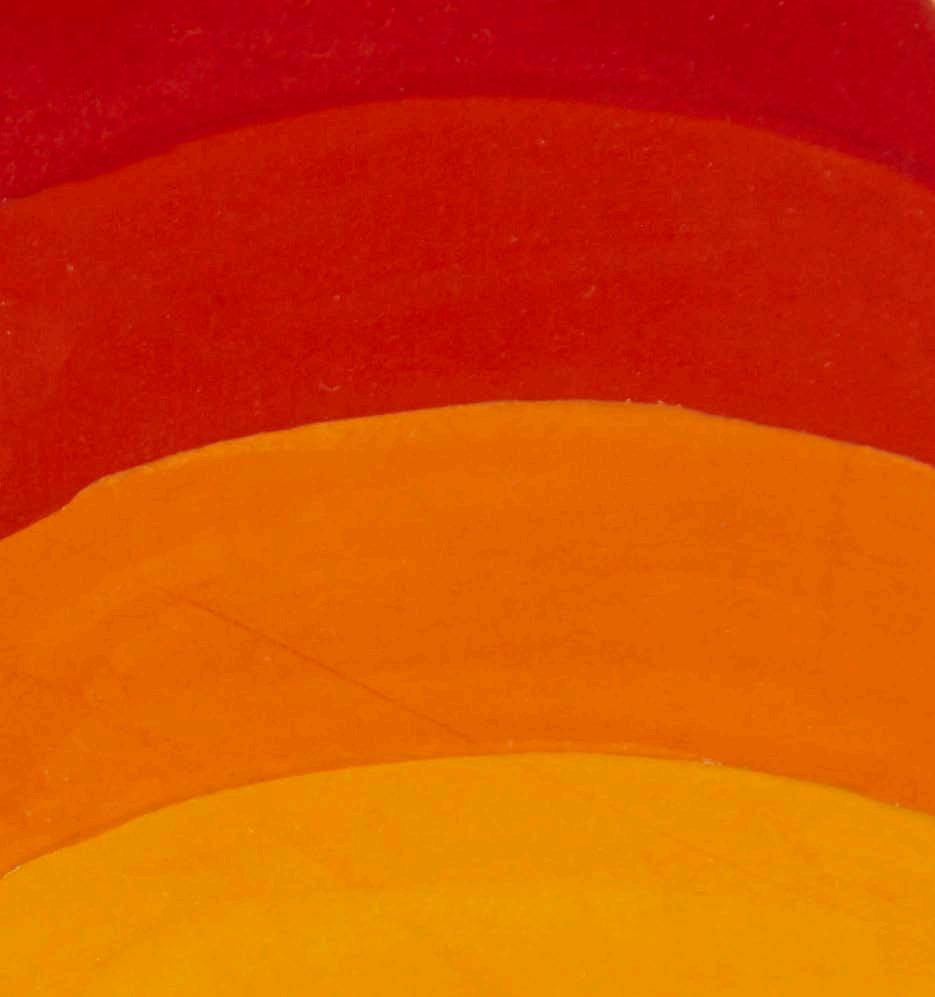
ISBN 9780648422655
Front Cover Image
Normana Wight, Untitled, 1970 (detail), gouache on paper, RMIT University Art Collection
Back Cover Image
Vincas Jomantas, Landing Object II, 1971

fabricated polyester resin and fibre glass, 111.0 x 120.0 x 104.0 cm, McClelland Sculpture Park+Gallery
Endpapers
Wolfgang Sievers, Face to Face, 1964
State Library Victoria Wolfgang Sievers Collection
Typography
Text set in Objectiv Mk1 (Maag)

Display set in Lord Bold Lord is based on an identity designed by Viennese graphic designer Joseph Binder who studied at the Kunstgewerbeschule from 1922–1926.
ABBREVIATIONS
AGNSW
Art Gallery of New South Wales
CAE
Council of Adult Education

CAS
Contemporary Art Society (Vic.)
DIA
Design Institute of Australia
FRSA
Fellow of the Royal Society of Arts
GMH
General Motors Holden
MTC
Melbourne Technical College, 1934–1954
NAA
National Archives of Australia NGA
National Gallery of Australia
NGV
National Gallery of Victoria
NMIT
Northern Metropolitan Institute of TAFE, Melbourne
RCA
Royal College of Art (UK)
RMTC
Royal Melbourne Technical College, 1954–1960

RMIT
Royal Melbourne Institute of Technology, 1960-present SLV
State Library of Victoria
TUWien
Technical University of Vienna
V&A
Victoria and Albert Museum, London
VAS
Victorian Artists’ Society
VCA
Victorian College of the Arts
VSS
Victorian Sculptors’ Society
WMC
Working Men’s College, 1887–1934
WRC
World Record Club
melbourne modern
2 MELBOURNE MODERN 1 2 3 4 5 6 7 8
list of works contributors artist biographies acknowledgements and photo credits CONTENTS m m
preface PAUL GOUGH introduction JANE ECKETT
MELBOURNE MODERN 3 post-war architecture and interior design: THE FIRST ÉMIGRÉ TEACHERS victor vodicka AND THE POST-WAR TRANSFORMATION OF GOLD AND SILVERSMITHING a skilled hand and/or cultivated mind INDUSTRIAL DESIGN AT THE CROSSROADS structured eclecticism RMIT PAINTING DEPARTMENT 1945–TODAY material studies and professional practice EUROPEAN ÉMIGRÉ SCULPTORS AT RMIT printmaking AT THE ART SCHOOL OF MELBOURNE TECHNICAL COLLEGE 1948–1965 the target is man: UDO SELLBACH AT RMIT legacies HARRIET EDQUIST HARRIET EDQUIST HARRIET EDQUIST SHERIDAN PALMER JANE ECKETT VICTORIA PERIN SARAH SCOTT JANE ECKETT 8–29 30–41 42–57 58–67 68–85 86–101 102–113 114–129 130–152

4 MELBOURNE MODERN
preface
The story of the many hundreds of exiled and displaced European artists, architects and designers who arrived in Australia, and in particular Melbourne, in the grim aftermath of World War II is really quite extraordinary.
Travelling from as far as Budapest, Berlin, Kaunas, Munich, Vienna and Vilnius, they had been trained in teaching ateliers across the great European art schools and design academies.
Setting up workshops and studios in Melbourne they brought a quite brilliant constellation of ideas, approaches and philosophies into this corner of the world. Inevitably they found employment in the leading Australian institutions, many becoming teachers and technicians at the Melbourne Technical College (later renamed Royal Melbourne Institute of Technology). For the students of the day, indeed for the entire post-war culture of the city, their arrival must have been extraordinary, almost iconoclastic.
The full impact of their contribution in the disciplines and practices of painting, sculpture, printmaking, architecture, interior design, textiles, gold and silversmithing, photography, film, graphic design and industrial design –all of which RMIT still proudly teaches – has yet be fully written, but this new exhibition Melbourne Modern: European art and design at RMIT since 1945, adds a significant instalment.
In this exhibition we are privileged to share a magnificent display of contemporary art, architecture, design, gold and silversmithing from the period, as well as rarely seen archival material including documentary photographs, posters and teaching aids. These are drawn internally from the RMIT Art Collection and RMIT Design Archives, as well as external lenders whose support has been vital in realising the exhibition concept. I extend my thanks to Anna Schwartz Gallery, ARC One Gallery, Australian Galleries, Charles Nodrum Gallery, Hamilton Gallery, McClelland Sculpture Park + Gallery, Monash University Archives, National Gallery of Victoria, State Library of Victoria, University of Melbourne’s Ian Potter Museum of Art, and to the numerous private lenders – many of them RMIT alumni or family members of alumni.
Much of the work has rarely, if ever, been publicly exhibited and I applaud the curators, Dr Jane Eckett and Professor Harriet Edquist for their ingenuity and insights. I thank our wonderful gallery staff who have helped realise the exhibition, the education program and wider public engagement. And I thank deeply our patrons and sponsors, most notably the Gordon Darling Foundation who have generously sponsored this publication.
Thank you to all who have made this memorable exhibition possible, and to those inspired and dedicated practitioners and teachers of all nationalities, who escaped war-ravaged Europe to bring their unique skills, craft and creativity that has enriched Melbourne and Australia for many decades.
Professor Paul Gough Pro-Vice Chancellor and Vice President RMIT University
Opposite Gus van der Heyde, Faculty of Architecture and Building, RMIT Advanced College (poster), 1977, offset lithograph, 56.5 x 42.0 cm, RMIT Design Archives: Gus van der Heyde collection
MELBOURNE MODERN 5
introduction
Their contributions were visible at many levels: on the street, through the design of modernist apartment blocks, cafés, churches, commercial spaces and domestic dwellings, as well as public fountains, murals and screens; in the home, via furniture, textiles and hollowware; and on the body, through tailoring, fabric design and hand-made jewellery. Arguably their profoundest impact, however, was less visible for it was at the grass-roots level of education. Émigrés brought with them a diverse range of approaches and educational philosophies garnered in the art academies, ateliers, technical universities and vocational schools of Central and Eastern Europe, the Baltic States, Scandinavia, the Netherlands and Britain. Melbourne Modern surveys the contribution of European émigrés who taught at RMIT after 1945 and traces the legacy of their teaching to the present day.
A substantial existing literature highlights émigré achievements in Australian art and design.1 In 1993 Art & Australia devoted a special issue to post-war migrants, in which year also the contribution of Jewish architects since 1945 was the focus of an exhibition at the National Gallery of Victoria.2 Another exhibition, The Europeans: Émigré Artists in Australia 1930-1960 at the National Gallery of Australia in 1997, remains a landmark, generating more recent surveys such as The Other Moderns, which examined Sydney’s little-known post-war European designers.3 Rex Butler and A.D.S. Donaldson’s ongoing project of the past decade has been to rethink Australian art historical narratives to accommodate émigré and expatriate artists.4 Jenny Zimmer has written extensively on individual European-trained artists, and Harriet Edquist’s many publications and exhibitions on émigré architects and designers, drawn from the rich holdings of the RMIT Design Archives, have added depth to these surveys.5
More recently attention has turned to émigré involvement in art and design education. The ARC Discovery Project, ‘Bauhaus Australia; Transforming Education in Art, Architecture and Design’, in which Edquist has been a chief investigator, has focused on this very subject and resulted in a major monograph.6 Melbourne Modern contributes to this emerging field of research by exploring in exhibition format the nature of European art education through one key institution: the former Melbourne Technical College (MTC), known since 1960 as RMIT.
The term émigré encompasses a wide range of circumstances associated with different waves of migration. It includes religious and political exiles who fled the rise of fascism in the 1930s, internees deported from Britain at the outbreak of war owing to their nationality, refugees who arrived on the cusp of and during the war, ‘displaced persons’ (DPs) unable to return home owing to the post-war redrawing of borders and the Sovietisation of Eastern Europe and the Baltic countries, and migrants who arrived after the war under assisted passage schemes or as the spouse of an Australian national. DPs account for the greatest number of artists and designers in the present exhibition, reflecting their greater numbers overall. Between 1949 and 1950 approximately 100,000 DPs arrived in Australia, generating intense debate as to how these ‘New Australians’ could best assimilate to the predominantly Anglo-Irish culture.7 In the face of such diversity in circumstances and nationalities, coupled with the Australia’s assimilationist policy, we should beware any attempt to retrospectively homogenise the émigrés. Nevertheless it can be said that all shared a similar fate of uprootedness, of immersion in two different cultures, and frequently the sense of not belonging entirely within either.
Melbourne Modern also includes artists who transcend the category of émigré but are more generally termed ‘European’. While our primary focus is on artists and designers born and educated in Europe and who arrived in Australia as practitioners, we also consider those who left Europe at a young age, as well as the Australianborn children of migrants, on the basis of their family’s cultural heritage. More broadly still we include a number of Australians who studied for extended periods in Britain and Europe. The inclusion of Britain within this broad definition of ‘European’ is a conscious reflection of Australia’s strong Commonwealth ties in the post-war decades (albeit increasingly problematic with the impending Brexit). Throughout these decades staff at RMIT referred chiefly to British educational models, while the Royal College of Art in London attracted several top students for postgraduate studies. If the term ‘European’ seems stretched to capacity, equally it disguises a multitude of national and regional differences. ‘European’ remains simply a shorthand notation; wherever possible we specify nationalities or regional affiliations.
6 MELBOURNE MODERN
In the wake of World War II, amid mass migration out of Europe, hundreds of artists, architects and designers arrived in Melbourne and profoundly changed the cultural landscape.
Likewise we are concerned not with a monolithic concept of modernism, but rather multiple modernisms that reflect the myriad possibilities open to artists in the interwar and post-war years. These multiple modernisms are often geographically based and stem from different historical and cultural factors. For instance, in the sculpture department Hermann Hohaus’s archaised figures are typical of those made in the immediate post-war years in Munich when sculptors rapidly distanced themselves from the sort of classical figuration deemed acceptable under the Nazis. Teisutis Zikaras, on the other hand, responded to Picasso’s cubist sculpture, which he studied first-hand in French-occupied Freiburg, finding it a viable alternative to the intense cultural nationalism of the exiled Lithuanian community with whom he lived and worked. Similarly in interior design we see a range of modernist propositions: from Sterne’s expression of pre-war Wiener Wohnraumkultur (‘Viennese living room culture’), with its flexible furniture arrangements, to Kral’s ‘sophisticated exemplars of high modernism’.8
Students at MTC in the post-war years therefore encountered a range of different modernist approaches among the teaching staff. This was enhanced by MTC’s traditional structure of learning, which allowed students to choose a broad range of subjects. Students took a selected major and elective minor subjects as well as a common core of liberal studies, including art history, history of the selected major subject, music, theatre, literature, film, social science, sociology, philosophy and psychology.9 Architects, designers, painters, printmakers and sculptors alike therefore shared many of the same instructors. This was particularly the case in drawing as it was at the basis of all courses in the Applied Art and Architecture Division (which included fine art).10 While divisions between different departments remained quite rigid during the post-war decades, and interdisciplinarity scarcely encouraged, as students progressed through their studies they nonetheless encountered a variety of teaching approaches and a range of different conceptions as to what modernism is. There is therefore no house style, or singular look to the works in Melbourne Modern. Instead, the exhibition reflects the rich variety of émigré experience coupled with student response to and remixing of these various modernist ideals.
Jane Eckett
1 See for instance Alan McCulloch, ‘Migrant Artists in Australia’, Meanjin, vol. 14, no. 4, December 1955, 511–16; Paul McGillick, ‘Sources of change: migrant art in Australia’, Quadrant, vol. 23, no. 10, October 1979, 31–6; Paul McGillick, ‘Five migrant artists in Australia’, Aspect, vol. 5, no. 1–2, August 1980, 23-5; Jenny Zimmer, ‘Five Berliners in Melbourne’, Aspect: Survey of Ethnic Visual Arts in Australia, nos. 29/30, Autumn 1984, 133–60; and among more recent contributions Andrew E. McNamara, Ann Stephen and Isabel Wünsche, ‘Case studies of modernist refugees and emigres to Australia, 1930–1950: Light, colour and educational studies under the shadow of fascism and war’ in C.P. Cruzeiro (ed.), Migrations: Migration Processes and Artistic Practices in a Time of war: From the 20th Century to the Present, Lisbon: Belas-artes, 2017, 271–89.
2 Art and Australia, vol. 30, no. 4, Winter 1993; Ronnen Goren, 45 Storeys: A retrospective of works by Melbourne Jewish architects from 1945, Melbourne: NGV, for the Jewish Festival of the Arts, 1993.
3 Roger Butler (ed.), The Europeans: Émigré Artists in Australia 1930–1960, Canberra: National Gallery of Australia, 1997; Rebecca Hawcroft (ed.), The Other Moderns: Sydney’s Forgotten European Design Legacy, Sydney: NewSouth Publishing, 2017.
4 Rex Butler and A.D.S. Donaldson, ‘War and Peace: 200 Years of Australian-German Artistic Relations’, emaj, no. 8, April 2015, 1–24, URL: https://emajartjournal.files.wordpress.com/2012/11/butler_ donaldson_200-years-of-australian-german-artistic-relations.pdf.
5 Including, but not limited to, Jenny Zimmer, Inge King Sculpture 1945–1982: A Survey, Parkville, Vic.: University Gallery, University of Melbourne, 14 September–22 October 1982, and Klaus Zimmer glass artist, South Yarra, Vic.: Macmillan, 2000; Harriet Edquist and Helen Stuckey, Frederick Romberg: the architecture of migration 1938–1975, Melbourne: RMIT University Press, 2000; Harriet Edquist, ‘George Kral (1928-1978): graphic designer and interior designer’, RMIT Design Archives Journal, vol. 3, no. 2, 2013, 12–23; Harriet Edquist, ‘Vienna Abroad: Viennese interior design in Australia 1940–1949’, RMIT Design Archives Journal, vol. 9, no. 1, 2019, 6–35.
6 Philip Goad, Ann Stephen, Andrew McNamara, Harriet Edquist and Isabel Wünsche (eds), Bauhaus Diaspora: Transforming Education in Art, Architecture and Design, Parkville, Vic.: Melbourne University Press in association with Power Publications, Sydney, 2019.
7 Kajica Milanov, ‘Towards the Assimilation of New Australians’, The Australian Quarterly, vol. 23, no. 2, June 1951, 71-8.
8 See Harriet Edquist’s chapter 1 in this volume: ‘Post-war architecture and interior design: the first émigré teachers’.
9 The range of core humanities subjects differed over time; the example given here is from the 1969 prospectus, Royal Melbourne Institute of Technology Calendar 1969, Melbourne; RMIT, 1969, 186.
10 Drawing seems to have led mainly by British artists such as Roy Bizley and Anthony Woodcock in the 1950s, ‘60s and ‘70s. Jenny Zimmer attests to the quiet brilliance of Woodcock, who studied in Southampton and taught life at drawing at RMIT c. 1966–79; Zimmer conversation, 14 May 2019.
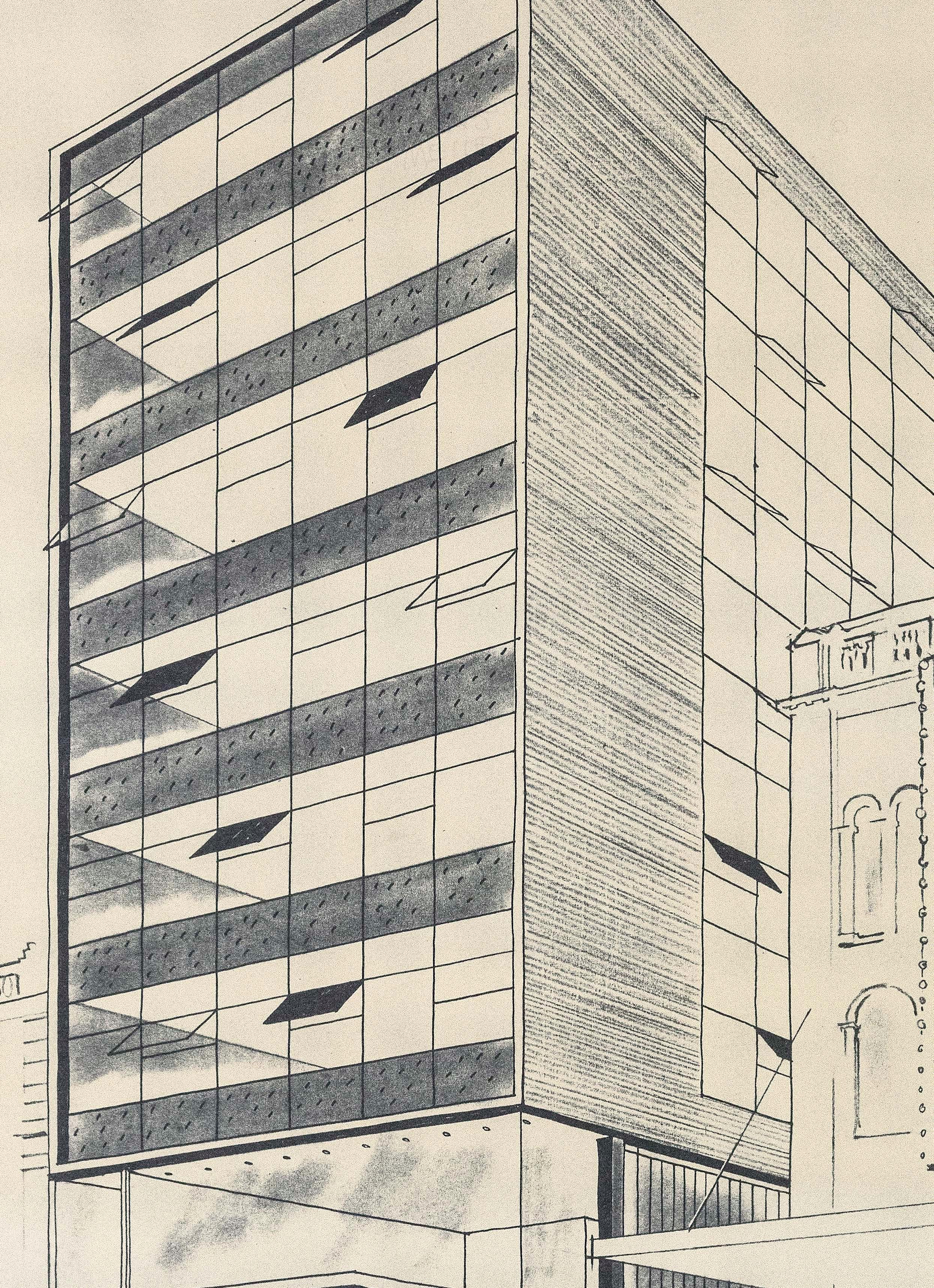
post-war architecture and interior design: THE FIRST ÉMIGRÉ TEACHERS HARRIET EDQUIST 1
Opposite Ernest Fooks, Perspective of Commercial Building, 231–233 Bourke Street, Melbourne (detail), 1957, diazotype, image: 62.5 x 56.0 cm, RMIT Design Archives: Ernest Fooks Collection
Some of these émigrés were part-time and some full-time, and they came from Germany, Austria, Czechoslovakia, Italy, Holland, Lithuania and Latvia, Ireland and Scotland.1 Harry Winbush had been lecturer-in-charge of architecture since 1943 and whether it was his decision or Brown’s, Viennesetrained architects Frederick Sterne and Ernest Fooks and the Swiss-trained German architect Frederick Romberg all joined the staff. They were the first European designers to join Art and Applied Art after the war but they were soon followed by many more over the coming decades.
Frederick Romberg was appointed senior lecturer to teach architectural history, and his tenure was the briefest of the three; it is also the most poorly documented. He had arrived in Melbourne in 1938, a graduate of architecture from ETH Zurich, one of the most prestigious architecture schools in Europe, where he was taught and mentored by acclaimed Swiss modernist Otto Salvisberg. Romberg brought copies of his student work with him to Melbourne and had no trouble finding work with prominent architecture firm Stephenson and Turner, who appointed him job captain on their 1939 Australian Pavilion at the New Zealand Centennial Exhibition held in Wellington.2
After he left the firm Romberg set up his own practice and, with overseas financial backing, designed Newburn Flats in Queens Road, the first high-rise building in Melbourne using stripped concrete construction. When completed in 1941, the design brought Romberg some local acclaim. He also designed the unbuilt multi-storey apartment block Gloucester Apartments at the corner of La Trobe and Spring Streets for his investment company before the site was commandeered by the Commonwealth Government. Romberg and Shaw, a partnership with Mary Turner Shaw, designed Yarrabee Flats in South Yarra (1941) and several other buildings which Shaw brought into the office through her extended social networks.
This partnership was short-lived however, and in 1943 Romberg was shipped off to the Northern Territory to work for the Allied Works Council along with other ‘enemy aliens’. On his return to Melbourne in August 1944 he lost no time in becoming a naturalised citizen. By this time, he was involved in the design of Stanhill Flats just south of Newburn,
which he had begun in 1943 for entrepreneur Polish-born Stanley Korman. Stanhill was to prove his most significant and celebrated building before the establishment of the partnership Grounds, Romberg and Boyd in 1953.
Romberg was appointed to ‘a part-time teaching assignment in the Architecture Department’ at MTC in 1945 3 The appointment highlights both the regard in which Romberg was held as an architect and the forward-looking ambition of Harry Winbush. Romberg taught architectural history and his name appeared on a 1945/46 handbook, but unfortunately neither his teaching materials nor a detailed architecture curriculum for 1945 survives, so the nature of his teaching is not known (although the 1946 copy of Banister Fletcher’s A History of Architecture on the Comparative Method in his personal collection suggests it would have followed a well-worn route).4 In 1946 Romberg left Melbourne for a visit to Europe and while he does not mention returning to MTC in his memoirs, he is listed as a part-time lecturer for 1948-49 in the university’s staff records so it is possible he continued to teach in these years.5
The contribution of Ernest Fooks to the architecture course is marginally better documented than Romberg’s but of quite a different nature. Fooks had arrived in Melbourne in 1939 with excellent architectural credentials. He was a graduate of Technical University Vienna (TUWien) where he obtained a doctorate in Technical Sciences in 1932 with a thesis titled Stadt in Streifen (‘Linear City’), completed under the supervision of prominent Viennese architect Siegfried Theiss. Like Romberg, Fooks brought out to Melbourne examples of his Viennese work and he quickly found a position with Frank Heath at the Housing Commission of Victoria (HCV).6 Here they were developing new towns in regional centres and new housing estates in the metropolitan area, a field Fooks knew well from his work in ‘Red Vienna’.7
At the same time, he published at least a dozen articles in the monthly Melbourne magazine Australian Home Beautiful on town planning, architecture and interior design, putting forward ideas about how Australia might benefit from Viennese experience in these areas.8 At Kosminsky Galleries, in March 1944, he exhibited his architectural drawings of European cities under the title of ‘Cities of
MELBOURNE MODERN 9
After the war Harold Brown oversaw the appointment of several émigré architects and designers in MTC’s Department of Art and Applied Art of which he was head.
Top Frederick Romberg, Perspective of Gloucester Apartments, Melbourne, 1946, gouache on tinted paper, image: 48.8 x 74.4 cm; sheet: 49.5 x 76.5 cm, RMIT Design Archives: Robin Boyd and Frederick Romberg Collection
Above Frederick Romberg, Perspective of Residence at Brighton for D.J. Michell Esq, 1946, diazo-process print with watercolour, image: 43.5 x 68.5 cm; sheet: 45.7 x 73.0 cm, RMIT Design Archives: Robin Boyd and Frederick Romberg Collection
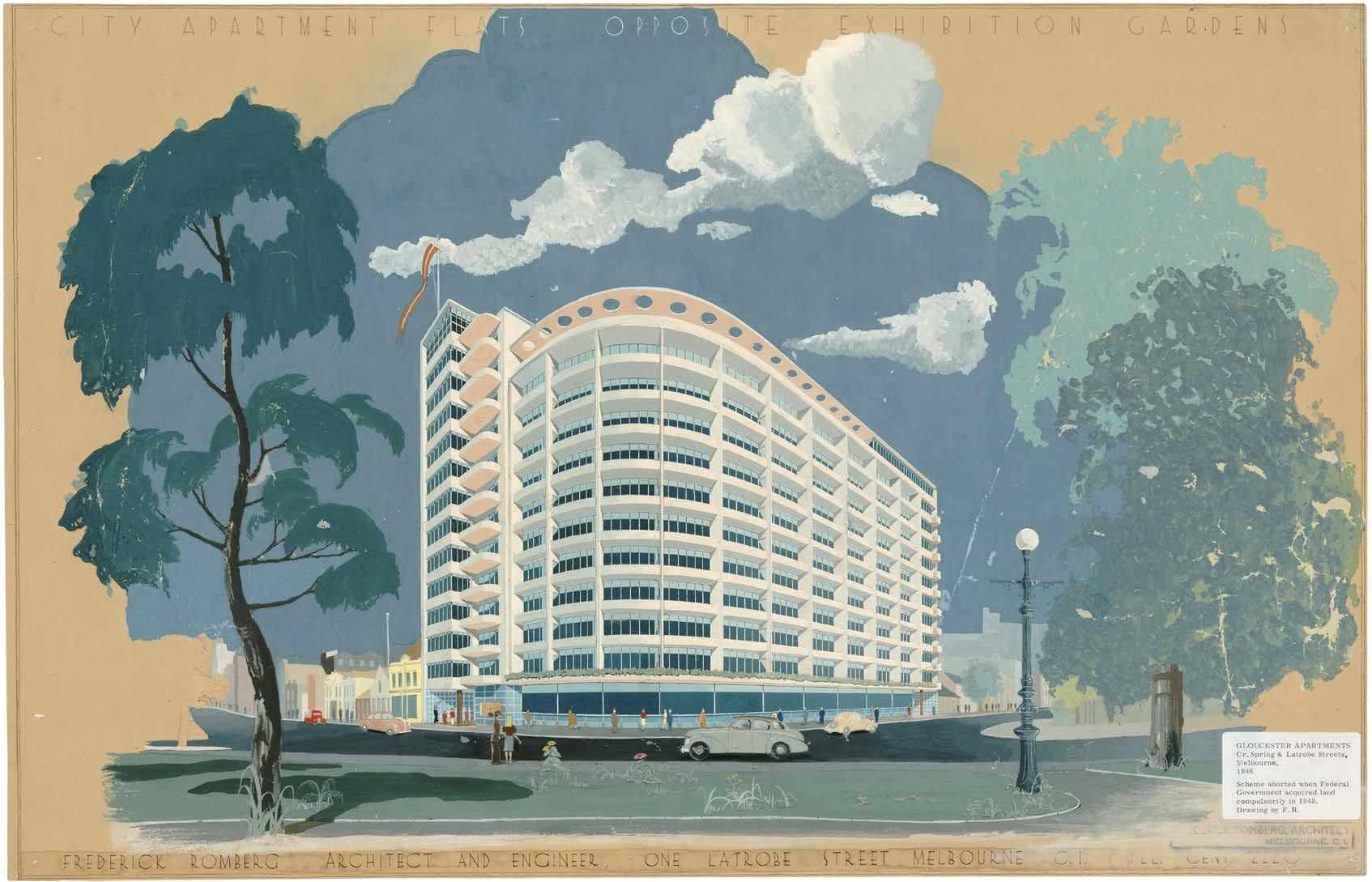
Opposite Frederick Romberg, metal tin containing student work including thesis design for the Dolder Grand Hotel, final year project at ETH-Zurich, 1937, papers, photographs, diazotypes, metal tin, various dimensions, RMIT Design Archives: Robin Boyd and Frederick Romberg Collection
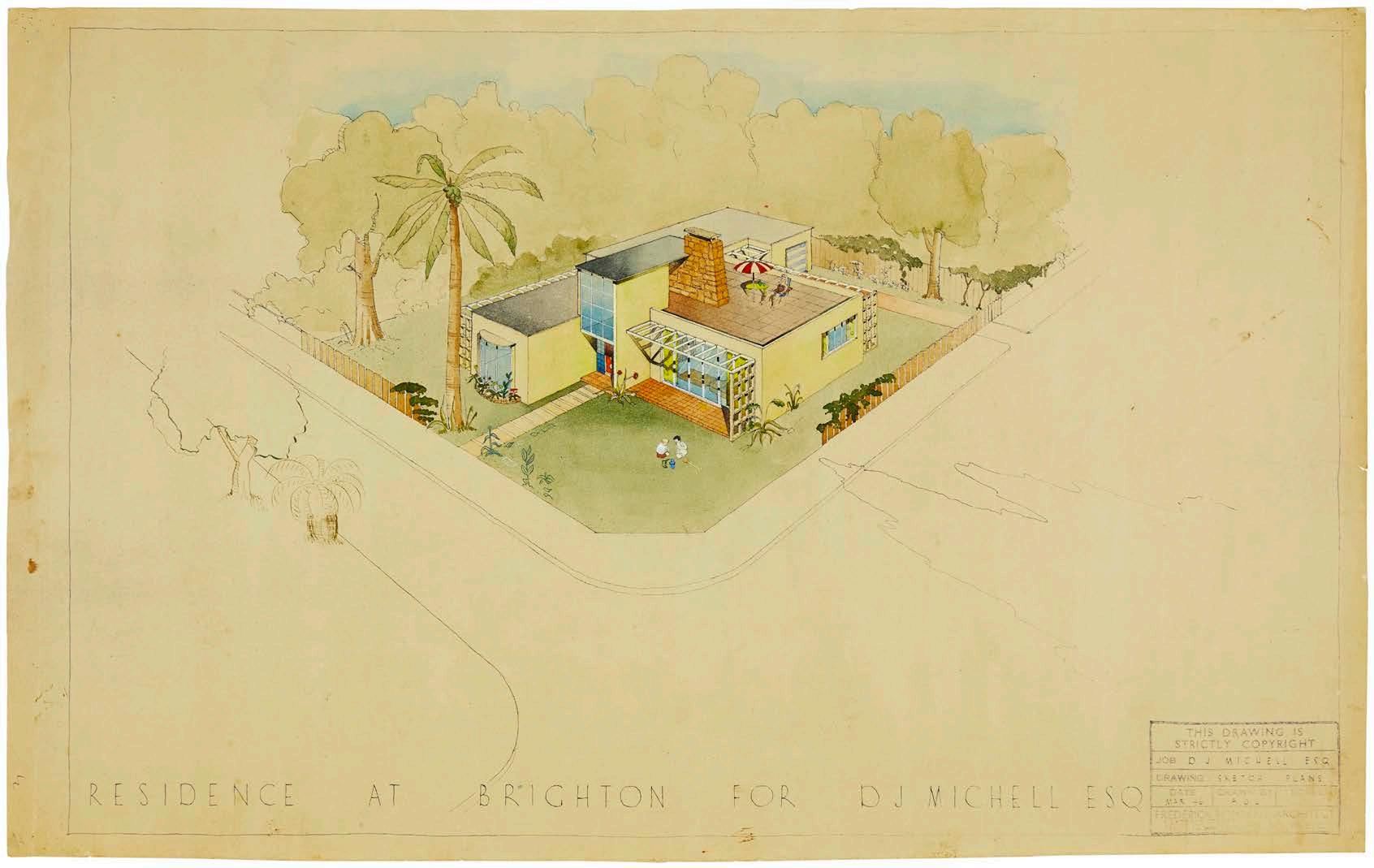
10 MELBOURNE MODERN
ARCHITECTURE
POST-WAR
AND INTERIOR DESIGN

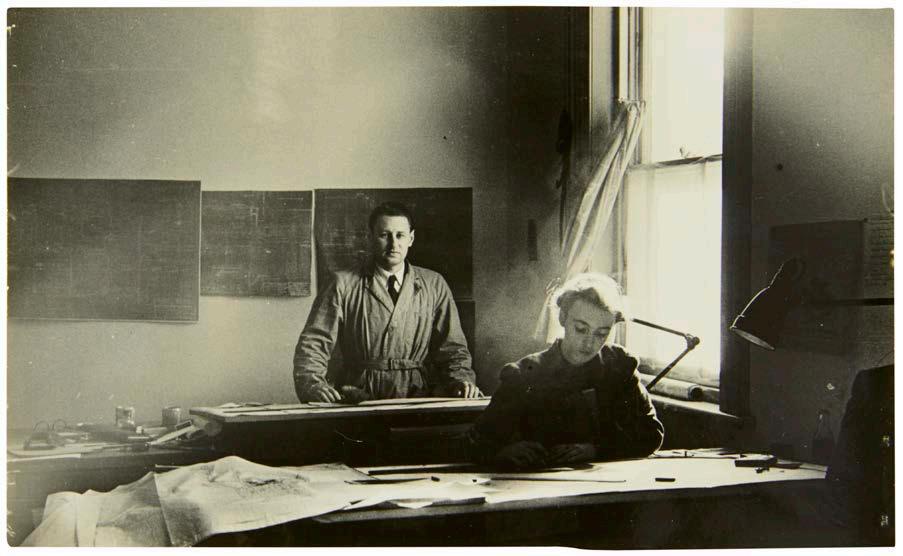
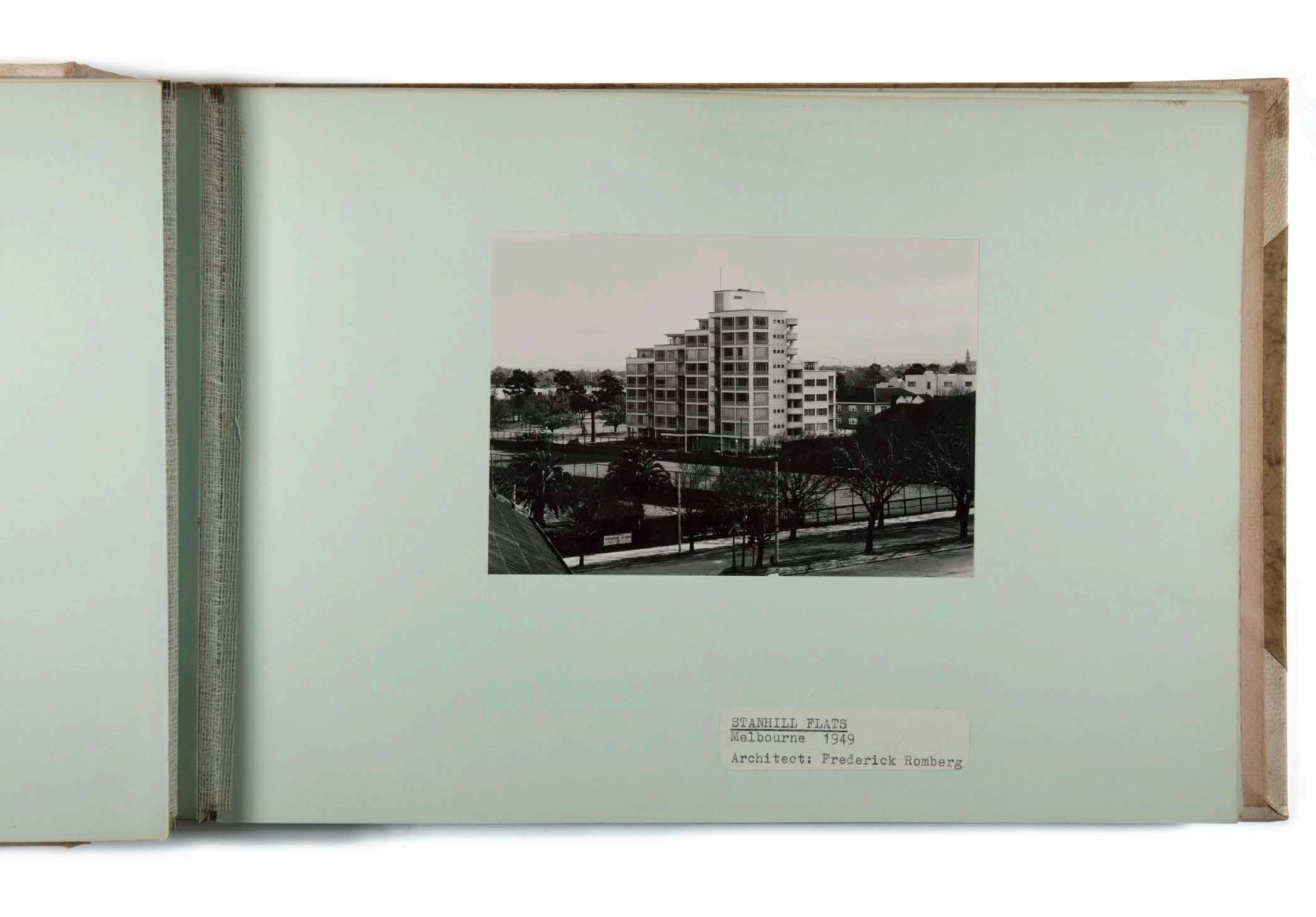
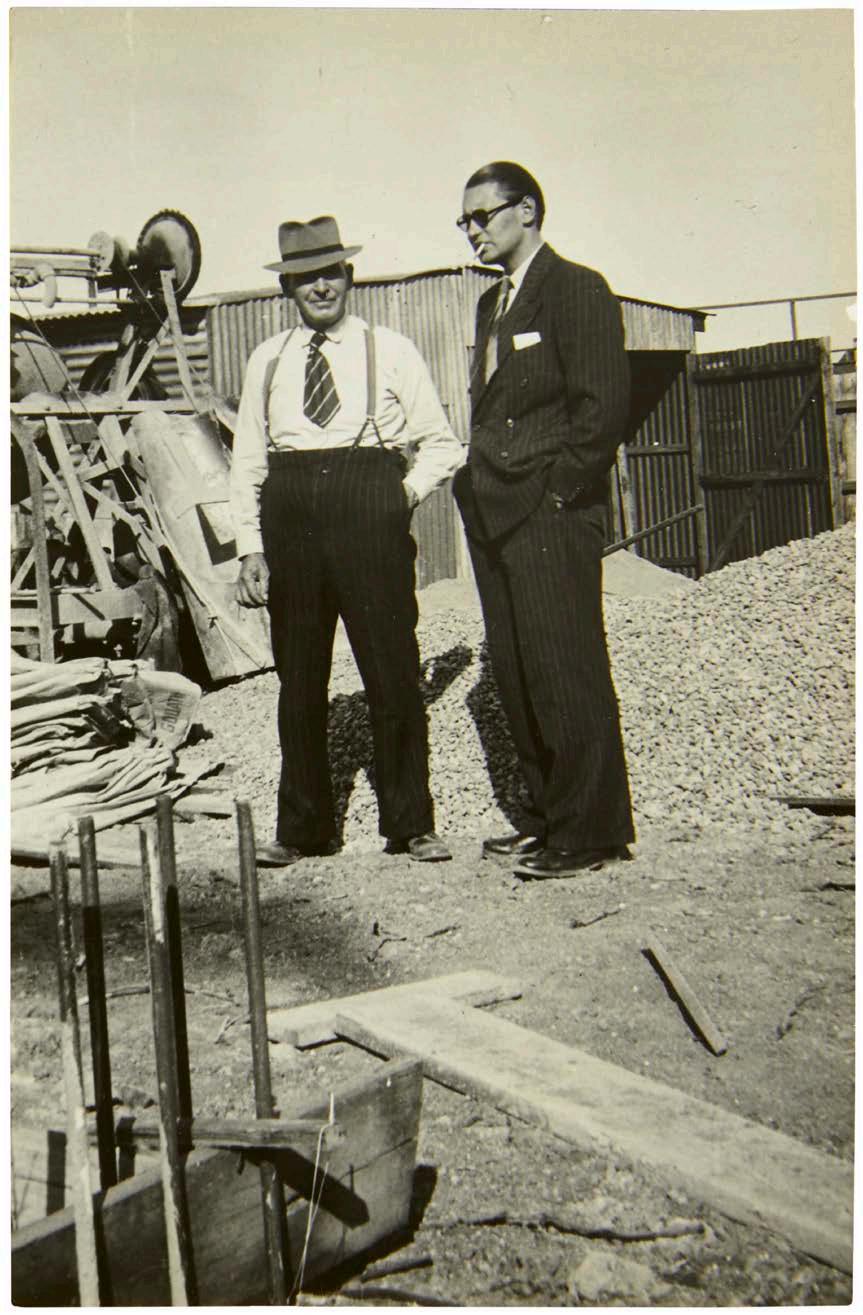
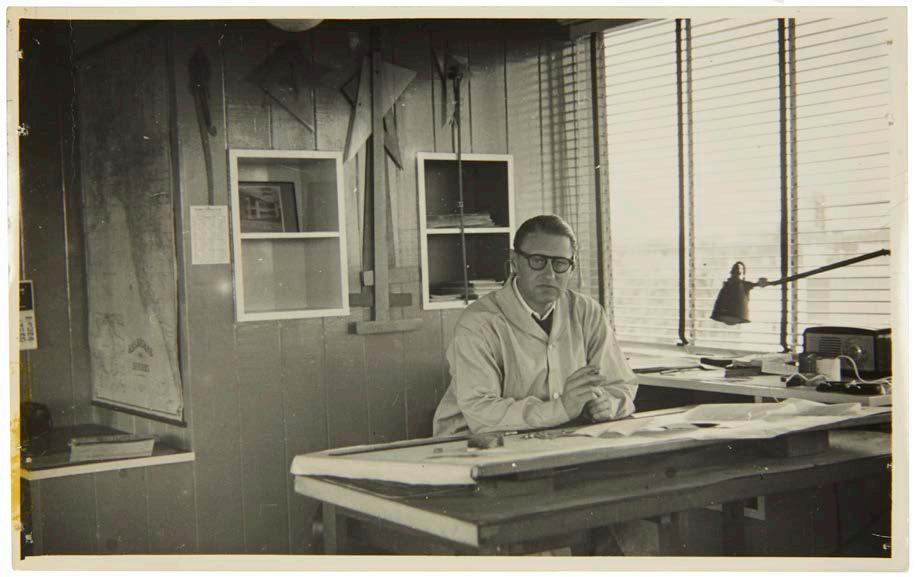
12 MELBOURNE MODERN POST-WAR ARCHITECTURE AND INTERIOR DESIGN
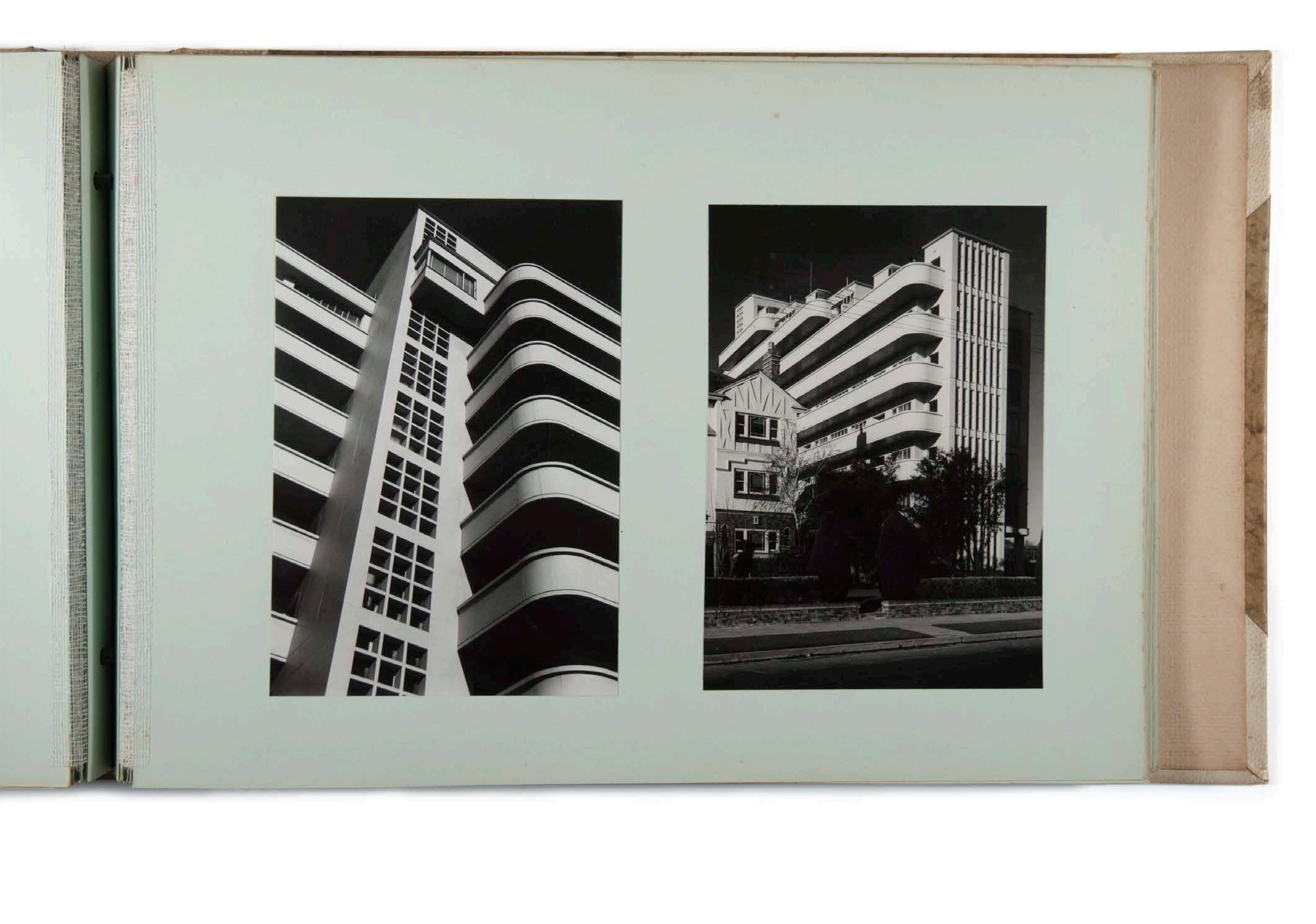

MELBOURNE MODERN 13
Page 12
Bottom right
Frederick Romberg at his desk in Newburn Flats, Melbourne, 1952, photographer unknown, RMIT Design Archives: Robin Boyd and Frederick Romberg Collection.
Page 12
Middle right
Frederick Romberg and Berenice Harris in the office at 1 Latrobe Street, Melbourne, c. 1947–49, photographer unknown, RMIT Design Archives: Robin Boyd and Frederick Romberg Collection.
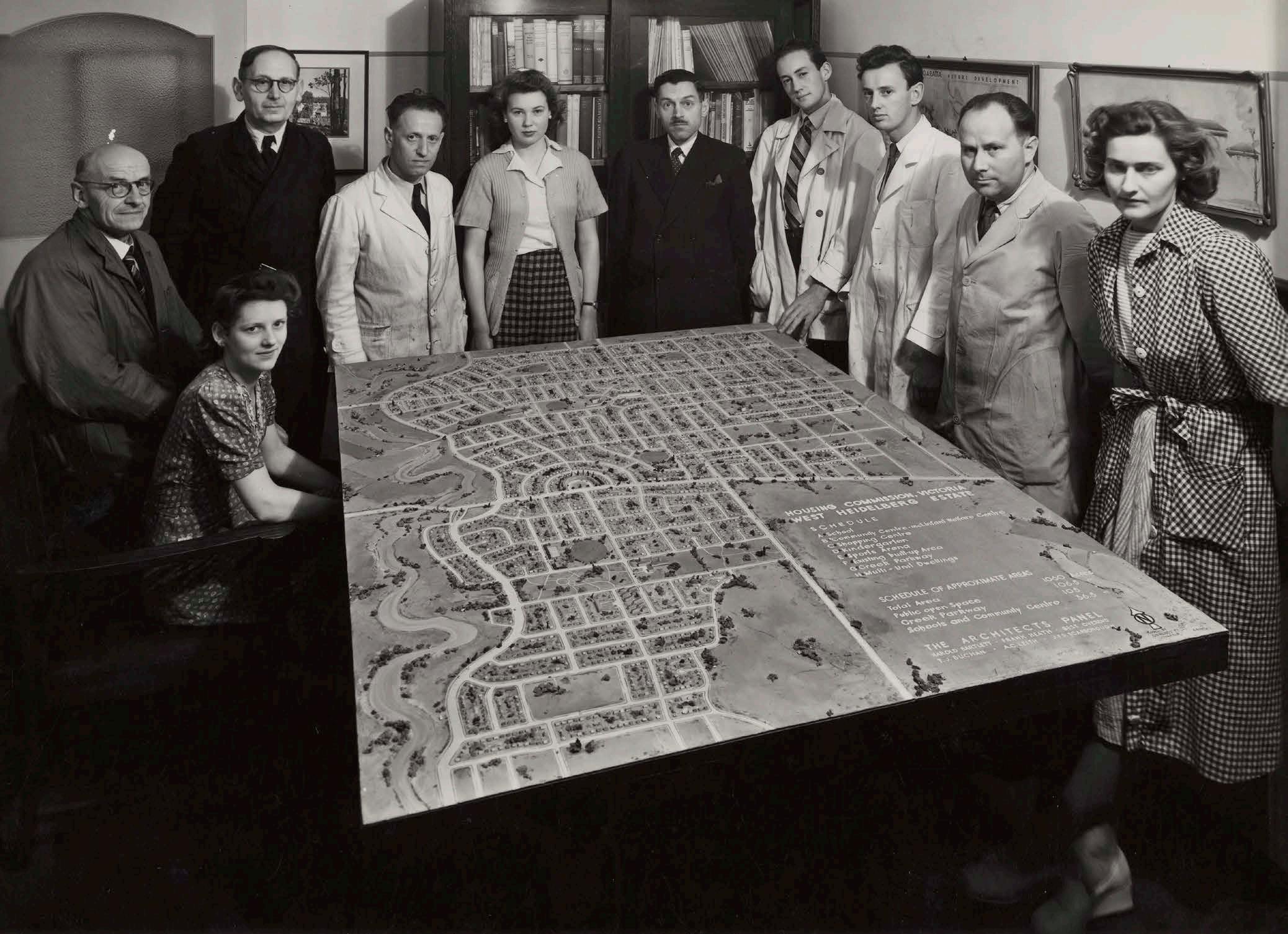
Page 12
Middle left
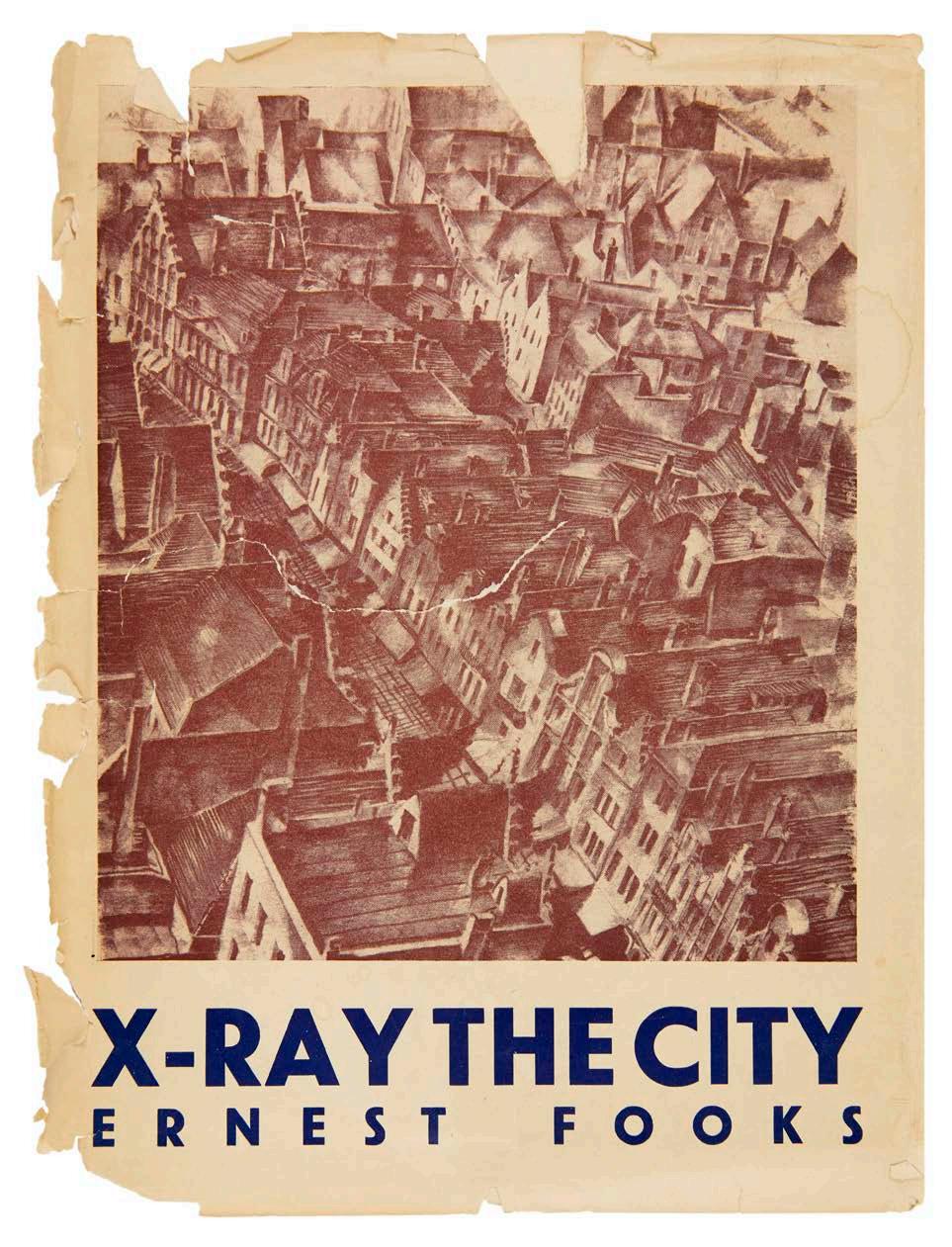
Frederick Romberg and Horrie Clayfield, building manager for Stanley Korman, at the Stanhill construction site, 1949, photographer unknown, RMIT Design Archives: Robin Boyd and Frederick Romberg Collection.
Page 12
Top
Frederick Romberg, Stanhill Flats, Melbourne, 1949, photographs mounted in album titled Frederick Romberg 1939–1950, photographer: Wolfgang Sievers, RMIT Design Archives: Robin Boyd and Frederick Romberg Collection
Page 13
Frederick Romberg, Stanhill Flats, Melbourne, 1949, photographs mounted in album titled Frederick Romberg 1939–1950, photographer: Wolfgang Sievers, RMIT Design Archives: Robin Boyd and Frederick Romberg Collection
14 MELBOURNE MODERN
ARCHITECTURE AND INTERIOR DESIGN
POST-WAR
Opposite top Office of Frank Heath, Melbourne, with staff assembled around a plan of the Housing Commission, Victoria, West Heidelberg Estate (Ernest Fooks standing fourth from left), c. 1940–42, Commercial Photographic Co., State Library Victoria: Harold Paynting Collection
Opposite right Ernest Fooks, X-Ray the City! The Density Diagram: Basis for Urban Planning, with a foreword by Dr H.C. Coombs, 1946, Ruskin Press, Melbourne, RMIT Design Archives: Ernest Fooks Collection.
Right Melbourne Technical College Diamond Jubilee exhibition, Arts Building (Building 2), town planning display, 1947, photographer: Lyle Fowler, State Library Victoria: Harold Paynting Collection
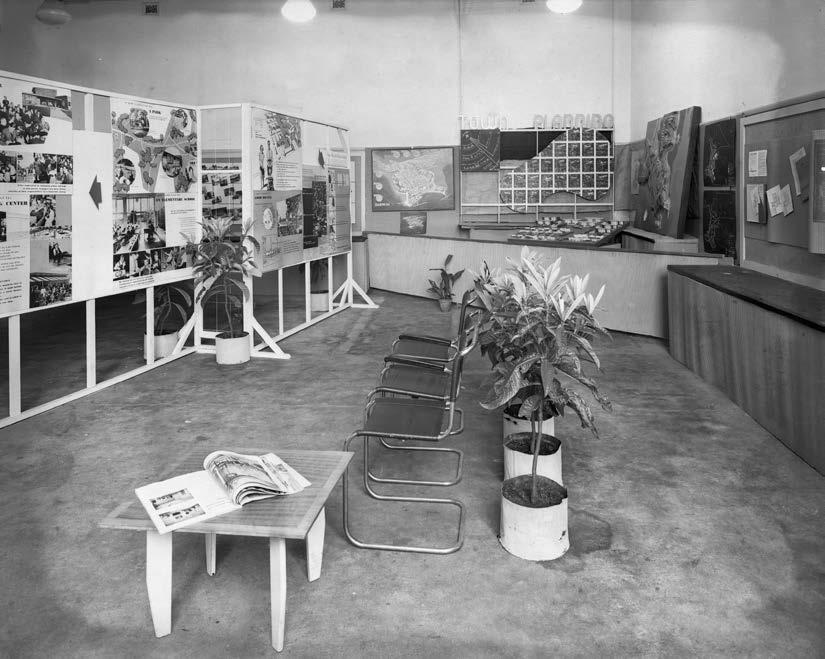
Yesterday’, to critical acclaim. In 1946 he published his important urban study X-ray the City! The Density Diagram: Basis for Urban Planning!9 It was probably off the back of either this publication or the earlier exhibition that Fooks was appointed part-time lecturer in Winbush’s architecture department. He developed the new subject of Town Planning, which he taught for several years. Departments of Town and Country Planning had been established at the University of Sydney in 1947 and University of Melbourne in 1951 as responses to Australia’s rapid post-war urbanisation, and the MTC was characteristically pro-active in modernising its courses similarly to prepare its students for the new realities of a rapidly increasing population and industrialisation. Like the army of part-time teachers at the College, Fooks’ name does not appear on the annual prospectuses, so his teaching activities are hard to document.
In 1947 however, to celebrate the College’s Diamond Jubilee, Art and Applied Art mounted an exhibition in Building 2 of student work across all its disciplines. The various rooms designed by the students to showcase their work were recorded by photographer Lyle Fowler. The display included town planning, and it is reasonable to assume that the work was by Fooks’ students. Their scheme was divided into two parts: ‘what we have’ and ‘what we need’. The three photographs under the first section show small views of an industrial landscape, a congested city, and a poor neighbourhood. The larger, visionary scheme shows a design for an irregular greenfield site with sports oval flanked by housing (detached houses and apartments), a hospital, school, shopping precinct and factories serviced by a railway line and car parking, while photographs show modern housing and high rise urban buildings. The scheme displays the typical suburban template of Fooks and Heath at HCV for ‘housing formulated to provide proximate population of workers to new perimeter factories, on greenfield sites’ and indicates the nature of Fooks’ curriculum, fusing European experience with Australian circumstance.10 For all that, the important contribution Fooks made to MTC architecture was quickly erased: when Granville Wilson came to publish the centenary history of RMIT’s Faculty of the Constructed Environment in 1987, his account of town-planning begins in 1966.11
Frederick Sterne’s architectural education is something of a mystery but by 1930 he was enrolled at TUWien in economics and administrative law, prerequisites for registration as an architect.12 At the same time he had established a modest practice in interior design and his work began to appear in European architecture and trade journals. His most significant known work was an interior scheme for one of the houses that formed Josef Frank’s 1932 Vienna Werkbundsiedlung, which indicates that he was an active participant in the socialist city’s massive inter-war building programme. After he arrived in Melbourne in 1938 Sterne, like Romberg and Fooks, had no trouble finding work in a progressive Melbourne architecture firm – in this case Leighton Irwin, where he remained for the duration of the war.
During 1945 and 1946 Sterne became familiar to readers of Melbourne’s Australian Home Beautiful through a series of articles he co-authored with long-standing journalist Mary Jane Seymour, which dealt with the interior design of the post-war house.13 Sterne’s illustrated contributions were infused with the ethos of Wiener Wohnraumkultur (‘Viennese living room culture’) that marked the particularly Viennese contribution to Australian modernism.14 It was probably on this basis that Sterne was brought into MTC as principal lecturer in architecture with a brief to transform its Interior Decoration course into Australia’s first Interior Design course.
Interior Decoration had been on the MTC curriculum for years and by 1936 it was divided into three subjects: Interior Decoration, Interior Decoration History, and Interior Decoration Design.15 By 1947 the prospectus listed two subjects: ‘Interior Decoration, Design’ and ‘Interior Decoration, Presentation and Rendering’.16 But in 1949 we find Sterne’s four-year Associate Diploma of Interior Design, which was planned as a ‘comprehensive’ course with ‘equal emphasis … placed upon design, construction and business administration’.17 It would seem that design had been implicit in the Interior Decoration course from the 1930s, but under Sterne it assumed the professional nomenclature and status it still enjoys. 1947 staff records show that Sterne was a parttime lecturer in the Department of Architecture, teaching Interior Design students design, building construction, specification and professional practice. He became full-time
MELBOURNE MODERN 15

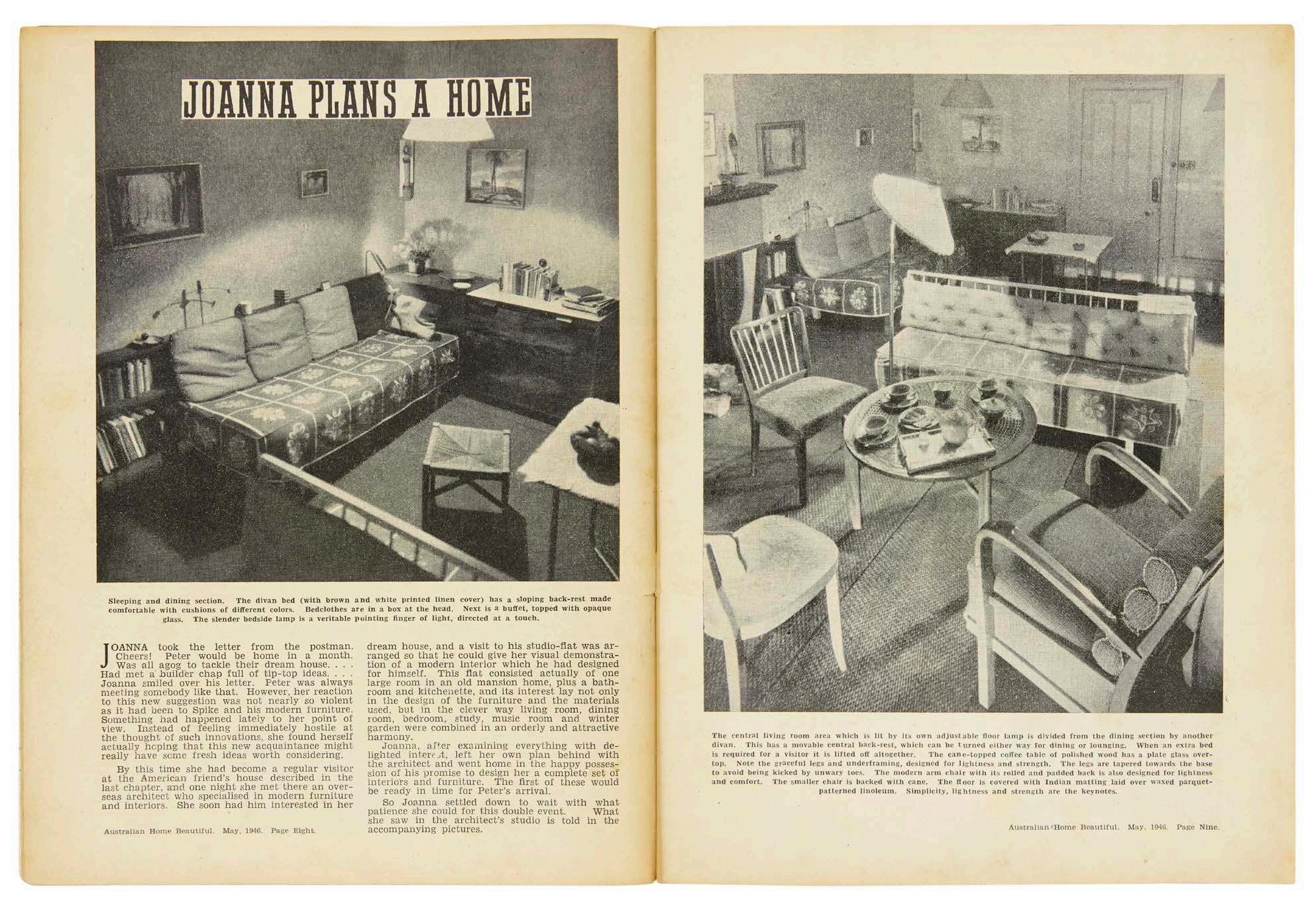
16 MELBOURNE MODERN POST-WAR ARCHITECTURE AND INTERIOR DESIGN
Opposite top Frederick Sterne and Mary Jane Seymour, ‘Joanna Plans A Home’, Australian Home Beautiful, May 1946, pp. 8–11, RMIT Design Archives: Frederick Sterne Collection
Left
Melbourne Technical College Interior Design students at work, collage of six photographs, c. 1947–51, photographer unknown, RMIT Design Archives: Frederick Sterne Collection
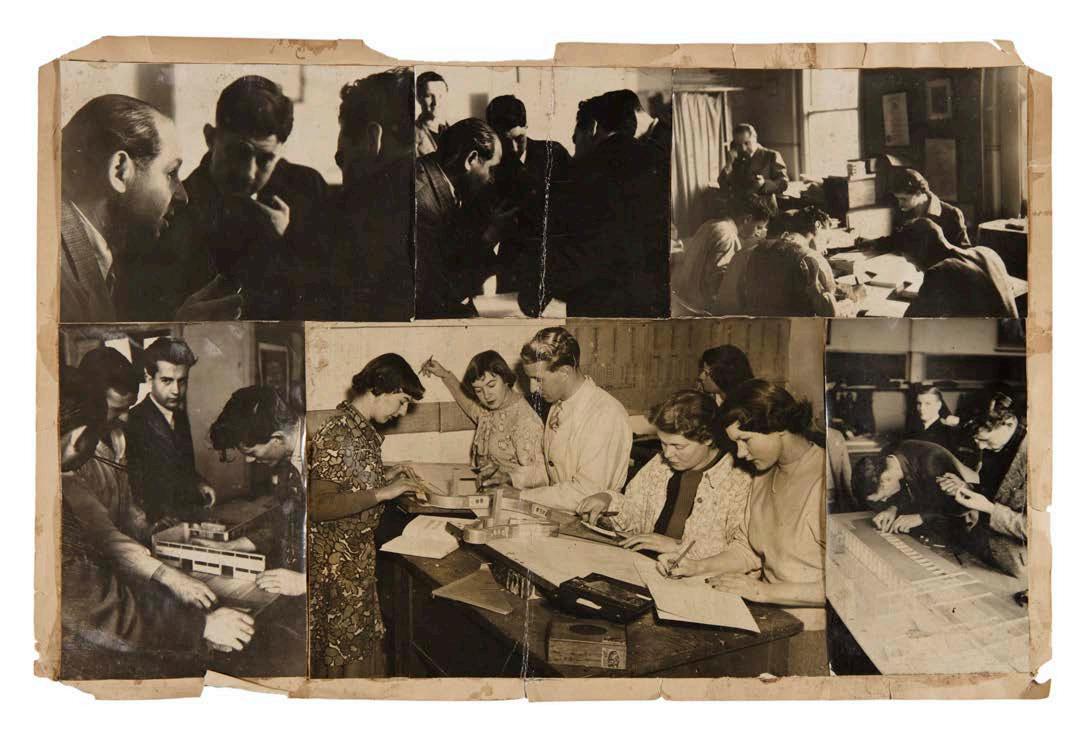
Opposite below Frederick Sterne and Mary Jane Seymour, ‘Joanna Plans A Home: Furniture is Designed for Dining Room and Hall’, Australian Home Beautiful, July 1946, pp. 27–30, RMIT Design Archives: Frederick Sterne Collection
in February 1948, in which year he wrote the new curriculum for Interior Design.18 He also wrote the correspondence course for Interior Design for the College’s large cohort of correspondence students.
Sterne’s influence seems to have extended to recommending fellow émigrés to teaching posts. For instance, by 1949 Fritz Rosenbaum, a Viennese émigré architect, was teaching part-time; he was probably recruited by Sterne.19 A pianist as well as a lateral thinker, Sterne installed a piano in the lecture room and ‘demonstrated the similarities between various classical themes and methods of building construction’.20 This apparently endeared him to students, as reflected in his obituary in the MTC magazine Jargon, in 1951: ‘Having seen much in his travels, and being a lover of culture and all the arts, Mr. Sterne was an inspiration to students, among whom he was held in high esteem’.21 Granville Wilson confirms this, recounting that Sterne, or ‘Uncle Fred’ as he was known, was ‘regarded highly’ by the students.22
It was not until the end of the 1950s that another émigré from Europe came in to teach, albeit briefly, in Interior Design. Little is known about Czech-born George Kral’s education and training in Europe before he emigrated to Australia in 1950, but in his active years from 1956 to 1978 he was at the forefront of Melbourne exhibition design, interior design and graphic design practice.23 By the mid-1950s he was collaborating with German émigrés Gerard Herbst and Wolfgang Sievers as well as English-born architect Bernard Joyce, local designer Clement Meadmore, and entrepreneur Max Hutchinson. In association with these colleagues Kral designed cafés, shop interiors and exhibitions that were sophisticated exemplars of high modernism. The only example from this significant body of work published in the architectural press, however, was the small Caprice Café in Collins Street, of which Architecture and Arts noted in 1957: ‘the Caprice relies purely on the downright elegance of brass, pure white plaster and bricks’.24 Indeed, it was elegance which set Kral apart from his Melbourne contemporaries whose modernist interiors while worthy, experimental and interesting were rarely elegant or displayed such an innovative use of materials as Kral’s. The sheer elegance
of the Esquire Café in Canberra, unerringly captured in photographs by Wolfgang Sievers, differentiates Kral from his design peers. So too Kral and Joyce’s interior for the Australian Pavilion at the Fourth Tokyo International Trade Fair, hosted by JETRO (Japan External Trade Organisation) in April 1961, which with its over-scaled photographs and light boxes, reflective surfaces and lavish use of black, was at the forefront of design for Australian overseas trade pavilions.
Gallery A was established by Max Hutchinson and Clement Meadmore in 1959 in Flinders Lane as a gallery and furniture showroom, and soon Joyce and Kral added a design studio to its stable of offerings. Kral, who was an accomplished graphic designer, designed its corporate identity. By October 1962 the Gallery A Design Group Pty Ltd (as it was known) and Gallery A itself had moved to prominent premises on Toorak Road, South Yarra.25 Headed by Kral, the design studio brought together interior design, architecture, graphic design, photography and product design, and on some of its projects – such as the fit-out of a new Sportsgirl store featuring bright yellow joinery – Kral’s students at RMIT would join the design team. His brief tenure at RMIT coincided with that of Joyce, who had joined the staff in 1961. In that year Kral was a guest lecturer in Industrial Design and in the Department of Architecture and Building and was also appointed lecturer in Architectural and Interior Design.26
Romberg, Fooks and Kral were all sessional teachers and their long-term impact on curriculum development at RMIT is hard to gauge. Sterne’s contribution was more substantial and hence can be documented. Like Vodicka and Herbst (see chapters 2 and 3), he had a significant role to play in the development of the course of which he was head and, like them, his legacy lives on today.
MELBOURNE MODERN 17

18 MELBOURNE MODERN POST-WAR ARCHITECTURE AND INTERIOR DESIGN
Opposite page Frederick Sterne apartment, living and dining room separated by divan upholstered with Frances Burke’s Crete fabric, c. 1946, photograph: Sutcliffe Pty Ltd, RMIT Design Archives: Frederick Sterne Collection Above
Frederick Sterne apartment, study and music room c. 1946, photograph: Sutcliffe Pty Ltd, RMIT Design Archives: Frederick Sterne Collection Left

Frederick Sterne, Interior Design: Melbourne Technical College Correspondence School, Papers 1–3, c. 1948, printed course notes, RMIT Design Archives: Frederick Sterne Collection

MELBOURNE MODERN 19
Above
Right George Kral (standing) and Clement Meadmore at Gallery A, Melbourne, c. 1959–63, photographer unknown, RMIT Design Archives: George Kral Collection
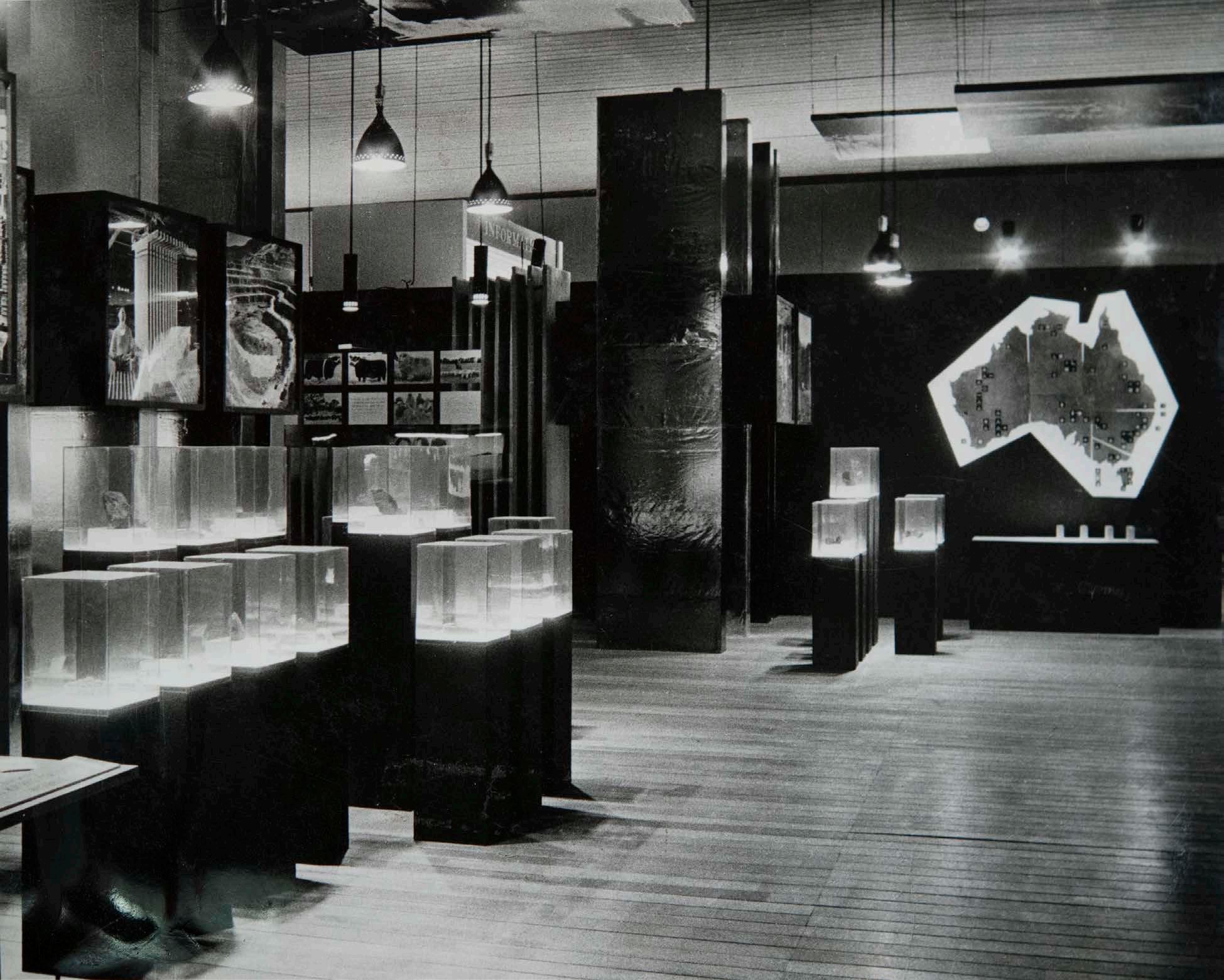
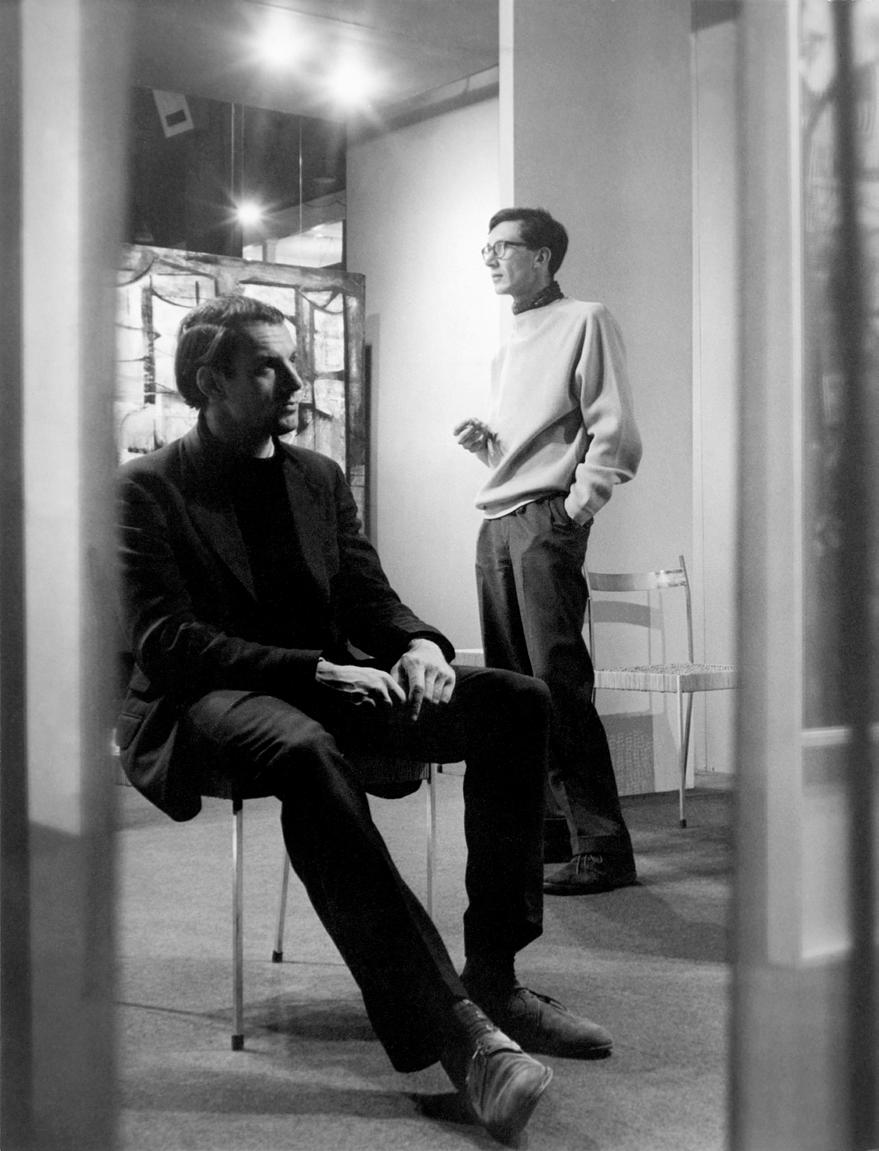
Pages 22–23
Frederick Romberg, Plans for Prefabricated Steel House for Mass Production, 1945, diazo-process print with watercolour, 55.3 x 98.0 cm, RMIT Design Archives: Robin Boyd and Frederick Romberg Collection
Pages 24–25
Frederick Romberg, Architectural scrapbook, 1938–1953, 1980–1992, photographic paper, ink, paper, 32.5 x 52.0 cm (closed), RMIT Design Archives: Robin Boyd and Frederick Romberg Collection
20 MELBOURNE MODERN POST-WAR ARCHITECTURE AND INTERIOR DESIGN
George Kral and Bernard Joyce (designers), Interior of the Australian Pavilion at the Fourth Tokyo International Trade Fair, 1961, photographer unknown, RMIT Design Archives: George Kral Collection
1 Harriet Edquist, ‘The Shaping of Design’, in Philip Goad, Ann Stephen, Andrew McNamara, Isabel Wünsche, Harriet Edquist, Bauhaus Diaspora and Beyond. Transforming Education Through Art, Design and Architecture, Carlton, Vic.: Miegunyah Press, 2019, 196–212.
2 Harriet Edquist, Frederick Romberg. The Architecture of Migration 1938–1975, Melbourne: RMIT University Press, 2000, 15–17.
3 Quotation from Frederick Romberg, ‘Before Gromboyd: An Architectural History’, typescript memoir, 1986, RMIT Design Archives, Romberg and Boyd Collection, 0020.2008, box 51.
4 Granville Wilson, Centenary History. Faculty of Environmental Design and Construction. Royal Melbourne Institute of Technology, Melbourne: RMIT, 1987, 17.
5 The information from staff lists was kindly supplied by Catrina Sgro, RMIT University Archives, 11 April 2019. RMIT’s archival records for the early period are incomplete: often staff lists held in RMIT Archives, lists published in the annual Prospectuses and the evidence of staff and students themselves, do not align and one has to make a best guess. For example, while there is evidence in Romberg’s archive that he taught at WMC in 1945–46, his name does not appear in the RMIT Archive’s employment lists for those years.
6 Harriet Edquist, Ernest Fooks, Architect, Melbourne: School of Architecture & Design, RMIT, 2001; Catherine Townsend ‘Ernest Fooks in Vienna’, The House Talks Back, Melbourne: MSD Masters Exhibition, Melbourne School of Design, 2016, 4-11.
7 David Nicholls, ‘Fuchs, Heath and the HCV’, The House Talks Back, 16-17.
8 Australian Home Beautiful (AHB) articles include ‘Simplicity in furnishing a small house’, AHB, 1 May 1940, 25–7; ‘An Architect Visits Norway’, AHB, 1 July 1940, 24–6; ‘Function and Beauty should combine in Interior Design’, AHB, April 1942, 12–3, 33; ‘Form follows function. The fundamental principles of interior decoration’, AHB, June 1943, 19–21; ‘Yesterday and Tomorrow. Town Development Past and Future’, AHB, February 1944, 6–9 (part 1) and March 1944, 6–10 (part 3); and ‘The blight of a crowded city’, AHB, April 1946, 12–3.
9 Ernest Fooks, X-ray the City! The Density Diagram: Basis for Urban Planning, with a foreword by H C Coombs, Melbourne: Ruskin Press, 1946.
10 Nicholls, ‘Fuchs, Heath and the HCV’, 16.
11 Wilson, Centenary History, 41.
12 Harriet Edquist, ‘Vienna Abroad: Viennese interior design in Australia 1940–1949’, RMIT Design Archives Journal, vol. 9, no. 1, 2019, 26, 35. In Sterne’s obituary in Jargon, it was stated he studied ‘at the technical college in Giessen, Germany, and at the universities
of Prague and Vienna, where he graduated as an architect’ and that he ‘was also awarded a diploma in Interior Design’; ‘Frederick F. Sterne’, Jargon: Melbourne Technical College Annual Magazine, 1951, 51.
13 Mary Jane Seymour and Frederick Sterne, ‘Joanna Plans Her Home’, Australian Home Beautiful, May 1946, 8–11; ‘Joanna Plans Her Home’, AHB, June 1946, 12–14; ‘Joanna Plans A Home: Furniture is designed for Dining Room and Hall’, AHB, July 1946, 27–30; ‘Joanna Plans A Home: Discussion on Furnishing a Bedroom in Modern Style’, AHB, August 1946, 27–30; ‘Joanna Reviews Her Plans’, AHB, November 1946, 20–22.
14 Edquist, ‘Vienna Abroad’, 4-35.
15 Melbourne Technical College, 1936 Prospectus, Melbourne: MTC, 1936, 16.
16 Melbourne Technical College 1947 Prospectus, Melbourne: MTC, 1947, 173.
17 Melbourne Technical College 1949 Prospectus, Melbourne: MTC, 1949, 155.
18 This information was kindly supplied by Catrina Sgro, RMIT University Archives, 11 April 2019.
19 Fritz Rosenbaum’s name appears in the Part Time Instructors Record Book for 1949 teaching evening class in Interior Design.
20 Wilson, Centenary History, 25. An open piano with sheet music is depicted in the photograph of Sterne’s South Yarra flat published in Australian Home Beautiful, May 1946, 11.
21 ‘Frederick F. Sterne’, Jargon: Melbourne Technical College Annual Magazine, 1951, 51.
22 Wilson, Centenary History, 25.
23 Harriet Edquist, ‘George Kral (1929-1958): Interior designer, graphic designer’, RMIT Design Archives Journal, vol. 3, no. 2, 2013, 12–23 and Harriet Edquist, ‘George Kral and the Gallery A Design Group’, in Goad et al., Bauhaus Diaspora, op. cit., 201–2.
24 ‘Three coffee lounges’, Architecture and Arts, no. 52, December 1957, 43.
25 The chronology of the Gallery A Design Group has been extrapolated from the dated drawings of the Gallery A Design Group in the RMIT Design Archives.
26 This information was kindly supplied by Catrina Sgro, RMIT University Archives, 11 April 2019 and sourced from a letter of application for Lecturer in Interior Design, Department of Architecture and Building 21/07/1961), RMIT Archives Collection Series 1999/057/210 - Personal Files (terminations – pre1990 inclusive).
MELBOURNE MODERN 21
ENDNOTES

22 MELBOURNE MODERN
ARCHITECTURE AND INTERIOR DESIGN
POST-WAR

MELBOURNE MODERN 23

24 MELBOURNE MODERN

MELBOURNE MODERN 25
POST-WAR ARCHITECTURE AND INTERIOR DESIGN
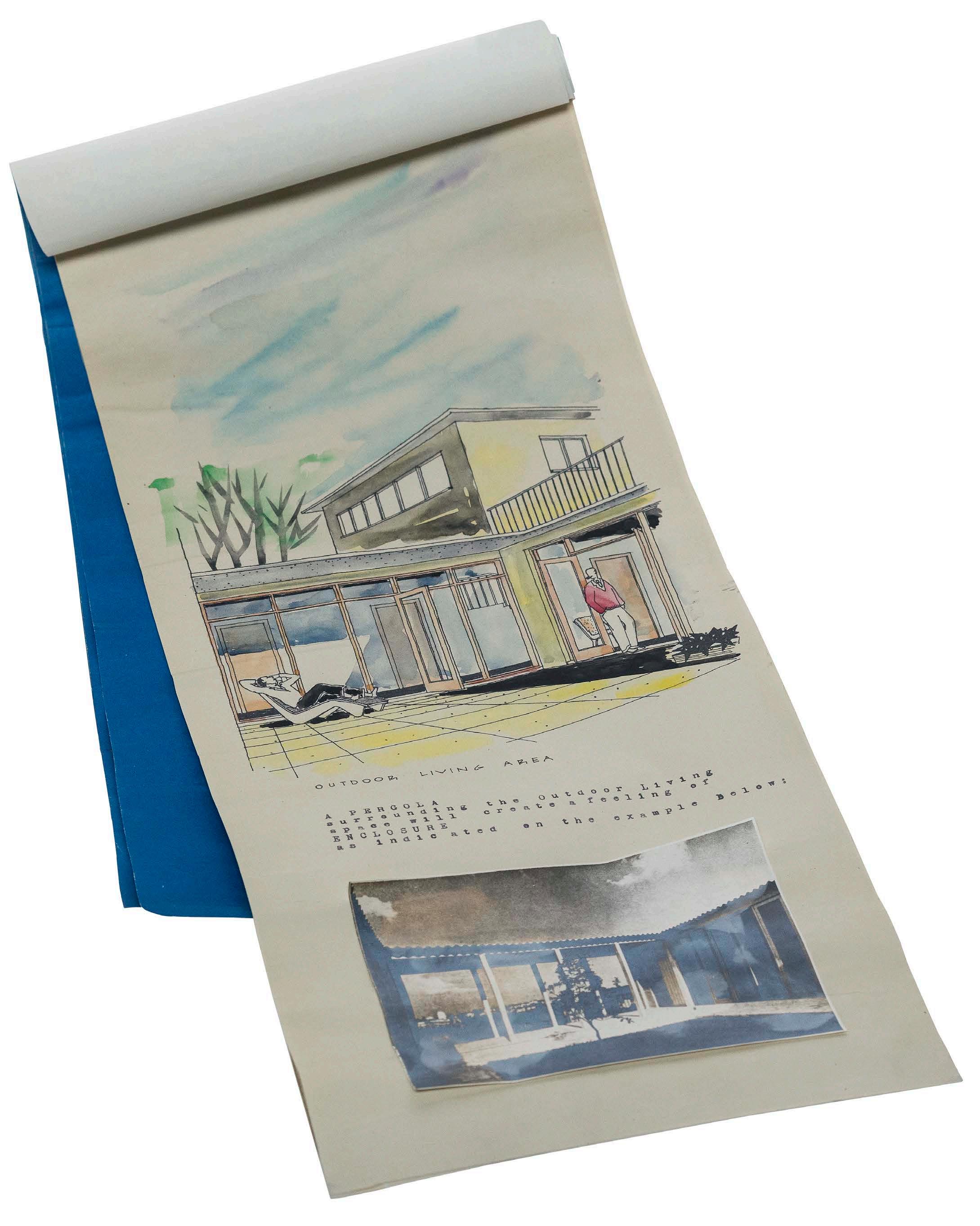
Ernest Fooks, Analysis Sketch Plans of Proposed Residence in Cantala Ave Caulfield, 1951, diazotypes, photographs, typescript, stapled in covers, 51.0 x 22.0 cm, RMIT Design Archives: Ernest Fooks Collection
Opposite Top
Ernest Fooks, Perspective for Proposed Block of 6 Flats at 26 Melby Avenue, Caulfield for Multiplex (Vic.) Pty Ltd, 1960, pencil, pen, ink on paper, image: 46.5 x 67.5 cm; sheet: 50.5 x 71.7 cm, RMIT Design Archives: Ernest Fooks Collection
Opposite Bottom
George Kral, Associated Pulp and Paper Mills (APPM) Exhibit, 1958, photographer: Wolfgang Sievers, RMIT Design Archives: George Kral Collection
26 MELBOURNE MODERN
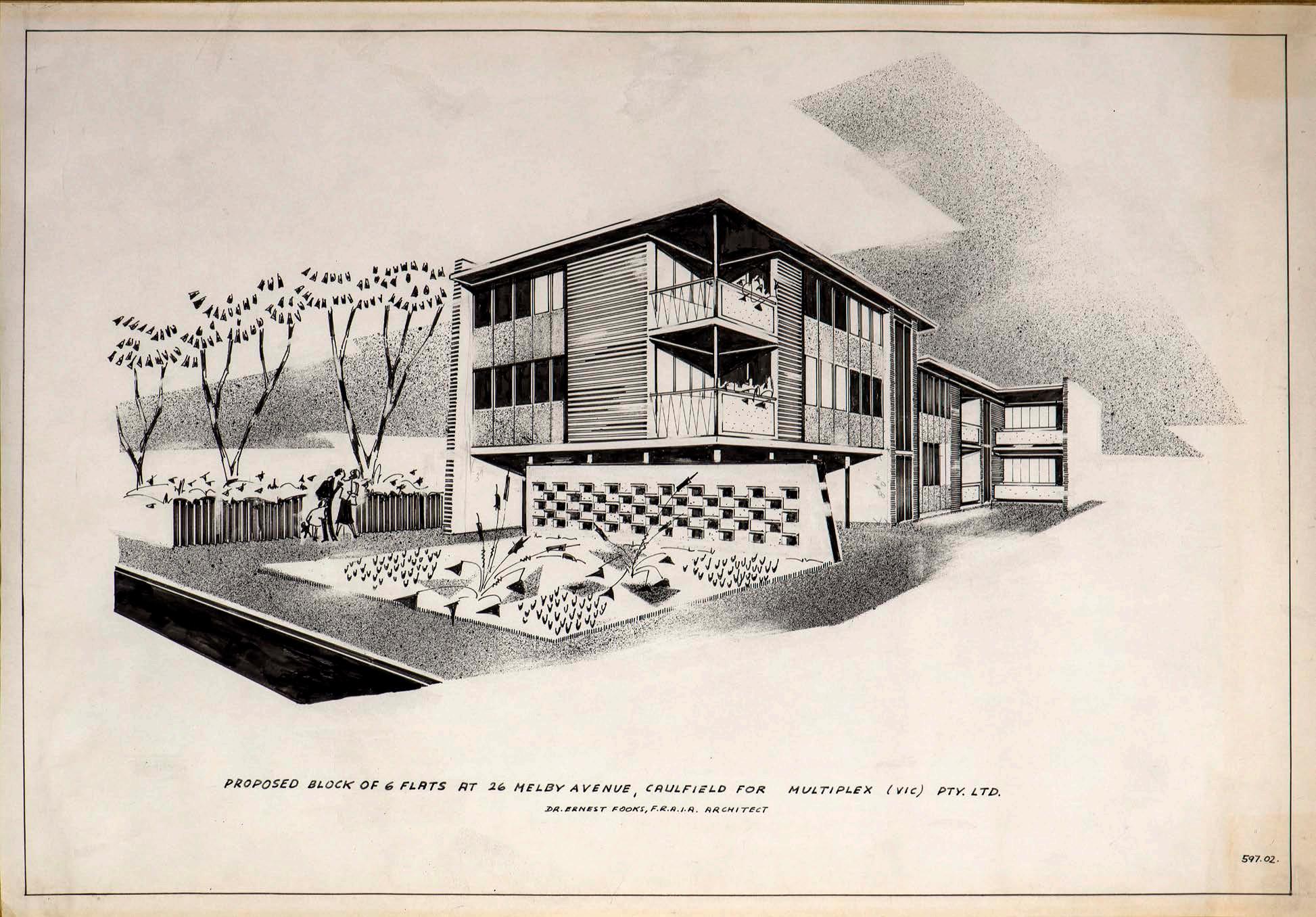
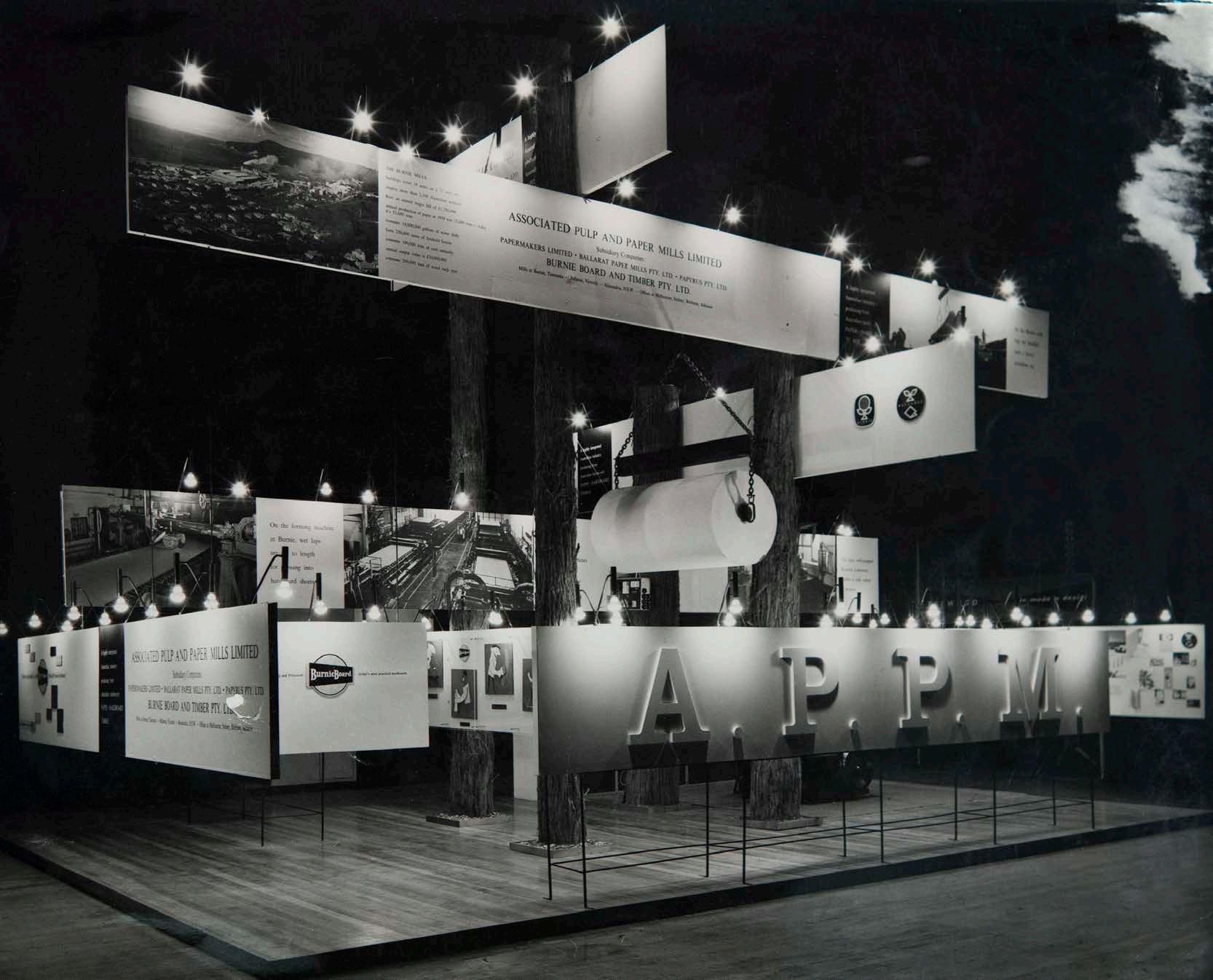
MELBOURNE MODERN 27
Above George Kral for the Gallery
A Design Group, Corporate design proposal for Allan’s World of Music, 1971, ink, cardboard, letterpress printing, plastic comb binding, clear plastic covers, 39.3 x 35.3 cm (closed), RMIT Design Archives: George Kral Collection
Left
George Kral, Jiri Tancibudek - Oboe, c. 1962, double sided colour printed brochure, 22.5 x 28.5 cm, RMIT Design Archives: George Kral Collection
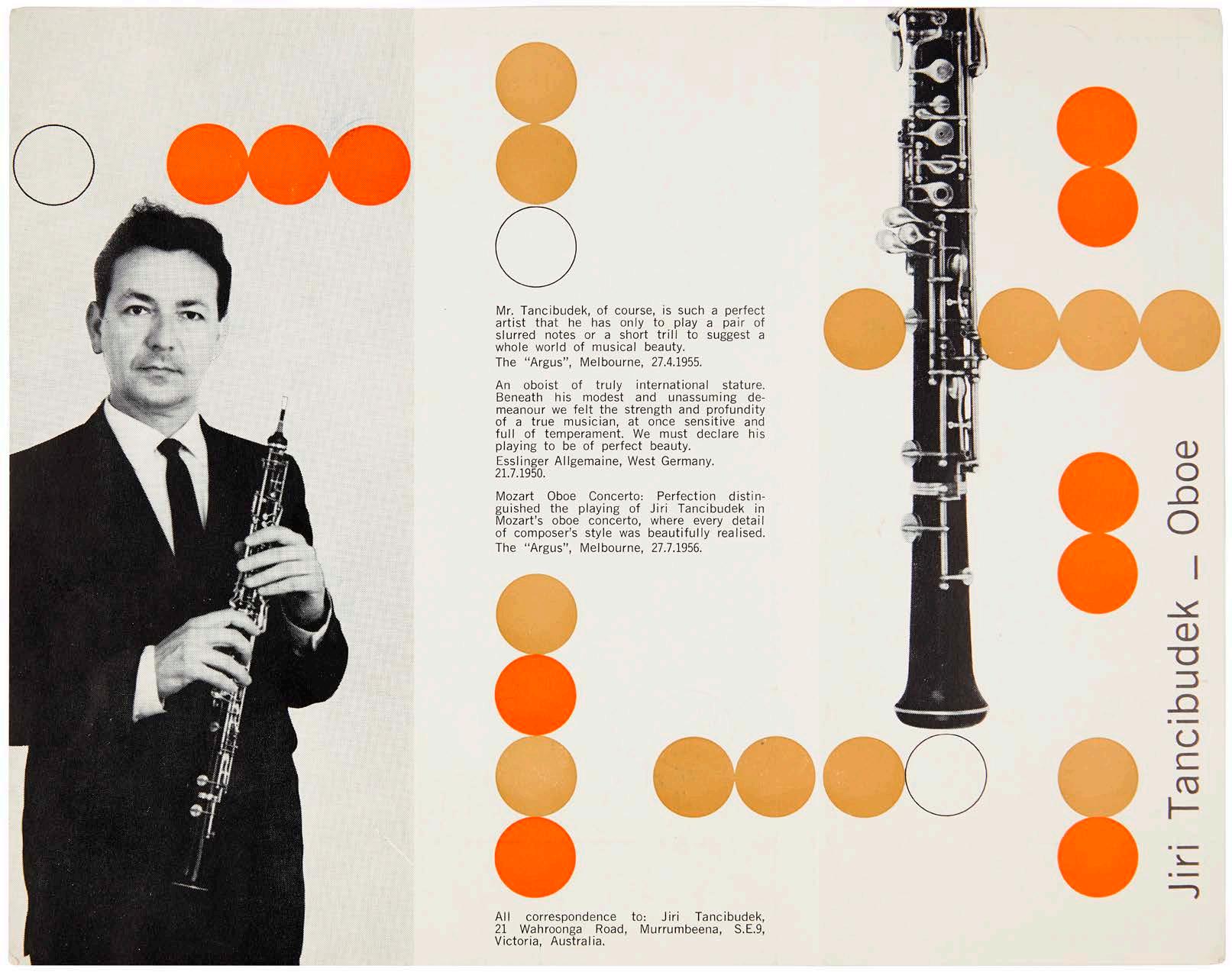
Opposite George Kral for the Gallery
A Design Group, New shop for Mr. S. Jesek at Manuka, Canberra, ACT (perspective sketch of Centroswiss homewares), 1962, ink, pencil, acetate, image: 55.0 x 73.5 cm; sheet: 60.7 x 75.0 cm, RMIT Design Archives: George Kral Collection

28 MELBOURNE MODERN POST-WAR ARCHITECTURE AND INTERIOR DESIGN

MELBOURNE MODERN 29
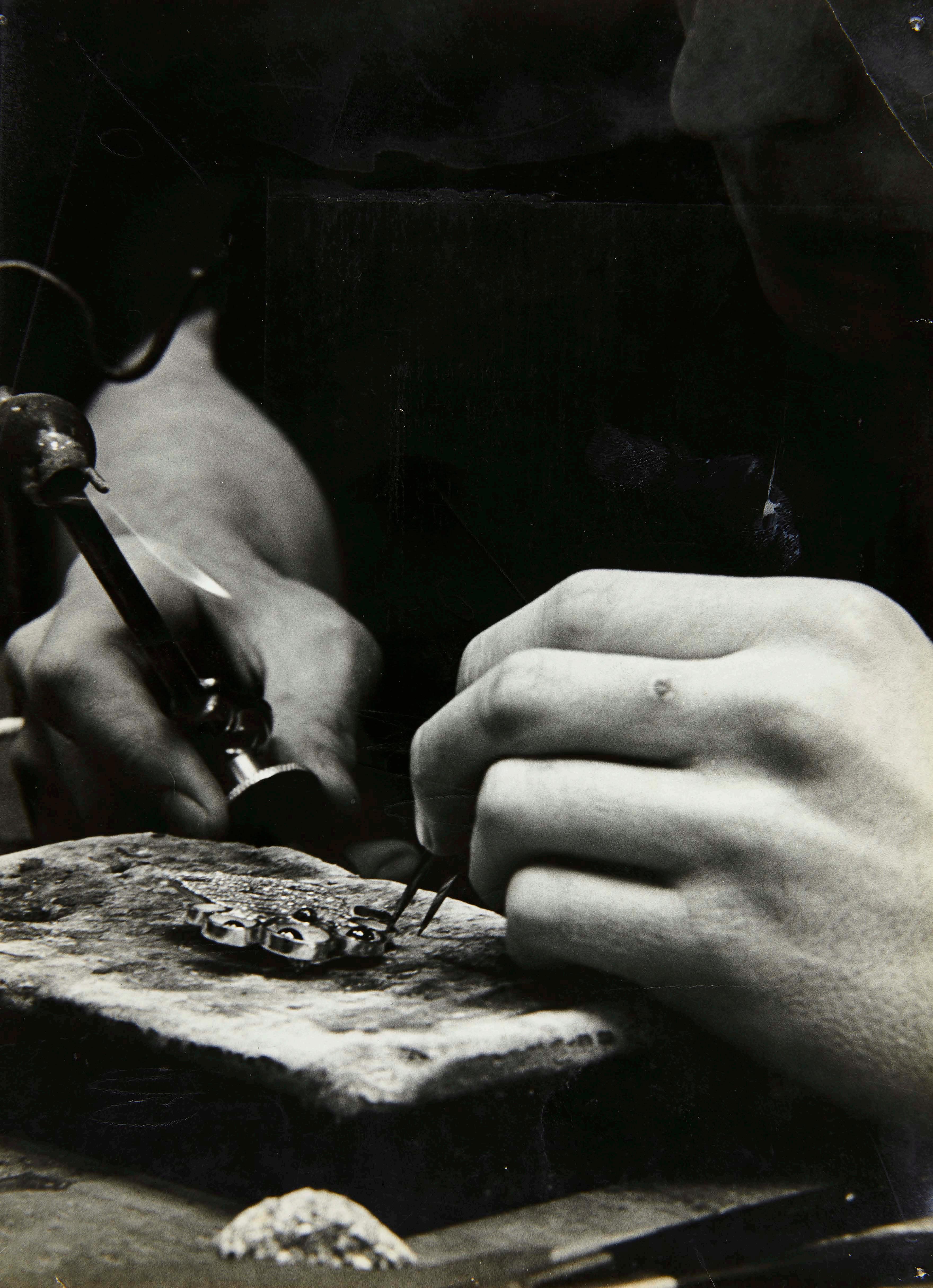
victor vodicka AND THE POST-WAR TRANSFOR MATION OF GOLD AND SILVERSMITHING HARRIET EDQUIST 2
Opposite Robert Baines as a student at work on a silver brooch, 1970, Max Williams Photography Studio, RMIT Design Archives: Victor Vodicka Collection
One of Greenhalgh’s first appointments was Vaclav (Victor) Vodicka, a Czech goldsmith who had migrated to Australia in 1950 after the Communist takeover in Czechoslovakia. He joined RMTC in 1955 and over the succeeding years transformed gold and silversmithing into the leading course of its kind in Australia.
According to Vodicka, gold and silversmithing at RMIT went back as far as 1927 ‘when the art-metal certificate was established on a part-time basis’.1 In 1930 when Englishborn artist T.F. Levick was head of the Department of Art and Applied Art, a subject called ‘decorative metalwork’ was taught by E.G. Cousins. By 1936 Harold Brown, trained at Ballarat School of Mines, had become head of the Department and the newly named ‘art metalwork’ was taught by N.H. Ferguson. During the war the record appears incomplete, but enamelling was introduced in 1940 and four years later ‘art metalwork’ was still on the syllabus. It remained there, taught by silversmith Lawrence R. Ferguson until 1953. Ferguson taught ‘full-time students and a number of part-time students (hobbyists) who had been enrolled to boost gold and silversmithing numbers and justify its existence’.2 In 1951 one of these was sculptor Inge King, who attended evening class and learnt silversmithing and gem setting; her work, exhibited from 1951, showed ‘Celtic, Assyrian and Aztec influences’.3 In 1952 the first four Diplomates from Ferguson’s course graduated, after which Ferguson left to study in England.
The change came in 1954. Alfred Simm, who had joined the College the previous year, replaced Ferguson and the course was rebadged ‘gold and silversmithing’. Simm was an English jeweller who had come to Australia with his family in 1953.4 According to The Herald, who quickly profiled his work at the College, he was a Fellow of the Royal Society of the Arts (FRSA) and had obtained the National Diploma of Design (NDD).5 The NDD was introduced in Britain in 1946, when the Ministry of Education reorganized British art and design education. Under this system students took a Ministry’s Intermediate Certificate in Art and Crafts followed by the NDD.6 The NDD was one of the pedagogical models later referenced by the RMIT School of Art, which generally looked to England for clues about educational reform in art
and design. The 1955 prospectus indicates that Simm was still in gold and silversmithing, though in February of that year he returned to England.
Vodicka was appointed to the position in August 1955. What the students did between February and August is anyone’s guess; possibly Vodicka was already teaching and was appointed to fill the vacancy created by Simm.
The first visual evidence of silverwork produced by College students is a slide dated 1955 in Vodicka’s archive.7 It shows a silver cylindrical vessel and cover produced by a student who would have studied under Simm. Vodicka recalled the course at this time included two Diploma students, and this piece is presumably by one of them.8 What this evidence suggests is that Vodicka inherited a tiny but established course that had produced capable graduates, and he built from there. Simm seems to be important in this history, for it was he who was responsible for the transition out of the old-fashioned, Arts and Crafts inspired ‘art metalwork’ to the more professionally focused ‘gold and silversmithing’. And here the model was another English institution: the Royal College of Art (RCA), which had upgraded its course structure and suite of awards in 1948-49 to include gold and silversmithing.9
Students who graduated in 1956 would have had both Simm and Vodicka as teachers and their work, recorded in slide format among Vodicka’s papers, included a candelabra, chalice, mug, and a drinks set comprising a silver jug and beakers on a tray. Vodicka’s first Diploma students graduated in 1957; their pieces included a coffee pot, teapot and mug in classically inspired modernist form. Some slides are identified by the student’s name: G. Hildebrand, for example, designed and produced a rose bowl and a lidded box, the exterior surface of which was highlighted with a raised, abstract linear decoration.10
The most illustrious of Vodicka’s students in 1957 was Geelong-born Stuart Devlin. Devlin was a precocious talent who, by the age of 13, had hand-built a silver tea service. After school he trained as a teacher at Gordon Technical College and was therefore bonded to the Education Department. By 1956 he was in Melbourne teaching at Prahran Technical College and in 1957 also undertaking
MELBOURNE MODERN 31
In 1955 sculptor Victor Greenhalgh succeeded Harold Brown as head of the Department of Applied Art at what was then RMTC.

MELBOURNE MODERN 32
AND SILVERSMITHING
POST-WAR GOLD
Opposite Victor Vodicka with Emily Hope and Margaret Goldthorpe, in Sheila McFarlane, ‘There’s gold in their fingertips’, Australian Women’s Weekly, 8 June 1960, Teenagers’ Weekly supplement, p. 15.
Left Victor Vodicka, Anglo-Saxon brooch found at Ragley Park 600 AD and Anglo-Saxon bowl found at Wilston, Wilts. 650-700 AD (leaves from a manuscript history of gold and silversmithing), pen and ink on paper, c. 1964, 33.5 x 20.5 cm each, RMIT Design Archives: Victor Vodicka collection.
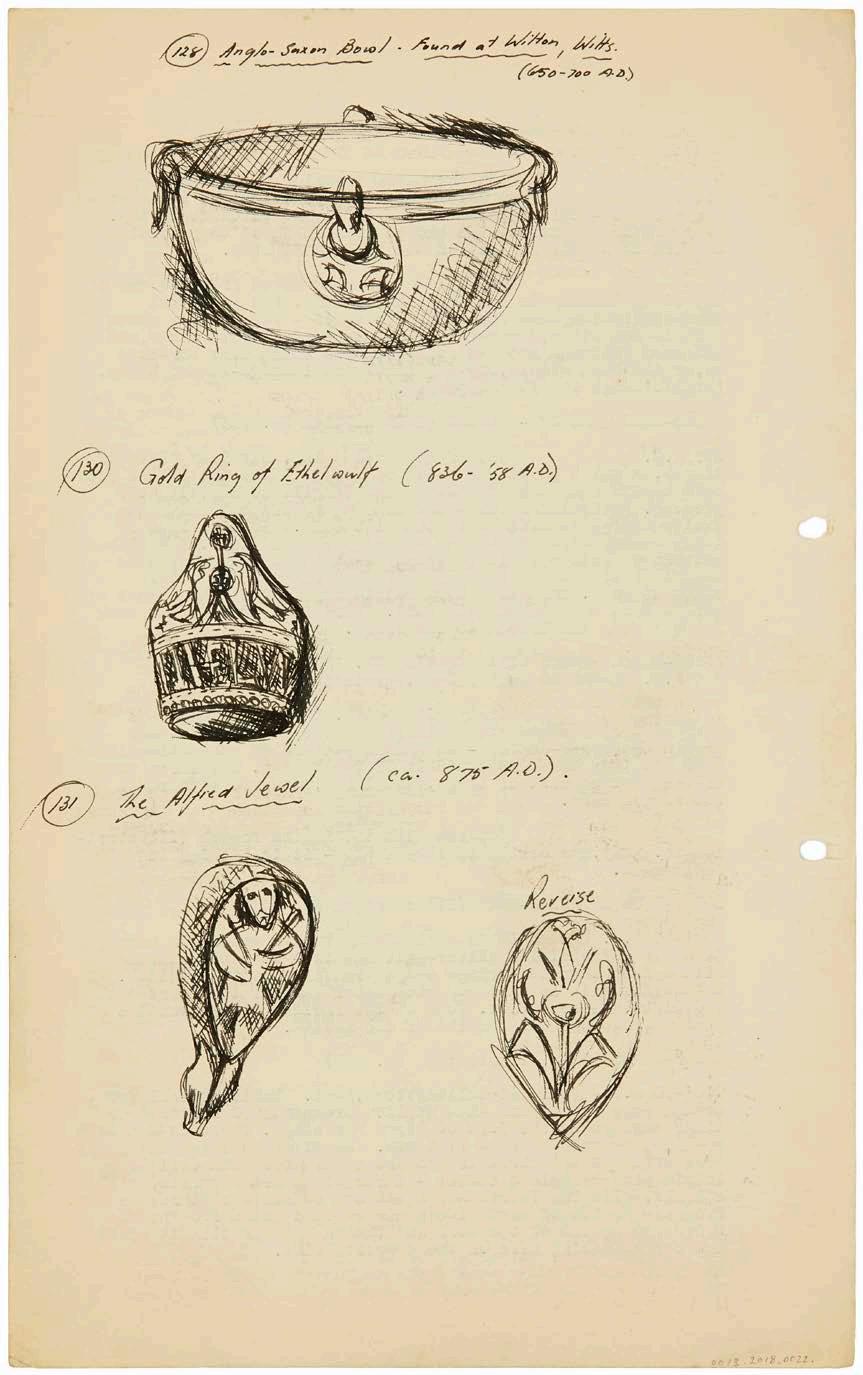

Vodicka’s Diploma course, completing it in a year. There was very little that Vodicka could have taught him, as is clear when we compare his graduating piece – an angular gilding metal and Bakelite teapot which seems to anticipate the 1980s – with the standard fare of other students.11 After numerous awards and scholarships Devlin won the commission to design Australia’s first decimal currency in 1964 and thereafter became one of the most successful goldsmiths in Britain, where he spent the rest of his life. Vodicka kept a proud eye on Devlin’s career as the number of press cuttings in his archive attest.
In 1958 Emily Hope and Margaret Goldthorpe became the first women to enroll full time into the course. As they were not attached to the Education Department Vodicka was encouraged to write a full-time curriculum.12 A battered piece of paper in his collection lists the projects the students could embark on in 1960, covering flatware, holloware, tableware, a ‘television lamp’ and jewellery pieces such a necklace, pendant, ring, bracelet and brooch. Goldthorpe specialised in jewellery and won an award for her work, and it may well be that her success prompted Vodicka to ask for a jeweller to join him on the staff. While Vodicka had included jewellery in the course he saw himself primarily as a silversmith, and so in 1960 he persuaded Greenhalgh to fund a part-time jeweller to teach the evening classes. Wolfram Wennrich, a highly accomplished goldsmith who had received his training in Hamburg after the war, took on this role becoming full time in 1963.13 Wennrich and his family had been sponsored by Melbourne jeweller Max Hurwitz to migrate to Australia in 1953.
From 1962 to 1964 Vodicka doubled the intake of students and concurrently reduced the numbers of parttimers. At the same time the ambition and standard of work produced by the students leaped. Throughout the 1960s Vodicka expanded the course with more specialised subjects: design in 1963 and history of gold and silversmithing in 1964. The Vodicka archive holds a folder containing an illustrated typescript of a history of goldsmithing and silversmithing which suggests he contemplated publishing a text book for students.14 In 1969 a subject ‘research in methods of production’ was introduced in third year. According to
MELBOURNE MODERN 33
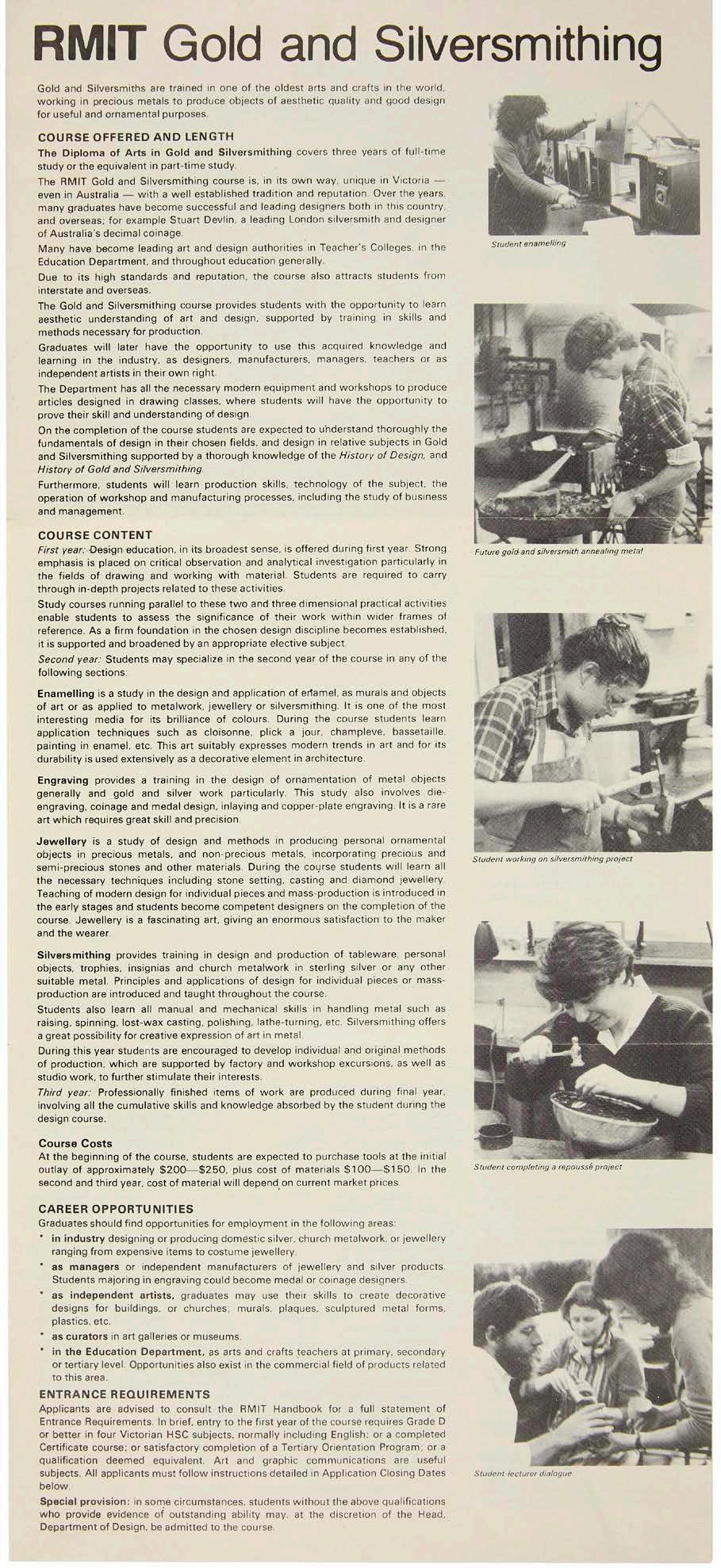
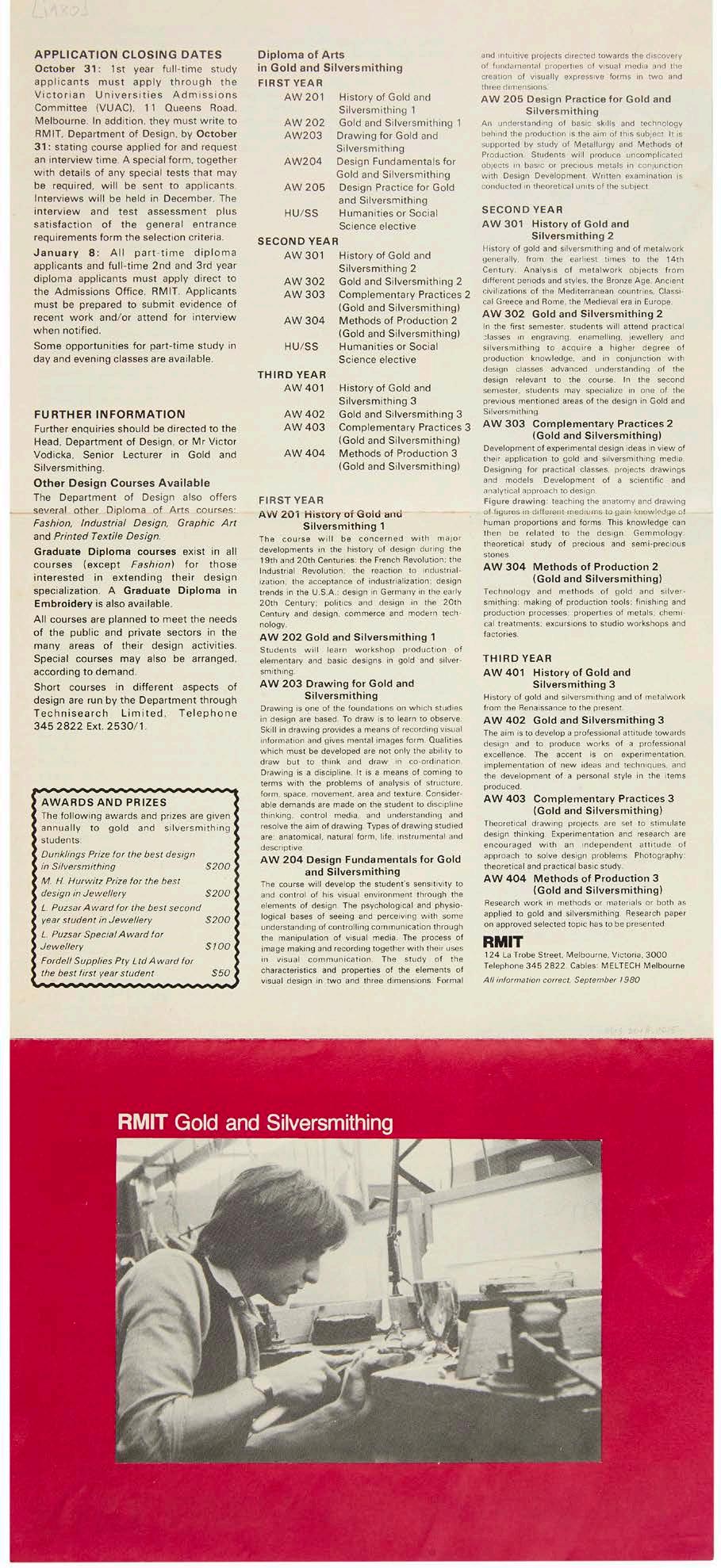
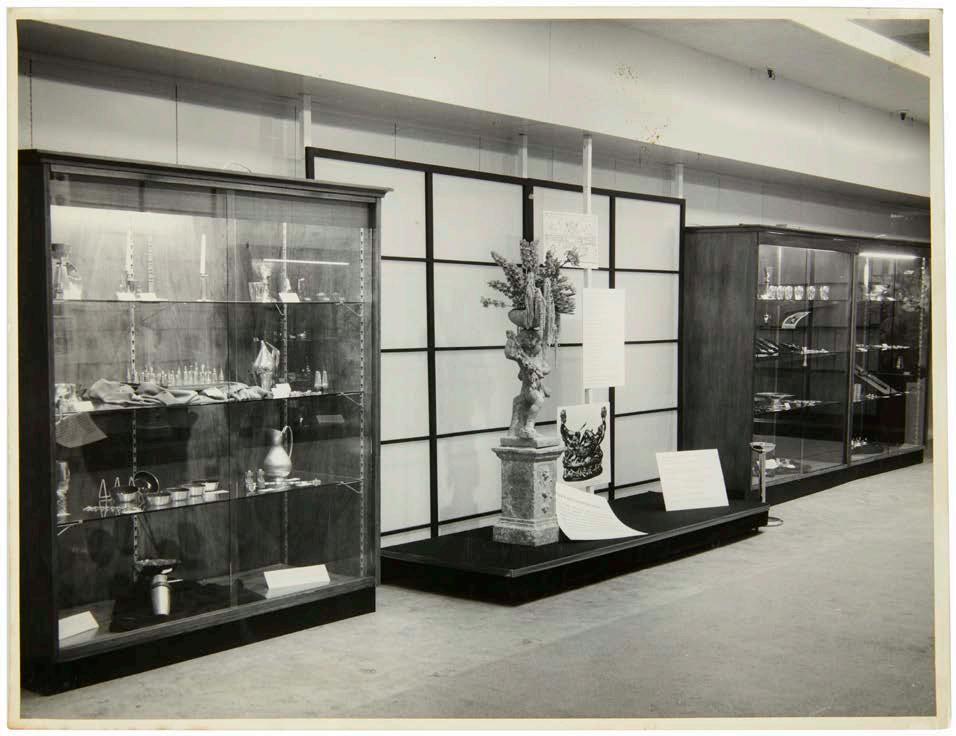

34 MELBOURNE MODERN
Vodicka, this subject included a dissertation at the end of the year which ‘considerably improved the standard of the course and influenced the design generally’.15 These innovations parallel and were influenced by contemporary changes in international design education, particularly those in Britain which followed in the wake of the Coldstream Report of 1960.16 According to Kate Aspinall, the Coldstream Report marks ‘a graspable moment of displacement in the British art world. It represents a shift between an educational system based on disciplined studies of techniques and crafts to one based on conceptual thinking and design’.17 Among the report’s recommendations was mandatory history courses taught by qualified historians. Extracts from Coldstream were included in Victor Greenhalgh’s 1961 ‘The First Report of the Place of the School of Art, RMIT in the Structure of Art Education in Victoria’.18 Within this context Vodicka’s inclusion of ‘history of the subject’ in gold and silversmithing (which was in fact a fixture of all art and design courses) and his introduction of a specialised design subject and research thesis are pertinent, as is Greenhalgh’s appointment of art historian Margaret Garlick (now Margaret Plant) as senior lecturer in the History of Art in 1968 – the first such appointment in an Australian art school. Miloslav ‘Dismas’ Zika, who had arrived from Prague with his family in 1949, also taught history part-time.
The character of the art school was shaped by its common courses shared by all students; they undertook professional training in their chosen discipline but also studied across the spectrum of classes the school offered. So, for example, Robert Baines who commenced in 1968 recalls: …in Complementary Practice we had lecturers like Vincas Jomantas and Ernesto Murgo in sculpture, James Meldrum and Andrew Sibley in painting, Nornie Gude for life drawing and Dr. Zika for Art History. It was a broad Fine Art experience.19

Marian Hosking recounts similar memories. Her education at RMIT ‘was thorough in technical skill and with a broader fine art ethos’.20 Art history was taught by Garlick and Zika, the latter of whom ‘brought the decorative arts to the forefront, he had a theory that at certain times the plastic arts led and
challenged accepted practice. Studying a so-called lesser art, this was very empowering’.21
Like his RMIT colleagues Tate Adams in Printmaking and Gerard Herbst in Industrial Design, Vodicka kept his students in the public eye through articles in the press and through awards, competitions and exhibitions. Named awards were a feature of RMIT and were offered by gold and silversmithing in the 1960s if not earlier. In 1962/63 W.E. McMillan, a friend and admirer of Vodicka’s work at the College, instituted an acquisitive award for outstanding student work, and in 1966 Vodicka held a student competition to design a medal for the winner of the McMillan prize. The W.E. McMillan Collection inspired other acquisitive awards and together they represent today a unique record of almost 60 years of student work at RMIT. Students were also encouraged to enter the Made in Australia Awards. Two foolscap sheets in the Vodicka archive list student prize winners from 1965 and 1966 for named prizes with monetary awards, and about 40 entry forms for these competitions from the 1960s and 70s indicate the ambitious benchmarks set for the students.
Prizes supplied by industry included the M. Hurwitz annual award for jewellery; Dunklings award for silversmithing; K.G. Luke annual award for the best second year student in silversmithing; L. Puzsar annual award for the best second year student in jewellery and the L. Puzsar special award for jewellery. These were professional Melbourne gold and silversmiths in whose workshops talented students could find employment after graduation. Melbourne had a rich tradition of successful manufacturing jewellers, such as Dunklings, established in the 1880s, and it benefitted after the war from an influx of émigré craftspeople expert in traditional methods of hand crafting jewellery. Hurwitz for example had arrived in Melbourne in 1939 and established himself as a manufacturing jeweller and dyemaker in Crossley Lane. In his workshop could be found ‘craftsmen from Italy, Poland, Russia, Greece and Latvia as well as diamond-setters from France and Germany’, and he employed RMIT graduates such as Robert Baines.22
In 1967 Vodicka organized the first student exhibition in B8, the exhibition room in the Art Department’s Building 2.
MELBOURNE MODERN 35
It contained work made over the previous five years, including Robert Cranage’s Water Jug, 1962, Howard Tozer’s repousse Vessel, n.d., and Gregor Scarlett’s Teapot with wooden handle, 1967. Governor General Lord Casey and Lady Casey visited their exhibition during a brief stay in Melbourne, generating considerable publicity.23 In 1968 there was an exhibition at jewellers Paul Bram, which suggests that under Wennrich jewellery was surging ahead.
The development of gold and silversmithing at RMIT absorbed post-war influences from both Scandinavia and Germany. Vodicka and Wennrich were not immune to this, and their own work developed in parallel with their students. For example, Wennrich exhibited in Melbourne and Sydney together with his recent graduates Marian Hosking, Norman Creighton and Rex Keogh in 1974.24 Vodicka kept pace with contemporary silversmithing and maintained a small
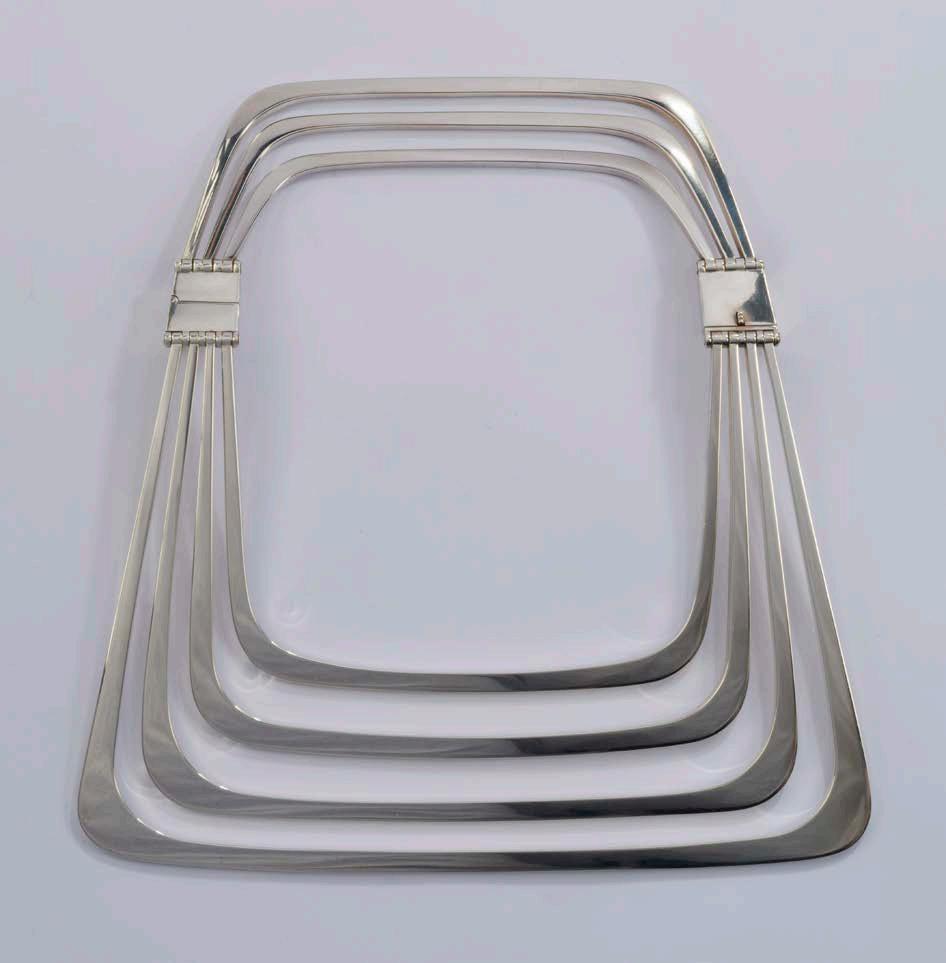

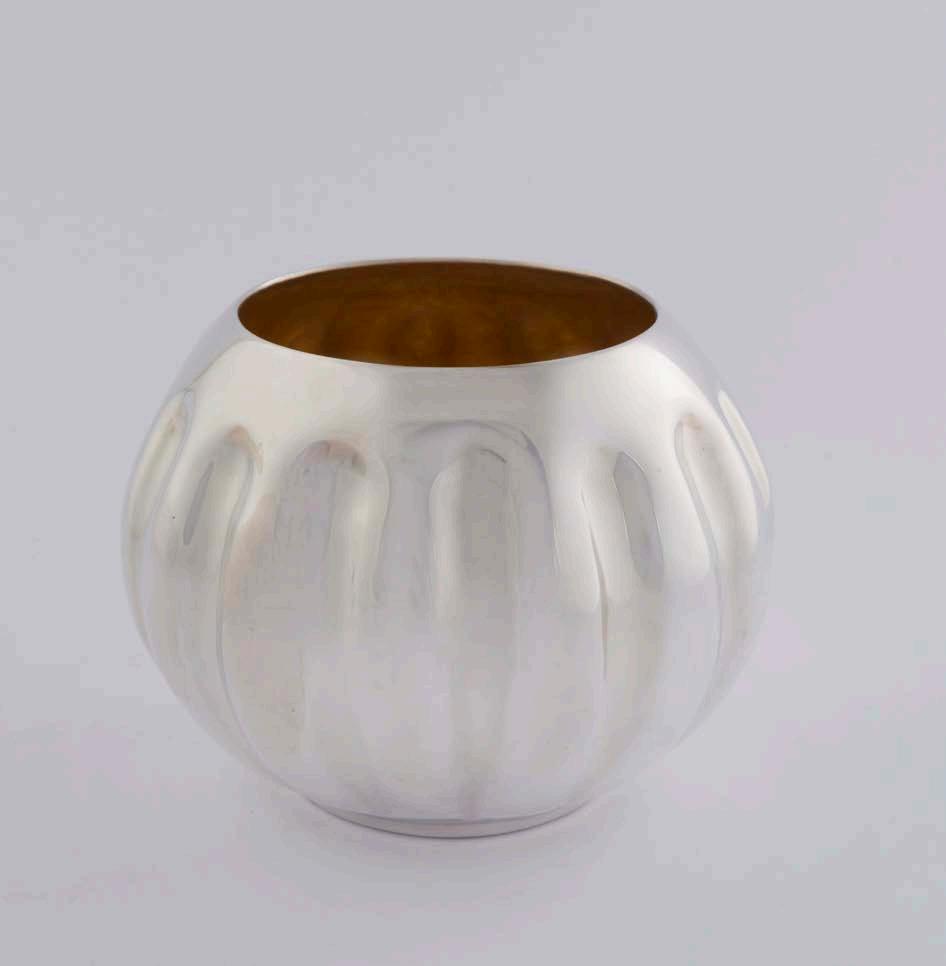
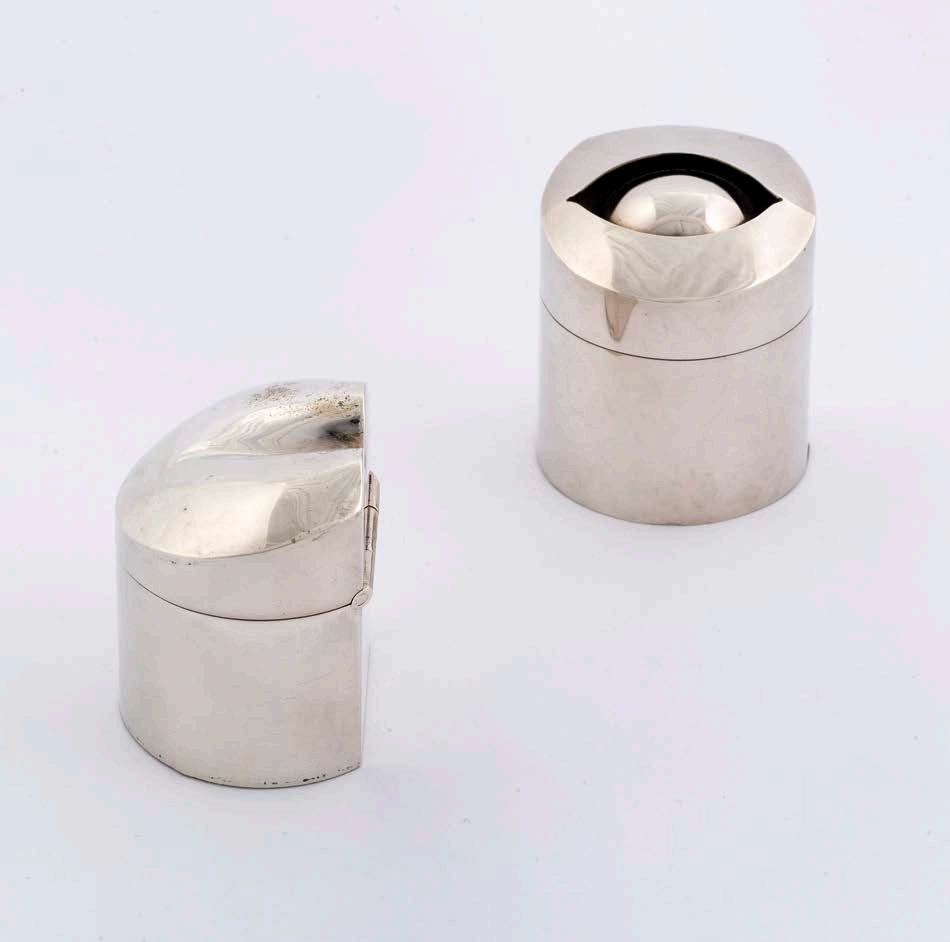
practice undertaking commissions for the university and external clients such as the College of Nursing and Romberg’s Lutheran Holy Trinity church in Canberra.
Graduates from the Vodicka and Wennrich years included Raymond Stebbins, Australia’s first Professor of Gold and Silversmithing, Tozer, an expert enameller who led the teacher-training program at Melbourne State College; Creighton and Keogh, who were influential in the formation of the Meat Market Craft Centre in Melbourne in 1977; Baines, who has played a major role in Australian gold and silversmithing since his graduation in 1970; and Hosking, who, like Baines, is a ‘Living Treasure: Master of Australian Craft’. They have been followed by other significant practitioners such as Su san Cohn and Margaret West, each succeeding cohort of graduates building on the legacy of its first émigré teachers Vodicka and Wennrich.
36 MELBOURNE MODERN
Page 34
Top RMIT Gold and Silversmithing (prospectus), September 1980, brochure, 45.8 x 20.6 cm, RMIT Design Archives: Victor Vodicka Collection.
Bottom left
Exhibition of work by RMIT Gold and Silversmithing staff and students at RMIT School of Art, Building 2, October – November 1967, photographer unknown, RMIT Design Archives: Victor Vodicka Collection.
Bottom right
Victor Vodicka, Silver lamp for the College of Nursing, Australia, c. 1950’s, photographer unknown, RMIT Design Archives: Victor Vodicka Collection.
Page 35
Victor Vodicka, RMIT commemorative plate, 1971, copper, enamel, 15.4 cm diameter, RMIT Design Archives: Victor Vodicka Collection.
Page 36
Top left
Peter Gertler, Untitled (pair of boxes), 1973, sterling silver, felt, eye: 4.7 x 4.0 x 4.0 cm, lips: 4.4 x 4.0 x 4.0 cm, acquired through the Dunklings Prize for Silversmithing, 1973, RMIT University Art Collection: W.E. McMillan Collection.
Top right
Kevin George Eastwood, Flexible bracelet, 1966, sterling silver, 19.8 cm length, RMIT University Art Collection: W.E. McMillan Collection.
Lower left
Howard Tozer, Vessel, 1964, silver plated and gilded gilding metal, 8.5 x 11.4 x 11.4 cm, RMIT University Art Collection: W.E. McMillan Collection.
Lower right
Norman Creighton, Neckpiece, 1968, sterling silver, 25.0 x 22.4 x l.0 cm, RMIT University Art Collection: W.E. McMillan Collection.
This page
Norman Creighton and Neita Bartlett with Creighton’s Neckpiece, 1968, which was awarded the Max Hurwitz Prize at RMIT’s special awards for art. Press photograph: ‘A winning necklace for another winner’, The Age, 11 July 1969, p. 11.

ENDNOTES
1 Victor Vodicka, handwritten notes to his opening speech given at a seminar about the gold and silversmithing course in 1978, Victor Vodicka collection, RMIT Design Archives, 2.
2 Vodicka, opening speech given at a seminar about the gold and silversmithing course in 1978, 2.
3 The Age Art Critic, ‘Contemporary work in exhibition’, The Age, Melbourne, 21 October 1952, 2; see also Margaret Vine, ‘Jewellers and Jewellery: European trained, made in Australia’, in Roger Butler (ed.), The Europeans Émigré artists in Australia 1930–1960, Canberra: National Gallery of Australia, 1997, 197.
4 Alfred Simm, arrived Melbourne per New Australia 26 February 1953, application for assisted passage to Australia under the United Kingdom and Australian Government Agreement, Melbourne: National Archives of Australia, MP210/2, 1953/38/132/SIMM A/A/J.
5 ‘Woman’s World: Jeweller’s art’, The Herald, Melbourne, 27 April 1954, 14.
6 John Vernon Lord, Hywel James, Gillian Naylor, ‘Post-war curriculum and assessment: Coldstream, Summerson, art history and complementary studies’, in Jonathan Woodham and Philippa Lyon (eds), Art and Design at Brighton 1859-2009: from Arts and Manufactures to the Creative and Cultural Industries, Brighton: University of Brighton, 2009, URL: http://arts.brighton.ac.uk/ arts/alumni-and-associates/the-history-of-arts-education-inbrighton/post-war-curriculum-and-assessment-coldstreamsummerson-art-history-and-complementary-studies (accessed 6 April 2019).
7 Victor Vodicka’s archive was donated by his son Peter Vodicka to the RMIT Design Archives in 2018.
8 Vodicka, opening speech given at a seminar about the gold and silversmithing course in 1978, 3.
9 Victor Greenhalgh notes the importance of the RCA and Cooper Union School of Art in his 1961 report, ‘The First Report of the Place of the School of Art, RMIT in the Structure of Art Education in Victoria’, Victor Vodicka collection, RMIT Design Archives.
10 The slides are in the Vodicka collection, RMIT Design Archives.
11 Illustrated in Carole Devlin and Victoria Kate Simkin (eds.), Stuart Devlin. Designer Goldsmith Silversmith, Woodbridge, Suffolk, England: ACC Art Books Ltd, 2018, 15.
12 Sheila McFarlane, ‘There’s gold in their fingertips’, The Australian Women’s Weekly, 8 June 1960, 15.
13 RMIT Archives Employee History Cards (2001/084) for Wolf Wennrich state he was appointed 17 July 1963 as a temporary lecturer in jewellery. This temporary position ceased when he resigned in 1979; see also Edquist, ‘The Shaping of Design’ in Goad et al., Bauhaus Diaspora, 205–06.
14 ‘History of Goldsmithing and Silversmithing’, typescript, Victor Vodicka collection, RMIT Design Archives.
15 Vodicka, opening speech given at a seminar about the gold and silversmithing course in 1978, 8.
16 William Coldstream, ‘First Report of the National Advisory Council on Art Education’, London: H.M. Stationery Office, 1960.
17 Kate Aspinall, ‘The ‘Pasmore Report’?: Reflections on the 1960 ‘Coldstream Report’ and its legacy’, Art School Educated Conference, Tate Britain, 11–12 September 2014, URL: https:// www.academia.edu/8524265/The_Pasmore_Report_Reflections_ on_the_1960_Coldstream_Report_and_its_Legacy (accessed 24 February 2019). Greenhalgh cites Coldstream in his ‘First Report’.
18 Greenhalgh. ‘The First Report’, Appendix F.
19 Robert Baines, email correspondence with Harriet Edquist, 13 July 2017.
20 Marian Hosking, email correspondence with Harriet Edquist, 22 July 2017.
21 Marian Hosking, email correspondence with Harriet Edquist, 22 July 2017.
22 As jeweller Kim Bartlett noted in Kylie Davis, ‘Like father like son’ (profile of Kim and Jay Bartlett), Duo, 11 July 2017, URL: http:// duomagazine.com.au/style/like-father-like-son/ (accessed 24 February 2019).
23 ‘The next move will be to Lord Casey’s’, The Sun, 28 November 1967, 8.
24 Untitled article, Craft Australia, vol. 4, no. 1, 1974, 8–9.
MELBOURNE MODERN 37
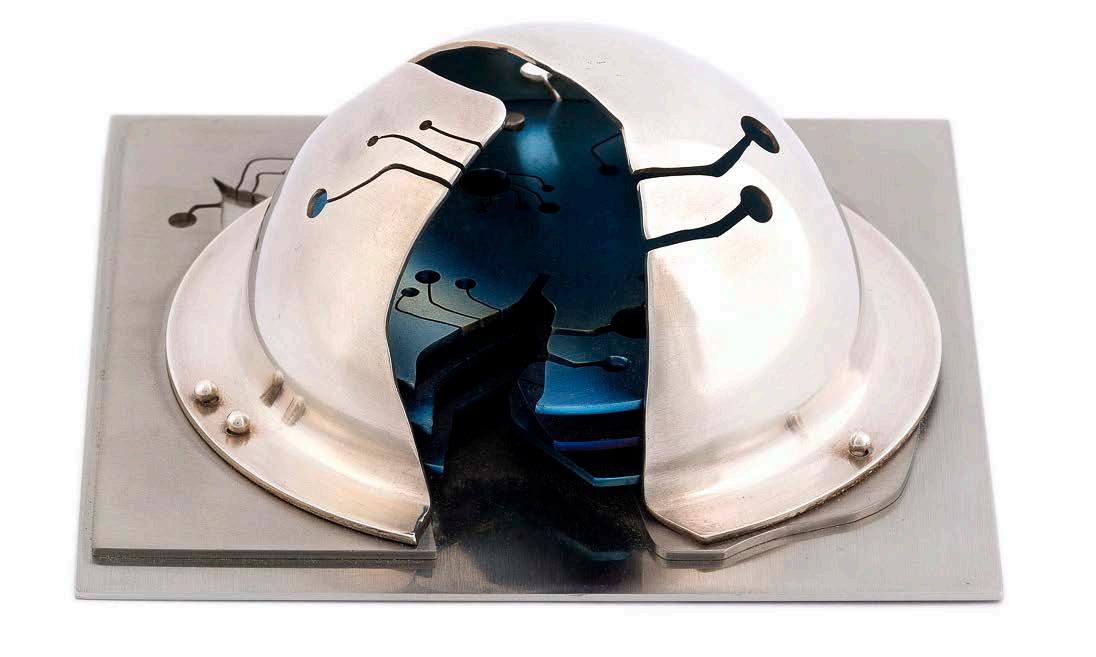
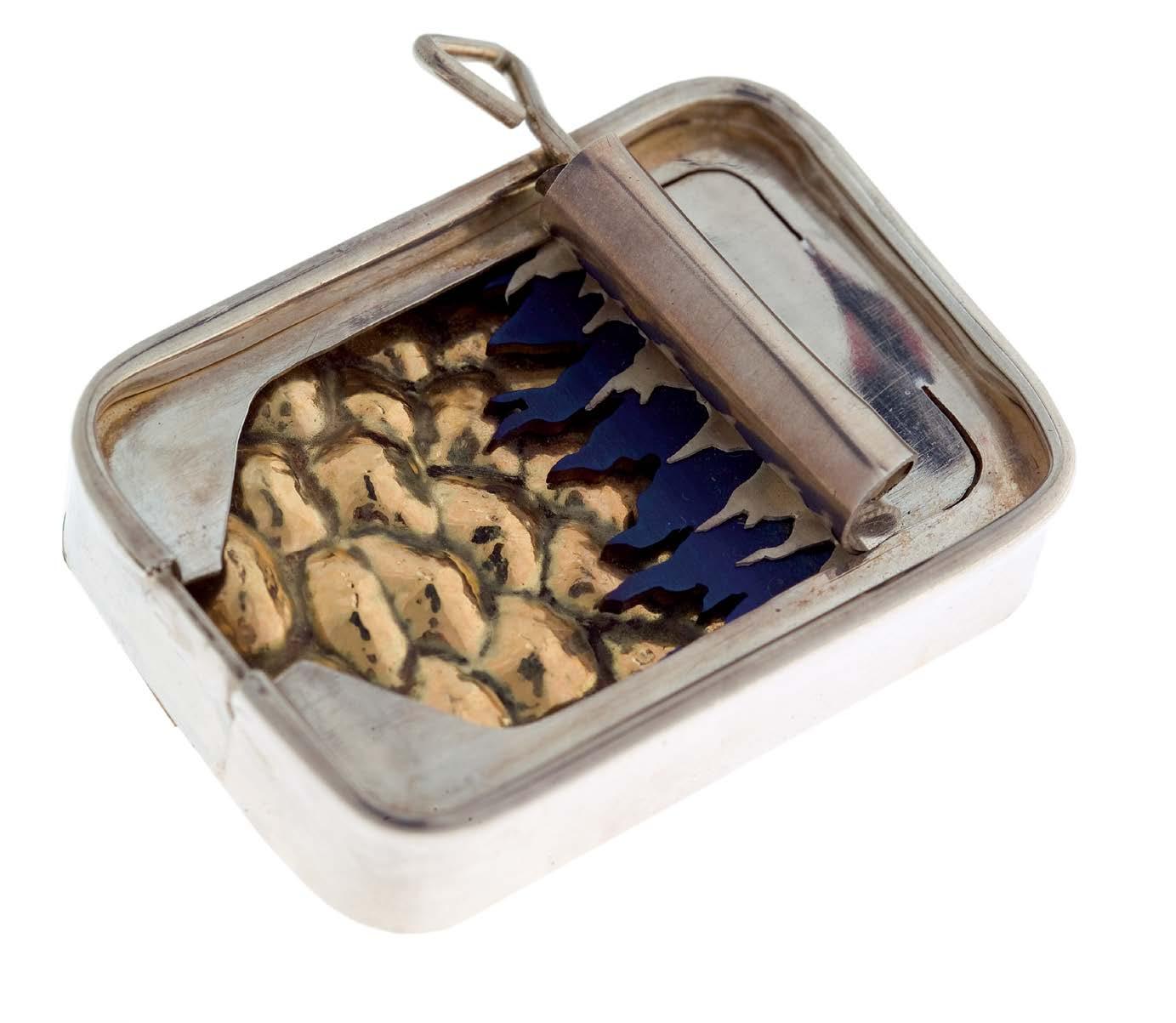
38 MELBOURNE MODERN
Opposite top Wayne Guest, Brooch, 1976, sterling silver, 9ct yellow gold, titanium, 4.0 x 3.0 x 1.0 cm, RMIT University Art Collection: W.E. McMillan Collection
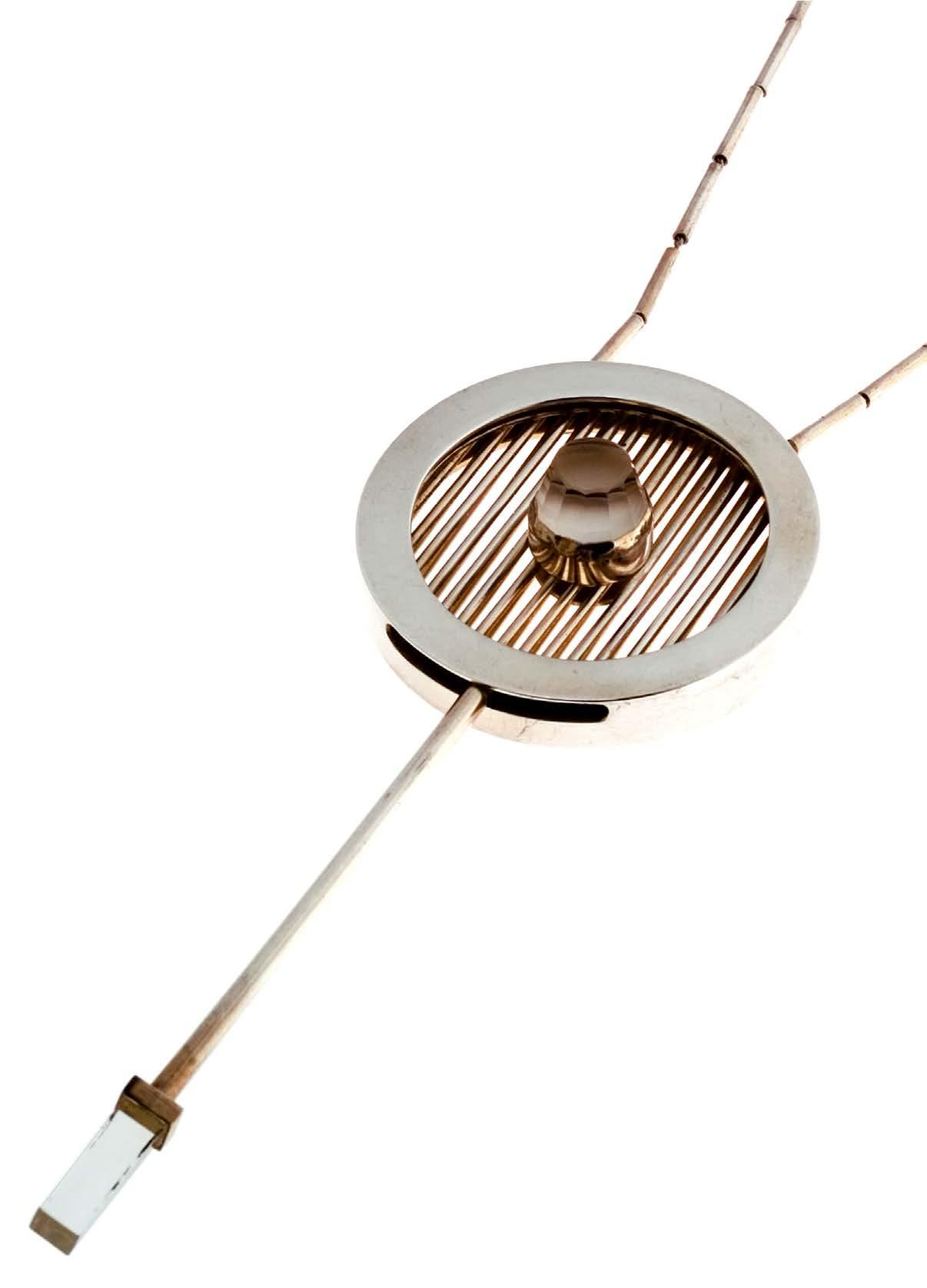
Opposite below Margaret West (known as Margaret Jasulaitis 1960–82), Sculpture, 1974, sterling silver, titanium, 8.2 x 8.2 x 3.0 cm, RMIT University Art Collection: W.E. McMillan Collection
Left John Stirling, Kinetic necklace, 1971, sterling silver, quartz crystal, 49.0 x 6.1 x 2.0 cm, RMIT University Art Collection: W.E. McMillan Collection

Right Margaret West (known as Margaret Jasulaitis 1960–82), Collier, 1975, sterling silver, titanium, stainless steel, 25.7 x 12 x 2.2 cm, RMIT University Art Collection: W.E. McMillan Collection
Page 40
Top Marian Hosking, Chocolate Bracelet, 1969, sterling silver, 2.0 x 2.0 x 1.0 each unit, collection of the artist
Below
Robert Baines, Brooch and Ring, 1970, silver, corundum, rhodium plate, brooch: 5.0 x 6.7 x 1.2 cm; ring: 3.8 x 2.6 x 1.3 cm, RMIT University Art Collection: W.E. McMillan Collection
Page 41
Robert (Bob) Keith Cranage, Water Jug, 1962, Silver plated gilding metal, 24.6 x 13.2 x 13.2 cm, RMIT University Art Collection: W.E. McMillan Collection
MELBOURNE MODERN 39
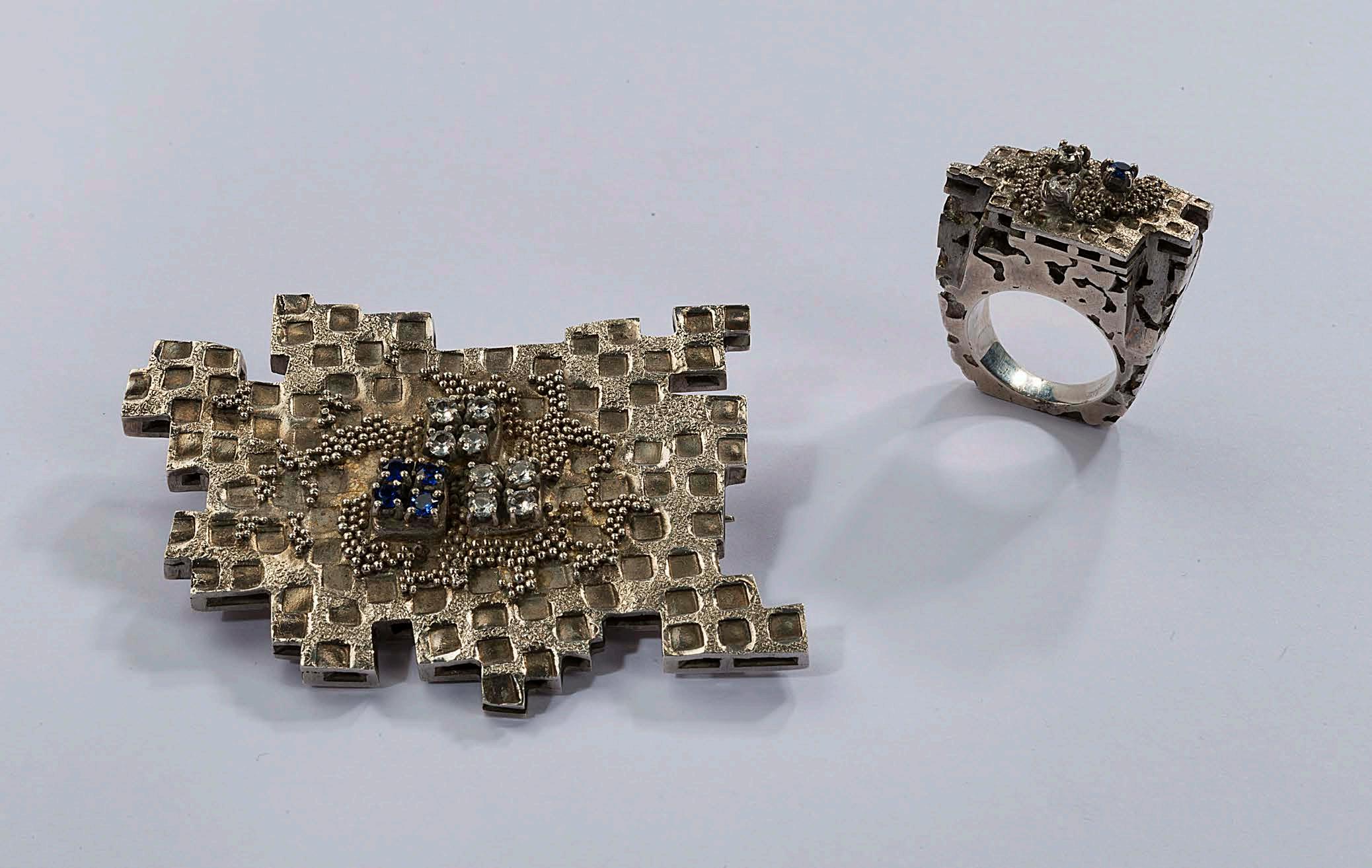
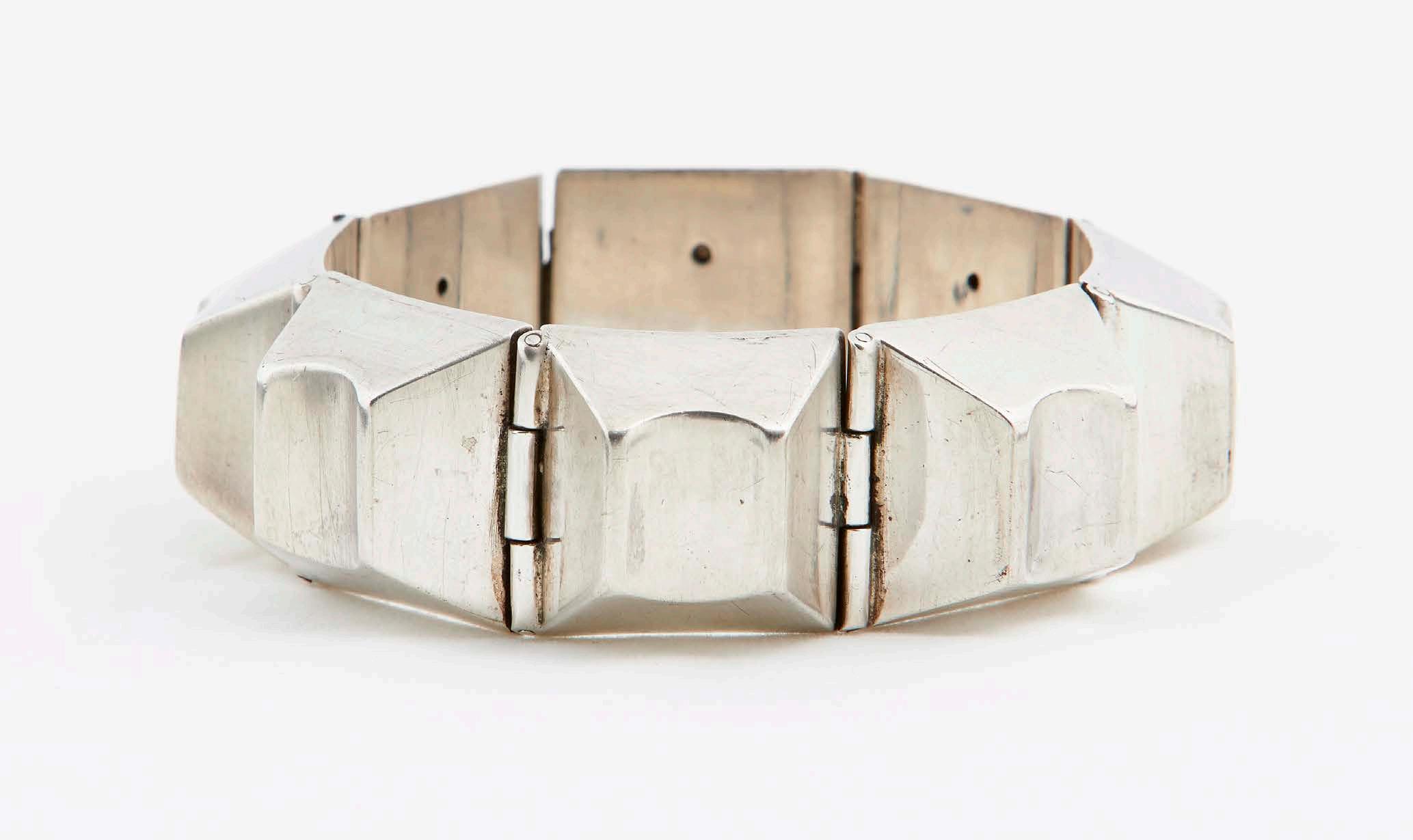
40 MELBOURNE MODERN
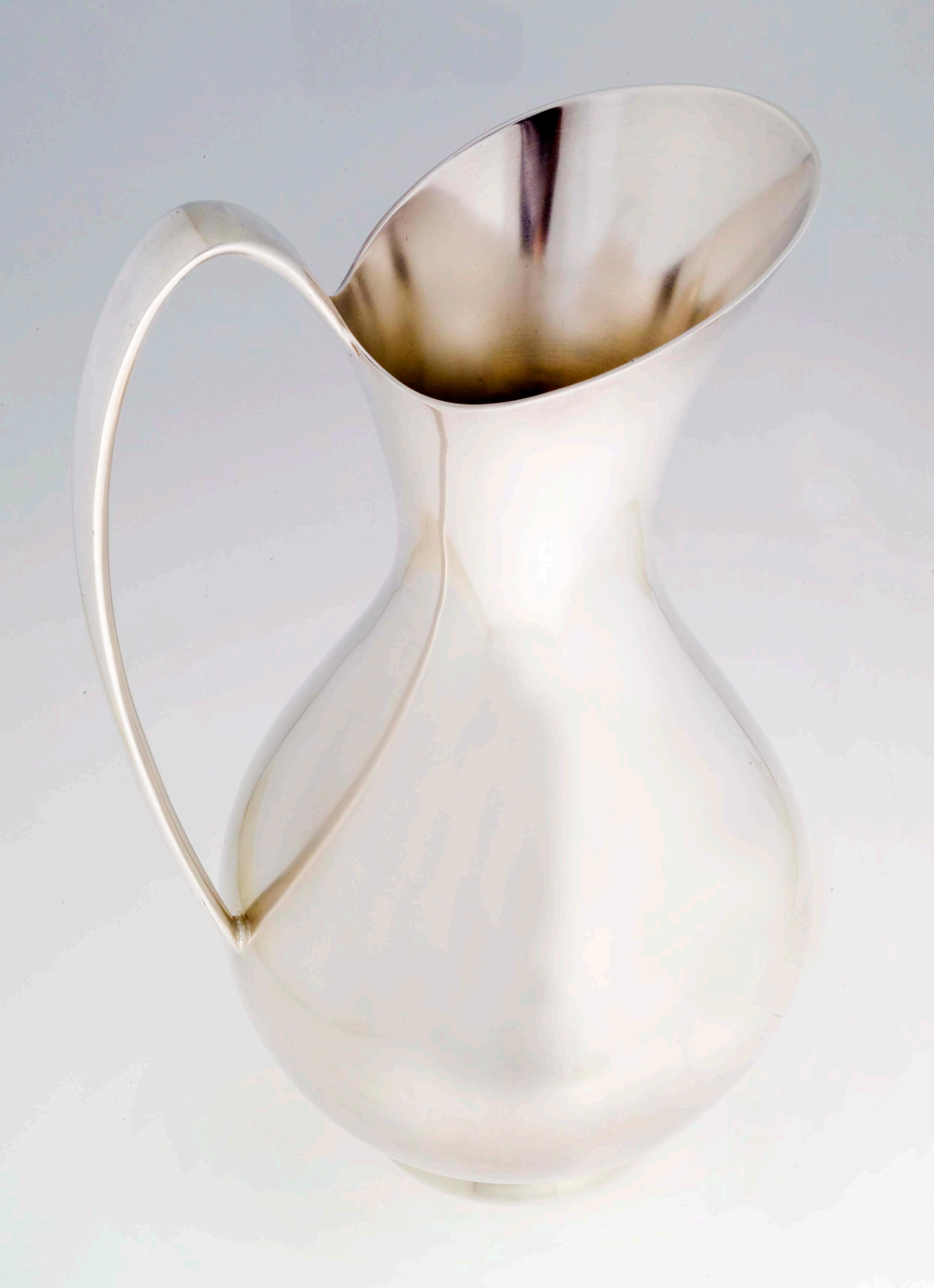

3 a skilled hand and/or cultivated mind? INDUSTRIAL DESIGN AT THE CROSSROADS HARRIET EDQUIST
Opposite Radios designed by students of RMIT industrial design (detail), unknown photographer, RMIT Design Archives: Gerard Herbst Collection
In 1947 MTC celebrated its Diamond Jubilee.
To mark the occasion, the College published Sixty Years, in which it noted the work it had done to fit students to meet the increasingly technological demands of the post-war world, deftly interweaving the College’s motto perita manus mens exculta (‘a skilled hand, a cultivated mind’) into its summary of achievements:
Technical advances have increased our mastery of our environment, minds and hands have had to be trained that our sum-total of knowledge, skill and culture might be worthily increased.1
Although it has waxed and waned over the years the ‘cultivated mind’ part of the equation has always been part of RMIT’s mission, even if the view of education as handmaiden to industry has often predominated. And one way of thinking about the Industrial Design programme after the war is as a battleground between skill and culture.
Among the celebrations to mark the Diamond Jubilee, Art and Applied Art mounted an exhibition in the Arts Building (Building 2) showcasing the work of students across its numerous art and design programmes. Reviewed favourably, the industrial design display attracted special comment:
The industrial design section is particularly notable. The students who arranged it have made an excellent job with everyday materials and transformed a bare room into an exhibit of first-class interest. This display should be an object lesson to the organisers of all exhibitions. It shows what could be done with the Exhibition Building, for instance, if it were intelligently handled.2
Lyle Fowler’s photographs of the minimalist industrial design exhibit show product development (an iron and an electric kettle) from sketch to prototype with an emphasis on design for industrial production. Industrial Design had been established at the College in 1939, the first such course in Australia, and after the disruption of the war it produced its first graduates in 1948-49; presumably this was their work.3
A year after the exhibition German-born designer Gerard Herbst was hired as a sessional teacher in the course. He was at the time art director of the large industrial concern Prestige Fabrics in Brunswick, and his specialties were in poster, textile, communication and exhibition design.
Herbst had arrived in Melbourne in 1939, sponsored by his Jewish friend Kurt Jacob, for whose family he had worked in Munich and had assisted after Kristallnacht in November 1938. His education and training prior to professional work are not clear but on his immigration papers he described himself as a ‘window dresser’ (later crossed out and changed to commercial artist) and he had worked in that field in Germany during the 1930s.4 Jacob, who had left Munich earlier to establish a branch of the family music store in Sydney, organised a position for Herbst as assistant to the advertising manager at Prestige. In 1942, like thousands of other so-called ‘enemy aliens‘ Herbst joined a labour unit for the Australian Defence Force and he did not return to Prestige until demobilisation in 1945.
In the meantime Prestige, founded as a luxury lingerie manufacturer by George Foletta in 1922, had turned to the manufacture of woven silk for parachutes and other military uses. Having invested in new weaving equipment, Foletta decided to develop this side of the business and produce fine textiles for the fashion industry. Foletta appointed Herbst art director of the new concern, a position he held until 1955. He was in charge of Prestige’s overall design, promotion and advertising, and responsible for providing a unifying vision for the company’s brand. Herbst established a design studio where young designers with different skills collaborated on projects, a practice model more commonly associated with commercial graphic design studios. By the early 1950s the staff included Viennese-born Susan Copolov (formerly Tandler) who had studied art at MTC. Herbst was particularly interested in advertising and marketing and, while he produced innovative, sparsely modernist displays himself, he also harnessed and encouraged the talents of others. From 1949 to 1951 he collaborated with cinematographer Geoffrey Thompson of Cine Service on three short, highly innovative films for Prestige, one of which, Language of Design, was shown at the International Textile Exhibition at Lille, France in 1951. He also commissioned German-born modernist photographer Wolfgang Sievers to produce promotional material for Prestige. One of Sievers’ most celebrated photographs depicts Herbst standing on a cliff overlooking the sea at Black Rock, holding aloft a
MELBOURNE MODERN 43
Below right
Prestige Fabrics Ltd. designer and MTC graduate Susanne Tandler (later Susanne Copolov), from Vienna, with miniature mannequins draped in Prestige fabrics for exhibition in Textile International display in Lille, France, 1951, photograph: Gerard Herbst, RMIT Design Archives: Prestige Fabrics, Gerard Herbst Collection
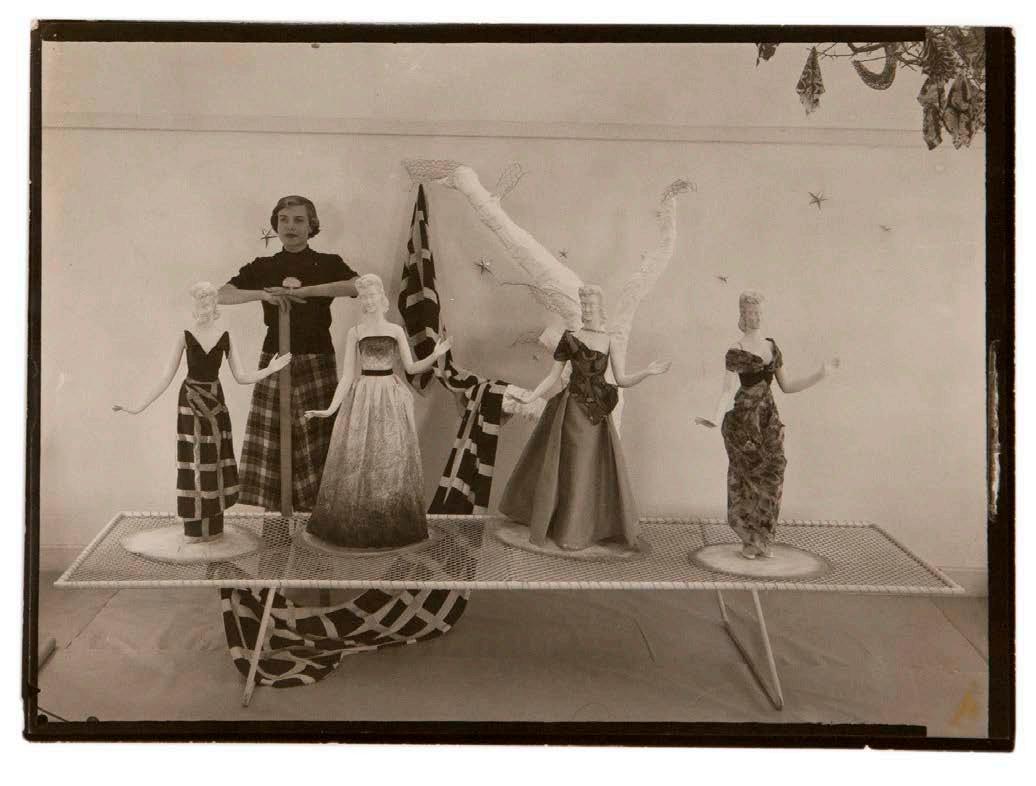
Opposite above and below Melbourne Technical College Diamond Jubilee exhibition, Arts Building (Building 2), industrial design display, including a display showing the development of an iron and an electric kettle from sketch to prototype, 1947, photographer: Lyle Fowler, Harold Paynting Collection, State Library Victoria
billowing length of Prestige fabric with a floral motif.5 It is a commanding image of victory and freedom. Herbst was not a product designer and had not been trained in product design, so his classes with the evening students at MTC from 1948 focused on two-dimensional design. For instance in 1950 he set them a project to design a poster for the 1956 Melbourne Summer Olympics (Melbourne having been announced the 1956 host city in April 1949). An article in The Argus featured the students’ ‘simple futuristic designs’, accompanied by a photograph of students Paul Warner and Harold Richardson examining the posters.6 Two of the designs featured a rippling Olympic flag –possibly echoing Herbst’s choreographed displays at Prestige Fabrics – and two featured boomerangs. Three years later The Herald illustrated one of the rippling Olympic flag poster designs of 1950, noting that its designer David Seaton was now working in London and quoting Herbst, who lamented ‘the Australian public was unaware of its capable people in the field of industrial art and design’ and that ‘Australia could ill afford to lose these people continually’.7 Herbst’s 1950 student project and his public comments of 1953 were prescient. In 1954 the Melbourne Olympic Organizing Committee commissioned poster designs from five artists. English-born Richard Beck won the commission with a poster that is one of the most celebrated and internationally acclaimed design objects produced by the Games. As John Hughson has noted, Melbourne wished to present itself as a modern, southern city in counterpoise to the northern hemisphere, and Beck’s poster fulfilled this ambition brilliantly by dispensing with the classical athletic male figure, ‘instead offering a sparse geometrical design said to depict an invitation card’.8 Yet Beck’s design of a tri-fold white invitation card against a blue background was in many respects pre-empted by Herbst’s students, whose posters were similarly non-figurative and balanced a simple central motif (be it boomerang or rippling flag) against a plain background and simple capitalised text. Whether Beck was aware of the MTC student designs is unclear (there is no record of the designs among his archive and his own employment at the College only commenced in 1956) but Herbst’s initiative and his students’ response to his design brief warrant attention.
After more than a decade of teaching part-time, Herbst was appointed full-time senior lecturer in industrial design in 1960. He filled the vacancy left by Edward Heffernan, who had moved to Geelong to take up a position as head of Art and Design at the Gordon Technical College. Heffernan was typical of most industrial design teachers at the time in that he was trained in fine art rather than applied art (Heffernan was a graduate of the National Gallery School, had studied with George Bell, and had been teaching at MTC since 1946). Herbst, on the other hand, was experienced in working in industry through his employment at Prestige and his appointment presaged the professionalisation of industrial design teaching at RMIT.
Throughout Herbst’s term as a full-time teacher at RMIT, the certainties of the post-war modernist project were unravelling, and visions of an infinitely perfectible, technologically crafted world had come under stress. In addition, the 1960 Coldstream Report advocated for a broader pedagogy in art and design schools than one simply focused on preparing students for industry.Now skills were not enough: students had to learn to think conceptually and broadly. This tension between skill and mind, which in RMIT’s motto are conjoined, seems to have formed a core of Herbst’s thinking even at Prestige. While he appointed staff for their skill he also pushed them into a much deeper engagement with the context and genesis of their work.
In 2000 Herbst published Formgestaltung at RMIT Australia circa 1960: Recollections of a design pedagogy, a manifesto of sorts comprising excerpts from School prospectuses, Herbst’s essays and thoughts, photographs, examples of student work, exhibitions, curricula and design competitions.9 Its range and eclecticism evinces strongly his ethos of design teaching. He was not a trained teacher
44 MELBOURNE MODERN
INDUSTRIAL DESIGN
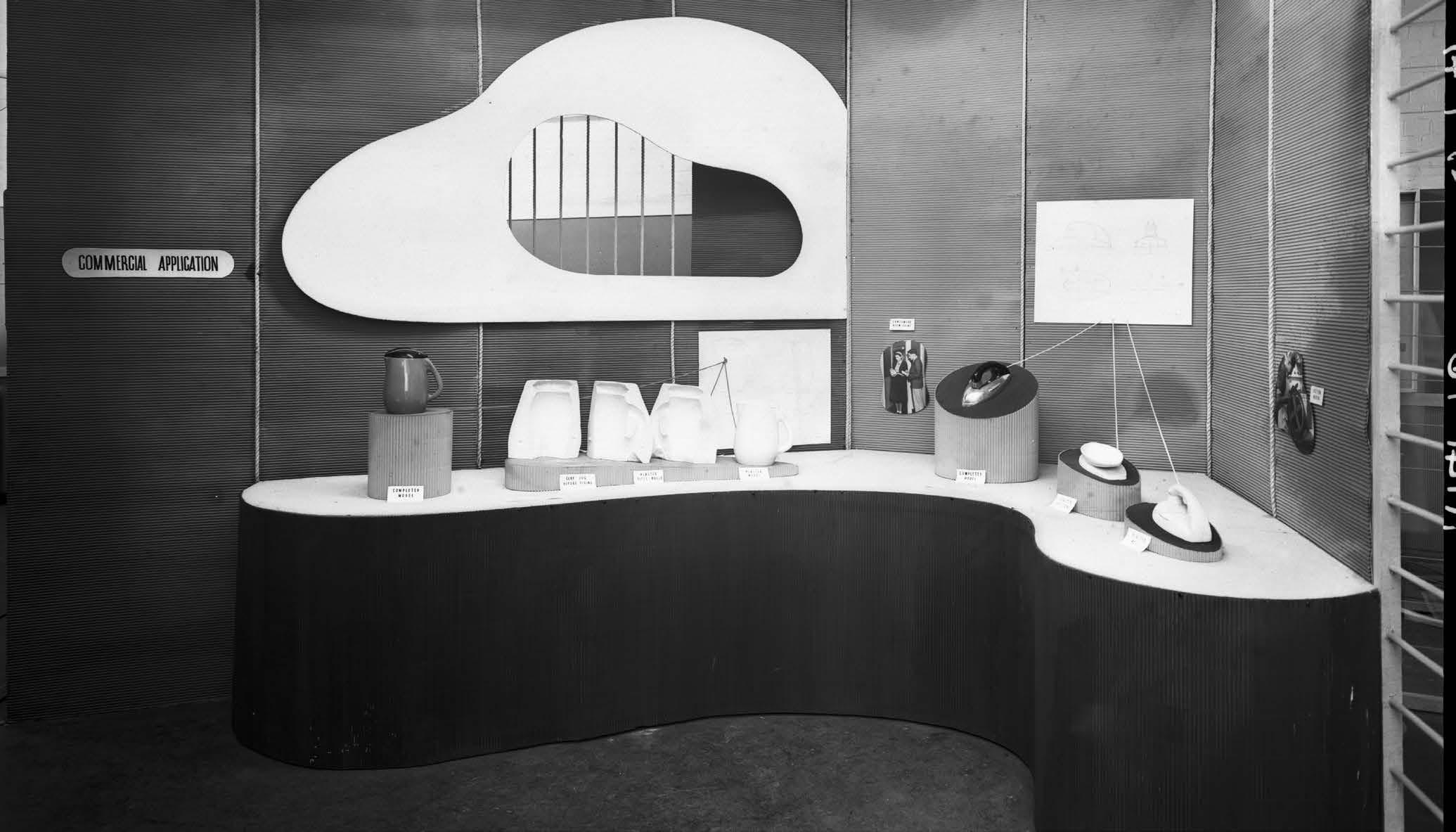
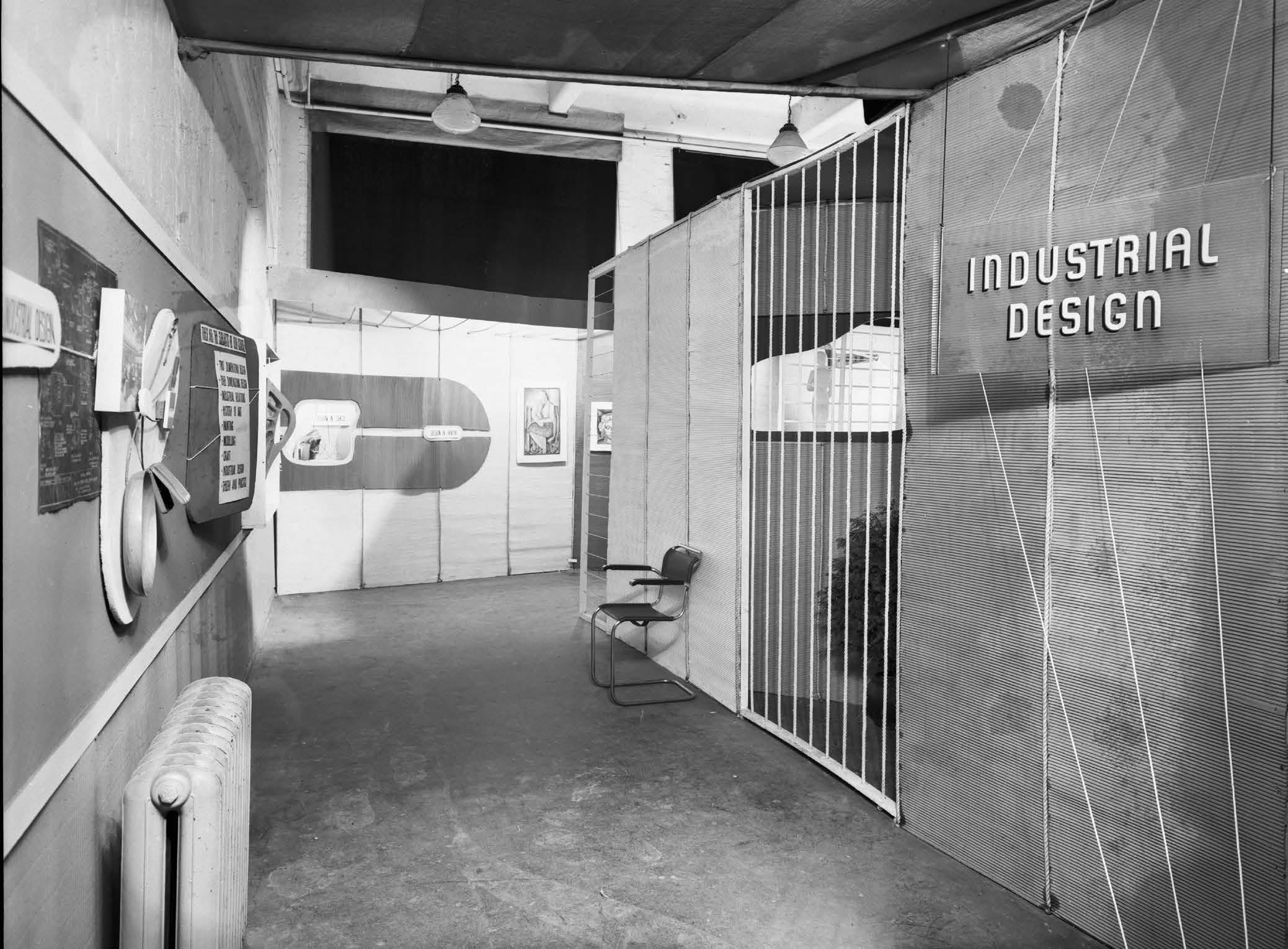
MELBOURNE MODERN 45
Left Gerard Herbst (centre, arm raised) with MTC industrial design students Paul Warner, Harold Richardson and David Seaton studying their designs for Melbourne Olympic Games posters, 1950, photograph: The Argus, 1950 RMIT Design Archives: Gerard Herbst Collection.
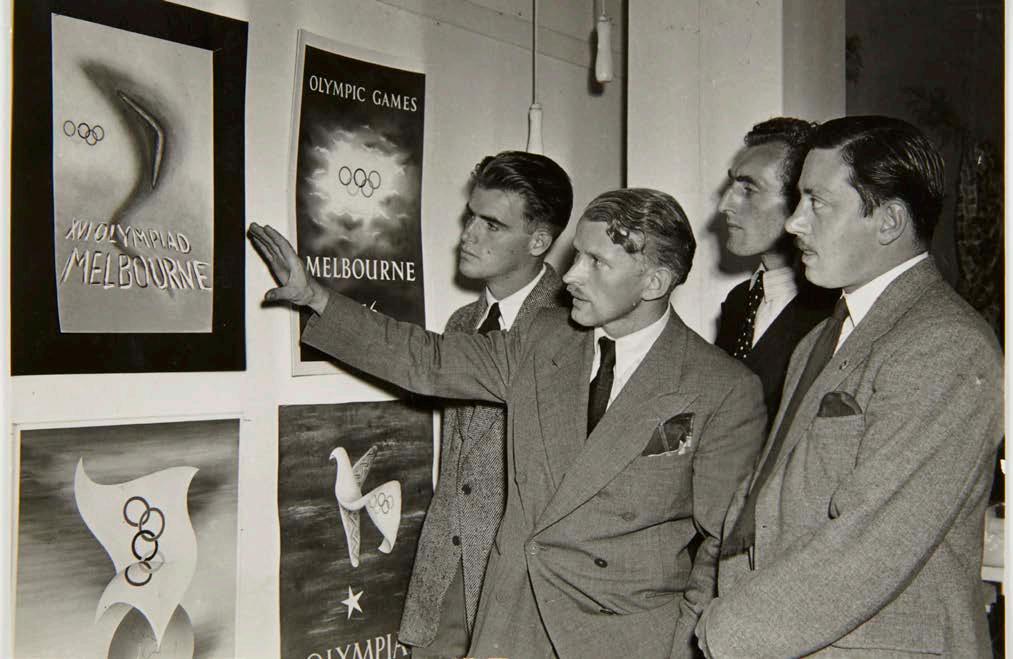
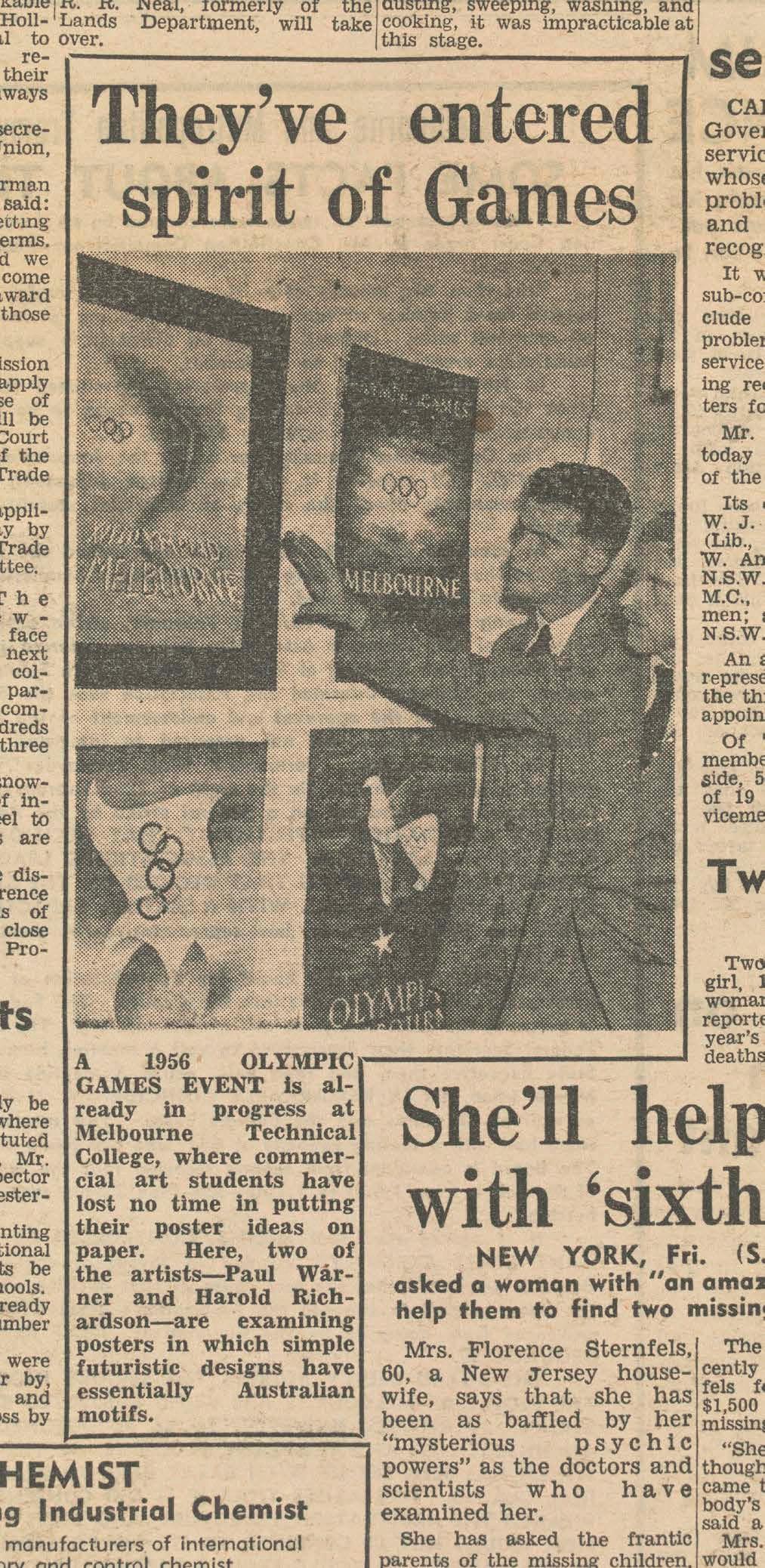
Below ‘They’ve entered the spirit of Games’, The Argus, Melbourne, 18 March 1950. Detail of above.
Opposite Richard Beck, Olympic Games Melbourne, 22 Nov – 8 Dec 1956, 1956, colour lithograph, photo-lithograph, image: 95.2 x 60.0 cm, sheet: 106.0 x 65.2 cm, National Gallery of Victoria.
and his approach was personal. Some ideas were based on Bauhaus models which came to him through publications; others came from his wide reading in sociology, urbanism and design, and from institutions such as the Ulm School of Design in Germany. His 1968 article ‘Redeeming the Machine’ suggests he was familiar with Ulm’s work in ergonomics. He encouraged his students to think critically of the world around them. He was as critical of industry and its impact on the environment as he was concerned that his students engage with it as designers. Lewis Mumford was one of his favourite writers – those he called ‘mentors’ – and his students found themselves rather to their surprise working their way through The City in History and other key Mumford texts. Bruce Hall, who entered his final year in 1960 and had been taught by post-war staff like Heffernan, recalls that: [Herbst’s] approach was quite different, he encouraged projects of a social nature, eg. alternatives to galvanized dust bins, moulded power plugs with handles... His approach did bring criticism from Ron Rosenfeld IDIA. Gerard was a bit erratic, jumping from one idea to another [but] he did influence me… I tried to think outside the box.10
Herbst’s belief in design’s social agenda was the focus of the first of three public exhibitions that he and his students curated in Melbourne that showcased their skill and their thinking. Face to Face at the National Gallery of Victoria (NGV) in September 1964 was designed to direct attention: ... to some of the dangerous practices that threaten our society. It is based on opinions expressed by the world’s most eminent thinkers, and on aesthetic evaluations made by Australian educationalists. Its aim is to challenge all responsible citizens to make a re-appraisal of existing senses of values.11 Here we can see the echoes of Mumford. This theme continued the following year, when Herbst collaborated with RMIT’s Technology Theatre Department to produce a black and white film, Negatives Positives, which aroused considerable interest when first shown at the Victor Greenhalgh tribute exhibition, ‘Decade’, in July 1965.12 Negatives Positives encapsulates Herbst’s views on life and education. It juxtaposes, as its title suggests, two opposing
46 MELBOURNE MODERN
INDUSTRIAL DESIGN
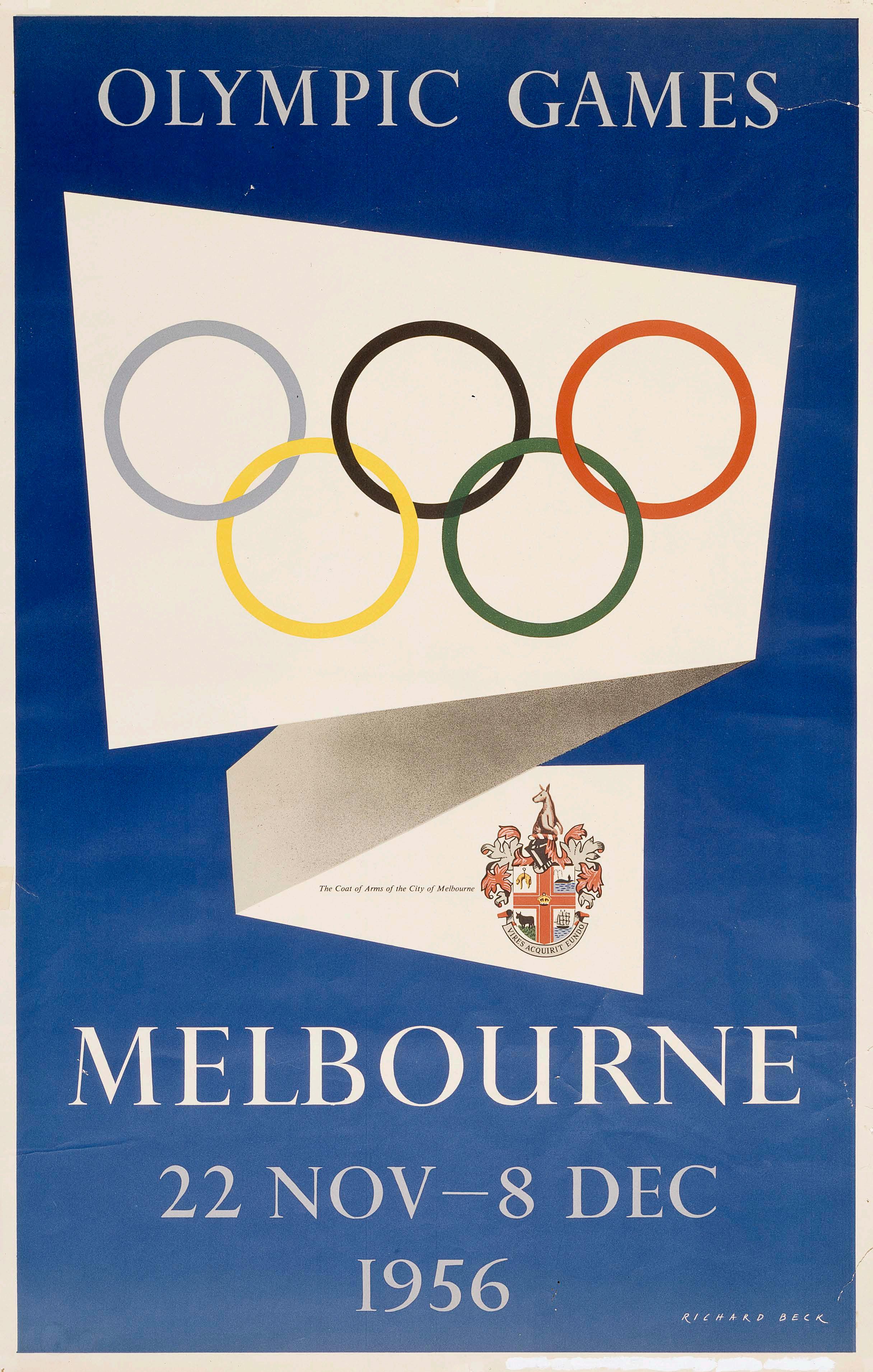
MELBOURNE MODERN 47
Above Face to Face exhibition at the National Gallery of Victoria, in the Verdon Gallery (now State Library of Victoria), organised by Gerard Herbst and RMIT industrial design students, September 1964, photograph: Wolfgang Sievers, State Library Victoria: Wolfgang Sievers Collection
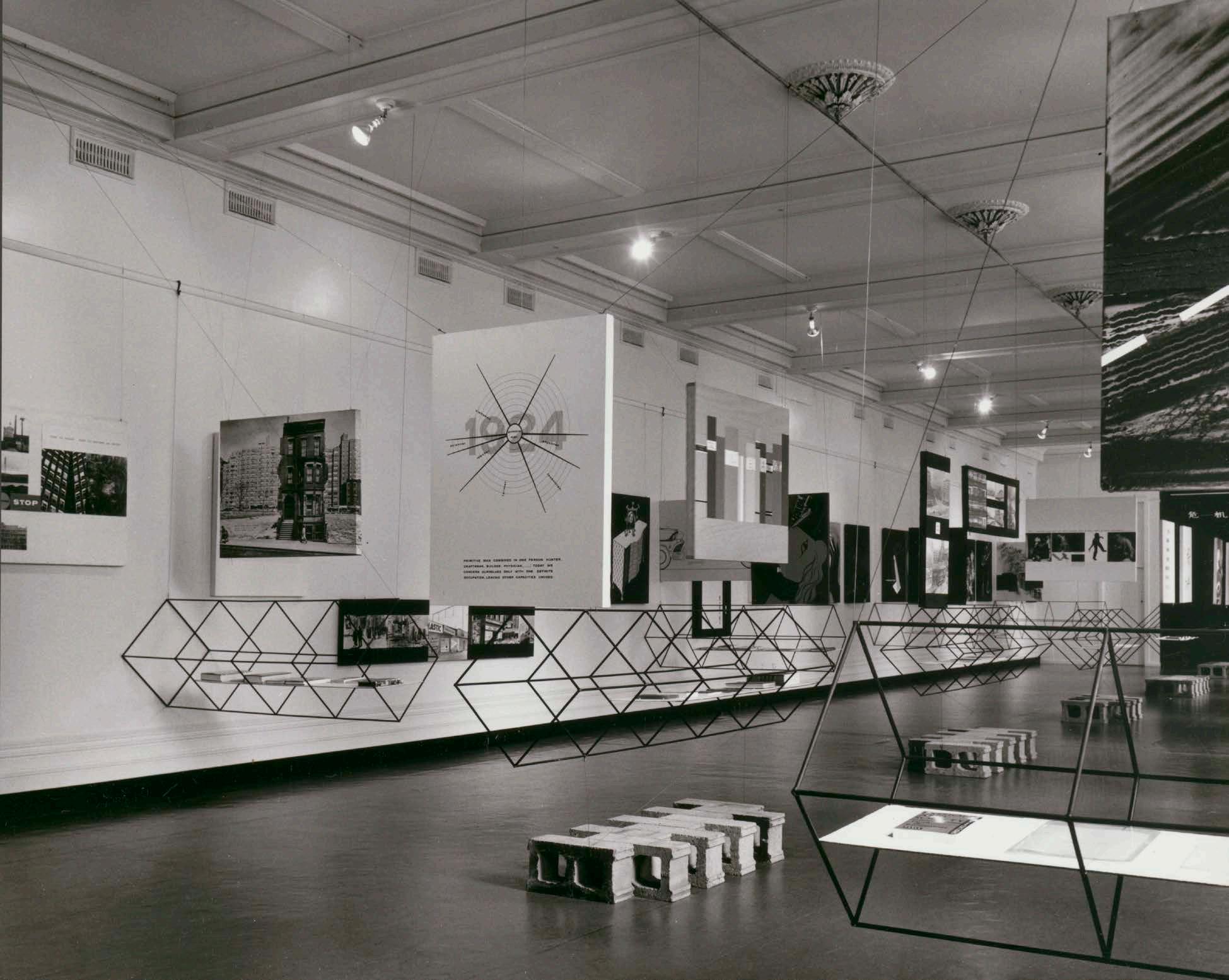
Left
Gerard Herbst, Face to Face exhibition poster, 1964, offset lithograph, 75.3 x 57.0 cm, University of Melbourne Art Collection: Gerard Herbst Poster Collection
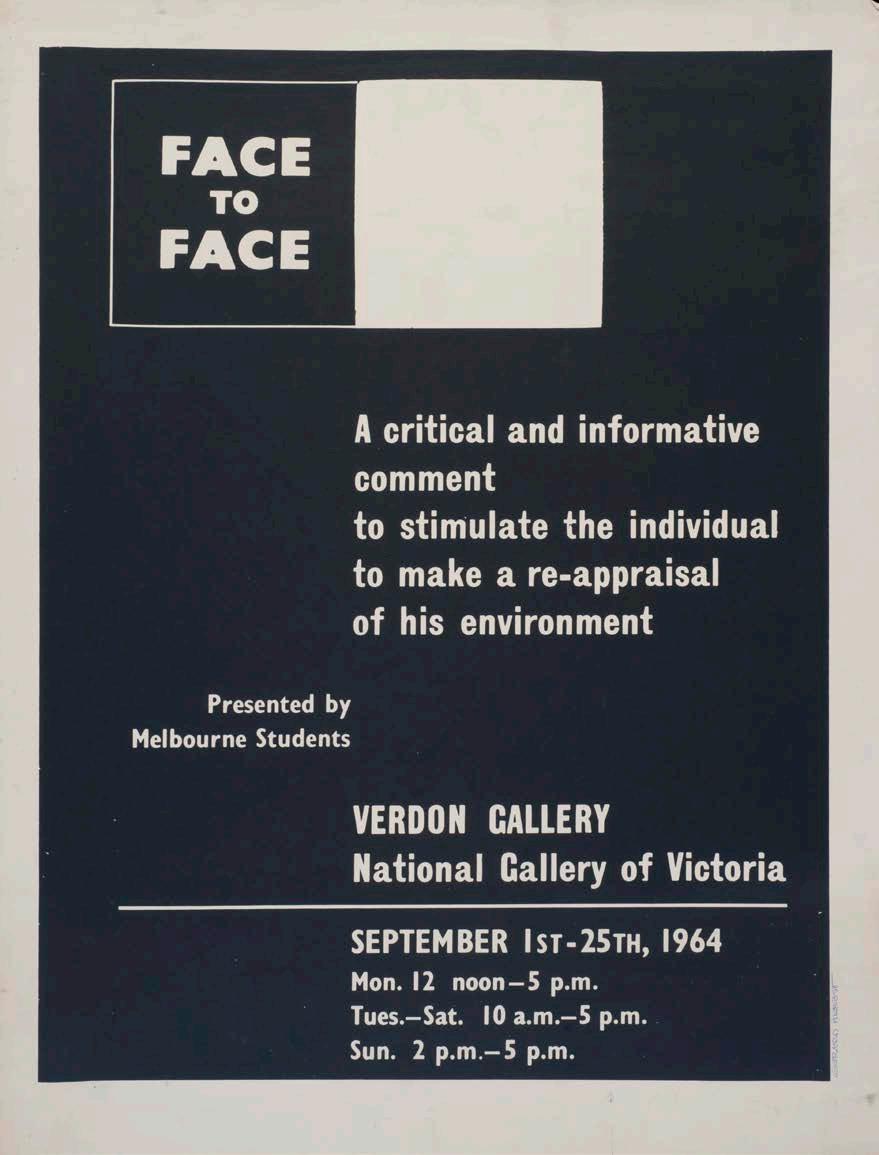
Opposite top Gerard Herbst, Design with Paper exhibition poster, 1969, offset lithograph 98.6 x 73.2 cm, RMIT Design Archives: Gerard Herbst Collection. Design with Paper was presented by RMIT’s Industrial Design Department at National Gallery of Victoria, November 1969 – January 1970
Opposite below ‘Designs Performing’, Design with Paper publicity photograph of RMIT industrial design students with paper exhibits, 1969, photograph: Gerard Herbst, RMIT Design Archives: Gerard Herbst Collection
48 MELBOURNE MODERN
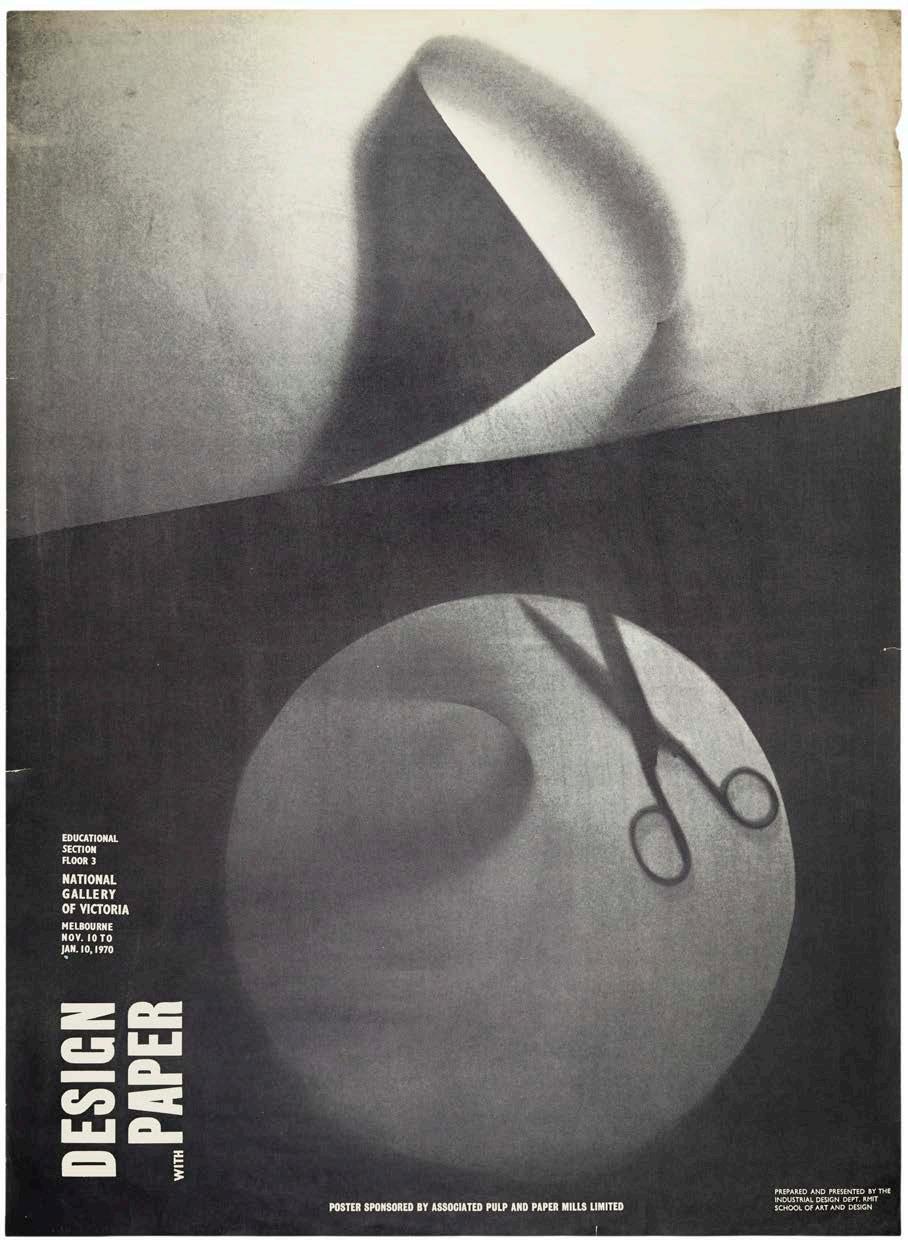

MELBOURNE MODERN 49
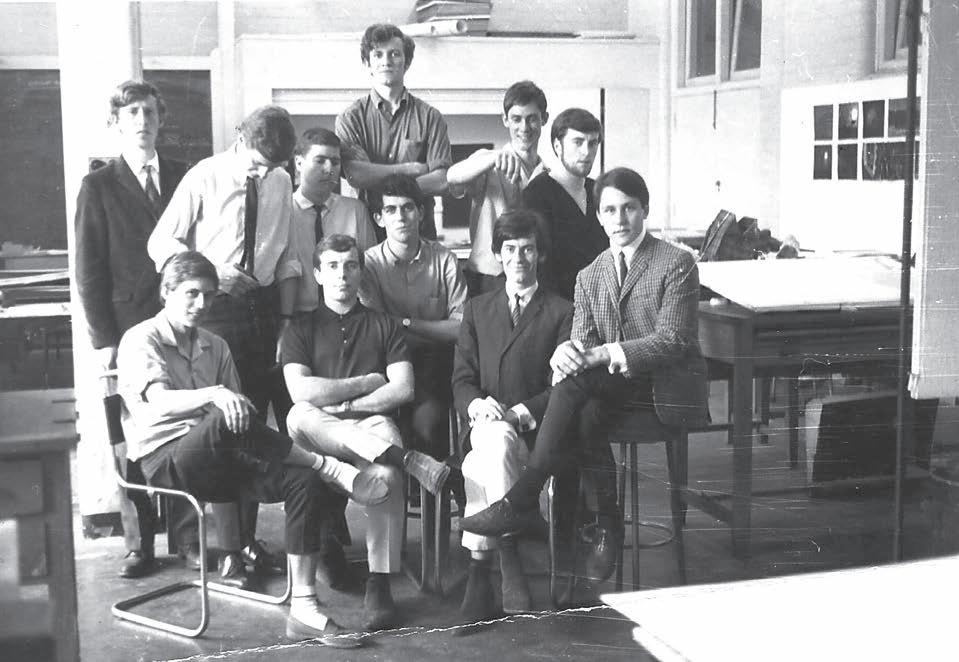
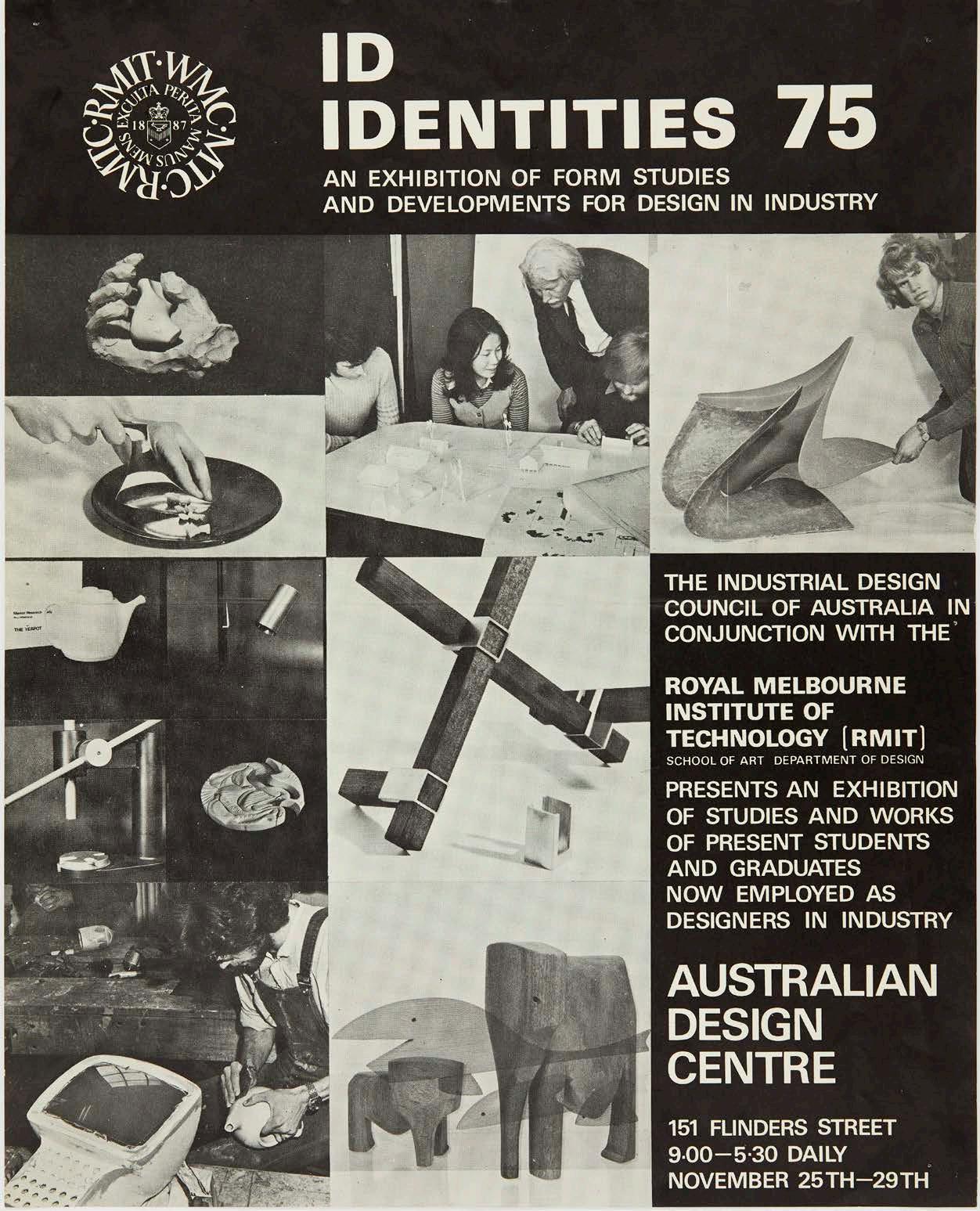
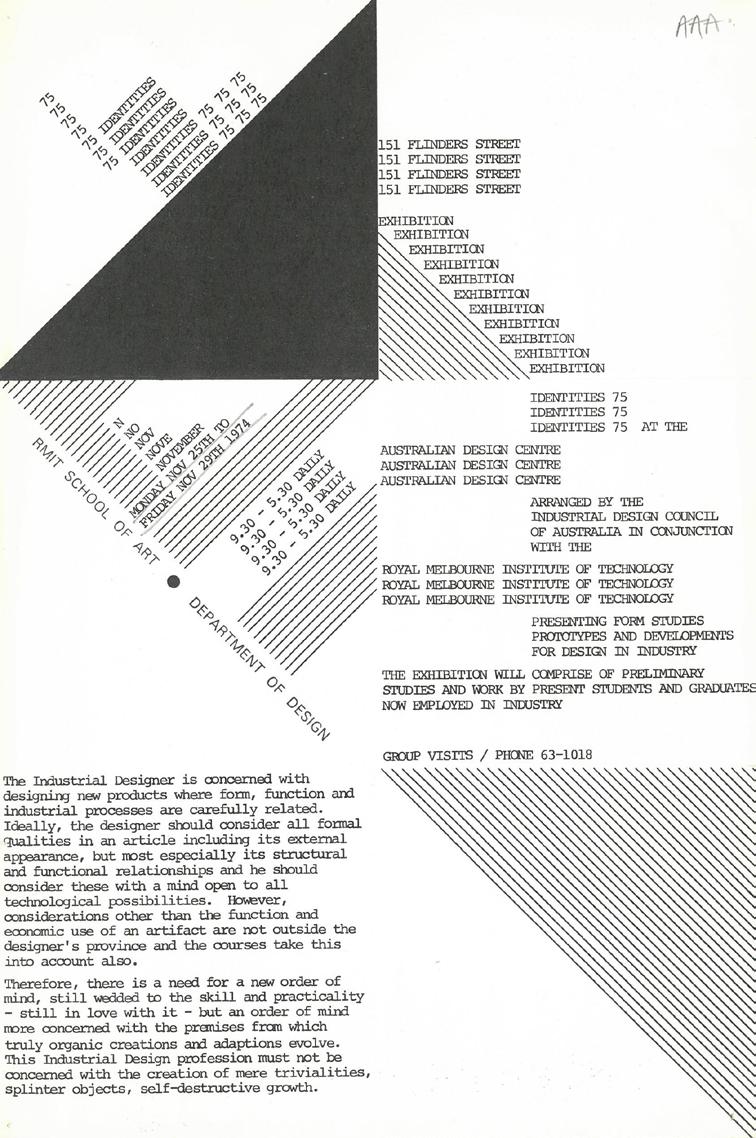
50 MELBOURNE MODERN
Opposite above left Gerard Herbst, ID Identities 75: An Exhibition of Form Studies and Developments for Design in Industry, exhibition poster, 1975, offset lithograph, 39.9 x 32.0 cm, RMIT Design Archives: Gerard Herbst Collection
Opposite above right Gerard Herbst, ID Identities 75 press release from RMIT School of Art, Department of Design, 1975, single sheet with typeface, 33.0 x 20.0 cm, State Library Victoria Opposite below Industrial design class at RMIT, 1964. Back Row: Andrew Moran, Geoff Putnam, Derek Clark, Andrew Dixon, William Kemp, John Buckley. Front Row: unknown, Robert Gilbert, Lotars Ginters, Paul Dillon, George Nikas. Photograph attributed to Lionel Suttie, collection of Ian Wong

Above Gerard Herbst, ‘Redeeming the Machine’, Journal of the Australian Commercial and Industrial Artists’ Association, January 1968, RMIT Design Archives: Gerard Herbst Collection
Below
A. (Athol) Watson, ‘Ideals and Objectives’ (letter to the editor), Catalyst: Student Newspaper of RMIT, vol. 22, no. 8, 18 July 1966, p. 2, RMIT Design Archives: Gerard Herbst Collection

MELBOURNE MODERN 51
views of the world. It opens with a cinematically experimental view of the city as dystopia where human beings are reduced to urban infrastructure and design is used only to manipulate collective behaviour in the service of predatory investments. This negative view is followed by the positive, which argues through a series of vignettes of artists and designers at work in the studios in RMIT Building 2 that the corrective to despair lies in creativity, in the hand at the service of imagination. The final scene is set in a bookshop where the narrator quotes epigrammatic lines from Rilke, Plato, Ruskin, Gropius, Mumford, Eliot, Einstein and Kafka while their names scroll over the screen. Herbst could hardly be clearer about the relationship between the skilled hand and the cultivated mind.
Herbst’s ethos evidently carried over to some of his fellow staff and students. A letter to the editor of the student magazine, Catalyst, in July 1966, signed ‘A. Watson, Industrial Design Department’ (probably student Athol Watson), reprints a portion of Lewis Mumford’s open letter to President Lyndon Johnson in which Lewis denounced US actions in Vietnam and urged the President ‘strive for a human solution’.13 The letter not only cites Herbst’s ‘mentor’ Mumford but also reflects his belief that artists and designers must engage with the affairs of society and politics to effect change for the broader good. It is also an early register of protest against the Vietnam War, coinciding with Udo Sellbach’s similarly early statements made through his Target is Man series of etchings, which were likewise first exhibited in 1966 (see chapter 8 in this volume).
The second exhibition that he and his students mounted, Design with Paper, at the Australian Design Centre at the NGV over Christmas 1969–70, was based on formal exercises that demonstrated ‘structural uses of paper and cardboard as an aid in the thought process of DESIGN’. Here was the legacy of Josef Albers’ paper studies at the Bauhaus.14 The connection was not lost on Bulletin art critic Brian Hoad who noted:
A senseless if at times intriguing collection of paper cutouts is hardly an expected spearhead for a revolution which is being spawned at RMIT, at Saarbrucken, at Darmstadt and at the Illinois Institute of Technology...
you are told they [the students] are seeking to discover and evaluate their individual means of expression. You are told that in the tradition of Gropius and his Bauhaus experiments of the ‘twenties they are attempting to bridge the gulf between the fine arts and the technical crafts to produce one day from among their numbers a new type of creative thinker.15 Herbst also encouraged material studies of a kind associated with the Bauhaus first year course. His students made small timber, cardboard, plastic and metal models that experimented with materials and two and three dimensional form, and they designed and made three-dimensional children’s puzzles in the established pedagogical mode of the Bauhaus.
The third exhibition, ID Identities 75, shown at the Australian Design Centre just before Herbst retired from RMIT was not only a showcase of his students’ achievements but also the achievement of Herbst and his staff who had taught them. While Herbst’s students might not have understood the sources of his pedagogy or his underlying skepticism about the modernist future, they realised he was trying to get them to think laterally, to develop ‘cultivated minds’ as well as ‘skilled hands’. And a number went on to highly successful careers as industrial designers, including Phillip Zmood, Robert Pataki and Bruce Hall. Herbst’s contribution to industrial design at RMIT was significant. Through his unorthodox but charismatic teaching he developed the design studio as a site of speculation where students could move beyond an instrumentalised conception of design for industry to one based on a broader view of design’s role in society and the environment. He was in tune with the times. The 1960s and 70s radicalised students across Australian tertiary campuses and Herbst gave his students some useful tools with which they too could become agents of change.
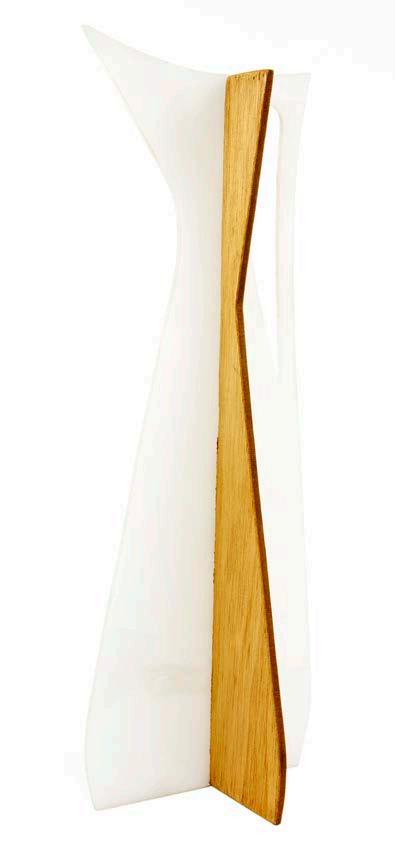

52 MELBOURNE MODERN
INDUSTRIAL DESIGN
Opposite top left Unknown student from RMIT industrial design, paper cut and folded into triangular bridge form, c. 1969, paper, 6.0 x 20.0 x 7.0 cm, RMIT Design Archives: Gerard Herbst Collection
Opposite top right Unknown student from RMIT industrial design, A structural principle of slotting to enable progressions at liberty (slotted jug forms), c.1960s-70s, wood, plastic, 40.2 x 14.1 x 13.9 cm, RMIT Design Archives: Gerard Herbst Collection
1 Sixty Years, Diamond Jubilee. Melbourne Technical College 1887–1947, Melbourne: MTC, 1947, introduction.
2 ‘Students excel in Jubilee’, The Herald, 16 September 1947, 8. Equally favourable reviews of the exhibition include ‘Atomic Flashes in Jubilee Display’, The Herald, 15 September 1947, 7; ‘Technical School Art Show’, The Age, 17 September 1947, 20; and ‘College celebrates diamond jubilee’, The Argus, 17 September 1947, 11.
3 The early history of RMIT Industrial Design has been examined by Michael Bogle who noted the influence of the 1932 Gorrell Report and interwar English debates about the role of design in mass-production; Michael Bogle, ‘Establishing the 1939 Industrial Design programme at Melbourne Technical College’, URL: https://www.academia.edu/35956326/Establishing_the_1939_ Industrial_Design_programme_at_Melbourne_Technical_College (accessed 4 April 2019).
4 Gerard Herbst, arrived Port Melbourne per Romolo 17 April 1939, Alien Registration Application Form, 21 September 1939, Melbourne: National Archives of Australia, series B78, 1948/ Herbst G. Herbst discusses his education and training in Gerard Herbst, Prestige Fabrics Design Studio 1945–1955, Melbourne: RMIT University, 1995, but it is not clear which institution he attended as none he nominates exists.
5 The photograph was later used as the front cover image for The Europeans: Émigré Artists in Australia 1930–1960, Canberra: National Gallery of Australia, 1997.
6 ‘They’ve entered the spirit of Games’, The Argus, Melbourne, 18 March 1950, 8.
7 ‘Years too soon’, The Herald, Melbourne, 25 February 1953, 11.
8 John Hughson, ‘An Invitation to ‘Modern’ Melbourne; The Historical Significance of Richard Beck’s Olympic Poster Design’, Journal of Design History, vol. 25, no. 3, 2012, 268..
9 Gerard Herbst, Formgestaltung at RMIT Australia circa 1960: Recollections of a design pedagogy, Melbourne: RMIT Faculty of Design and the Constructed Environment, 2000.
10 Bruce Hall, email correspondence to Ann Carew, 7 April 2019.
11 Herbst, Formgestaltung at RMIT Australia circa 1960, 29.
12 H.D., ‘Positives – Negatives’, ASEA (Australian Society for Education Through Art) Bulletin, vol. 1, no. 3, October 1965, 9-10.
13 A. Watson, ‘Ideals and objectives’ (letter to the editor), Catalyst: Student Newspaper of the RMIT, vol. 22, no. 8, 18 July 1966, 2.
14 Herbert Bayer, Walter Gropius, Ise Gropius, Bauhaus 1919–1928, London: Secker & Warburg, 1979, 114ff. This book was first published in 1938.
15 Brian Hoad, ‘The paper revolution’, The Bulletin, 10 January 1970, 36-7.
MELBOURNE MODERN 53 ENDNOTES
Top and bottom
Phillip Zmood, pages from an album presented for the Diploma of Industrial Design, 1964, gouache, pen, ink, pencil, paper, 38.5 x 51.0 cm, RMIT Design Archives: Phillip Zmood collection
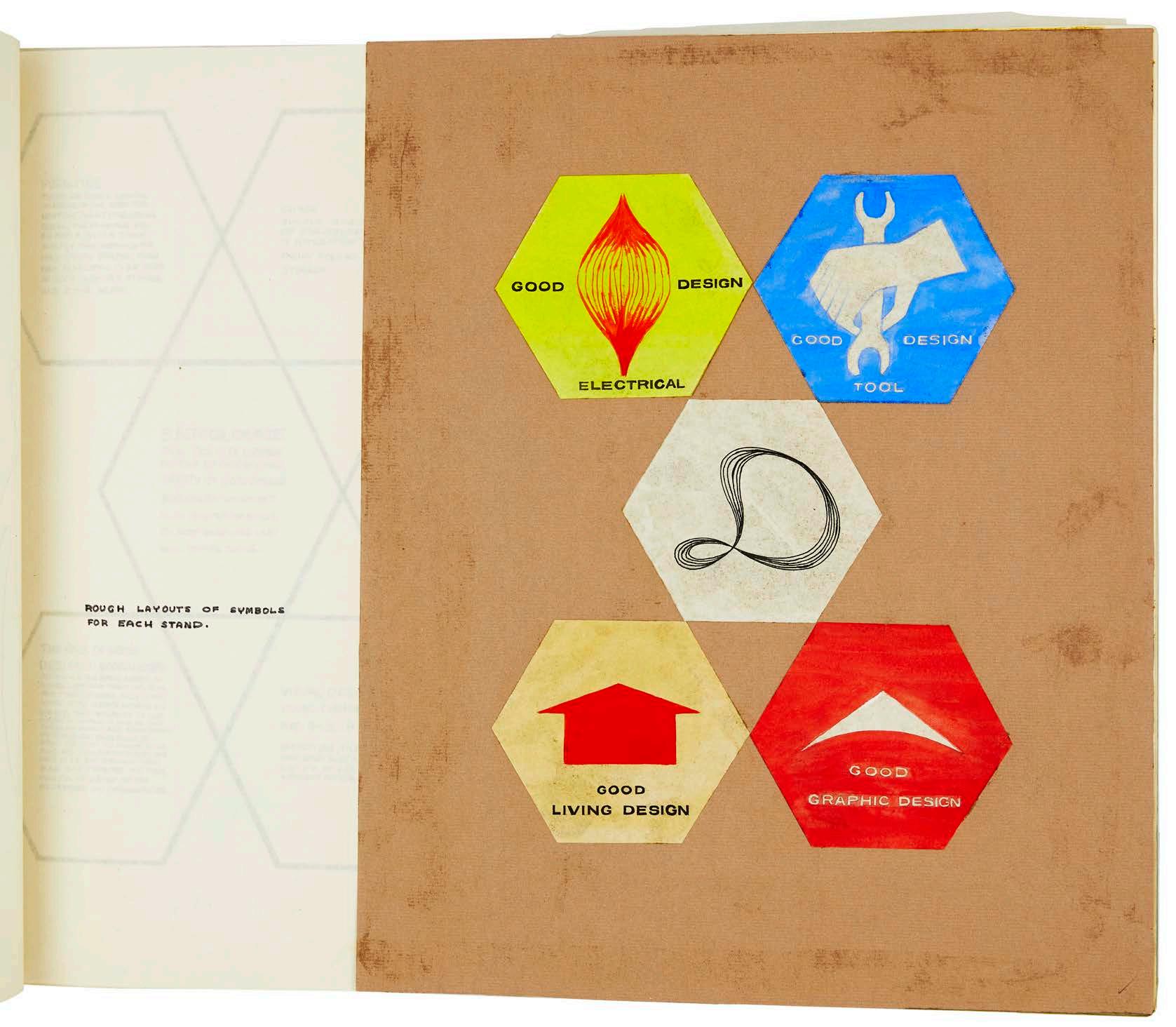
Opposite top Phillip Zmood, Holden
HK Sports Wheel Trim, c. 1968–71, metal, 39.0 x 39.0 x 8.0 cm, collection of Ian Wong. The HK Sports Wheel trim was used on the HK, HT and HG models from 1968 to 1971
Opposite below Phillip Zmood, Presentation drawing of Gannet 1000 for British Carriage and Automobile Manufacturers
Automobile Body Design Competition (technical drawing), 1962–63, ink, pencil, paper, 67.8 x 98.2 cm, RMIT Design Archives: Phillip Zmood collection
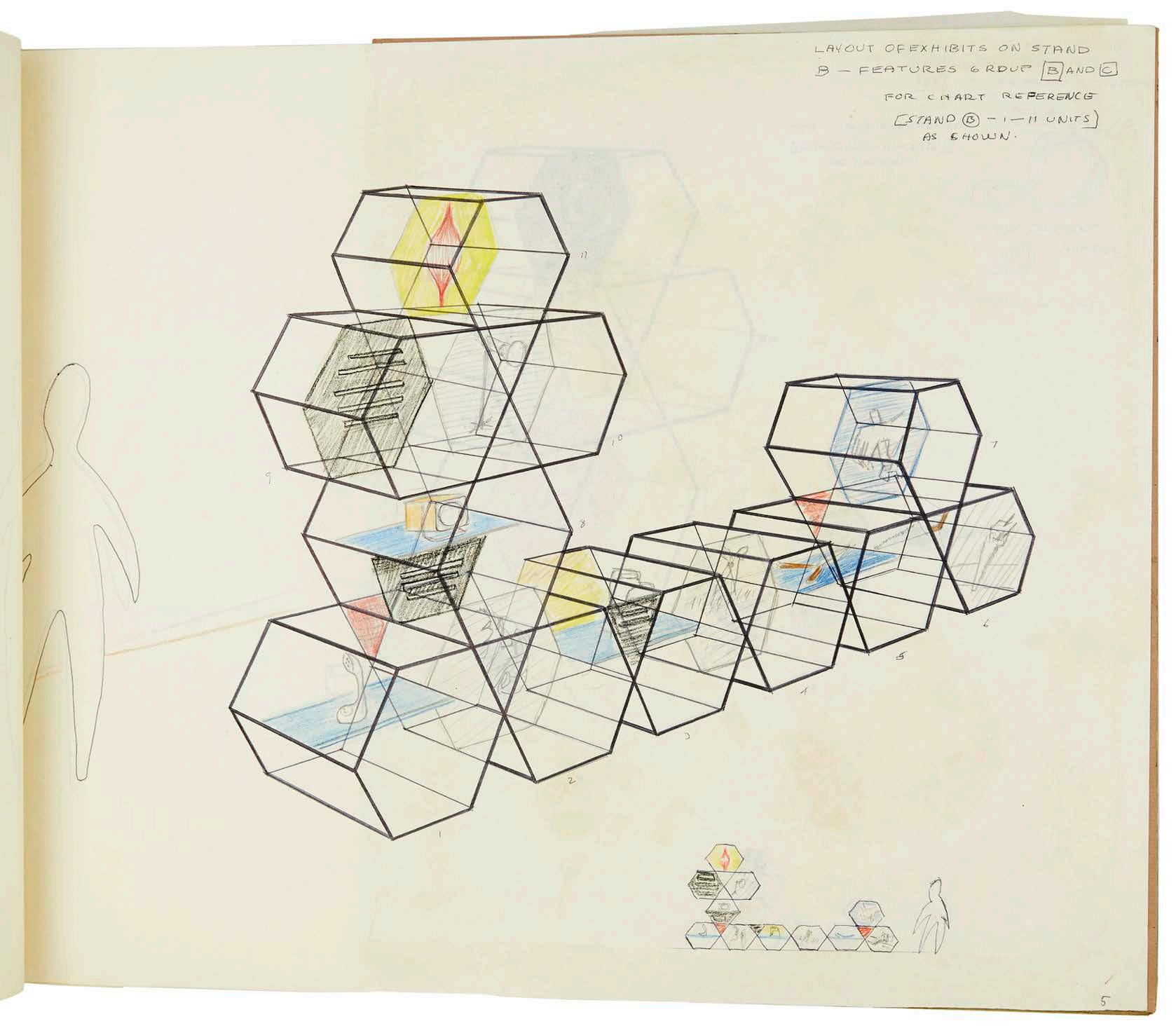
54 MELBOURNE MODERN
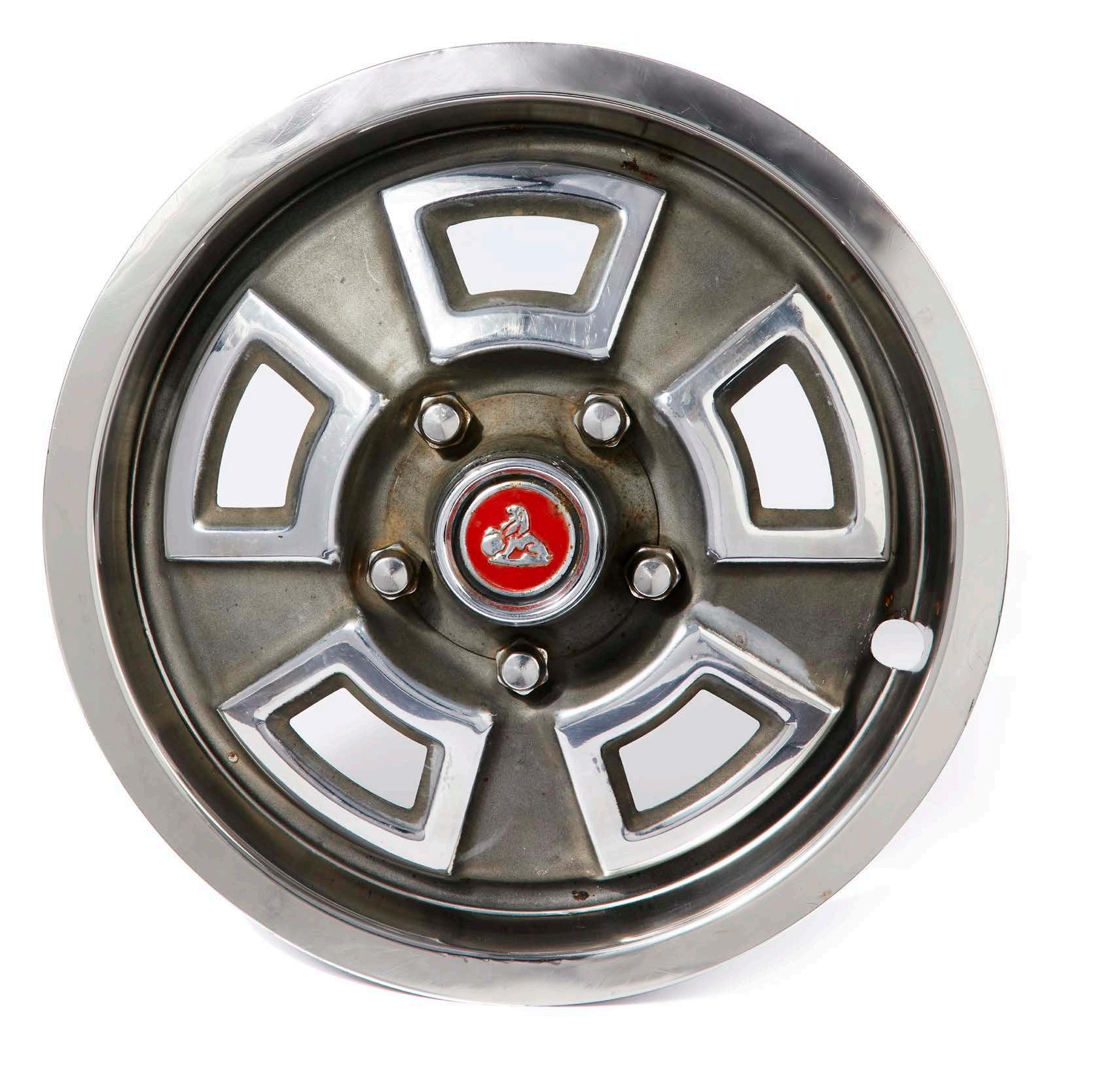
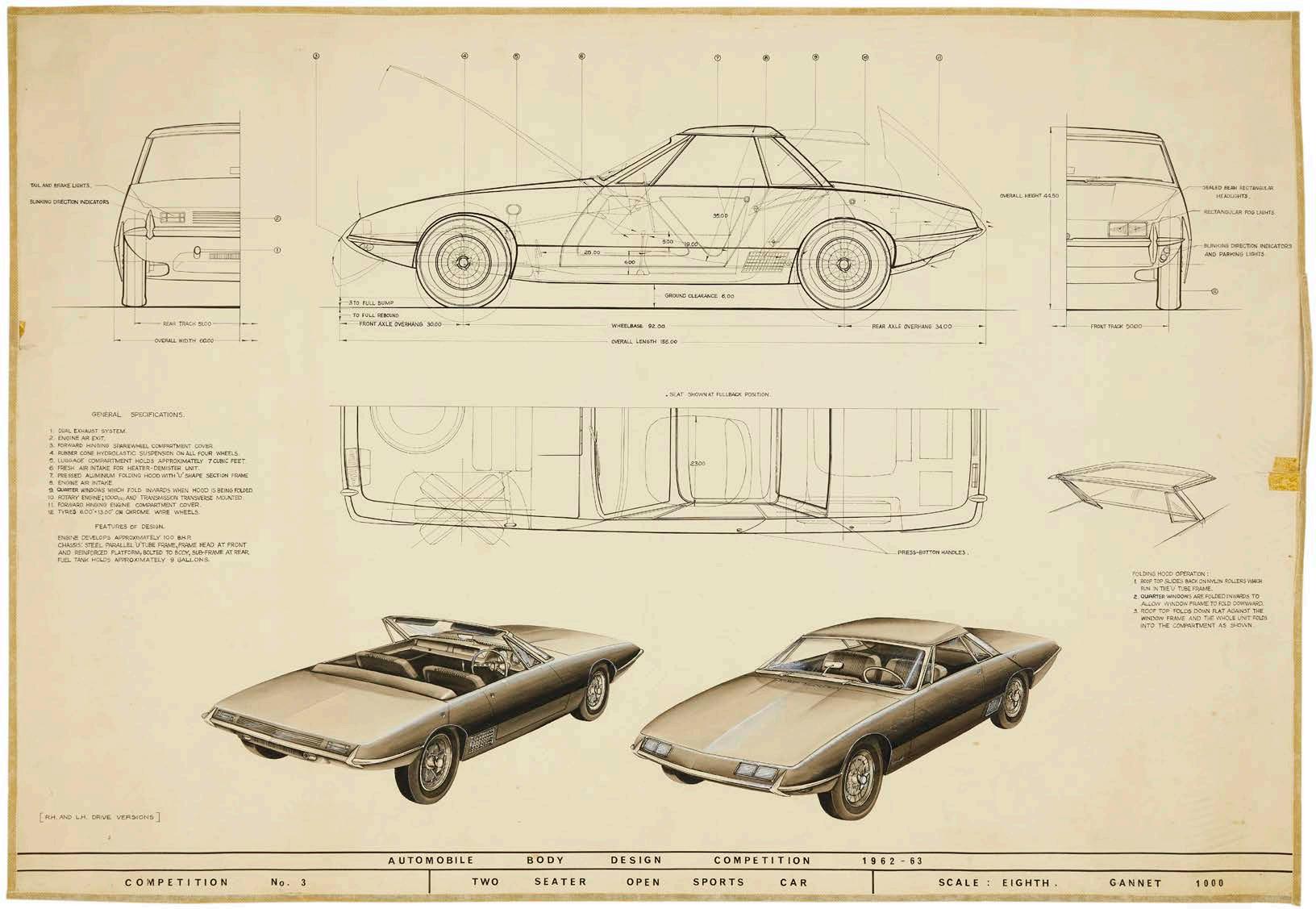
MELBOURNE MODERN 55


56 MELBOURNE MODERN INDUSTRIAL DESIGN
Opposite above Robert Pataki, Kambrook PB-1 Powerboard, 1979, plastic, 3.3 x 121.0 x 7.5 cm (irreg.), RMIT Design Archives: Robert Pataki Collection
Opposite below Bruce Hall, Model of Seventeener transistor radio for Healing, A.G Ltd. Golden Voice range, c. 1960-70, plastic, metal, leather, model: 9.3 x 15.5 x 4.0 cm; box: 9.5 x 16.0 x 5.0 cm, RMIT Design Archives: Bruce Hall Collection
Above Ken Foletta, TOLA Light (light model and box created as part of a student project at RMIT), 1967, plastic, cardboard, paint, light: 14.5 x 15.1 x 16.0 cm, box: 18.7 x 22.6 x 22.6 cm, RMIT Design Archives: Ken Foletta Collection

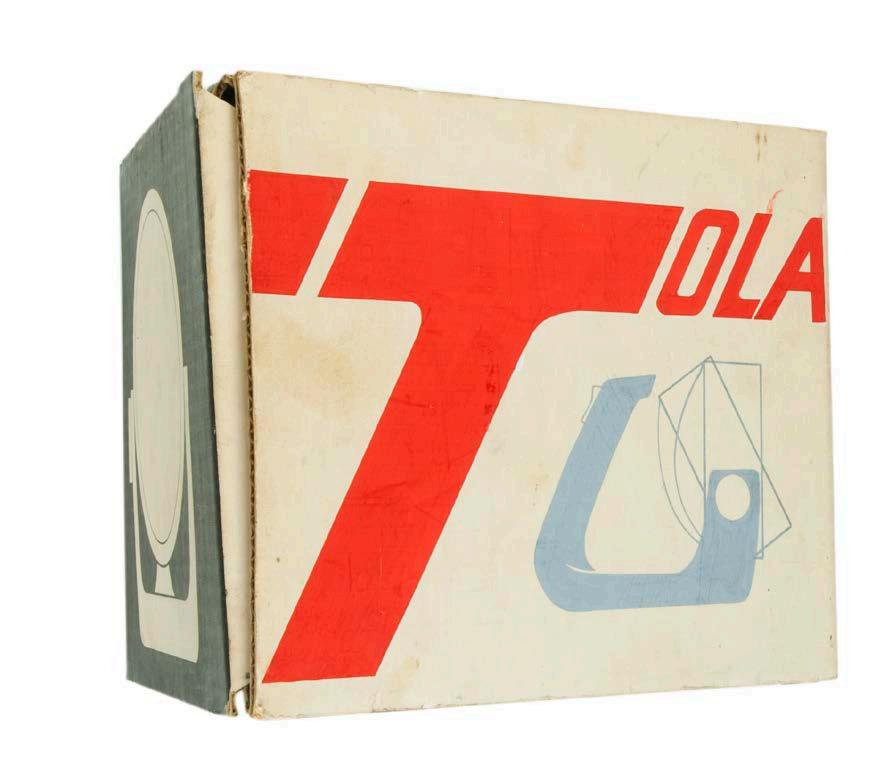
Below left Geoffrey Putnam, Product design: a child’s toy (timber jigsaw that when taken apart resembled individual animals; the case designed to form possible fences etc), c. 1964–68, photograph: Geoffrey Putnam, RMIT Design Archives: Geoffrey Putnam Collection

Below right Geoffrey Putnam, Package design: a protective carton for hand spotlight, c. 1964–68, photograph: Geoffrey Putnam, RMIT Design Archives: Geoffrey Putnam Collection
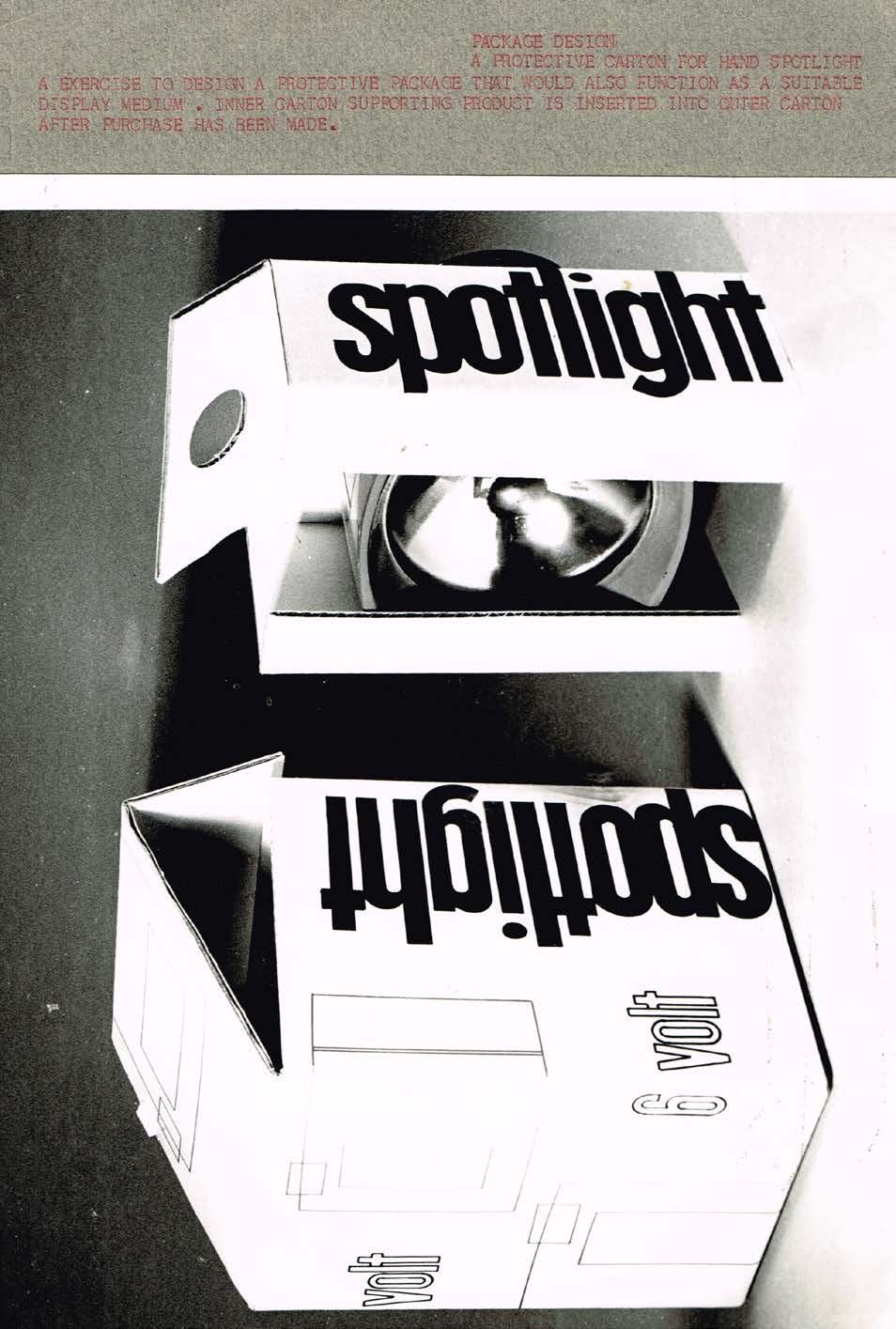
MELBOURNE MODERN 57
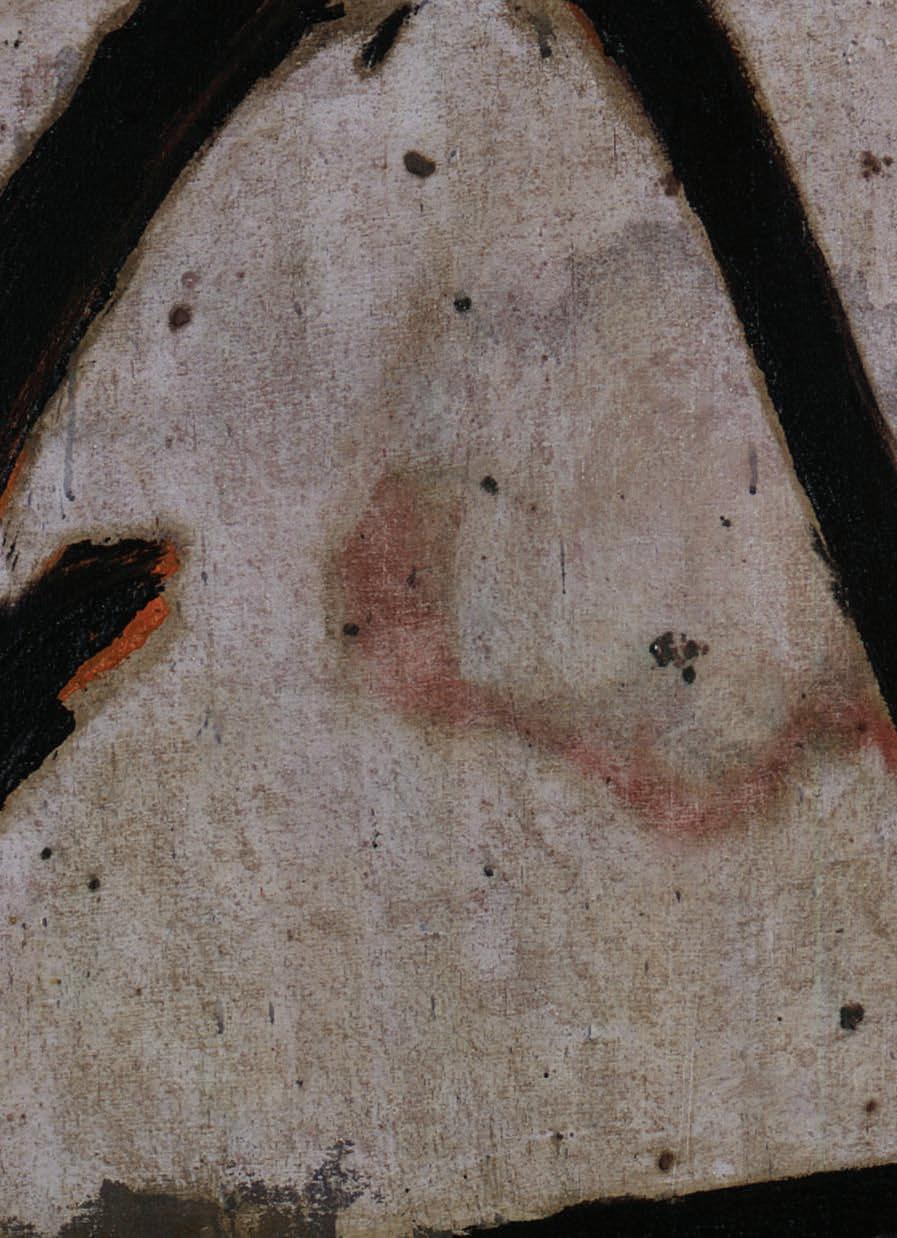
structured eclecticism RMIT PAINTING DEPARTMENT 1945–TODAY SHERIDAN PALMER 4
Opposite Peter Clarke, Elegy (detail), 1975, acrylic on canvas, 75.8 x 75.8 cm, RMIT University Art Collection
It reflected the impact of international modernism that was filtering into Australia’s post-war culture, and revealed how RMIT — like other secondary and tertiary educational schools and institutions— was receptive to European emigrants from war-ravaged nations, and employed them. Moreover, this period of transculturation owes its character to a stream of young Australian expatriate artists who travelled extensively during the late 1940s, 50s and 60s, to Britain, Europe and to a lesser extent America. On their return they incorporated new models of Continental modernism within their teaching, practice and exhibitions. While it was not until the late 1950s that the orientation away from the local and national toward a new cosmopolitanism became fully evident, the transformative effect of this dynamic post-war modernism on society and the enrichment of the arts, particularly in Melbourne, was nevertheless considerable. In this context, RMIT’s Fine Art Department, with a staff that included numerous European artists, designers, scholars, photographers and architects, chimes with what Charles Baudelaire wrote one hundred years earlier: ‘When we discover that there are several cultures instead of just one … and we acknowledge the end of a sort of cultural monopoly, be it illusory or real … suddenly it becomes possible … that we ourselves are an “other” among others’.1
By the 1960s RMIT’s painting school was resoundingly cosmopolitan, not for the presence of Europeans on its teaching staff – apart from Jan Senbergs – but because the majority had feasted on the great art of Europe’s past and present. Its program conveyed various models of international modernism, such as synthetic cubism, geometric abstraction, abstract expressionism, surrealism, symbolism, texture and gestural abstraction, as well as a form of biomorphic realism, ‘filtered through the high noon of antipodean figuration’.2 This eclecticism, with an emphasis on abstraction, never diminished the firm belief that art mattered and was a serious vocational pursuit. RMIT also provided a solid ‘hands-on’ training for artists and craftsmen, a legacy of its origins as the Working Men’s College, which has continued to the present. Lecturers and tutors offered practical instruction in traditional techniques to students,
returned servicemen and secondary art and craft teachers — the latter from Melbourne Teachers’ College where extension courses were mandatory educational requirements — but it also encouraged experimentation and a vigorous productivity. Lesley Dumbrell, a student between 1959 and 1961, recalled RMIT as being ‘a very structured place and the course was quite rigid [but] I went there because I wanted to be a painter’.3
One painting lecturer who had not travelled overseas was Lindsay Edward, who first lectured in ‘general art’ then painting from 1951–78, heading both the painting program, 1959–65, and the Department of Fine Art, 1966–78.4 Edward’s engagement with abstraction began when he took lessons with Mary Cockburn-Mercer in the 1940s, herself having studied with Picasso and Chagall and trained as an assistant to André Lhôte in Paris during the early 1920s. He described his cubist approach to painting as simply wanting ‘to place sequences of shapes, colours and tones on a surface in an abstract manner, like the notes of a Bach fugue’.5 A propensity for musical references or using music as an activating component would become a trait amongst many painters and designers at RMIT that reflected an engagement with European culture and major early twentieth-century modernists such as Paul Klee, František Kupka, Piet Mondrian, Henri Matisse and Joan Miro.
New Zealand’s George Johnson converted to geometric abstraction in the late 1940s when he studied with Theo Schoon and Gordon Walters. From Schoon he inherited Constructivist and Bauhausian principles which he brought to RMIT as a student in the painting school in the 1950s and later as a lecturer in the 70s and 80s. His formal abstraction also adhered to Paul Klee’s meditation on compositional structures, which owed much to the agency of music. This gave Johnson’s work a tantalising, rhythmic quality, but not at the expense of a syntax laden with political and humanist concerns. The painter Peter Clarke, who taught at RMIT from 1963 until 1990, was similarly a Klee devotee, as well as a passionate convert to Spanish gestural abstraction; his meeting with Antonio Tàpies in Spain in 1961 confirmed this genre as a powerful field of expression for him. Moreover, he found the ecclesiastical music of the Spanish high
MELBOURNE MODERN 59
Design, colour and composition encapsulates RMIT’s teaching ethos in the Fine Art Department in the decades following the end of World War II.
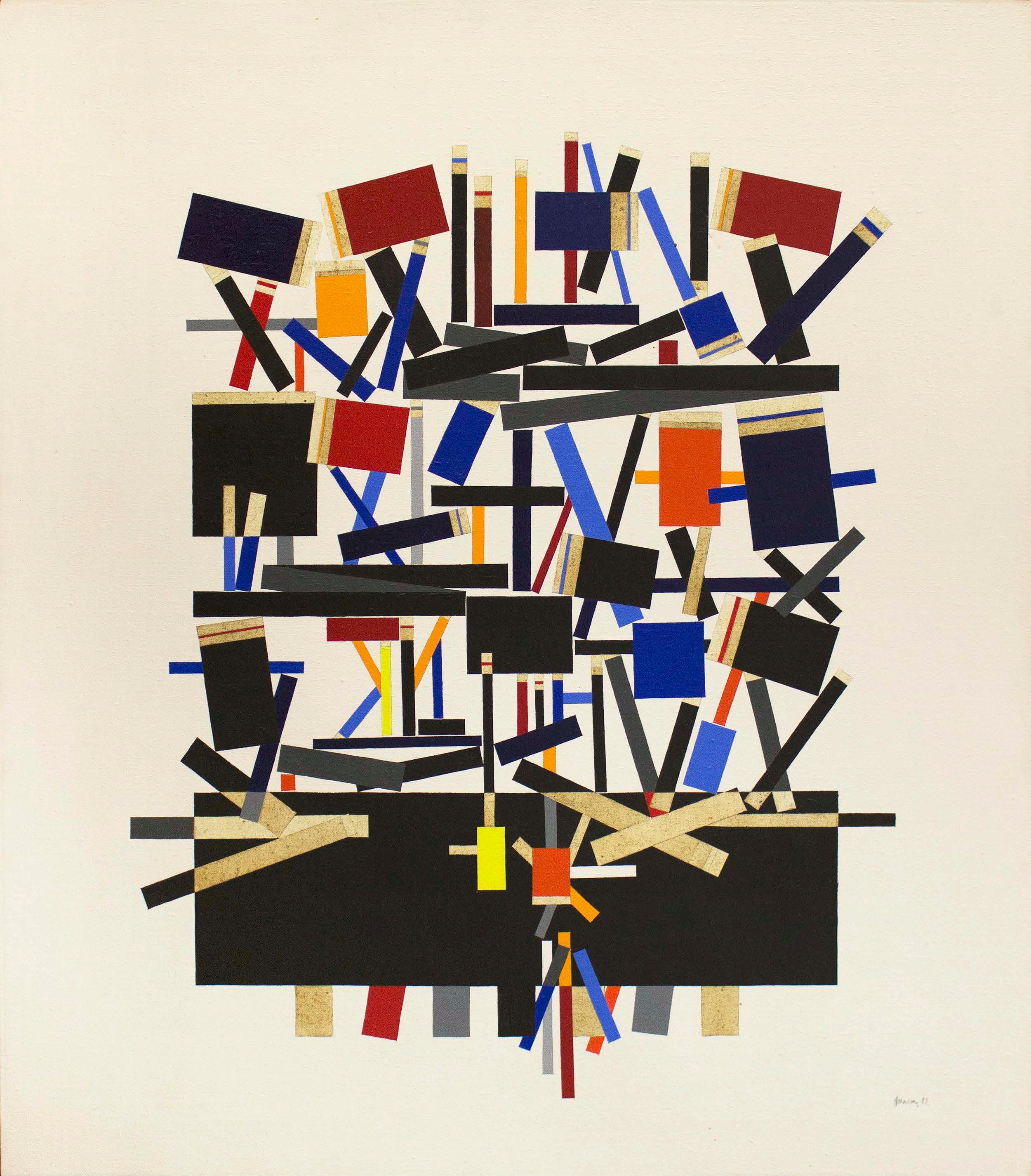
60 MELBOURNE MODERN
Opposite George Johnson, Structures 9, 1983, acrylic on canvas, 122.0 x 107.0 cm, RMIT University Art Collection
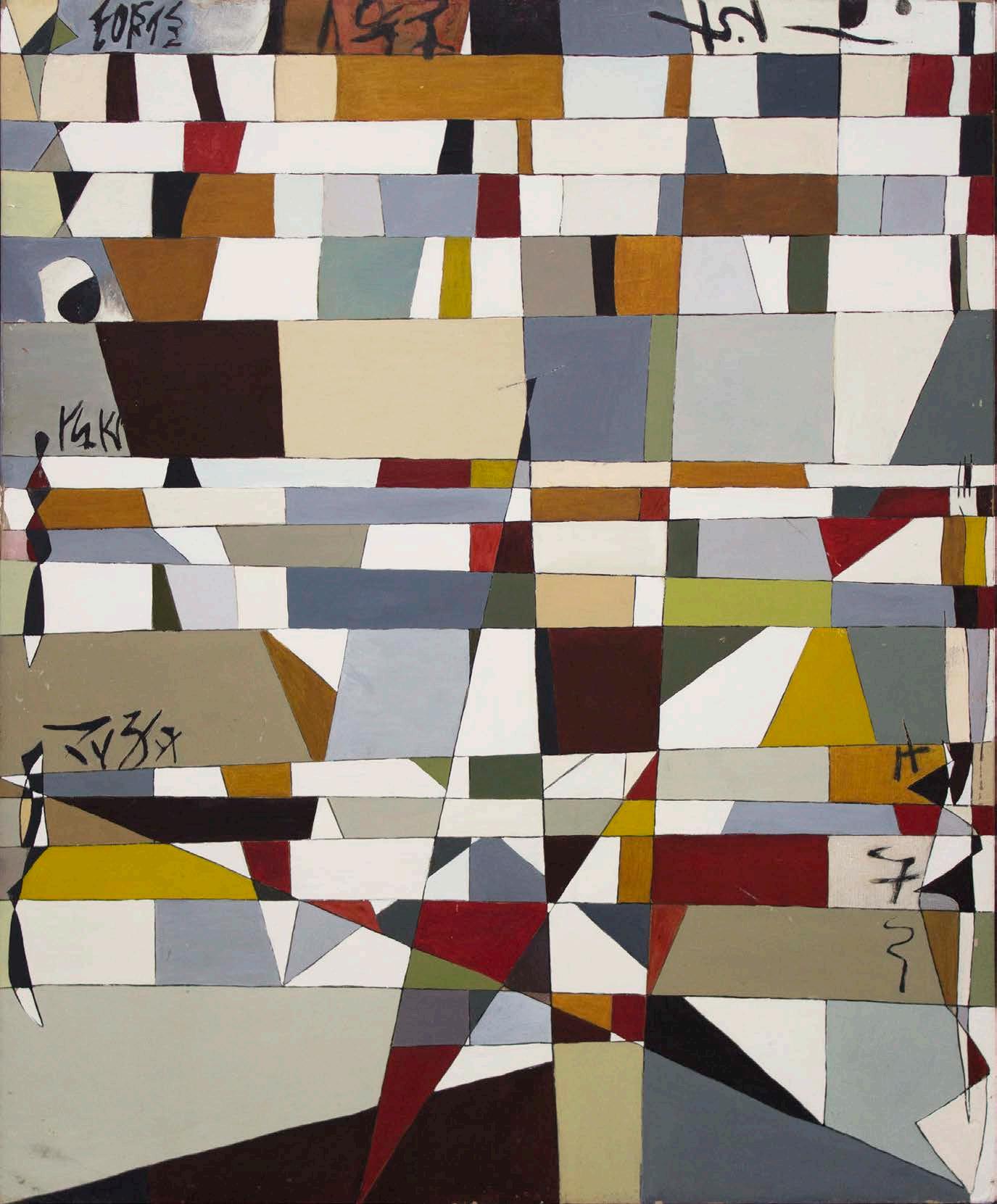
Above Leonard Crawford, A Page from Landino, n.d. (c. 1955–61), enamel on card on Masonite, 76.2 x 63.6 cm, RMIT University Art Collection
Left George Johnson with his work Earth Growth, 1962, photographer unknown, courtesy the artist
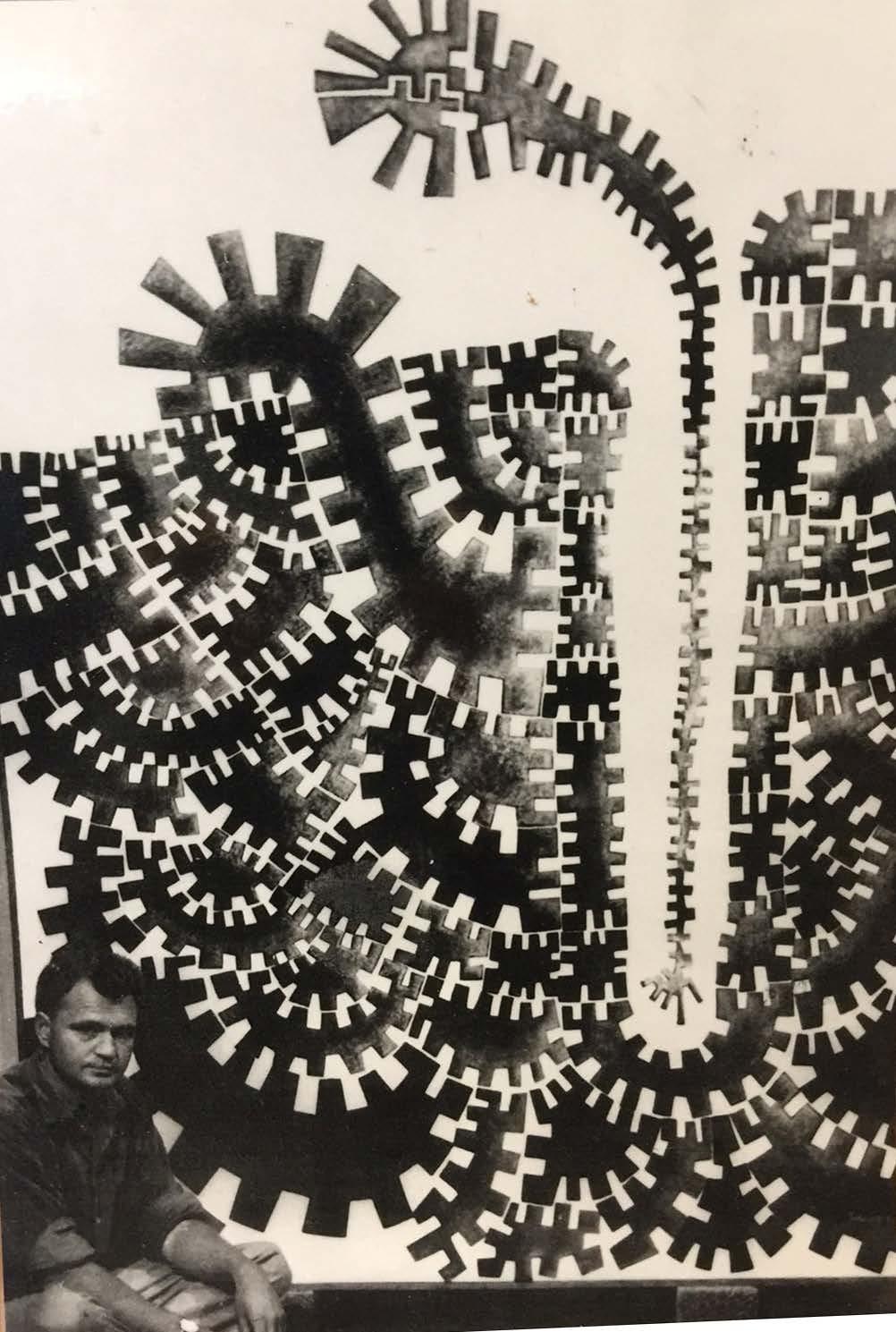
MELBOURNE MODERN 61
Renaissance, especially that of Tomás Luis de Vittoria, an important medium in reconciling the opposites of structure and symbolism, austerity and sensuousness, matter and texture.6 Today classes in the painting school are still taken in texture, material, colour harmonies and gesture, a legacy of RMIT’s respected painting lecturers.7
Leonard Crawford joined the Fine Art Department in 1964 and was a magnetic figure to both older and younger artists within and outside the art school. A respected abstract painter and a passionately knowledgeable man on the history of art and music of all periods, Crawford had also been taught by Mary Cockburn-Mercer, Lina Bryans and Edith Holmes.8 In the early 1940s he had worked as an extra with the Ballet Russes Company, then stranded in Melbourne by the war, and in this he found the combined spectacle of art, dance and music enthralling. Original stage backdrops painted by the European modernists De Chirico, Derrain, Rouault and the Russian avant-garde painters Natalia Gonchorova and Michel Larinov, went hand in hand with Stravinsky, Debussy and Boccherini.9 This agency between music and art dramatically infused his abstract compositions with an aesthetic beat that doubled the pictorial intention of his work. Although a somewhat neglected figure in Australian art historiography, Crawford was a significant influence on many generations of students. According to art historian Margaret Plant, he took his love of music into the art school where, every ‘Tuesday at lunchtime, he would select from his enormous collection of vinyls and put together a concert to which many students and staff came’.10 This contiguity of art and music, as espoused by Crawford, is reflected in his A Page from Landino (c. 1955–61). It pays homage to the revered fourteenth-century blind Italian composer Francesco Landini, whose music represented a freeing of style from older rhythmic modes, with ‘more shapely melodic curves’, constituting part of Italy’s ‘Ars Nova’.11 Crawford’s geometric composition evokes the polyphonic texture or motets of medieval music as well as the structure and colour spectrum redolent of Paul Klee. Graphic designer Gus van der Heyde’s record covers, such as Tchaikowsky: Piano Concerto No. 1 (c. 1960–3), with its riveting, musically inspired calligraphic brushstroke, and Peter Clarke’s Elegy (1975), in which colour
and gesture function as lyrical abstraction and sensuous aesthetic, likewise attest to this creative binary Music wove into the Department of Art in other ways. When Margaret Plant (then Margaret Garlick) became lecturer in art history in 1968, her first year course was a combination of contemporary art, music and film — she recalls that ‘many students remember[ed] the music more than the art’.12 Peter Cripps also remembers that ‘if she was teaching on Picasso, she’d play music from that period’.13 A scholar of Klee, Plant had studied at the Warburg Institute in London and the Paul Klee Stiftung in Bern, Switzerland, and published on this multi-talented artist ‘whose close association with avant-garde trends in art, music and literature, and especially stage and opera’, elevated interdisciplinary concerns of the contemporary to new levels of cultural critique.14
Prior to and overlapping with Plant, the Czech immigrant Miloslav Zika also taught the history of architecture, fine and industrial art, as well as painting and stained glass; his impressive European qualifications in education and psychology provided another fertile link to Europe. Jenny Zimmer’s appointment in 1975 introduced a new focus on world cultures: the arts of Africa, Oceania and Islam, and well as recent Papunya Tula dot painting, featured in her teaching and exhibitions that she curated with RMIT students for the Faculty Gallery and at Storey Hall.15 She recalls that Freud’s Totem and Taboo was then being widely read and earth art ‘was in full swing’, so she sought ways to meaningfully engage students’ interests with non-European and pre-classical cultures.16 Zimmer’s strong European link came through her marriage to Berliner Klaus Zimmer and she devoted many publications to the European émigré artists that she met at RMIT.17
When The Field exhibition opened at the National Gallery of Victoria in 1968, the new American-influenced minimalism and colour-field formalism dramatically impacted on artists of all stylistic camps. As Jenny Zimmer notes, The Field ‘represented a sharp break with the earlier generation of geometric and lyrical abstractionists’, such as RMIT’s Johnson, Clarke and Crawford, with many others ‘left drifting outside the new, youthful mainstream’.18
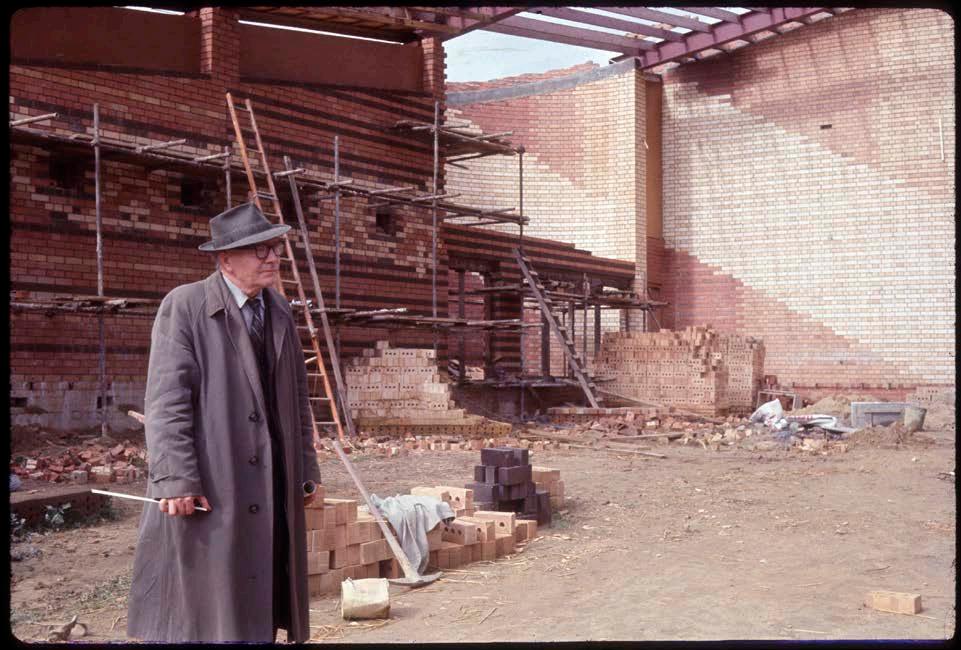
62 MELBOURNE MODERN
Opposite Miloslav ‘Dismas’ Zika on site at St Clare Catholic Church, Box Hill North, Melbourne, mid-1960s, photographer unknown, courtesy Paul Zika. In addition to teaching art and architectural history at RMIT, Dr Zika designed stained glass and church buildings including St Clare’s
Above Peter Clarke, Elegy, 1975, acrylic on canvas, 75.8 x 75.8 cm, RMIT University Art Collection
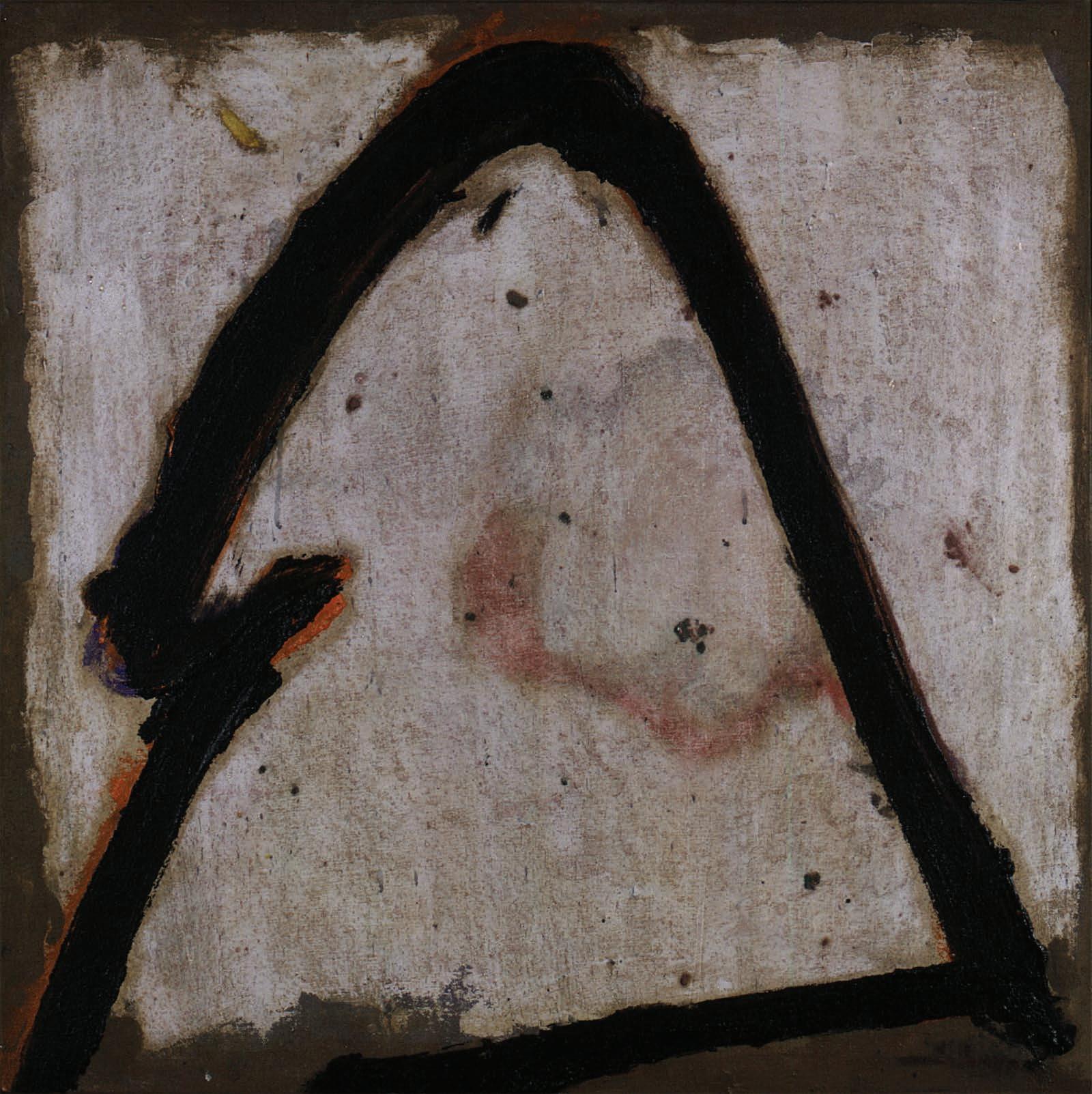
Below
Peter Ellis, Duck Hospital, 1978, oil paint, graphite, nail polish, coloured pencil, enamel paint, collage on Dessin Arches, France paper; image: 100.0 x 67.0 cm, sheet: 180.0 x 75.0 cm, collection of the artist
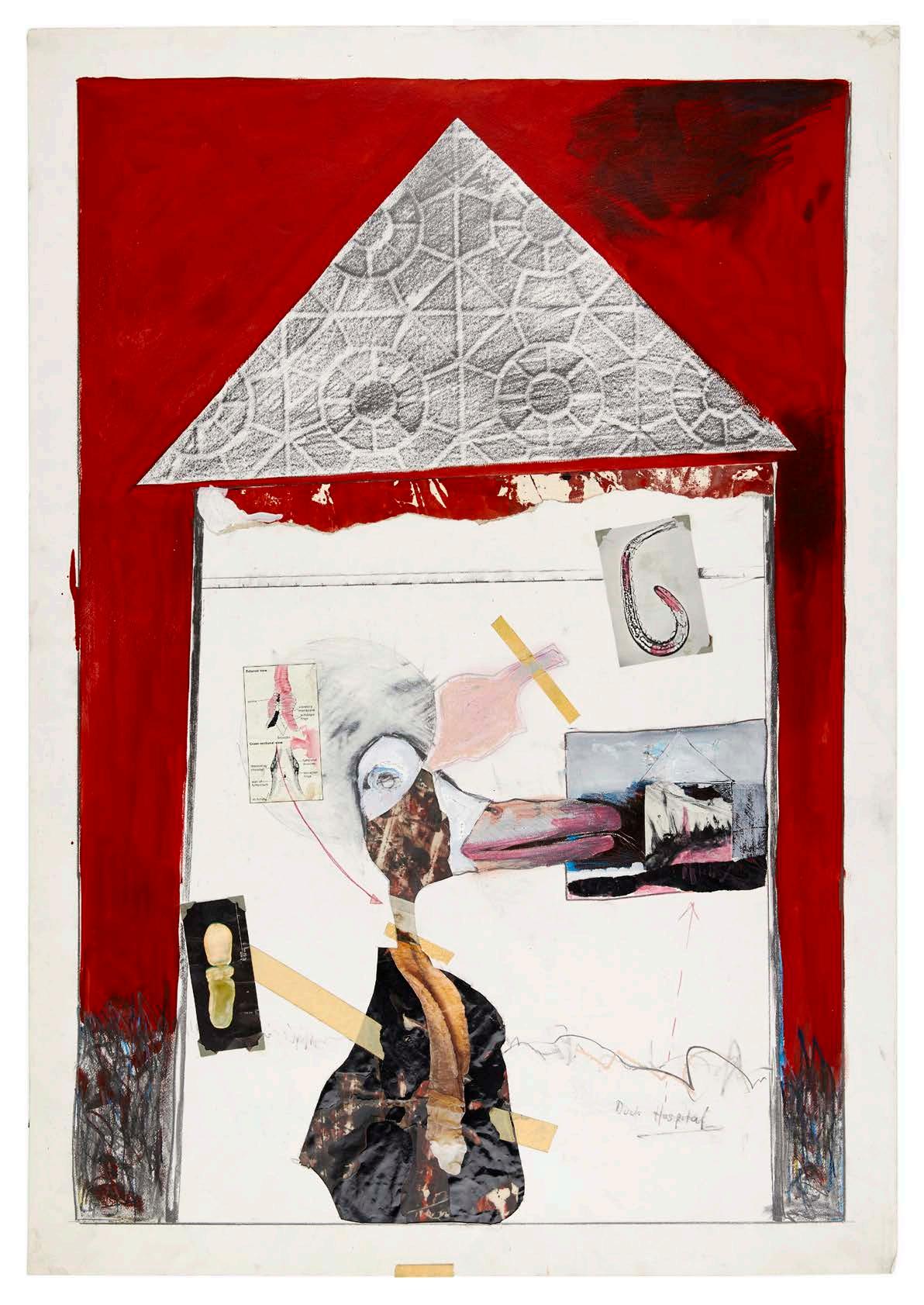
MELBOURNE MODERN 63
Left
Klaus Zimmer, Untitled (student examination work), 1966, oil on canvas, 45.0 x 42.3 cm, private collection

Bottom
Klaus Zimmer, Untitled, 1976, etched glass, lead 78.0 x 68.5 cm, private collection
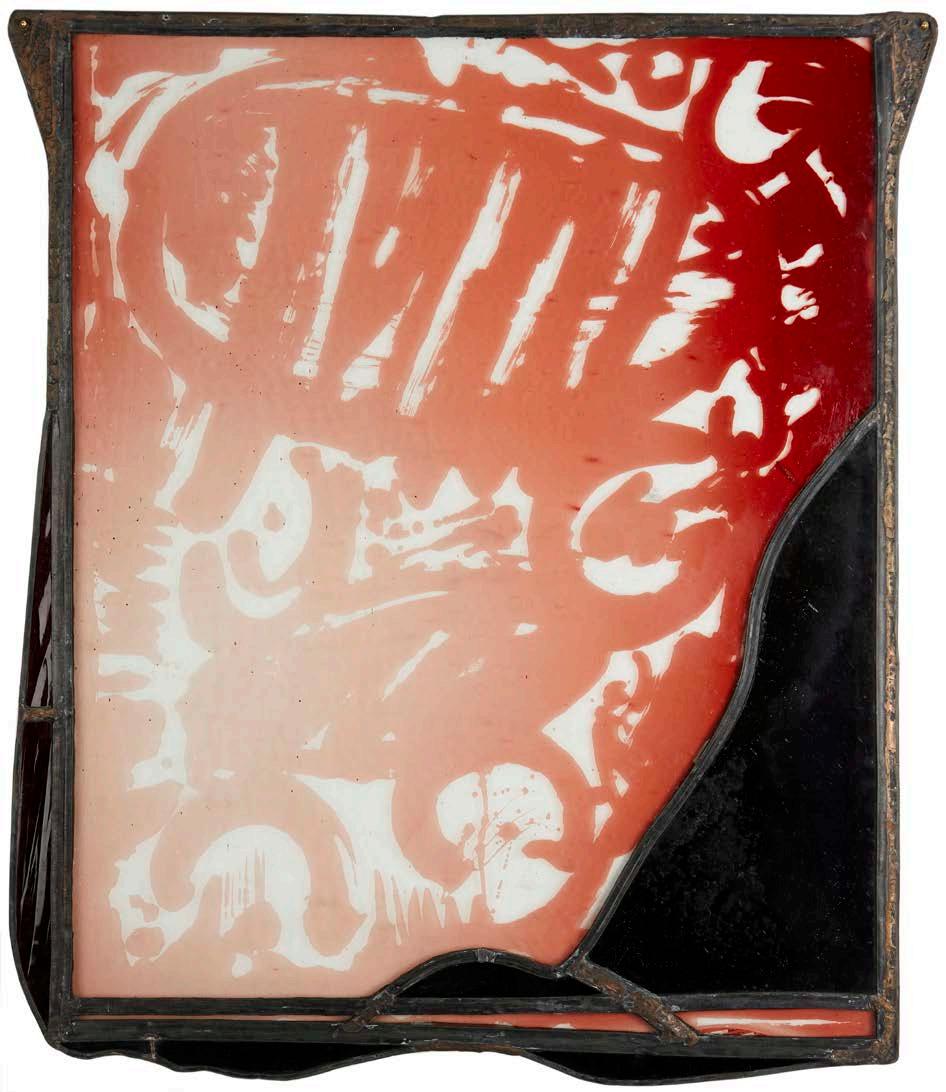
Despite some marginalisation, RMIT maintained an instructive, structured, yet eclectic counterbalance to this ‘new cool’ phenomenon, which Jan Senbergs saw as ‘introduc[ing] a new executive art industry… with an accompanying new art language’.19
By the 1980s the trans-avant-garde revival of figuration was in competition with postmodernism’s appropriation and diversity. RMIT’s younger generation of painting students, such as Angela Brennan, Jon Cattapan, Peter Ellis, David Harley, Bill Hay, David Palliser, Rosalind Piggott and Heather Shimmen, were experimenting with ‘order and randomness’, deconstructing and reformulating the painterly and figurative image through symbolism, Dada, German and American expressionism and twentieth century modernism. And music appeared in yet another guise: the anti-establishment punk:
That whole idea of the Neo-Expressionist moment – the return to painting – was, for a lot of us, tied very strongly to the punk example of knowing three chords and having a go at it.20
As painting students in the mid 1970s and early 1980s, Peter Ellis and Jon Cattapan’s inventive techniques and surreal figuration drew the imagination into adventurous, bizarre narratives. Both artists went on to teach in RMIT’s painting school and acknowledge their debt to a ‘robust’ environment in which Peter Clarke, Rod Clarke, Len Crawford, Richard Crichton, Bill Ferguson, William Gleeson, James Meldrum, Ronald Millar, Jan Senbergs and Andrew Sibley all played inspiring roles. In his 2017 work, Taking a Line for a Walk, David Thomas, a former RMIT student and until recently senior lecturer in painting, addressed this notion of aesthetic inheritance. The work is both a homage to the Bauhausian teachings of Paul Klee and an exploration of line as a pictoralising agent in time and space, with colour operating as a notational, monochromatic interval.21 It is another example of the continuum and accumulation of cross-cultural fertilisation of painterly language, design and aesthetic philosophies, which have flowed from teachers to students, replayed at each generational turn to engender a distinct cultural tone within RMIT’s structured eclecticism.
64 MELBOURNE MODERN PAINTING DEPARTMENT
1 Charles Baudelaire, Art in Paris 1845–1862, London: Phaidon, 1965, 97.
2 Memory Jockisch Holloway, ‘Venus in a Sackcloth: eroticism and ritual in the work of George Baldessin’, in George Balsdessin: Sculpture and Etchings, a memorial exhibition, Melbourne: NGV, 1983, 27.
3 Lesley Dumbrell interview with James Gleeson, 16 October 1979, National Gallery of Australia, Oral History Collection, URL: https://nga.gov.au/research/gleeson/pdf/dumbrell.pdf (accessed 15 March 2019).
4 Dates are from a survey of the MTC, RMTC and RMIT Calendars. Edward probably began as early as 1947 in a part-time position; the dates are difficult to confirm as only full-time staff members appear in the calendars. The School of Art had three departments: D esign, Fine Arts and Photography.
5 Jenny Zimmer, ‘Teacher’s fine art traversed life of his city and times’, The Age, 2 June 2007, 10.
6 Laurie Thomas, ‘The colours of whiteness and silent spaces – Peter Clarke interviewed’, The Australian, 12 July 1969; Peter Clarke interview with Sheridan Palmer, 29 March 2019.
7 Peter Ellis interview with Sheridan Palmer, 7 November 2018.
8 Jenny Zimmer, ‘Leonard Crawford’, Art and Australia, vol. 26 no. 3, Autumn, 1989, 427.
9 Leonard Crawford interviewed by Barbara Blackman, 27 July 1988, National Library of Australia, URL: http://nla.gov.au/nla. obj-216049296 (accessed 16 April 2019). Gini Nibbi’s Leonardo Art Shop, with its international and European range of books, magazines and posters, was another haunt of Crawford’s, which he remembered as having a ‘powerful effect on painters of the day’.
10 Margaret Plant unpublished interview with Jane Eckett, 5 October 2017.
11 Percy A. Scholes, The Oxford Companion to Music, London: Oxford University Press, tenth edition revised, 1975, pp. 55-6, 564.
12 Margaret Plant interview, op. cit. (and italicise op cit)
13 Peter Cripps unpublished interview with Jane Eckett, 2 August 2017.
14 Margaret Plant, Paul Klee: Figures and Faces, London: Thames and Hudson, 1978, cited in Ursula Hoff, ‘The Feat of Klee’, Meanjin, vol. 38, no. 4, summer 1979, 530.
15 In 1986 Zimmer was instrumental in mounting a landmark exhibition of Papunya Tula boards, Dot and Circle: a retrospective survey of the Aboriginal acrylic paintings of Central Australia, at RMIT Gallery, in collaboration with Flinders University.
16 Jenny Zimmer in conversation with Jane Eckett, 18 December 2018.
17 See for instance: Jenny Zimmer, Inge King Sculpture 1945-1982: A Survey, Parkville: University Gallery, University of Melbourne, 1982; Jenny Zimmer, ‘Five Berliners in Melbourne’, Aspect: Survey of Ethnic Visual Arts in Australia, nos. 29/30, Autumn 1984, 133-60; Klaus Zimmer glass artist, Melbourne: Macmillan, 2000; and Jenny Zimmer, Tate Adams and Patrick McCaughey, The Crossley Gallery, 1966-1980, Melbourne: Macmillan, 2003.
18 Jenny Zimmer, (ed.,), George Johnson: World View, Melbourne: Macmillan, 2006, 34.
19 Jan Senbergs, ‘A View from the Field to the Square —some observations from Melbourne: The art scene from the late 1960s to the present’, lecture, Art Gallery of New South Wales, 21 June 2000, unpublished manuscript, courtesy of Jan Senbergs, 14.
20 Jon Cattapan in Chris McAuliffe, Jon Cattapan: Possible Histories, Melbourne: Miegunyah Press, 2008, 22.
21 David Thomas interview with Sheridan Palmer, 29 March 2018.
MELBOURNE MODERN 65 ENDNOTES
Left Paul Zika, Untitled, 1969, acrylic on canvas, 81.0 x 81.0 cm, RMIT University Art Collection
Opposite Paul Zika, Untitled, 1970, acrylic on canvas, 163.0 x 181.0 (irreg.) cm, collection of the artist
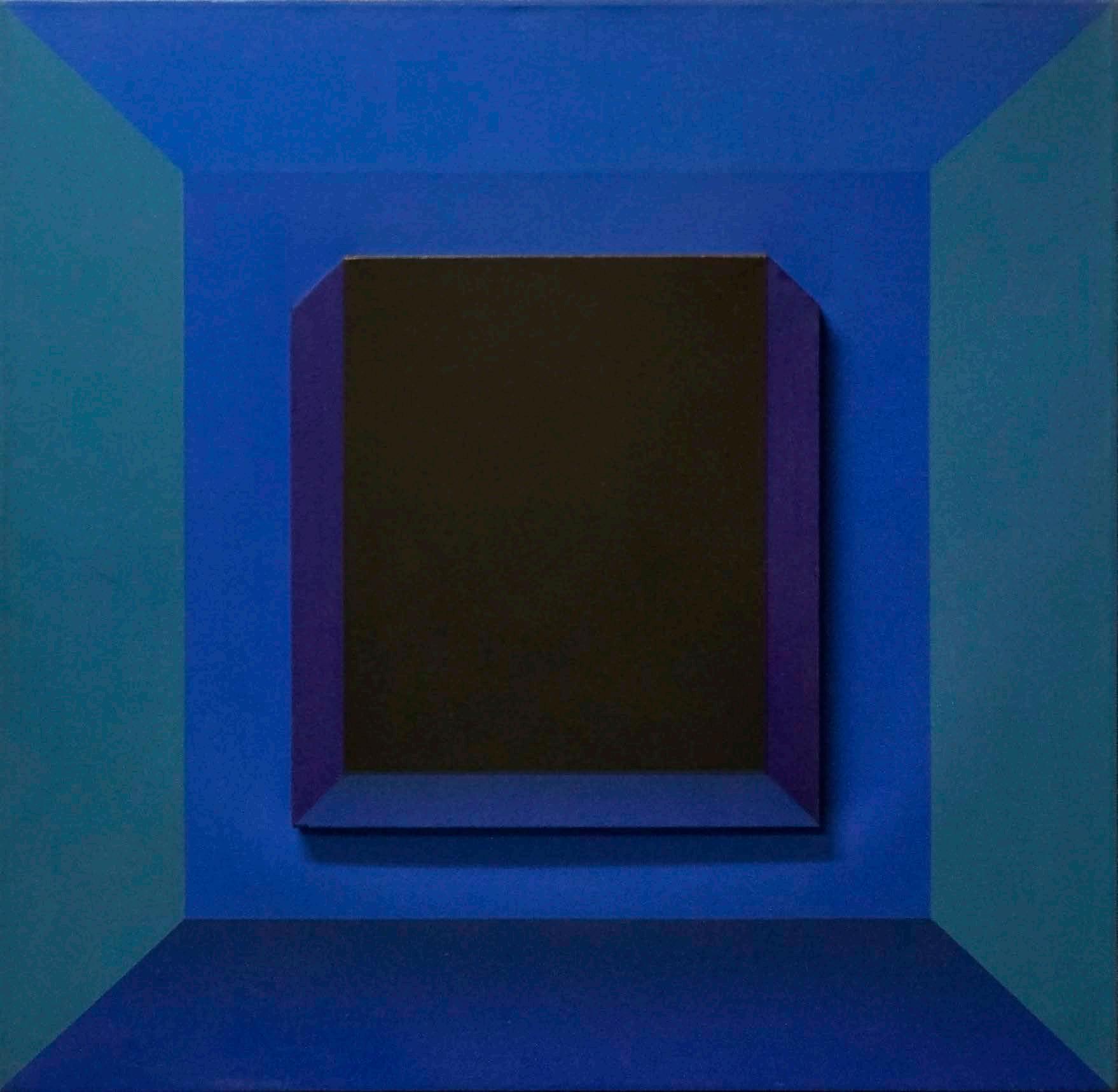
66 MELBOURNE MODERN
DEPARTMENT
PAINTING

MELBOURNE MODERN 67
5 material studies and professional practice:
EUROPEAN ÉMIGRÉ SCULPTORS AT RMIT JANE ECKETT
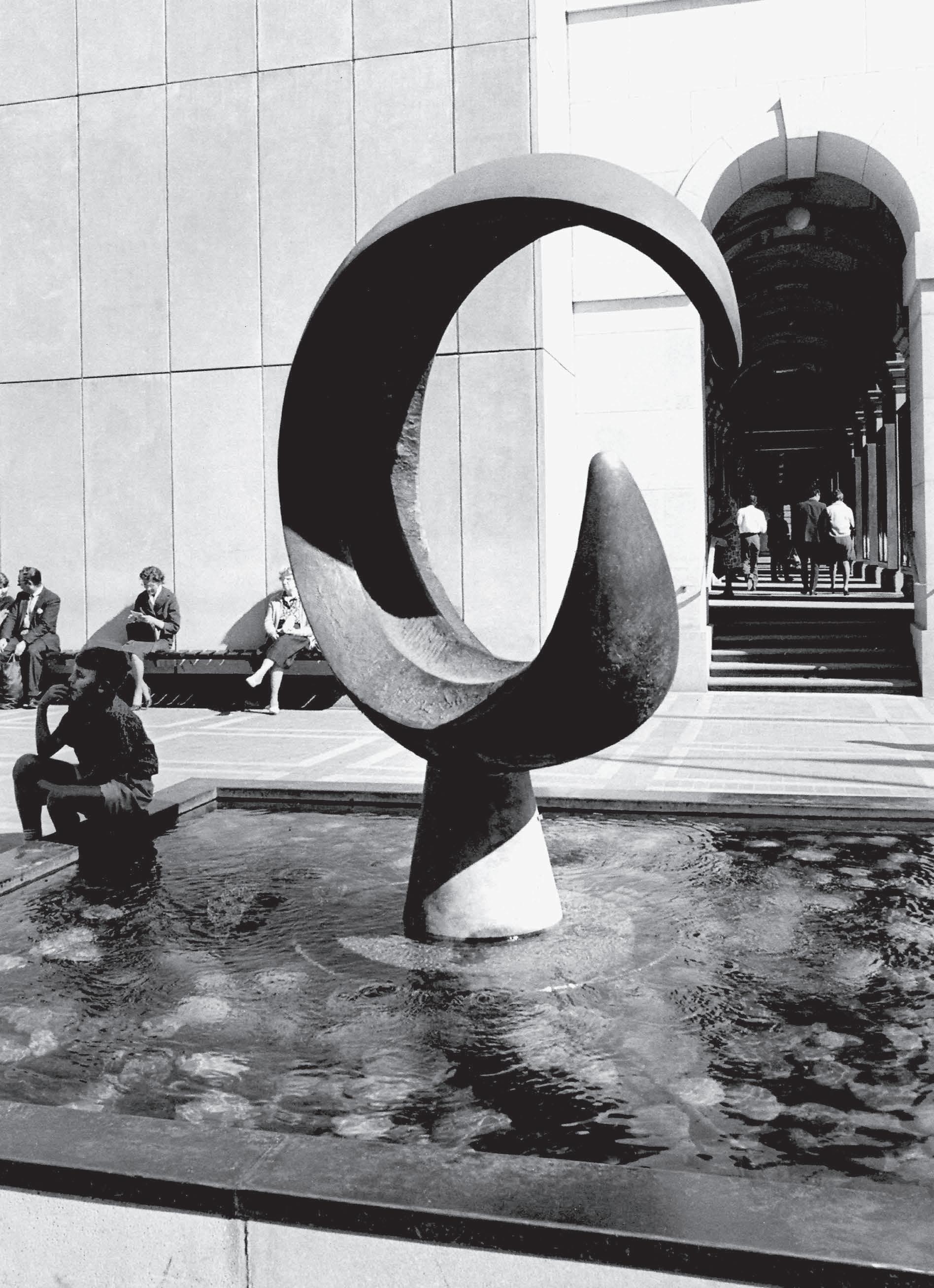
Opposite Teisutis Zikaras, GPO Fountain, 1964, bronze, corner of Elizabeth and Little Bourke Streets, Melbourne (now collection McClelland Gallery and Sculpture Park), photograph: Mark Strizic, courtesy Marcus Zikaras
Of all the departments in RMIT’s School of Art, post-World War II European émigré teachers arguably made the greatest impact in sculpture.
Teisutis Zikaras, Vincas Jomantas and Hermann Hohaus comprised over half of the full-time teaching staff in the sculpture department for three decades, from 1956 to 1987, while Inge King served as an external examiner in the 1960s before joining as sessional staff from 1975 to 1987. Between them they had studied in the academies and art schools of Kaunas, Vilnius, Berlin, Munich, London and Glasgow and inherited a centuries-old discourse of sculpture as a proxy for the human figure. However, each moved beyond their academic training and developed a range of views as to what modern sculpture could do. The RMIT student body during these years also included a number of younger émigrés such as Guenter Stein, George Baldessin, Phillip Cannizzo, Augustine (Gus) Dall’Ava, Gerhard Fronske, Pasquale Marinelli and Ernesto Murgo, who began their sculpture studies at RMIT and, in some cases, continued them overseas. Baldessin, Dall’Ava and Murgo returned to teach; in Murgo’s case, very shortly after graduation – adding an Italian dimension to the department that, as Jan Senbergs recalls, came to be known as ‘The Foreign Legion’.1
What can be gleaned from these years of European influence? While oral and written testimonies of the émigré sculptors and their students vary, several common threads emerge. First was the professionalism with which the émigré sculptors approached both teaching and private studio practice. This was a professionalism that went beyond mere appearances – though most recall the unfailingly neat appearance of Jomantas and Zikaras with their shirt-collars and ties. It underlay their approach to public commissions and their attitudes towards the growing commercial gallery network. Second was a concern for material: understanding the physical properties and potentials of different mediums. And third was the belief that sculpture was above all a means for expressing feelings and ideas, which took precedence over the choice of material. In other words a sculpture should be made in the material best capable of expressing the particular feeling or idea that the sculptor wants to communicate, irrespective of the sculptor’s preference for one or other medium or technique. Closer examination of these interconnected threads enables a clearer picture to emerge of RMIT’s sculpture department in the 1960s
to 1980s, and to trace the legacy of these concerns to the present day.
The first appointment of an émigré sculptor occurred in 1956, when the Lithuanian Teisutis Zikaras was engaged to teach in the School of Art. Compared to the rapid post-war uptake of émigrés in architecture, this seems somewhat belated. Perhaps any appointments were deemed unnecessary when the sculpture department had three long-serving staff members: George Allen (head of sculpture from 1933 to 1964, with a short break during war service, 1942–45), Eric Beament (1929–57) and Stanley Hammond (part-time, 1936–58). Or perhaps sculptor Victor Greenhalgh’s promotion to head of the Fine Art Department in 1956 generated the momentum and will to engage new sculptors on staff. Certainly no time was lost in engaging the school’s first Graduate Diploma in sculpture, Lenton Parr, as an assistant lecturer in sculpture in 1957 (rising to lecturer in 1961 and briefly succeeding Allen as head of sculpture in 1964–65).2 More likely, however, the circumstances of the émigré sculptors’ arrival in Australia caused this belatedness. Where the architects Fooks, Romberg and Sterne reached Melbourne just before the outbreak of war and found reasonably ready recognition of their professional qualifications, the sculptors mainly arrived as ‘Displaced Persons’ (DPs) under the Australian Commonwealth Government’s labour migration scheme, which entailed being despatched to processing centres such as Bonegilla before undertaking two years of indentured labour. Given the time lag between arrival and professional recognition in the form of exhibitions, the relatively slow uptake at the RMTC is more understandable.
Teisutis Zikaras taught ‘general art’ for the first ten years of his tenure before he was made lecturer in sculpture – a position he retained until retirement in 1978.3 His appointment was likely made on the recommendation of George Allen and Stanley Hammond, for whom Zikaras had worked on the Second World War Memorial at the Shrine of Remembrance, 1951–55.4 Zikaras was born in Panevėžys and from the age of six lived in the then newly proclaimed Lithuanian capital of Kaunas. His father, Juozas Zikaras, was a leading sculptor of the Lithuanian nationalist revival and
MELBOURNE MODERN 69
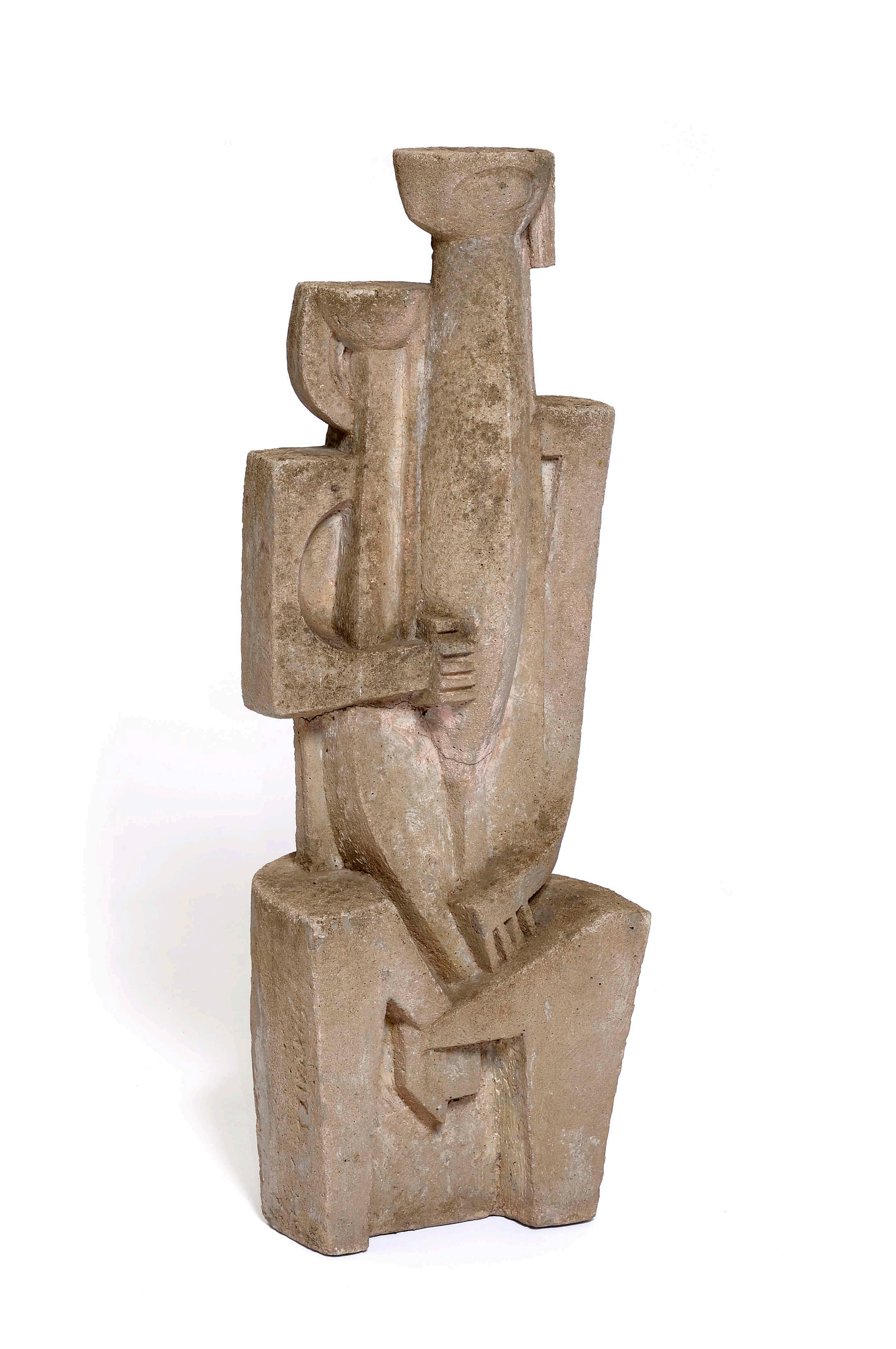
70 MELBOURNE MODERN
Opposite Teisutis Zikaras, Mother and Child (also known as The Family), c.1956-59, cast cement, 94.0 x 35.0 x 25.0 cm, McClelland Sculpture Park+Gallery
Far left Teisutis Zikaras in the sculpture studio at RMIT, 1965, Immigration Photographic Archive, National Archives of Australia, Canberra
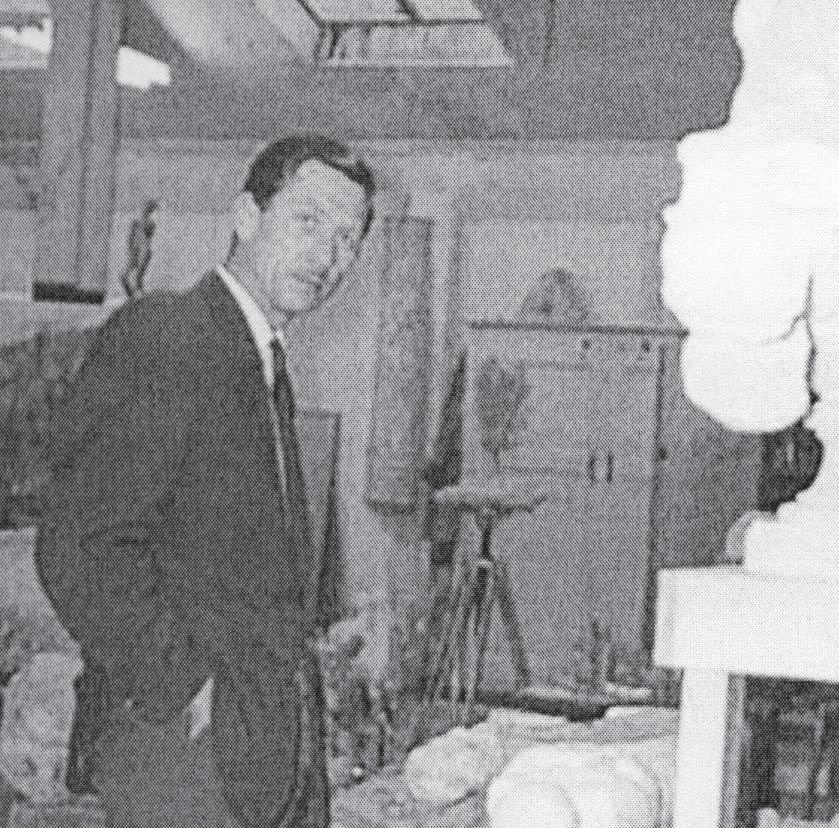
Left
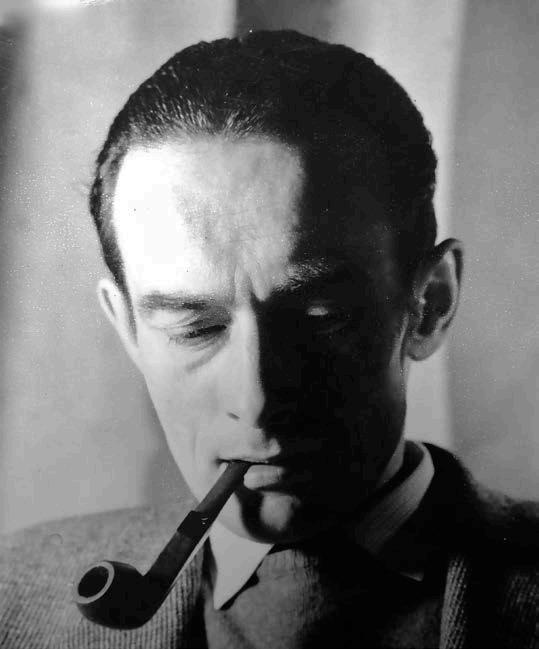
Vincas Jomantas, 1959, photograph: Mark Strizic, courtesy Laima Jomantas
gave Teisutis his earliest instruction. However, Teisutis quickly rejected his father’s form of romantic academic realism, instead preferring the French interwar classicism espoused by his teachers, Vytautus Kašuba and Juozas Mikėnas, at the Kaunas Art School, where he studied 1939-43.5 In the summer of 1944 Teisutis fled the advancing Red Army, arriving in Freiburg, in Germany’s French zone, in the autumn of 1946. There he was appointed to the teaching staff of the Freiburg École des Arts et Métiers, a short-lived art school serving Lithuanians in exile in the post-war years, 1946-49. At Freiburg his work shed any residual realist roots in favour of a more expressive mode inspired by Picasso, Chagall and Rouault, tackling subjects with universal themes of suffering that simultaneously spoke of Lithuania’s anguish over its lost national sovereignty.
After migrating to Australia in 1949 such works as these rapidly established his reputation as a modernist innovator. He joined the CAS and VSS in 1953, and in 1955 held his first solo exhibition at the Victorian Artists’ Society (VAS) Gallery.6 In 1959 Zikaras, along with Jomantas and King, was included in Six Sculptors – the first exhibition of modern sculpture at the NGV. Two years later these six joined with Parr to form Centre 5, a vital group advocating for modern sculpture in Australia. In the same year – 1961 – Zikaras’s work was selected for the first Mildura Prize for Sculpture and the second Exposition Internationale de Sculpture Contemporaine at the Musée Rodin Paris, while Romberg and Boyd commissioned him to create an abstract fountain for the staff courtyard at the ETA factory. Throughout the 1960s Zikaras maintained this pace, completing a second abstract fountain for the square in front of Melbourne’s GPO in 1964, exhibiting with Centre 5 in Newcastle (1963) and Sydney (1964, 1965), and being included in Recent Australian Sculpture (toured nationally 1964-65) and many smaller group shows. However, his output slowed in the 1970s; by the end of that decade personal issues overtook and he virtually ceased working.
Zikaras believed art was a form of intimately personal expression that arose not from intellectual thought but rather spontaneously from within the self.7 Accordingly he switched between mediums, techniques and styles to suit a particular
expression, employing variously ciment fondu, arc welding or ‘old fashioned modelling … [of] lumps of clay … with carving, with battling, with trampling’.8 His home studio was a deeply private space, though he occasionally demonstrated techniques at school to architecture and sculpture students. Bartlett and Don Gore recalled him as a kindly presence within the art department; after checking that the sculpture studio was running safely and smoothly he would retreat to his office to read the newspaper, though was always on hand to answer questions should a student seek his advice over a technical matter such as operating a spray-paint gun.9 ‘Art is a way of life’ he told Hazel de Berg in 1965. By extension, students must learn individually; there was no one-rule-for-all.
The second émigré recruit was also Lithuanian: Vincas Jomantas. Jomantas and Zikaras knew one another from Kaunas, where their fathers had been close friends and evinced similar nationalist aspirations in their respective arts.10 Jomantas’s father, Vilius Jomantas, was a painter and lithographer who designed currency, stamps and commercial and political posters. Vincas worked in his father’s studio and followed him to Vilnius in 1942, where he studied at the Vilnius Academy until 1944 when he too fled west from the advancing Soviet front.11 Jomantas arrived in Munich in October 1944 and studied at the Munich Academy of Fine Arts, 1945-48, amid the rubble and post-war reconstruction. His teacher at Munich was a leading figurative sculptor, Anton Hiller, who then was rapidly shedding the interwar classicism that had enabled him to continue working through the Nazi years; instead Hiller was archaising, simplifying and often eroticising the female figure – rendering it a vehicle for modernist subjectivity. Hiller’s influence is more evident in the early work of Jomantas’s colleague at Munich, the Hungarian Julius Kohn (later Kane), who afterwards likewise migrated to Melbourne and instigated the Centre 5 group. Jomantas certainly absorbed Hiller’s anti-classicising, archaising influences, but welded them to a dual appreciation for Lithuanian folk art and French Cubism – particularly the postWorld War II work of Henri Laurens. These three influences combined eventually produced the unique form of quiet and sombre symbolic abstraction for which he became renowned in Australia.
MELBOURNE MODERN 71
Above Vincas Jomantas, Sun’s Messenger, 1997, watercolour on paper, 88.0 x 69.0 cm, private collection
Opposite Vincas Jomantas, Landing Object II, 1971, fabricated polyester resin and fibre glass, 111.0 x 120.0 x 104.0 cm, McClelland Sculpture Park+Gallery
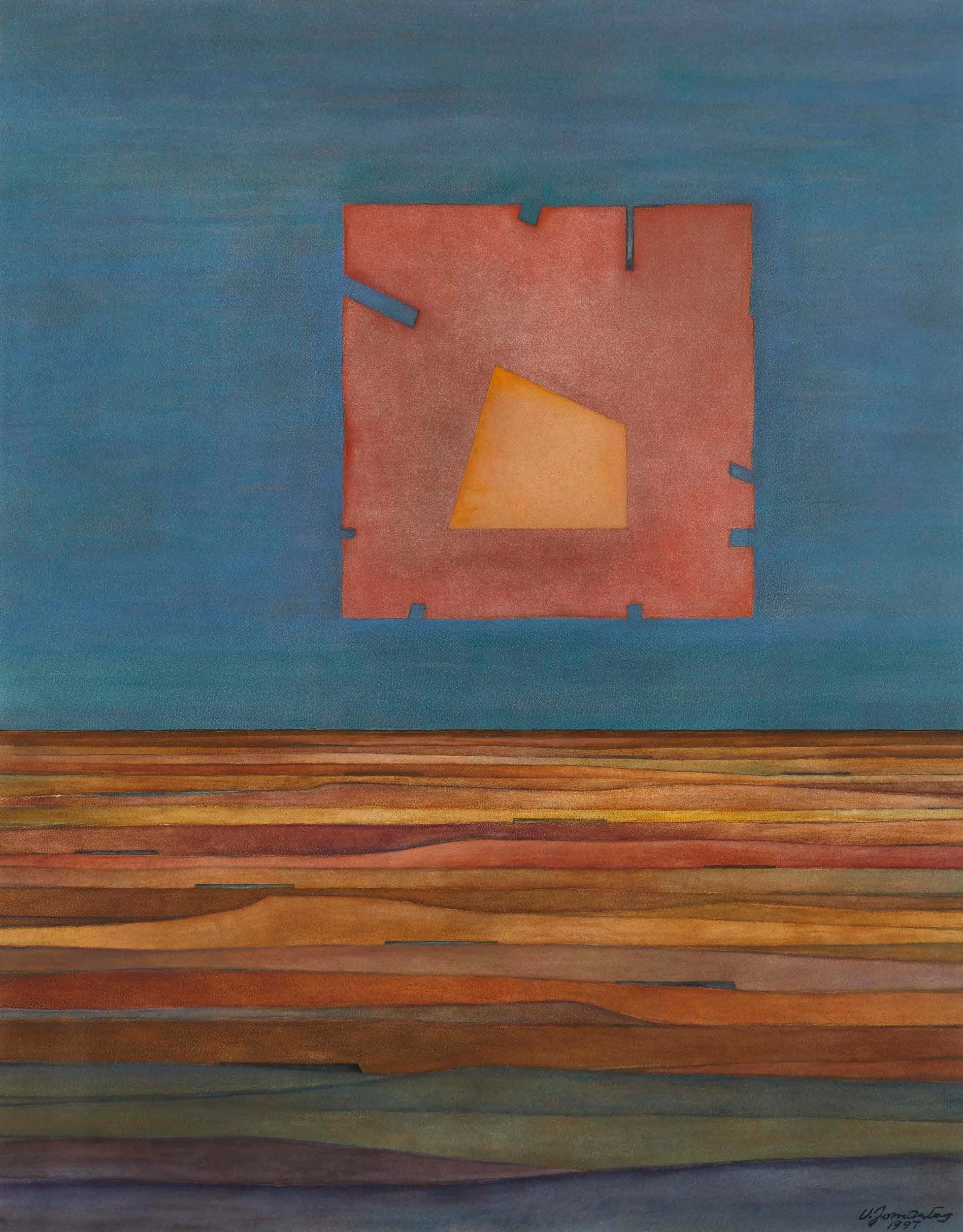
72 MELBOURNE MODERN
Greenhalgh invited Jomantas to join RMIT in May 1961, initially as a temporary instructor in art teaching drawing and design to first-year students.12 Zikaras may have suggested Jomantas for the position, the two having become re-acquainted in 1956 at a CAS exhibition, or perhaps the recommendation came from their Centre 5 colleague Lenton Parr. The strong Centre 5 presence on staff – Zikaras, Jomantas and Parr – was significant; Maudie Palmer recalled being inspired by the group’s philosophy when she studied sculpture at RMIT in the mid-1960s.13 Jomantas was soon appointed on a permanent full-time basis and from 1962, as ‘Lecturer, General Art’, taught sculpture to painting students (who had to do a sculpture unit in first year), night-classes in woodcarving and occasionally summer school courses such as that taken by the future architect Maggie Edmond.14 By 1967 he was listed in the prospectuses as ‘Lecturer – Sculpture’ and in 1973 appointed head of the sculpture program, a position he retained until retirement in 1987.15
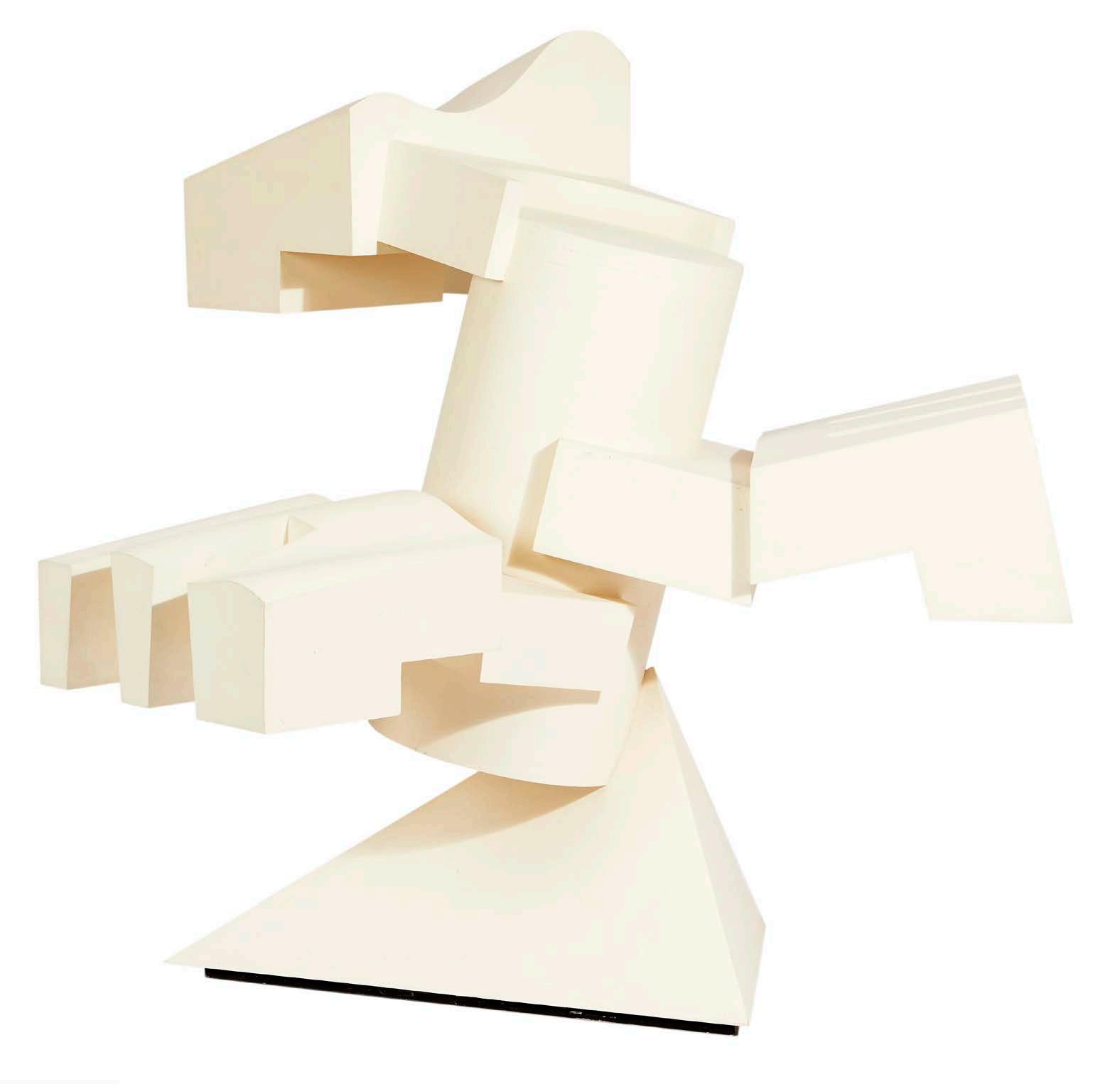
Jomantas embodied professionalism, transmitting it not only by example but also through a subject he offered third-year students called ‘Professional Practice’, in which he prepared them for contractual relations with commercial galleries and managing public commissions with their various
stakeholders.16 Some, including Anton Hasell, recalled dreading these three-hour-long discussions on the minutiae of insurance and legalities.17 Resilience and persistence were required. In 1967 Jomantas explained: ‘I tell all my students it’s a hard life… I tell them you should be very brave’.18 His expectations of commitment and resolution were not always met. Geoffrey Bartlett’s irregular attendance earned Jomantas’s disapproval (Jomantas unaware that Bartlett had returned to Geelong due his mother’s declining health).19
Kevin Mortensen’s timekeeping similarly irked Jomantas; the former student often arriving an hour after the life models who, as a member of staff, he was supposed to ‘look after’.20 Consequently, by 1984, Jomantas pronounced his students ‘a bit too casual – they are not serious enough’.21 Seriousness meant meticulousness: students were expected to sharpen their chisels, clean their tools and clean the studio.22 And it meant regularity: Peter Cripps recalls Jomantas telling him that, ‘You have to go to the studio everyday, even if you just sit there and sharpen your pencil’.23 This was an understated critique of the notion of genius – quite different from Zikaras’s more erratic bursts of energy interspersed with months of brooding between works.
Jomantas believed teachers should not interfere with
MELBOURNE MODERN 73
Opposite Vincas Jomantas, Birds of Death, 1964–65, laminated, milled and carved wood, scorched and wirebrushed, waxed, 166.0 x 90.0 x 82.0 cm, private collection
or influence students’ work.24 Students were left largely to work things out for themselves by trial and error. They were welcome to ask advice regarding materials and processes but Jomantas refrained from commenting on subject matter. He believed knowledge of a range of materials gave students the freedom to choose the medium best suited to express their feelings.25 His own work was carried out in the privacy of his studio in Cheltenham, although on one rare occasion he brought into class a small piece of wood that he was then working on. Taking it from his briefcase, he carefully unwrapped it along with an apron and an immaculate set of metal files. Silently he donned the apron, placed the piece of wood in a vice and commenced filing. The performance lasted around half an hour, after which he wrapped it all back up and returned to his office without a word. The students knew they had been given a lesson in orderliness and tidiness.26 The anecdote tallies with Gore’s view that Jomantas was above all concerned with ‘getting it right’; regardless of what students strove to do, they should choose the right medium and be equipped with the necessary skills to achieve their idea.27
Five year before Jomantas retired, RMIT Gallery mounted a retrospective of his work. Lenton Parr wrote appreciatively in the accompanying catalogue: Something has been transmitted. From Vincas Jomantas something of the outlook of a sensitive and cultivated European, alive to history and watchful of events, discriminating in taste and temperate in judgement, wary of easy enthusiasms. And something else more profound and passionate; guarded and fierce; almost wholly concealed in the man but often imminent and ominous in the art.28
The element of transmission is key here. Jomantas may have been reserved, chary of offering opinions on a student’s work, but he transmitted the idea that sculpture was a serious profession requiring courage, tenacity, precision and thoroughness.
Hermann Hohaus, from the German-speaking region of Silesia (now part of Poland), began teaching at RMIT in 1961.29 He presumably worked initially part-time as his name does not appear in the prospectuses until 1964 when
he is listed as ‘Lecturer, Sculpture’.30 Hohaus studied at the Munich Academy, 1946–52, though he and Jomantas worked under different professors and appear not to have met. The influence of the modern Munich school sculptors is evident in the simplified archaic forms of his bronze female figures, which he began in Germany and continued in Australia. Hohaus arrived in Australia in January 1954 on the Fairsea along with his wife and two young children.31 Under the labour migration scheme he worked in a stonemason’s yard and a terracotta factory, finding the work menial and leaving little time for his sculpture practice. His RMIT appointment should have signaled an improvement in fortunes but he drily recorded it amounted to ‘a lot more work but not much pay’.32
Hohaus believed artists must study nature, elminate details and avoid brash or bravura displays of technique.33 No record exists of whether he extolled these views at school but one anecdote suggests his approach to teaching differed from Jomantas’s. Bryan Poynton, who took an evening sculpture course at RMIT, was horrified when Hohaus intervened with his carving (removing all trace of the central figure’s pregnancy), causing him to lose respect for his teacher.34 Peter Cripps recalled that Hohaus occupied himself with his own sculpture at school, a practice generally discouraged.35 Given that Hohaus did all his own bronze casting, he may well have used the school’s foundry facilities for this purpose. This was possibly the cause of his precipitate departure in 1972.
Ernesto Murgo was born in L’Aquila, Abruzzo, and arrived in Australia in 1957 under the Australian Italian Assisted Passage Scheme. After a brief stay in Bonegilla and picking grapes in Mildura he found work with a monumental stonemason in Fitzroy before enrolling at RMIT. He began taking night-classes in sculpture then completed a Diploma in sculpture 1961–63 and returned to teach bronze casting in 1965 (full-time from 1966), remaining until retirement in 1983.36 Murgo was instrumental in setting up Melbourne’s Centro Italiano d’Arte, in 1962, and was resident artist with the Transfield Foundary in 1968. His own work was mostly figurative and today survives mainly as church commisions: a twelve-foot high bronze statue of Christ for the Sacred Heart Catholic Church at Mildura, 1969, is typical, though
74 MELBOURNE MODERN SCULPTURE AT RMIT

MELBOURNE MODERN 75
he also executed a 62-feet high abstract sculptural steeple in steel for King Catholic Church in Shepparton, 1970, with help from BHP. 37
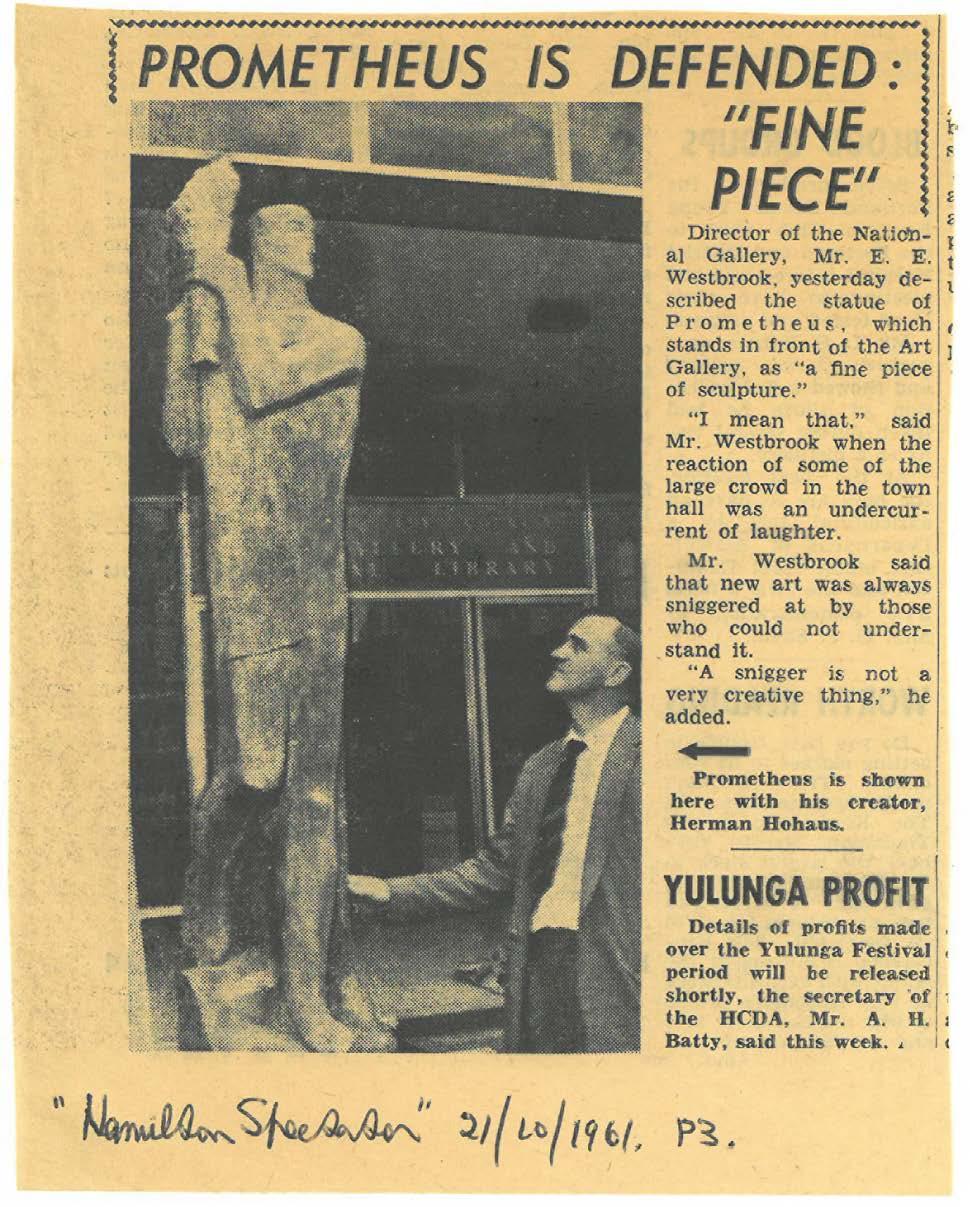
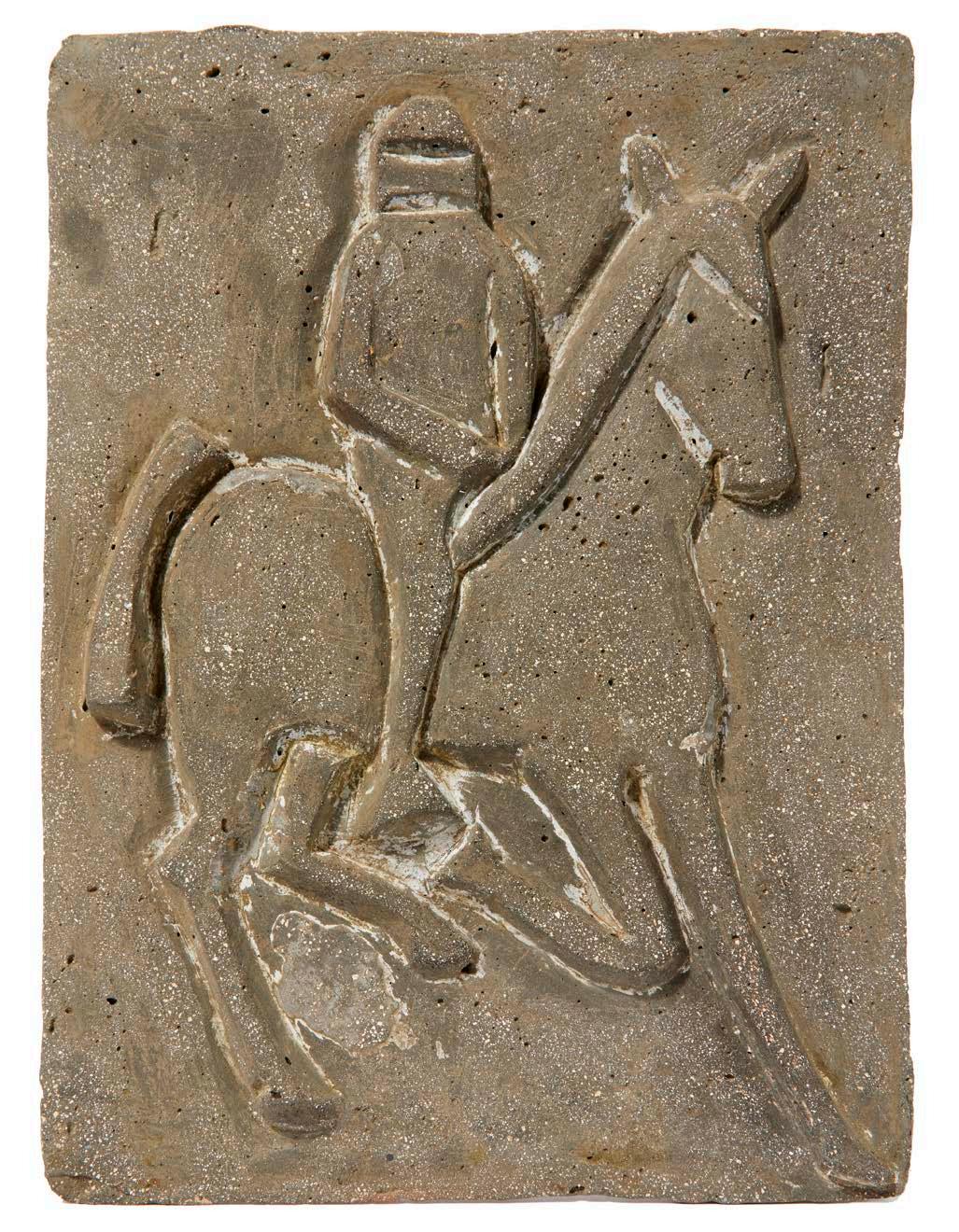
Berliner Inge King (1915–2016) applied to teach at MTC shortly after arriving in Australia, in 1951, but was told she was overqualified. She felt her gender was the true reason she was turned away.38 Instead she enrolled in an art metalwork class, using the facilities to produce jewellery in silver and semiprecious stones to supplement her income. She succeeded sculptor Anita Aarons at the Kew Kindergarten Teachers’ Training College in 1961; for the next fifteen years teaching three-dimensional studies including clay modelling, papier-mâché puppets and masks and even arc welding. In 1975 Jomantas invited her to join the RMIT staff, teaching sculpture one day a week; she remained at RMIT until Jomantas’s retirement in 1987. King was a living example of the sort of tenacity and persistence that Jomantas recommended to his students. Susan Patterson, who studied with King at RMIT, recalled that King ‘gained utmost respect from her students. She brought to her teaching first-hand knowledge and experience of the art world and this was always rich in depth’.39 Patterson described King’s approach to teaching: … she tends to focus on developing qualities in a student that will allow them to feel confident with their work. She does not believe that you can really teach art, rather she sees her role as being a facilitator of the process, teaching techniques, showing examples and being a supportive role model. In the end the student must have the will power and discipline to make art for themselves.40 This approach accorded with her Centre Five colleagues’ belief that art, as a means of self-expression, cannot be taught but that teachers should provide help with techniques and encourage experimentation with different mediums. Teachers should also be inspiring role models. In Parr’s words: ‘A teacher’s enthusiasm is vital. You’ve got to feel personally involved in the art you’re teaching’.41 King, for her part, felt it was a two-way relationship, explaining: ‘I like students because I always feel … if you put something in, you get something back and … young people, they have different ideas and I enjoyed it’.42
In all of the émigré sculptors’ teaching, the thorough
76 MELBOURNE MODERN
Opposite top Maggie Edmond, Horse and Rider, 1964, ciment fondu, 29.5 x 21.5 x 2.5 cm, collection of the artist
Opposite bottom ‘Prometheus is defended: “Fine piece”’, Hamilton Spectator, 21 October 1961, 3. Hermann Hohaus with his public commission, Prometheus, outside the Hamilton Art Gallery, 1961
Left Hermann Hohaus, Girl After Bath (later known as Curved woman, version I), c. 1958, bronze, 16.0 x 6.0 x 4.0 cm, private collection courtesy Australian Galleries
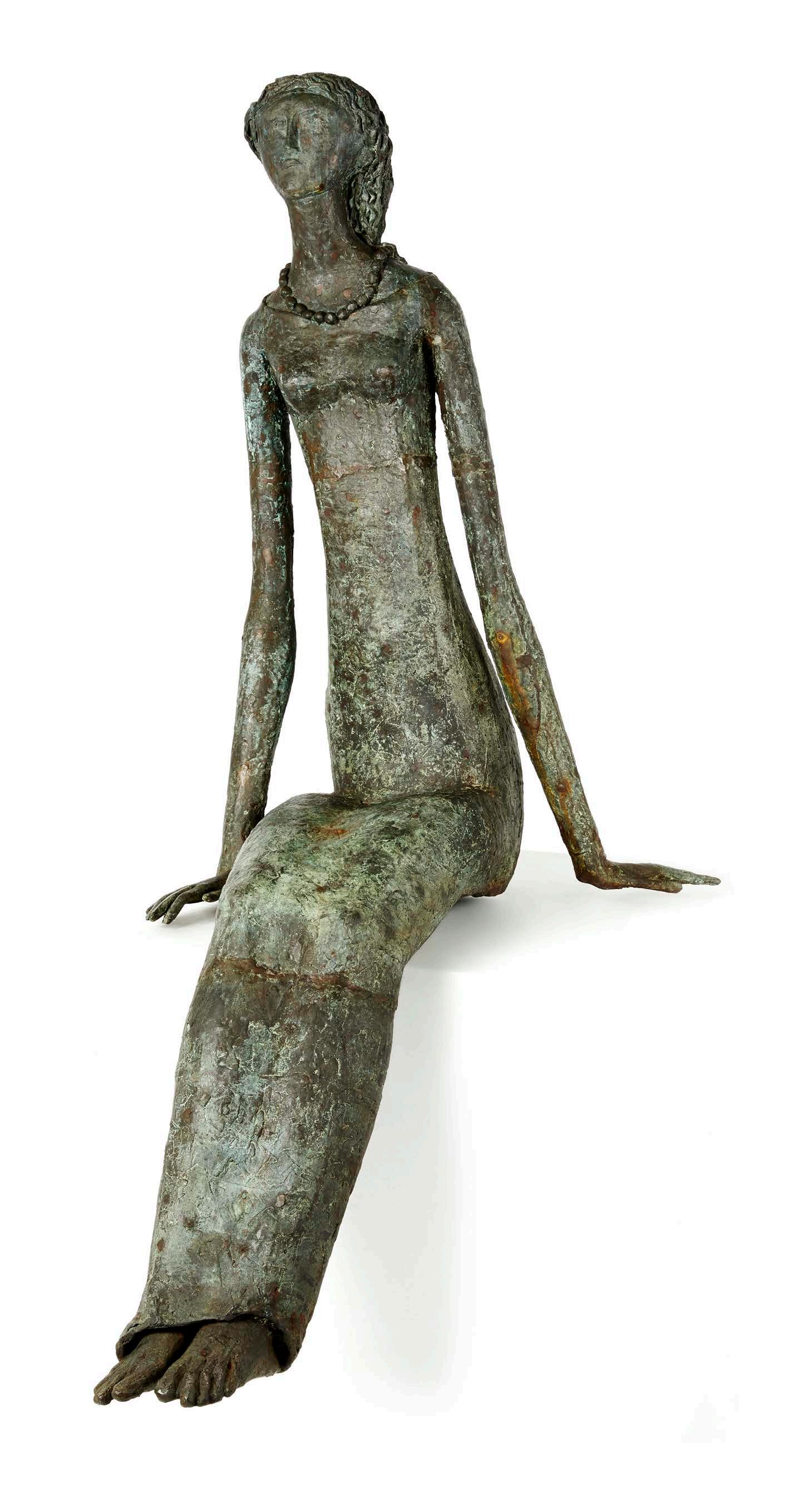
Right Hermann Hohaus, Seated woman, n.d., bronze, 120.0 x 55.0 x 80.0 cm, RMIT Art Collection
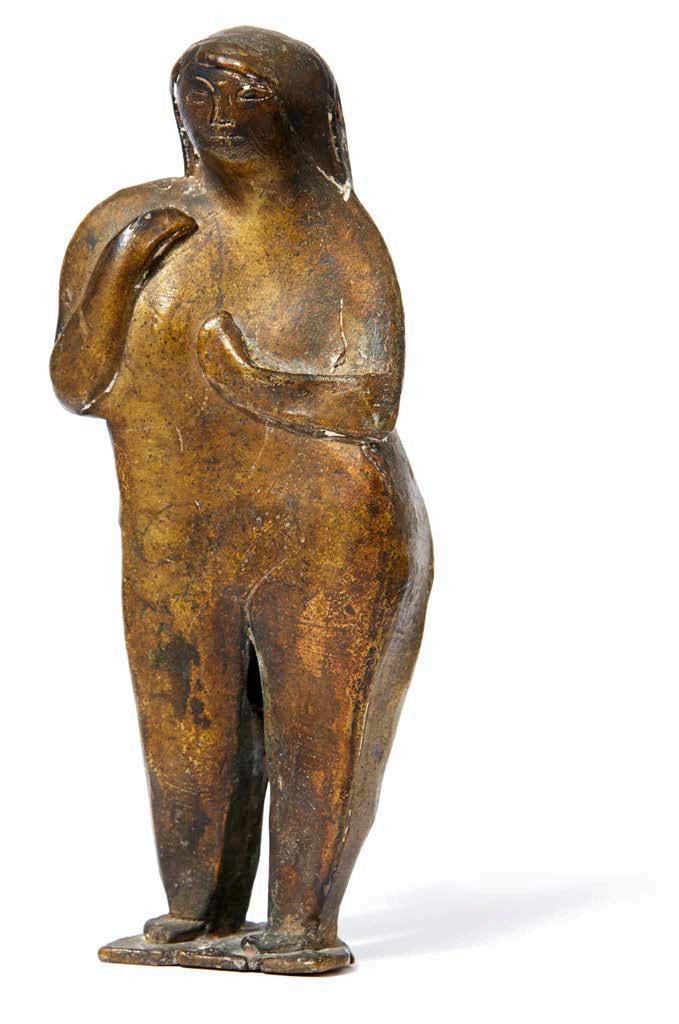
MELBOURNE MODERN 77
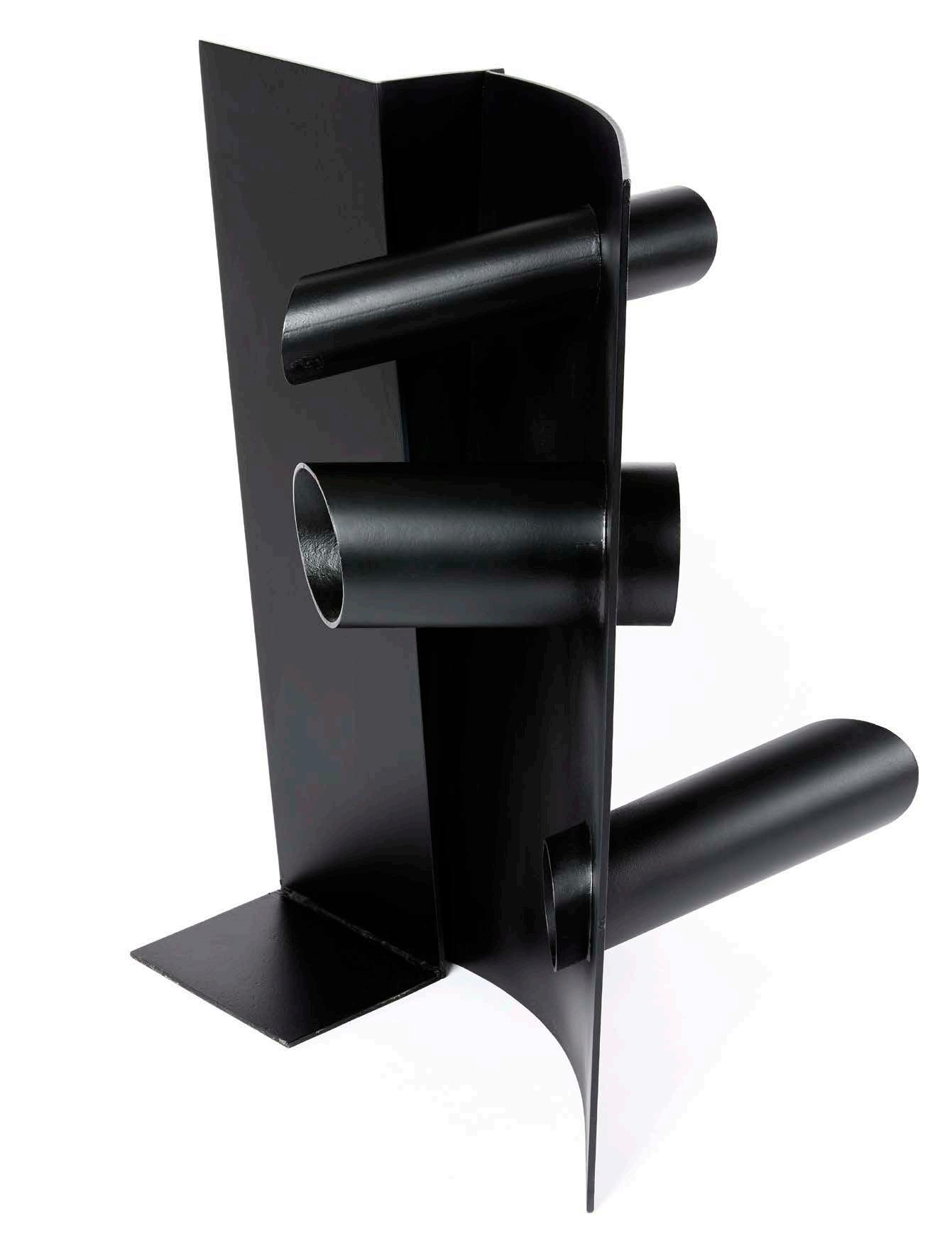
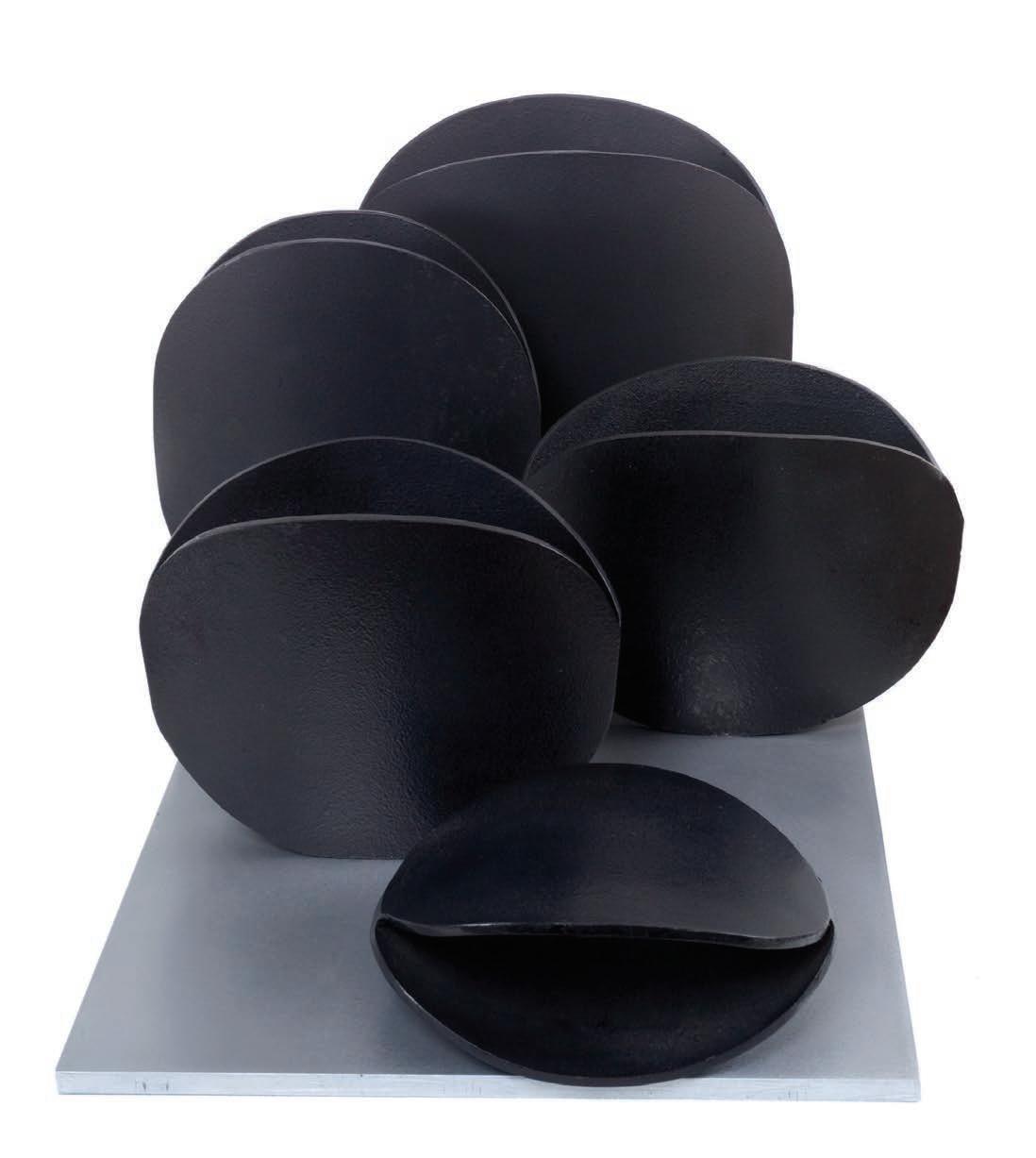
78 MELBOURNE MODERN
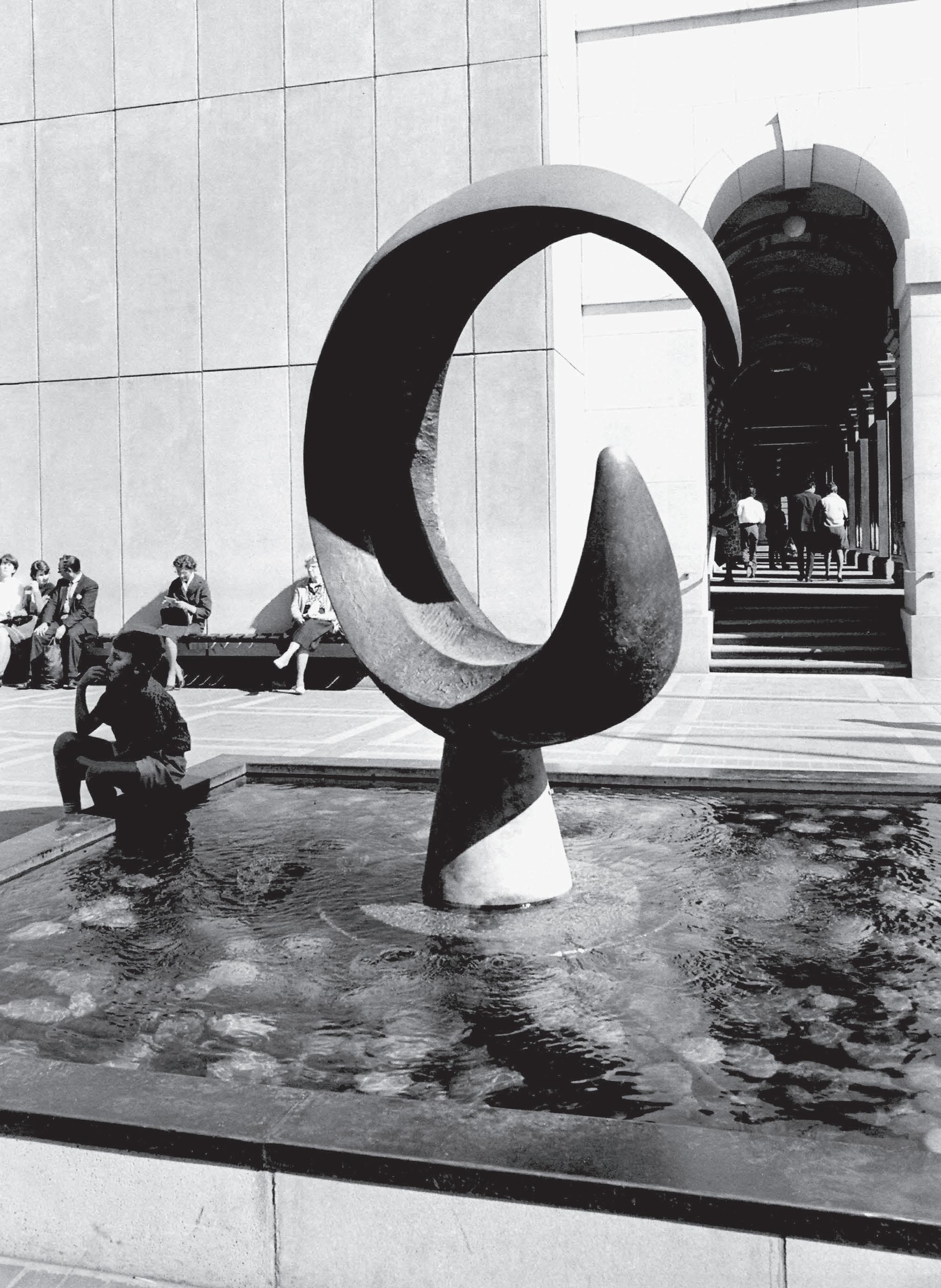
MELBOURNE MODERN 79
Page 78 top
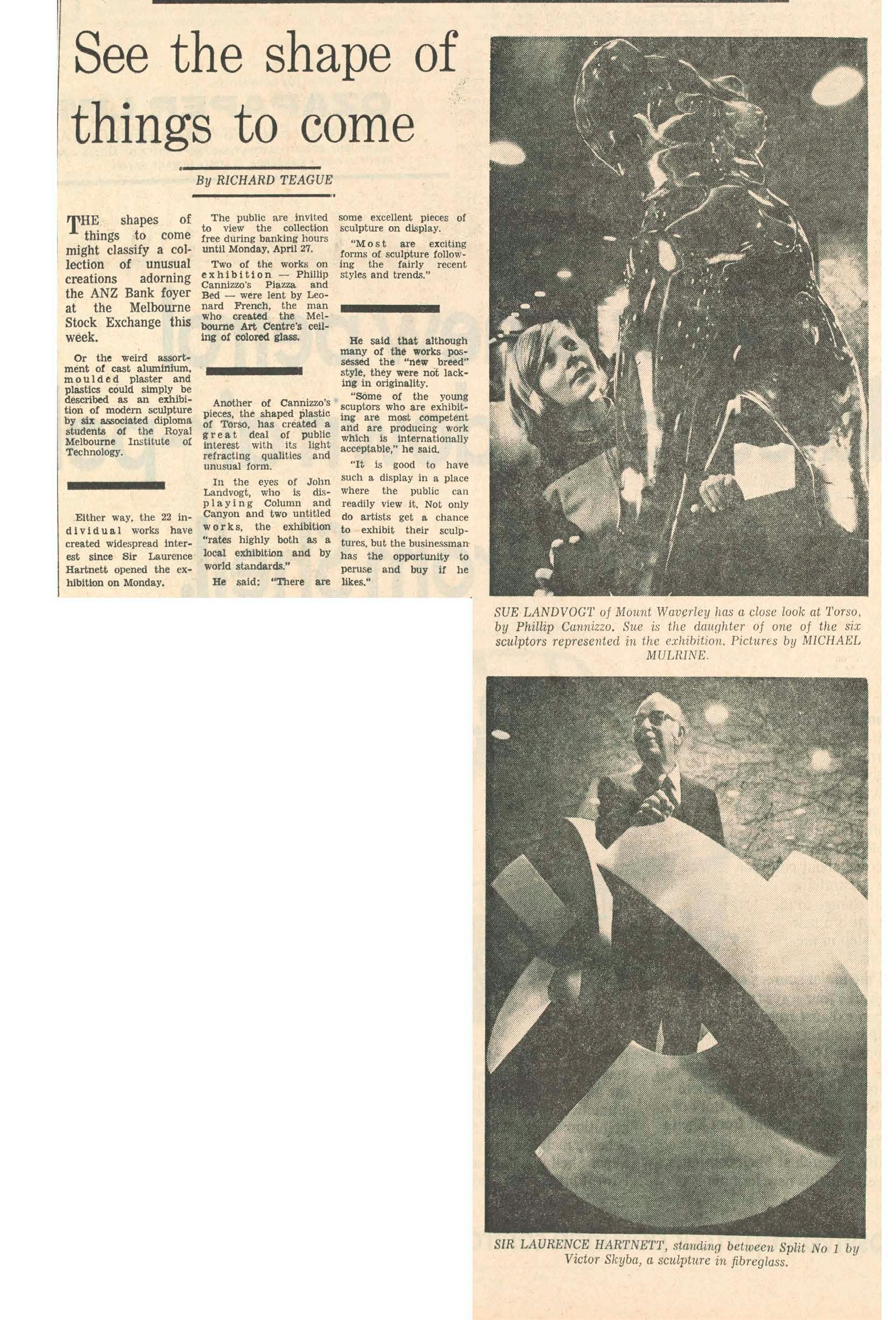
Inge King, Black Wall, 1976, steel painted black, 91.0 x 65.0 x 62.0 cm, estate of Inge King, courtesy Australian Galleries
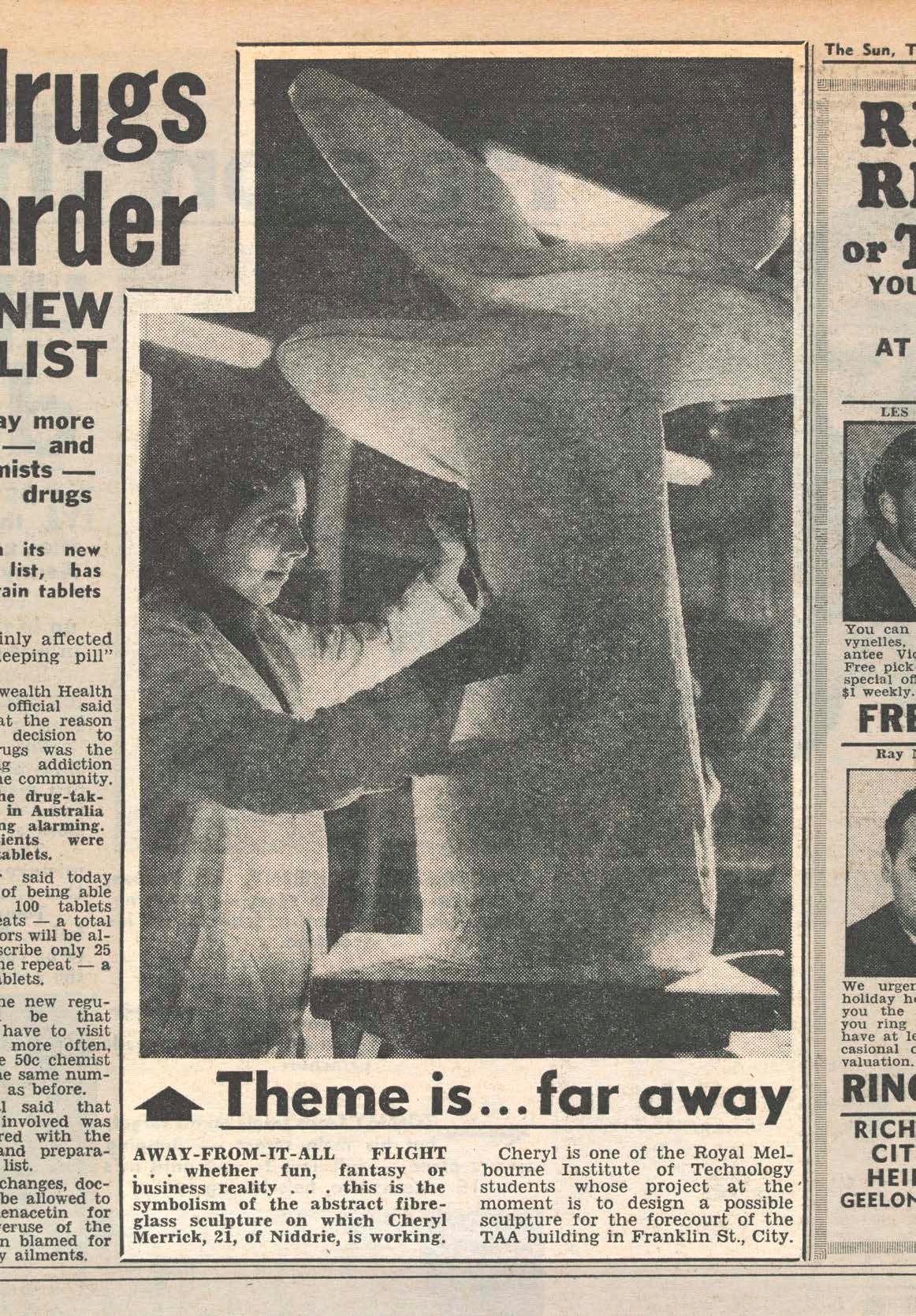
Page 78 bottom
Inge King, Daruma, Maquette for Garden Sculpture, 1978, steel painted black, 28.0 x 35.5 x 69.0 cm, RMIT Art Collection
Page 79
Teisutis Zikaras, GPO Fountain, 1964, bronze, corner of Elizabeth and Little Bourke Streets, Melbourne (now collection McClelland Gallery and Sculpture Park), photograph: Mark Strizic, courtesy Marcus Zikaras
80 MELBOURNE MODERN
Opposite above Sue Landvogt with Phillip Cannizzo’s Torso, in cast aluminium, and Sir Laurence Hartnett with Victor Skyba’s Split No. 1, at a student exhibition in the ANZ Bank foyer, Melbourne Stock Exchange, 1970 (Richard Teague, ‘See the shape of things to come’, The Australian, 22 April 1970)
Opposite below Student Cheryl Merrick with her design in fibreglass for the forecourt of the new TAA Building on Franklin Street, Melbourne (‘Theme is … far away’, The Sun, 1 June 1967, 7)
Right
John Davis, Drop Out, 1968, aluminium, paint, rubber, 28.2 x 12.5 x 33.5 cm, courtesy of Martin Davis, Penelope Davis and ARC One Gallery

understanding of different mediums was paramount. This was reflected in the work produced by students during the Jomantas years. Both staff and students particularly favoured fibreglass and polyester resin and cast aluminium, as evidenced, for instance, when students were challenged to design a sculpture for the forecourt of the new TAA Building in Franklin Street (1967), or when six graduates of sculpture exhibited their recent work in the ANZ Bank foyer at the Melbourne Stock Exchange, in 1970.43 While the subjects differed widely – from the figurative work of Sicilian-born Phillip Cannizzo to the abstract curves of Victor Skyba’s Split No. 1 – the chosen medium reflected recent developments in plastics as taught by Jomantas and his staff. Indeed the student work of John Davis, completed at RMIT between 1963 and 1966, seems to express the range of viable options open to students at that time: from organic carving in native timbers such as jarrah, similar to the work he admired from Centre Five associates Julius Kane and Clifford Last and RMIT alumna Norma Redpath, to totemic arrangements of ‘coloured metal discs’ – presumably in coloured aluminium or painted steel. The downside on this emphasis on materials was that students were discouraged from using any new media that fell beyond the realm of the teaching staff’s expertise, such as holograms or sound.
Indeed the émigré emphasis on materials attracted criticism. In 1964, at the opening of the Mildura Sculpture exhibition, Bernard Smith accused Australian avant-garde sculptors of being overly concerned with material-play: ‘A good deal of Australian sculpture today seems to me to be best described as Bauhaus Vorlehre – Bauhaus first year course: … a free playing and experimenting with materials; a demonstration of an educational philosophy rather than sculpture’. 44 While few would describe the RMIT Art School of the 1960s as modelled along Bauhaus lines, Smith’s accusation leads to the charge of formalism – the preoccupation with formal medium-specific properties rather than subject or context – that has since been laid at many of the émigré sculptors (whether at RMIT or beyond the institution). For instance, critic Bill Hannan detected an element of aloofness in the émigré sculptors’ work, which he ascribed to as ‘a continually dating internationalism,
which, lacking strong local stimulus, tends to become too withdrawn’. 45
During the 1970s the emphasis on materiality and finely crafted objects became increasingly at odds with developments in conceptual art and installation art –sculpture in the expanded field – which Jomantas strongly discouraged. This worried King, who questioned Jomantas: He said ‘I cannot teach it and I know nothing about it’. And I said, ‘well there are other venues they can turn to. You can’t just inhibit them’. He said ‘In my Department it doesn’t exist’, so there he was quite intolerant, but it was mainly based on the conviction that he couldn’t be a judge or couldn’t assess it.46
His stance alienated younger sessional staff members such as Michael Young, who wanted to introduce student collaborative projects.47 Similarly Geoffrey Bartlett’s photographs of his temporary site-specific installations on the coast at Anglesea or on the roof-top terrace outside Margaret Plant’s office at RMIT, which record his interest in defining spatial relationships, baffled Jomantas who was unsure which works to examine as ‘sculpture’ and which as ‘painting’.48 Peter Cripps appreciated the formal design exercises that King set and valued the social dimension to Centre Five’s collaborations with architects, but found the absence of discourse at RMIT about practice frustrating.49 Cripps returned to teach at RMIT in 1989, just one year after Robert Owen joined as Associate Professor and head of sculpture. Both Owen and Cripps represented a radical rejection of the formalism of the Jomantas years.
Nevertheless, the professionialisation of the sculpture course, and the emphasis on the sculptor as a highly skilled professional who could help shape the public sphere by working closely with architects, was a positive legacy of the émigré sculptors, and one which continues to be felt in the present day.
MELBOURNE MODERN 81
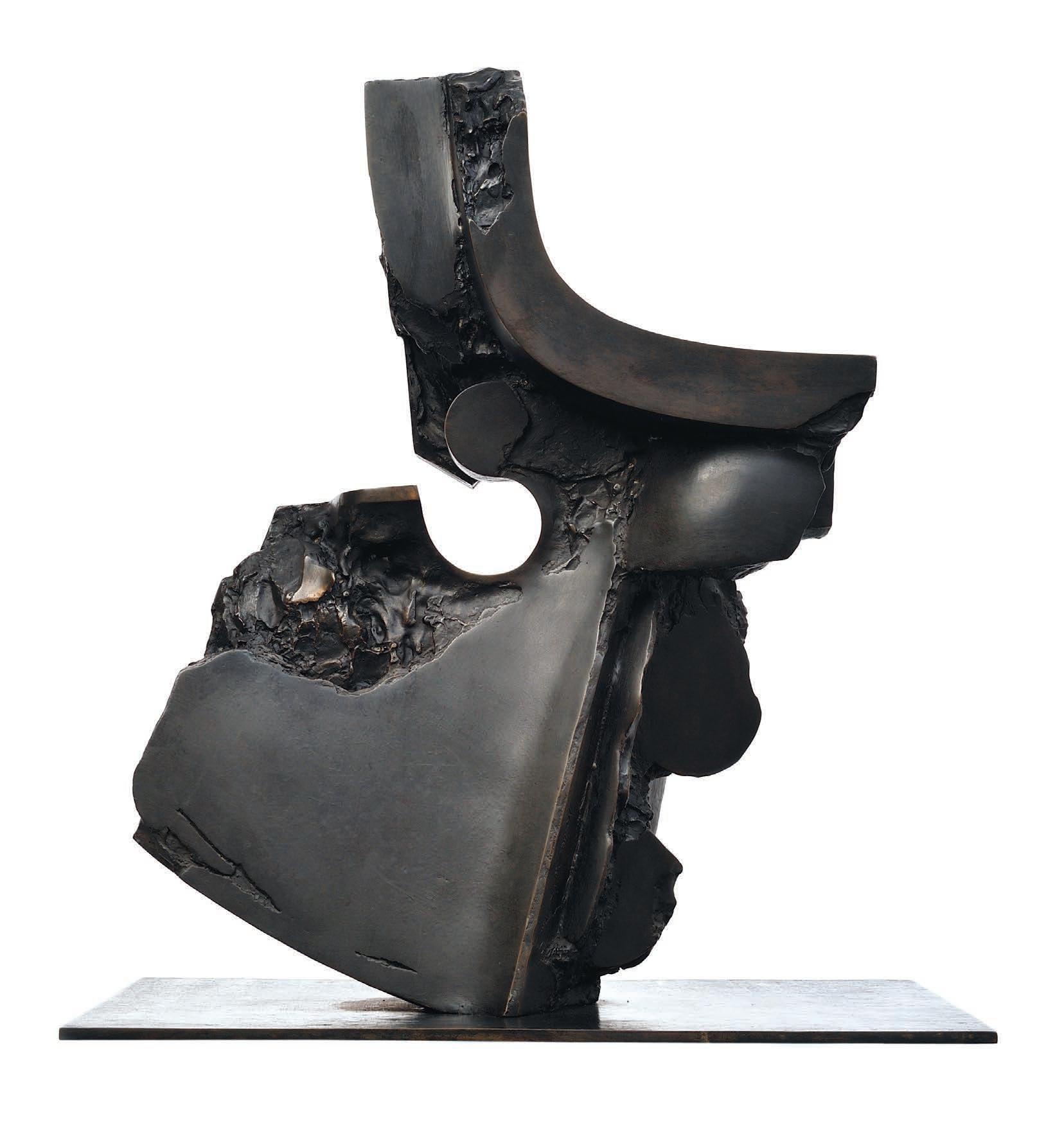

82 MELBOURNE MODERN
Opposite top
Norma Redpath, Key Figure I, 1969, bronze, artist’s proof, 66.0 x 59.0 x 39.0 cm, estate of the artist, courtesy Charles Nodrum Gallery
Opposite below
Norma Redpath, Sleeping Bird, 1949, soapstone, 11.3 x 15.5 x 12.5 cm, Estate of the artist, courtesy Charles Nodrum Gallery
Above left John Davis, The Poet, c. 1963–66, pen and black ink with black wash on paper, two sheets, (a) 38.0 x 25.0 cm (b) 31.0 x 21.0 cm, estate of the artist
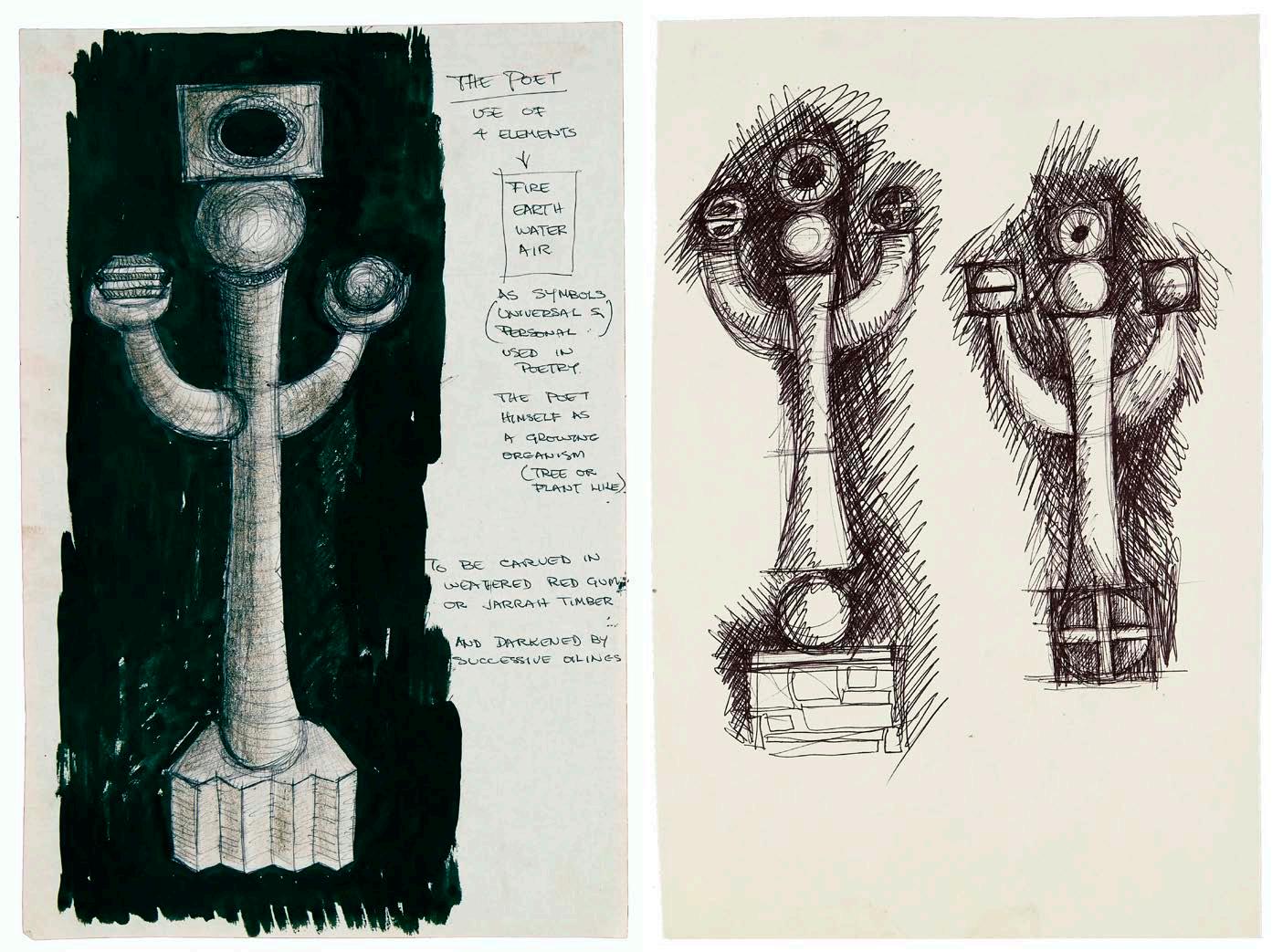


Above right John Davis, Metal discs: fire, air, water and earth, c. 1963–66, brush and ink over pencil with biro annotation on paper, 30.0 x 21.0 cm, estate of the artist
Lower left
John Davis, Wall relief (study for a jarrah carving), 1966, pen and black ink with wash on paper, 28.0 x 39.0 cm, estate of the artist
Lower right John Davis carving a work in timber in his back-yard in Melbourne, c. 1963–66, photographer unknown, courtesy the artist’s family

MELBOURNE MODERN 83
1 Jan Senbergs, ‘Meetings with Jomantas’, single page of typescript, unpublished, distributed at the launch of the book, Vincas Jomantas, Sculptor, at RMIT Gallery, 31 May 2018.
2 Parr studied at MTC 1951-54 before working as an assistant to Henry Moore in England 1955-56. He returned to Melbourne in January 1957 to undertake teaching training at RMTC while also teaching sculpture there part-time. His name first appears in the RMTC Calendar of 1959, as ‘Assistant lecturer, sculpture’; in 1961 this becomes ‘Lecturer, sculpture’ (RMIT Calendar, 1961, 20) and ‘Senior lecturer, sculpture’ in 1965, after which he left to become head of Art Division at Prahran Technical College. He is not listed as head of sculpture in any of the RMIT Calendars though his monograph states he held this position 1964-66 (Lenton Parr: Vital Presences, Sydney: Beagle Press, 1999, 34). Many, including Kevin Mortensen, also recall Parr as being head of sculpture (Mortensen studied at RMIT 1962-65, see his interview with Deborah Edwards, 16 February 2017, Sydney: Art Gallery of New South Wales Archive, Balnaves Foundation Australian Sculpture Archive Project, online transcript, URL: https://www.artgallery.nsw.gov.au/research/ archives/interviews/#mortensen).
3 Zikaras joined MTC in 1956 as an evening instructor; by 1957 he was a part-time day instructor, and in 1958 he was appointed to full-time staff (RMIT Archives, Bundoora, Zikaras file, biographic note). His name first appears in the RMIT Calendar in 1961 as ‘Lecturer, General Art’; in the 1967 Calendar this changed to ‘Lecturer, Sculpture’.
4 Allen designed the memorial while Hammond oversaw its enlargement and realization. Zikaras was one of three assistants to work under Hammond on the project and did most of the final finishing and surface treatment. Ken Scarlett suggests Zikaras may have also assisted Hammond on the four sandstone lions commissioned for the South African (Boer) War Memorial, Melbourne, in 1952 (Teisutis Zikaras: Sculptures and Drawings, Langwarrin, Vic: McClelland Gallery and Sculpture Park, 2009, 4).
5 For more on Kašuba and Mikėnas see Jane Eckett, Centre Five sculptors: the formation of an alternative professional avant-garde, PhD thesis, University of Melbourne, 2016, 85-90, 159-68.
6 The distinguished Oxford-educated Berlin philosopher and collector of sculpture Werner David Falk opened Zikaras’s 1955 exhibition – a mark of both Zikaras’s repute and his excellent connections within the émigré community.
7 Hazel de Berg, Teisutis Zikaras interviewed by Hazel de Berg, 15 minute audio and typed transcript, Canberra: National Library of Australia, DeB 161, 3 December 1965.
8 Teisutis Zikaras interviewed by Hazel de Berg, 3 December 1965.
9 Interview with Geoffrey Bartlett, University of Melbourne, 10 April 2019, and telephone interview with Don Gore, 19 April 2019.
10 Barbara Blackman, Interview with Vincas Jomantas, Canberra: National Library of Australia, Oral History Department, Oral TRC 1603, 15 and 20 March 1984, tape 3, side 2.
11 For further on Vincas Jomantas’s background see Jane Eckett, ‘Vincas Jomantas: Kaunas, Vilnius, Munich’, in Robert Lindsay and Ken Scarlett, Vincas Jomantas, Sculptor, Sydney: Beagle Press, 2018, 154-56.
12 Blackman, Interview with Vincas Jomantas, 1984, tape 4, side 1.
13 Maudie Palmer, Centre Five at Heide Park and Art Gallery, Bulleen, Vic.: Heide Park and Art Gallery, 27 October - 9 December 1984, 3.
14 Blackman, Interview with Vincas Jomantas, 1984, tape 4, side 1; RMIT Calendar, 1962, 19.
15 RMIT Calendar, 1967, 180; RMIT Calendar, 1974, 186. Senior lecturers were heads of their respective program, reporting to the head of the Department of Fine Art, Lindsay Edward, and, above him, the head of School, Colin Barrie.
16 Interview with Geoffrey Bartlett, University of Melbourne, 10 April 2019.
17 Anton Hasell, Roundtable discussion of the Jomantas years at RMIT, 25 September 2003, unpublished typescript, RMIT Gallery, 8.
18 Vincas Jomantas in interview with Noel Hawken, ‘What sculptors need is trust’, The Herald, Melbourne, weekend magazine, 27 May 1967.
19 Interview with Geoffrey Bartlett, University of Melbourne, 10 April 2019.
20 As recalled by Inge King, Roundtable discussion of the Jomantas years at RMIT, 25 September 2003, unpublished typescript, RMIT Gallery, 3. Mortensen studied sculpture at RMIT 1962-66 and returned to teach drawing and sculpture part-time 1975-83.
21 Blackman, Interview with Vincas Jomantas, 1984, tape 4, side 2.
22 Neale Kenny and Penelope Lee, Roundtable discussion of the Jomantas years at RMIT, 25 September 2003, unpublished typescript, RMIT Gallery, 16.
23 Interview with Peter Cripps, RMIT, 2 August 2017.
24 Telephone interview with Don Gore, 19 April 2019.
25 James Gleeson, Interview with Vincas Jomantas, taped interview and a 24-page transcript, James Gleeson Oral History Collection, Canberra: National Gallery of Australia library, 15 October 1979.
26 Interview with Geoffrey Bartlett, University of Melbourne, 10 April 2019.
27 Telephone interview with Don Gore, 19 April 2019.
84 MELBOURNE MODERN ENDNOTES
28 Lenton Parr, Vincas Jomantas: Sculpture 1962–1982, Melbourne: RMIT Gallery, 1982, n.p.
29 Hermann Hohaus, Sculpture, Melbourne: published by the author, c. 1970, unpaginated.
30 RMIT Calendar, 1964, 19.
31 Incoming passenger list to Fremantle, ‘Fairsea’, arrived 5 January 1954, Perth: National Archives of Australia, series K269, 5 Jan 1954 Fairsea.
32 Hohaus, Sculpture, c. 1970.
33 Ibid.
34 Bryan Poynton interviewed by Jesse Adams Stein, Lorne, Vic., 22 February 2018, Reshaping Australian Manufacturing Oral History Project, Canberra: National Library of Australia, URL: http://nla. gov.au/nla.obj-617774615/listen?searchTerm=herman%20hohaus (accessed 23 April 2019).
35 Interview with Peter Cripps, RMIT, 2 August 2017.
36 Ernesto Murgo in interview with Eila Ahvenainen, ‘Migrant Case Book: Sculptor carves out a new life’, The Age, 2 March 1971, 16.
37 ‘Finishing touches’, The Age, 1 August 1969, 11; Vincent Basile, ‘Steeple goes to church’, The Age, 3 July 1970, 4.
38 Interview with Inge King, Warrandyte, Vic., 2 September 2010.
39 Susan Patterson, ‘Inge King: sculptor and art educator’, Australian Art Education, vol. 17, no. 2, Autumn 1994, 29.
40 Patterson, ‘Inge King: sculptor and art educator’, 1994, 32.
41 Lenton Parr quoted in ‘Self expression for students’, The Sun, Melbourne, 3 February 1966.
42 Interview with Inge King, Warrandyte, Vic., 3 September 2009.
43 ‘Theme is … far away’, The Sun, 1 June 1967, 7; Richard Teague, ‘See the shape of things to come’, The Australian, 22 April 1970.
44 Bernard Smith, ‘Address at opening of the Mildura Sculpture Exhibition, Mildura Art Gallery’, 18 April 1964, in Sheridan Palmer and Rex Butler (eds), Antipodean Perspective: Selected writings of Bernard Smith, Clayton, Vic.: Monash University Publishing, 2018, 140-42.
45 Hannan’s comments were made in the context of the European sculptors represented in the touring exhibition Recent Australian Sculpture, in which Hohaus, Jomantas, King and Zikaras each participated, but they resonate with the views of some of their former students; see Bill Hannan, ‘Sculptors: Good Second-raters?’, The Bulletin, 13 November 1965, 40.
46 Inge King, Roundtable discussion of the Jomantas years at RMIT, 25 September 2003, unpublished typescript, RMIT Gallery, 5.
47 Email from Michael Young, 31 October 2017. Young taught sculpture part-time from 1974 to 1984.
48 Interview with Geoffrey Bartlett, University of Melbourne, 10 April 2019.
49 Interview with Peter Cripps, RMIT, 2 August 2017.
MELBOURNE MODERN 85
6 printmaking
AT THE ART SCHOOL OF MELBOURNE TECHNICAL COLLEGE 1948–1965 VICTORIA PERIN

Opposite
Hertha Kluge-Pott, Forest, 1987 (detail), drypoint and etching, printed in black ink with plate-tone, from one plate, on Arches paper, edition of 12, image: 50.4 x 100.4 cm, sheet: 64.6 x 111.4 cm, collection of the artist
I started the printmaking. The whole of the printmaking in Victoria in all the schools emanated because we started printmaking in [my] second year under Harold Brown. We started at the back of the weaving room and I had two machines that I went and found. We had one in the school which I remember we had as a student and we had an etching press that John [Shirlow] had taught me to do etching [on]. I started with them and started with printmaking. I had day students and it developed within three or four years.1
These are the words of Harold Freedman, the JewishAustralian artist and educator who instigated printmaking in the Art School of MTC. Freedman’s unequivocal boast, ‘I started the printmaking’, is supported by other artists, such as Kenneth Jack:
There is absolutely no doubt that Harold Freedman (and no other person at all, as has been said in other accounts) was responsible for the initiation of a great forward movement in printmaking in Australian art.2
Their claims have validity. Freedman was employed from 1947 as Instructor in Painting and Illustration to assist with the influx of the ex-military students who began pouring into Melbourne Tech under the Australian Government’s Commonwealth Reconstruction Training Scheme.3 Freedman offered printmaking to art students from 1948, and in that year his title changed to Instructor in Painting and Graphics.4
On the 3rd of June 1952 Freedman opened a different class.5 This class was held out-of-hours on Tuesday evenings, it was invite-only, and Tech students were not permitted to attend. From this class, which continued for about five years, flowed a succession of artists and teachers who influenced and infiltrated Melbourne’s art schools and technical colleges, until printmaking was taught to most of Melbourne’s fine art students from the mid-1960s. Between 1948, when Freedman began teaching printmaking at MTC, to 1965, the date that the National Gallery School began teaching printmaking, a great passion for printmaking had blossomed in the wider Melbourne art community. With great passions, however, come great rivalries.
The stridence of Freedman and Jack (his former pupil and friend) has its roots in an open and documented rift.
Freedman and his allies were clearly trying to claim credit for the post-war print renaissance in Melbourne, and they felt it necessary to do so because credit had been given to others. These others can be broadly summarised as the Melbourne Tech’s European contingent.
Post-war printmaking at the Tech, and in Australia generally, has been understood as a coming of the European émigrés. Take Daniel Thomas’ 1963 assessment that it was the presence of ‘new skills from Paris, London or Germany which helped the existing occasional practitioners coalesce’.6 Irish émigré Tate Adams attended Freedman’s artists’ class from its earliest days and would later go on to lead the printmaking room at RMIT from 1960 to 1981. Also in attendance during the 1950s (as either students or teachers) were Guenter Stein (later Bill Stevens) from Germany, Eva Kubbos (Lithuania), Edwin Tanner (England), Roy Bizley (England) and George Baldessin (Italy).7 In the 1960s European-born artists working in the RMIT print room included Udo Sellbach (Germany), Hertha Kluge-Pott (Germany), Asher Bilu (Israel), Jan Senbergs (Latvia), Bruno Leti (Italy) and Paul Partos (Czechoslovakia).
If we are intending to map both the oceans and the isthmuses in MTC’s post-war printmaking community, it is necessary to pause on what exactly counts as foreign ‘influence’. European migration was augmented by a succession of returned expatriates who had studied printmaking in London or on the continent and came back to practice printmaking at the Tech as invited guests at the Tuesday evening classes. These expatriates include Ian Armstrong, Rod Clarke, John Courier, Robert Grieve, Franz Kempf, Grahame King, Lesbia Thorpe and Fred Williams.8 Other important figures, such as Charles Blackman, Leonard French, Erica McGilchrist and Ken Whisson, joined the print workroom in the 1950s and made notable prints, before leaving for working trips to Europe. Some MTC painting students in the same decade, such as Normana Wight and Murray Walker, could not be said to have made important prints there, but returned after excursions to Europe to become printmaking instructors at Preston Institute of Technology and the National Gallery School respectively. Arthur Boyd, the Indian-born artist Allen David, and Polish-
MELBOURNE MODERN 87
PRINTMAKING
Opposite Tate Adams, Clown, 1962, linocut printed in colour inks from five blocks, 4/50, image: 76.2 x 51.0 cm, sheet: 88.4 x 63.8 cm, National Gallery of Victoria
born Stanislaw (Stacha) Halpern visited the print class briefly, but they made their significant prints later, working with master-printers in Europe.
Did Australian artists have to be European-born, have parents from Europe, be trained in Europe, or just visit Europe to have received European influence? Was internationalist enthusiasm enough? There are printmakers in Melbourne Modern (such as Jock Clutterbuck and Fran van Riemsdyk) who are Australian-born but were taught by émigrés and can be said to have received their amorphous ‘European influence’ in a sort of generational cascade.9 As Rex Butler and A.D.S. Donaldson have observed, this kind of internationalist disarray is ‘simply what Australian artists do’.10 European print traditions flowed into the Tech from many and varied tributaries.11
This overwhelming narrative of émigré and expatriate print skills flooding post-war Melbourne did not go unnoticed by the ‘local’ printmakers who had largely neither arrived in, nor returned to, Australia. Established locals such as Harry Rosengrave, Barbara Brash, Kenneth Jack, William (Bill) Gleeson, and Christine Aldor (née Miller) were some of the most enthusiastic local member of Freedman’s class, and the majority of active participants were drawn from their network based in George Bell’s private art classes in Toorak. Although they had varying backgrounds and experiences (and some did travel in Europe) they have been remembered for their immersion in local, rather than international, print experience. As well as Rosengrave, Brash, Jack, Gleeson and Aldor, this group include figures like Geoff and Jenny Barwell, Lesley Clarke (née Lawson), Nancy Clifton, Florence Higgs, Verdon Morcom, Frank Pinchin, and Edith Wall.12 Stalwarts of this group would become critical of a curatorial preference for the work of European-born printmakers and worldly expatriates and they explicitly attempted to counter this internationalisation of the history of printmaking in Melbourne.
The narrative these protesting artists wished to preserve was, naturally, one that presented their activity as both early and significant; they wrote as much to curators and editors intermittently from the early 1960s to the late 1970s. However, while he may have been an important
organisational figure, Freedman’s actual artistic influence was negligible, and the vocal members of this cohort were wrong to position him at the head of Melbourne’s printmaking boom. Their stridence was a sign of their fading position within the wider Melbourne art community. Similarly, some also saw fit to denigrate the labours of Freedman’s subordinate, Geoff Barwell.13 Barwell, a volatile figure, nevertheless did much of the hands-on work to organise, promote and instruct the invited artists’ evening print class.14 The vibrancy of post-war printmaking at Melbourne Tech did instigate the Melbourne print boom, but it was a vibrancy born of conflict between these local voices and those who had first-hand experience of international aesthetic practices.
There is no shortage of hostility in some of the ‘Melbournists’ retrospective remarks. They constantly took pains to stress that their local activity was enough, that what was being made in Melbourne was both independent and independently good:
[Harry Rosengrave] is critical of what he sees as an overemphasis being laid on the importance to the Group of influences of artists returning from abroad. In his view, the resources of equipment and technical instruction, available through membership of [Freedman’s] Group, were elements vital to the later progress of returning artists themselves. He makes the point that “. . . history tends to prove that talent, creativity and intellect continually leave Australia for the older origins of our civili[s]ation overseas, rather than drifting in here on the tide”.15
But of course, no art community is an island. One may wonder, if not from across the seas, then from what local source did these artists learn printmaking? In claiming a type of amateur self-sufficiency these artists emphasised their private study of significant technical printmaking handbooks published in Paris, London and New York.16 Paradoxically this form of ‘self-education’ allowed them to both refute ‘the Group’s isolation from overseas developments’ while at the same time claim independence from the modern printmaking knowledge imported by returning expatriates (exemplified by Fred Williams) and émigrés (particularly Tate Adams).17
88 MELBOURNE MODERN
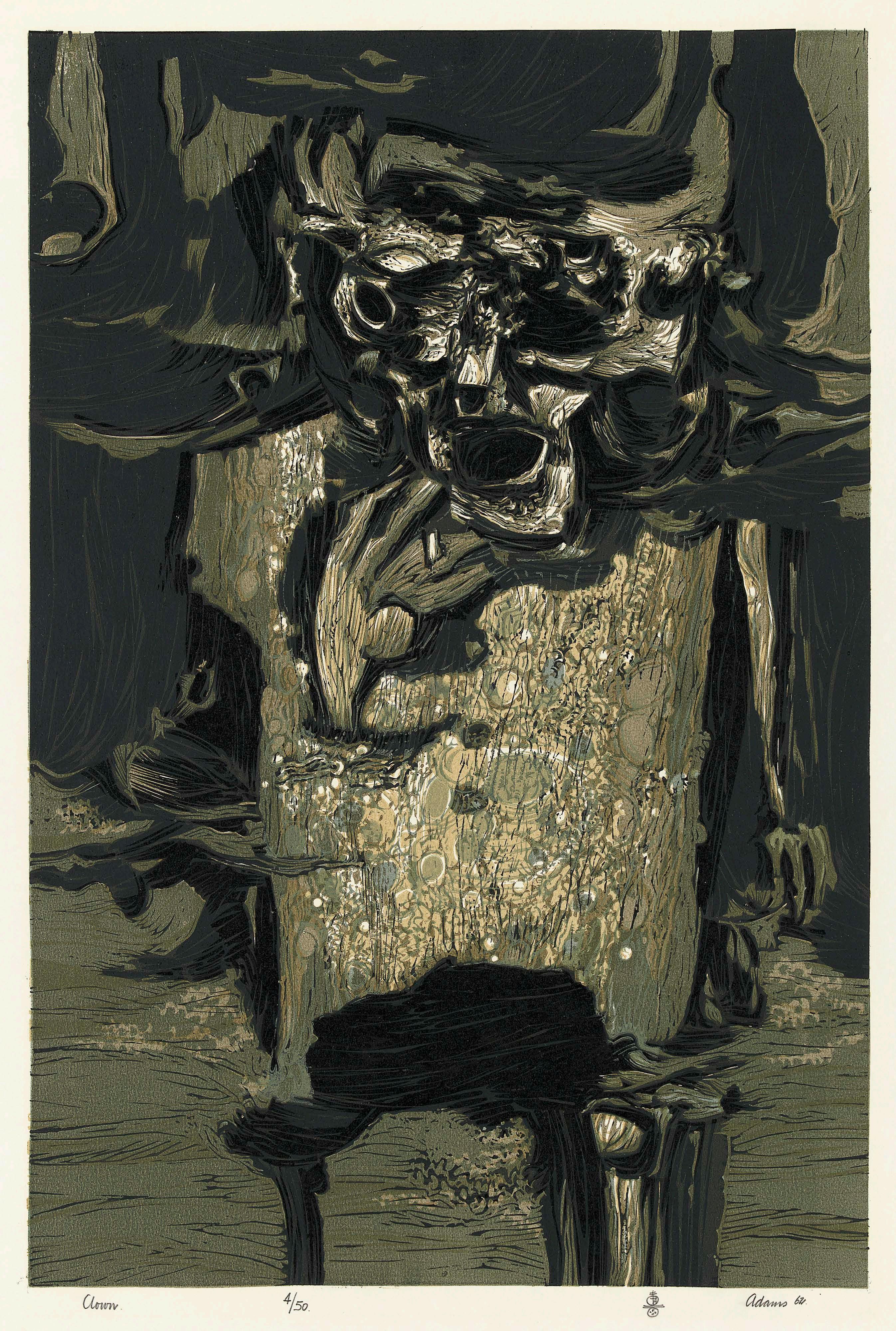
MELBOURNE MODERN 89
PRINTMAKING
Opposite Tate Adams, Bartley’s Body (illustration to Riders to the Sea by J.M. Synge), 1962, linocut printed in colour inks, trial proof, 1/7, image: 56.0 x 42.0 cm, private collection
When Adams arrived in Australia in October 1951, he had one name to look up in the Melbourne art community: Leonard French.18 French was involved in Freedman’s club through his employment at the Tech from 1952 (before his transfer to the Melbourne School of Printing and Graphic Arts in 1954).19 Adams’ inclusion in the print club alleviated an intense culture shock he experienced on arrival: Melbourne was just a large country town, and very conservative. Six o’clock closing, everything closed weekends except for the footie. [S]hort back and sides haircuts and baggy Fletcher Jones pants were de rigueur men’s dressing . . . I mean, how could anyone dressed in similar fashion to Bob Menzies be remotely described as trendy? For what movers and shakers there were, Mario[’]s Italian restaurant in Exhibition Street was the in place to go. And being daring enough to order a bottle of sparkling burgundy was really living in the fast lane.20 For these socio-cultural reason, Freedman’s class was thrilling: … when RMIT started its evening classes in printmaking it was, to say the least, quite an event. I can’t convey to you the atmosphere in the print room on those evenings, or the enthusiasm with which we worked. The place was alive with activity and regulars like Len French, Charlie Blackman, Barbara Brash, Ken[neth] Jack, Harry Rosengrave and me never missing a class.21
Adams speaks of a twinned boredom and excitement in early 1950s Melbourne; how isolated pockets of the arts were a refuge amongst a culture that was sorely lacking in sophistication.
At the Tech Adams stumbled upon a budding art community in which his qualifications were exceptional. Before World War II he had worked as a designer for the Belfast textile engineers Carson & Robinson and in 1942 had taught himself wood engraving.22 After the war Adams studied wood engraving with Gertrude Hermes in night classes at the Central School of Art in London between early 1947 and February 1950.23 People at the Tech noticed Adams’ experience. When Victor Greenhalgh became head of the Art School in 1955, he tapped Adams on the shoulder to establish a brand-new Printmaking Diploma course for the Tech. This Adams did a few years later in 1960, after
studying for a Diploma in Illustration and completing a two-year sojourn back to London and Dublin.
Adams’ vision of printmaking, informed by both commercial and fine art printmaking in Belfast and London, triumphed at RMIT. Once Adams established the new Print Department, he continued the informal artists’ class, renaming it ‘Studio One’ (perhaps to align with named ateliers across Europe and America). Soon after he developed the most ambitious non-institutional group exhibition of printmakers ever seen in Australia. The exhibition, Prints ’63, took advantage of printmaking’s duplicate nature and was intended to simultaneously open in multiple locations across Australia: the NGV, Newcastle City Art Gallery, Castlemaine Art Gallery, the Rudy Komon Gallery in Sydney, Douglas Gallery in Brisbane and Skinner Galleries in Perth. The works were then shipped to the Yoseido Gallery, a print gallery in Tokyo specialising in Japanese modernist prints (sōsaku-hanga).24 Adams’ experience organising print exhibitions in the early 1960s led him to opening Melbourne’s first commercial art gallery dedicated to prints, The Crossley Gallery, on 5 July 1966.
Prints ’63 signalled a new ambition for printmaking at RMIT, and accordingly it championed a new line-up of professional printmakers. Although Barbara Brash continued using the presses at Studio One, almost all the other local artists associated with Freedman’s class were gradually excluded from RMIT. Adams displayed a preference for trained – particularly European-trained – printmakers; other than Adams and Brash, Prints ’63 included London- and Paris-trained Janet Dawson, London-trained Grahame King and Fred Williams, and Latvian-born Jan Senbergs (who, despite his young age of 24, had by then already finished a five-year commercial screenprinting apprenticeship in Melbourne).25 Adams did include one of his own students, Hertha Kluge-Pott, however she had already completed a Diploma in Art (with majors in both painting and printmaking) at one of the most prestigious art schools in Germany: the Hochschule für Bildenden Kūnste (now Universität der Künste), Berlin.26 In his first few years at RMIT, Adams distinctly broke the Art School’s earlier association with inexperienced printmakers and amateur print aesthetics
90 MELBOURNE MODERN
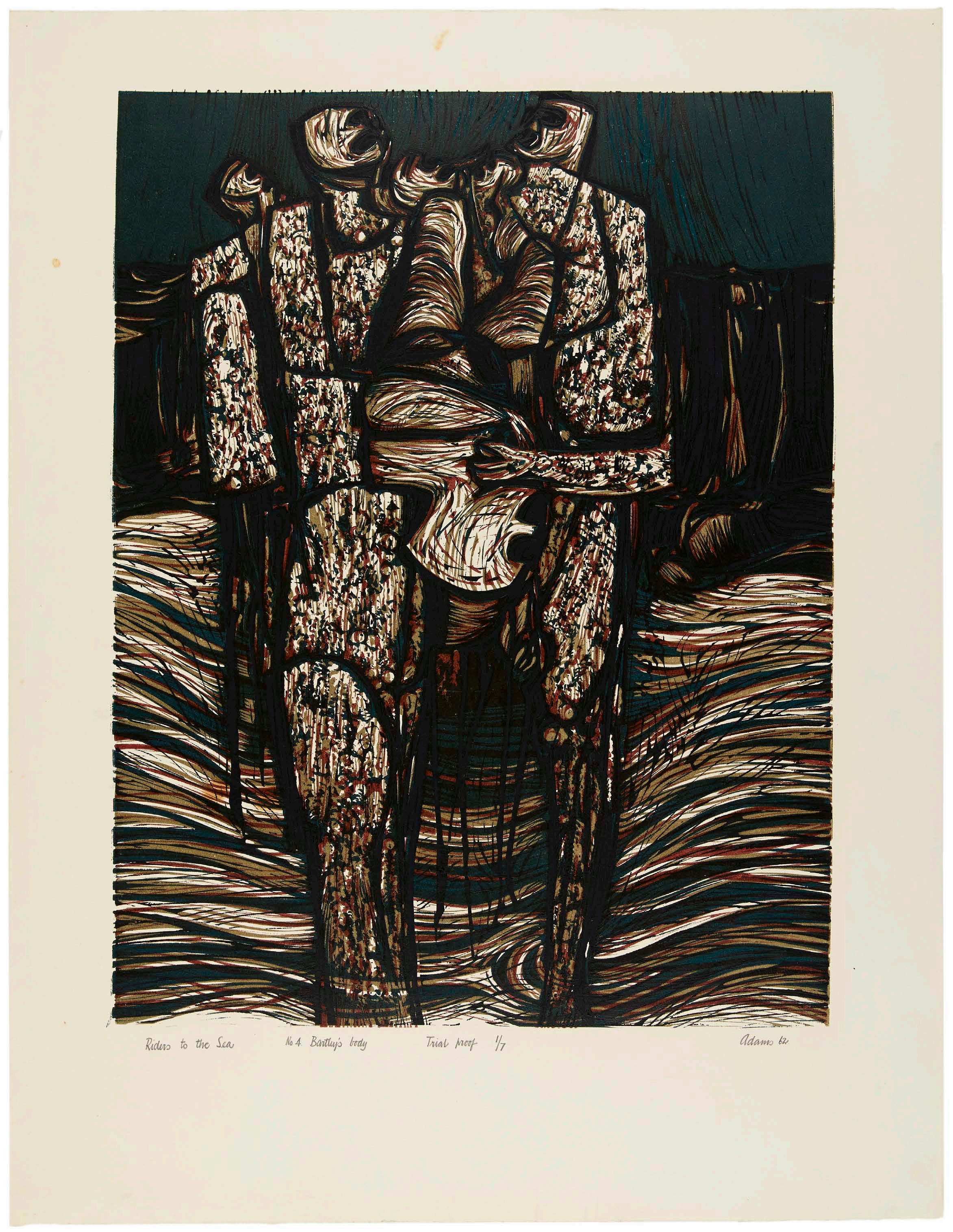
Above left Grahame King, Crater, 1963, lithograph in colours, printed from four plates, edition 8/24, image: 63.5 x 42.0 cm, sheet: 71.4 x 49.0 cm, private collection
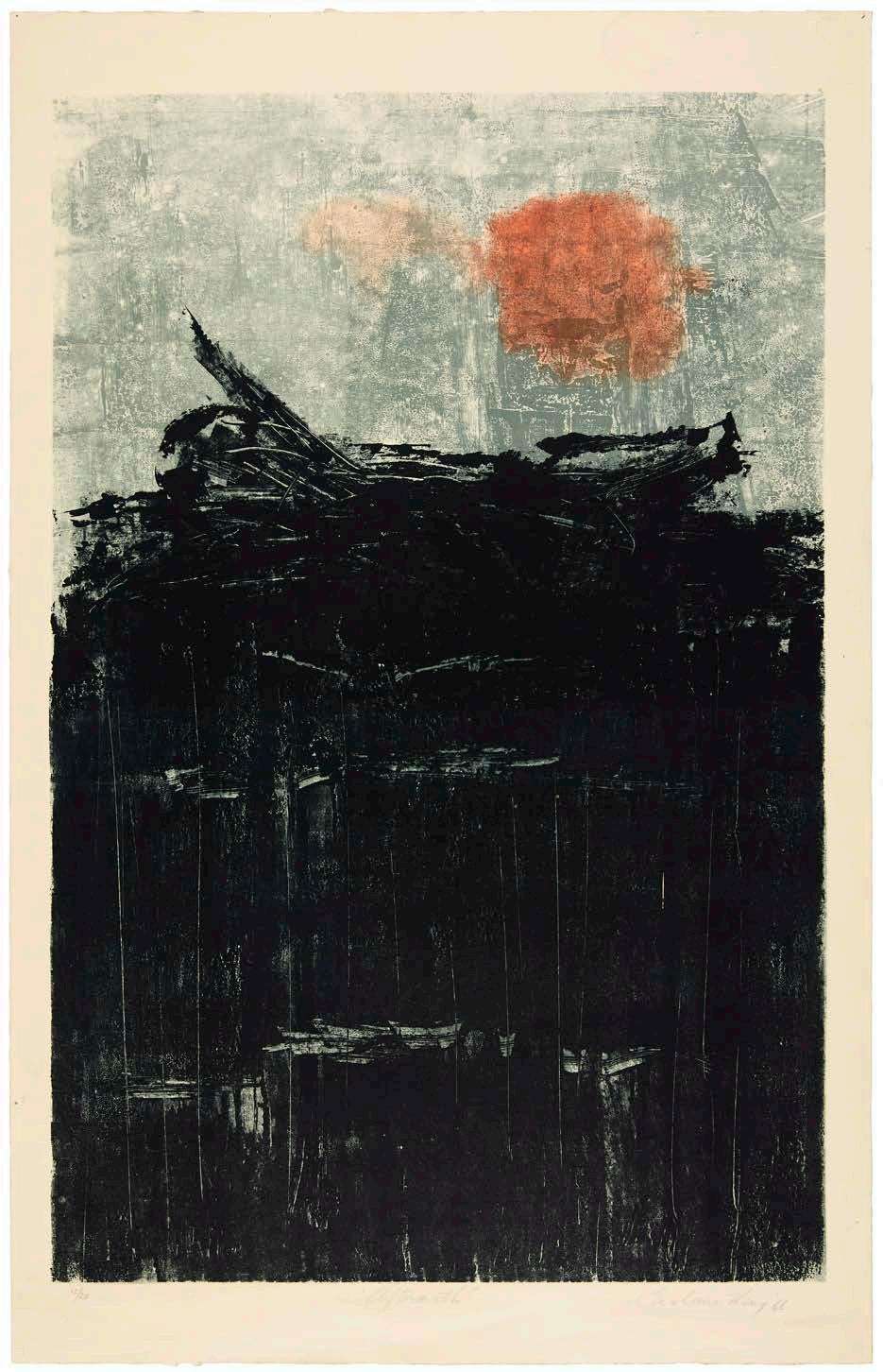

Above right Grahame King, Aftermath, 1966, lithograph in colours, printed from three plates, edition 12/20, image: 65.6 x 43.0 cm; sheet: 74.4 x 49.2 cm private collection
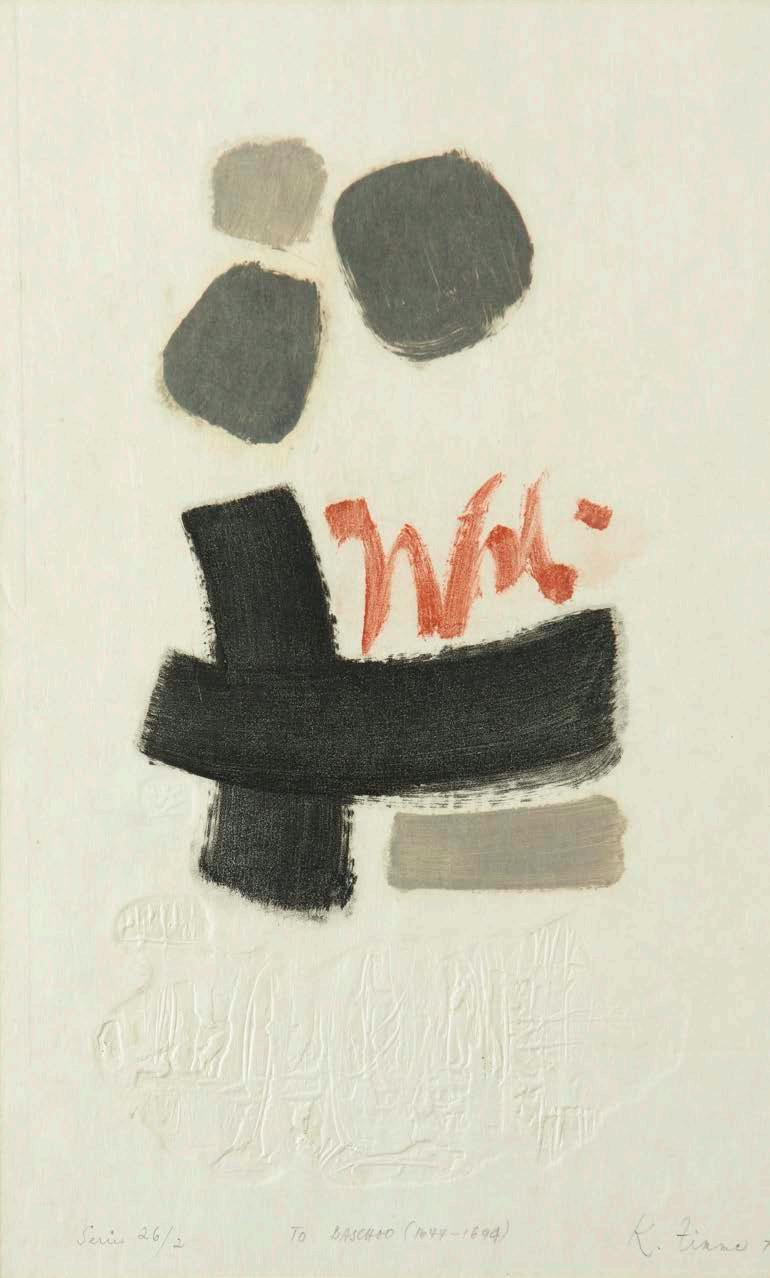
Left Klaus Zimmer, To Basho (1644–1694), 1970, colour embossed etching, edition 2/26, 55.5 x 35.0 cm, private collection
Opposite left Hertha Kluge-Pott, Beatle Dance, 1962, aquatint and drypoint, printed in three colours from three plates on Fabriano paper, edition of 15, image: 30.6 x 30.6 cm, sheet: 51.5 x 38.4 cm, collection of the artist
Opposite right Hertha Kluge-Pott, Yellow Drought, 1963, aquatint, printed in three colours from three plates on Fabriano paper, edition of 29, image: 30.2 x 30.6 cm, sheet: 50.6 x 38.0 cm, collection of the artist
92 MELBOURNE MODERN
cultivated under Freedman and Barwell’s instruction.
After Prints ’63, however, Studio One quickly disintegrated. Adams’ focus became the Crossley Gallery and his Print Department, which continued its robust European bent. George Baldessin was Adams’ protégé and RMIT lecturer from 1964–65, and 1972–78.27 Italian by birth with training from London and Milan, Baldessin also possessed an attractive, if ambiguous, European ‘sensibility’: ‘No wonder John Perceval called you Mr Modigliani as you glided into the acid room elegantly dressed in a pink and grey Venetian striped jacket over blue-black bell-bottomed jeans.’28 More than just being European by birth, Baldessin appeared to embody a foreign European perspective.
As Kluge-Pott has suggested, the victory of the European-associated print artists at the Tech was factional, their triumph was over ingrained local attitudes that were ‘self-taught’ and resistant to professionalisation:
Tate and I, we were real outsiders and it only dawned on me very much later that he eventually succeeded in [instating] his course and [establishing the] Printmaking Diploma, but it was a long, long struggle for him. And a lot of people didn’t like him because he was so singleminded in what he wanted. He wasn’t one of them.29 Although Adams’ success might have been hard-won, it was rooted in his valuable skill and expertise. The Irish artist’s
confidence was an immediate inspiration to Kluge-Pott: He did these big linocut editions of five or six colours, and the way he worked he’d just keep cutting and [he’d] print one block, and then cut the next block to print on top. And it worked. . . I was fascinated by the way he worked. Whereas for me from the very beginning was always sort of a struggle. [T]o watch him, it came easy to him.30
Kluge-Pott’s own work was possibly too unconventional for Adams, and he denied her a solo exhibition in his Crossley Gallery in the late 1960s. Despite this, after the death of Baldessin in 1978, Adams encouraged Kluge-Pott to apply for the position of Printmaking Lecturer. Then in 1982, she took over from Adams as senior lecturer and remained at RMIT until 1994, completing a three-decade long tradition of European émigré figures at the helm of the Department.31

Post-war printmaking in Melbourne did not develop in the way it did in London, Paris, Zurich, or for that matter, Los Angles and New York. During the peak boom years, between June 1966 (when Janet Dawson’s short-lived Gallery A print workshop closed in South Yarra) and November 1973 (when the Crossley Print Workshop began, superseded by Druckma Press in 1977), Melbourne was devoid of official master-printmaking workshops. As Melbourne artists rarely collaborated with master-printers, Adams’ Print Department at RMIT (along with Baldessin’s affiliated Winfield

MELBOURNE MODERN 93
Building Studio) became the de facto heart of Melbourne printmaking. This was, however, not a flawless substitute. For instance, Adams’ did not initially support screenprinting as legitimate printmaking, so Senbergs taught it out of the Painting Department from 1966.32
With the success of a professionalised, European-trained printmaking lineage came a specialised ‘house-style’ that dominated in the 1970s. A focus on technical finesse saw RMIT become – almost to the point of self-parody – a haven for aquatint, the technique that enables artists to gradate and shade various layers of seductive, textured grey. Such technical specialisation dug RMIT into an increasingly niche hole, far removed from the naïve and free experimentation that Adams had participated in during the early 1950s. This cultivated community alienated the decidedly non-European print-artists, who moved on from RMIT throughout the late 1950s and early 1960s by either creating home studios, quitting printmaking, or developing analogous, mongrel print-ish practices in fabric, photography, and collage.

We cannot hope to recapture what was stimulating about printmaking in the 1950s and 1960s if we omit the
passions and the grievances that fuelled such conflicts. While the European professionalisation of printmaking at RMIT was the cause of certain antagonism, it is not the intention here to take sides for either the internationalists or the localists, the professionals who dominated in the 1960s or the postwar, self-taught amateurs. Indeed it may be concluded that such factional infighting, which has been politely obscured in official art histories, was the real source of vibrancy in the Melbourne print boom. The Tech was at the core of a disagreement about style and standards in Melbourne’s printmaking scene, and the aftermath of this disagreement shaped the development of the artform in this city for decades to come.
Acknowledgement
This essay is drawn from the author’s current PhD research into Melbourne printmaking in the 1950s and 60s, conducted at the University of Melbourne. The author wishes to thank Roger Butler, Senior Curator of Prints and Drawings at the NGA, Canberra, who has conducted much of the prior research on émigré printmakers in Australia, and who initially commissioned and gave the author permission to publish valuable research presented here.
94 MELBOURNE MODERN
Left
Jock Clutterbuck, Stone Wave Landscape, 1973, etching and aquatint with marbling on Torinoko paper, edition 2/15, image: 48.5 x 113.0 cm (irreg), sheet: 72.5 x 122.0, RMIT Art Collection

Right
George Baldessin, Factory Smoke, 1968, etching and aquatint, artist’s proof edition of 10, 50.4 x 51.0 cm, estate of George Baldessin courtesy Australian Galleries
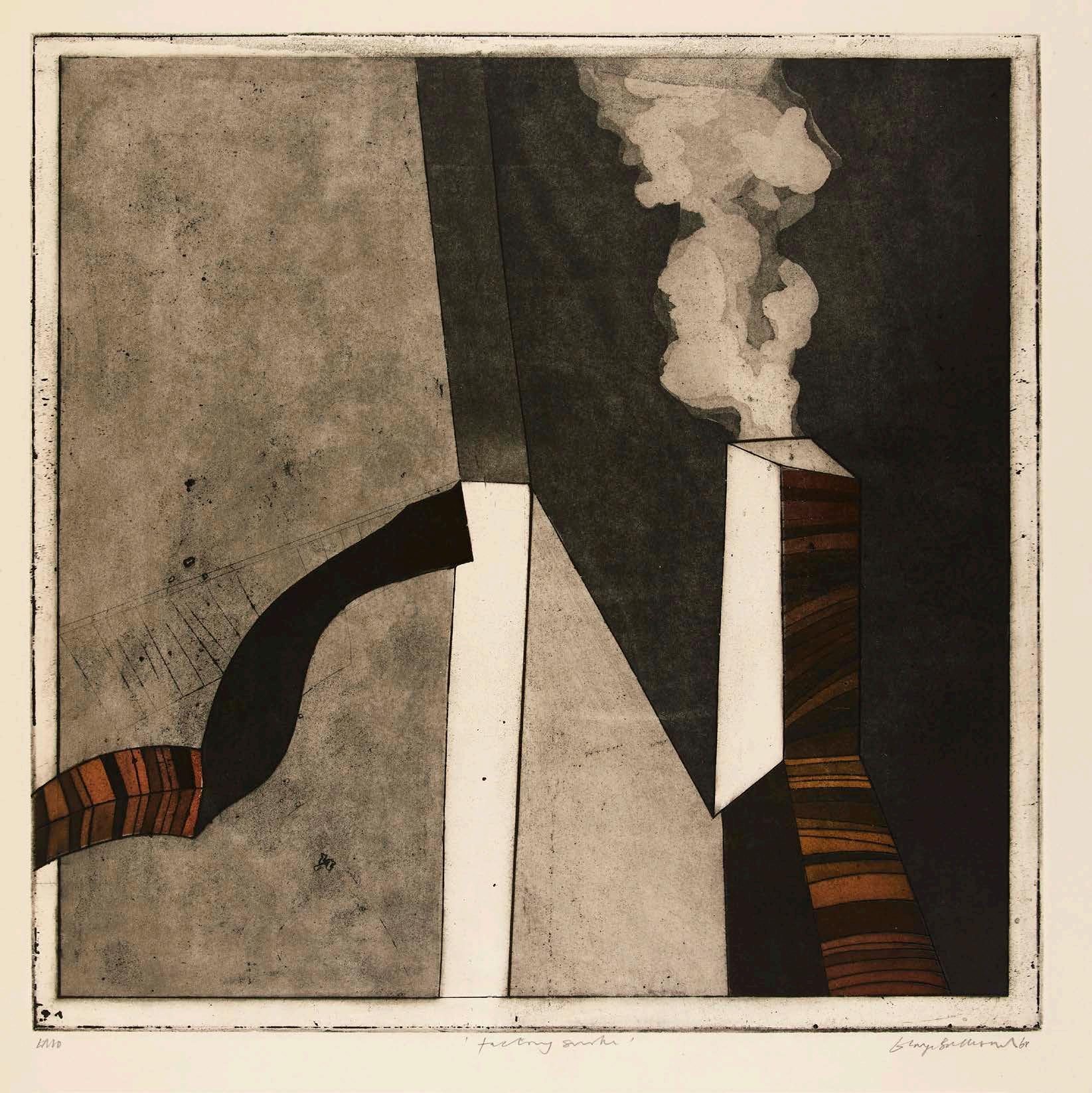
MELBOURNE MODERN 95
1 Harold Freedman interview with unknown interviewer, 24 November 1978, unpublished transcript, 7. RMIT Archives reference: 2002/023/024, INV/2016/0000167. Interview conducted as research for Stephen Murray-Smith and Anthony John Dare, The Tech: A centenary history of the Royal Melbourne Institute of Technology, South Yarra: Hyland House, 1987.
2 Original emphasis. Kenneth Jack, ‘Melbourne printmaking – since World War II’, manuscript, c. September 1979, Melbourne: SLV, Harold Freedman papers, PA 05/53, box 6. This manuscript was sent to the editors of Imprint and informed the article by Lilian Wood, ‘Melbourne printmaking in the 1950s: personal recollections’, Imprint, no. 1, 1980, 2–3.
3 Freedman, interview, 1978, 4.
4 Melbourne Technical College Prospectus “B” 1949, Trade, Correspondence, Girl’s Commercial and Special Courses Melbourne: MTC, 1949, 11. Freedman’s printmaking class filled a void left by the removal of MTC’s Commercial Printing Department, which split off to form the separate Melbourne School of Printing and Graphic Arts in 1948.
5 Freedman’s Tuesday evening print class for established artists was itself modelled on a Saturday morning class run by Ben (Roylance) Crosskell, which ran from 1936 and ended c. 1949. Crosskell was one of the instructors for Freedman’s class. The precise date given for the first meeting of Freedman’s class is derived from Harry Rosengrave letter to Ian Armstrong, 2 June 1952, Melbourne: estate of Ian Armstrong.
6 Daniel Thomas, Australian print survey 63/4, Sydney: State Galleries of Australia, 1965, unpaginated.
7 Roger Butler (ed.), ‘Introduction’, The Europeans: émigré artists in Australia 1930 – 1960, Canberra: NGA, 9.
8 Rod Clarke taught drawing then painting at RMIT from 1960, rising to become head of school in 1980; Kempf briefly taught at RMIT, 1960-61; and Grahame King taught painting, drawing and lithography from 1966-88.
9 Jock Clutterbuck studied printmaking at RMIT from 1966 –67, Fran van Riemsdyk from 1973 – 4.
10 Rex Butler and A.D.S. Donaldson, ‘Stay, Go, or Come, A History of Australian Art, 1920-40’, Australian and New Zealand Journal of Art, vol. 9, nos. 1-2, 2008-09, 121.
11 Not least from the NGV print room where Keeper of Prints, Ursula Hoff, welcomed interested art students from the 1940s on. In the print room Hoff would curate displays of the Gallery’s significant holdings of European print masters including Albrecht Dürer, Rembrandt van Rijn, William Blake and Francisco Goya. See Sheridan Palmer, Centre of the Periphery: Three European art historians in Melbourne, North Melbourne: Australian Scholarly Publishing, 2008, 134-41. Hoff’s assistant in the late 1950s was
the curator John Stringer, who had also made prints at the Tech. Ibid., 222.
12 The New Zealand-born Edith Wall did have European training from Paris, Rome and London during the 1930s. Her illustration and printmaking experience, however, was in cartooning for Australian publications from the 1940s on, and Freedman’s print class in the 1950s.
13 As Rosengrave wrote, ‘As junior lecturer / instructer [sic], the late Geoffrey Barwell was delegated to contact the younger group of artists in whose activities he participated.’ He then adds, as if to underscore Barwell’s subordinance, ‘(Using junior member to do most of the legwork is standard practice in all organi[s] ations).’ Harry Rosengrave letter to The President, Committee, & Secretary, Print Council of Australia, undated,1979, Canberra: NGA research library, Print Council of Australia archive, box 13, folder 2.
14 For instance, Rod Clarke believed: ‘[T]here is a lot of nonsense … written about Tate Adams where he was doing the printmaking and all this sort of stuff . . . The real initiative came from a guy called Geoff Barwell . . .’ Rod Clarke unpublished interview with Stella Barber, 20 May 2009, transcript, 45, Melbourne: estate of Ian Armstrong.
15 See Wood, 1979, unpaginated.
16 Ibid. When Brash wished to promote self-sufficiency for Freedman’s class she noted that they accessed manuals ‘almost simultaneously upon their release overseas.’ She identifies the publications typical of the period, such as ‘S.W. Hayter’s New Ways of Gravure (pub. Routledge & Kegan Paul Ltd., 1949), Etching and Engraving Techniques and The Modern Trend (John Buckland-Wright, pub. Studio Publications 1953) and books by [Hungarian-born, Hayter-trained, Gabor] Peterdi, [British-born, Hayter-trained, Julian] Trevelyan and others’. Ibid., unpaginated.
17 Wood, 1980, op. cit.
18 Tate Adams, ‘Melbourne printmaking in the 1960s’, conference paper, Canberra: Second Australian Print Symposium, 1992, transcript published online at Australian Prints and Printmaking, URL: http://www.printsandprintmaking.gov.au/references/1300/ (accessed 16 April 2019); also Leonard French cited in Jenny Zimmer (ed.), The Crossley Gallery: 1966–1980, South Yarra, Macmillan, 2002, 111.
19 Rosengrave leaned on French’s support when attempting to convince the MTC staff to invite he older artist to the print classes. Harry Rosengrave letter op. cit., 2 June 1952.
20 Adams, op. cit., 1992.
21 Ibid.
22 Adams was employed at Carson and Robinson from September
ENDNOTES
96 MELBOURNE MODERN
1940 to October 1942. See Melbourne: NAA, Department of Immigration, Victorian Branch, Migrant selection documents of British migrants applying for Assisted Passage to Australia under the United Kingdom and Australian Government Agreement, MP195/1, 1953/38/568/ADAMS W/G. See also Zimmer, op. cit., 2002, 22.
23 See NAA: Department of Immigration, Victorian Branch, MP195/1, 1953/38/568/ADAMS W/G.
24 It should be here noted that not only Adams but also the Melbourne Tech artists and Melbourne arts community broadly were additionally focussed on the modernist prints of Tokyo and wider Japan. Scholarly and curatorial research has mapped actual connections Melbourne had to European printmaking, but significant scholarly attention is required to illuminate the connections and enthusiasms that linked Melbourne to Japanese modernist printmaking in the decades after World War II.
25 Elena Taylor et. al., Jan Senbergs: observation – imagination, Melbourne: NGV, 2016, 152.
26 When she arrived in Melbourne in 1958 Kluge-Pott also held a German Diploma of Teaching. Hilary Maddocks, Hertha KlugePott: printmaker, South Yarra: Macmillan Art Publishing, 2015, 26, 362.
27 Robert Lindsay states Baldessin taught printmaking part-time in 1964 before being appointed a full-time lecturer in painting in 1965 only to resign in 1966. Lindsay in Harriet Edquist, George Baldessin: Paradox and Persuasion, Collingwood: Australian Galleries, 2009, 231-2, 243. A curriculum vitae printed just after Baldessin’s death records him as teaching painting at RMIT in 1963, leaving in 1966 to travel to Japan, returning to teaching (presumably in painting) in 1968-69, transferring to the Printmaking Department, 1970–74, and travelling to Paris in 1975 to work in lithography. Seven Printmakers, Hobart: Tasmanian School of Art, 11–22 September 1978. RMIT prospectuses record that Baldessin taught full-time 1972–78, although it does not distinguish between the years that Baldessin was in the Painting or the Printmaking Departments.
28 Michael Ingelton quoted in Dick Turner (ed.), European sensibilities: George Baldessin and his circle, printmaking in Melbourne during the 1960s and 1970s, Castlemaine: Castlemaine Art Gallery and Historical Museum, 2007, 28.
29 Hertha Kluge-Pott interview with Victoria Perin, 30 April 2018.
30 Kluge-Pott interview, op. cit., 2018.
31 Maddocks, op. cit., 7, 8 and 117.
32 Patrick McCaughey, Voyage and Landfall: the art of Jan Senbergs, Carlton: Miegunyah Press, 2006, 27
MELBOURNE MODERN 97
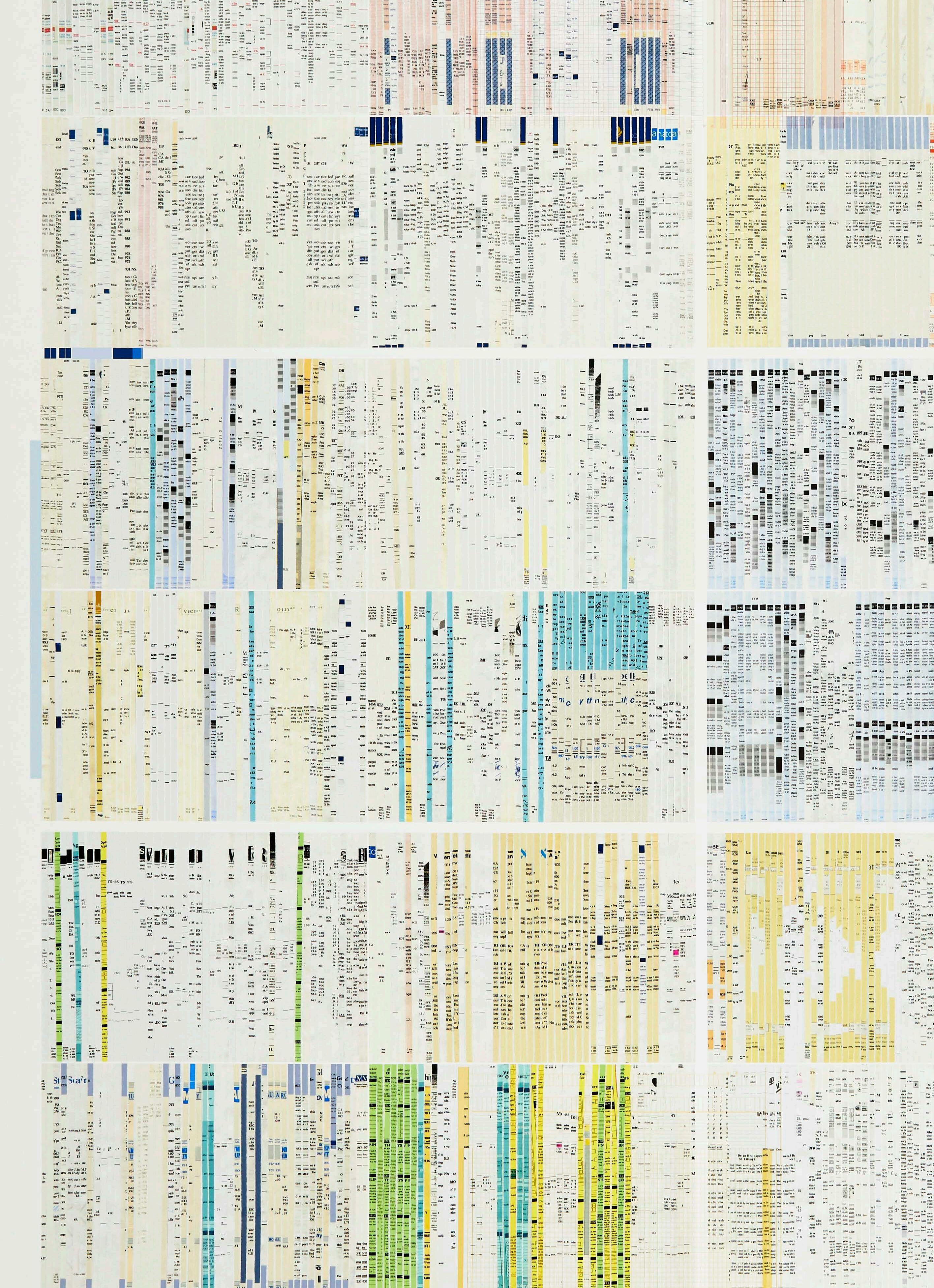
Left
Fran van Riemsdyk, Parts (5) (detail), 2018, archival pigment print on canson rag photographique paper, 105.0 x 111.0 cm, RMIT University Art Collection
Above
Fran van Riemsdyk, Parts (6), 2018, archival pigment print on canson rag photographique paper, 105.0 x 111.0 cm, RMIT University Art Collection
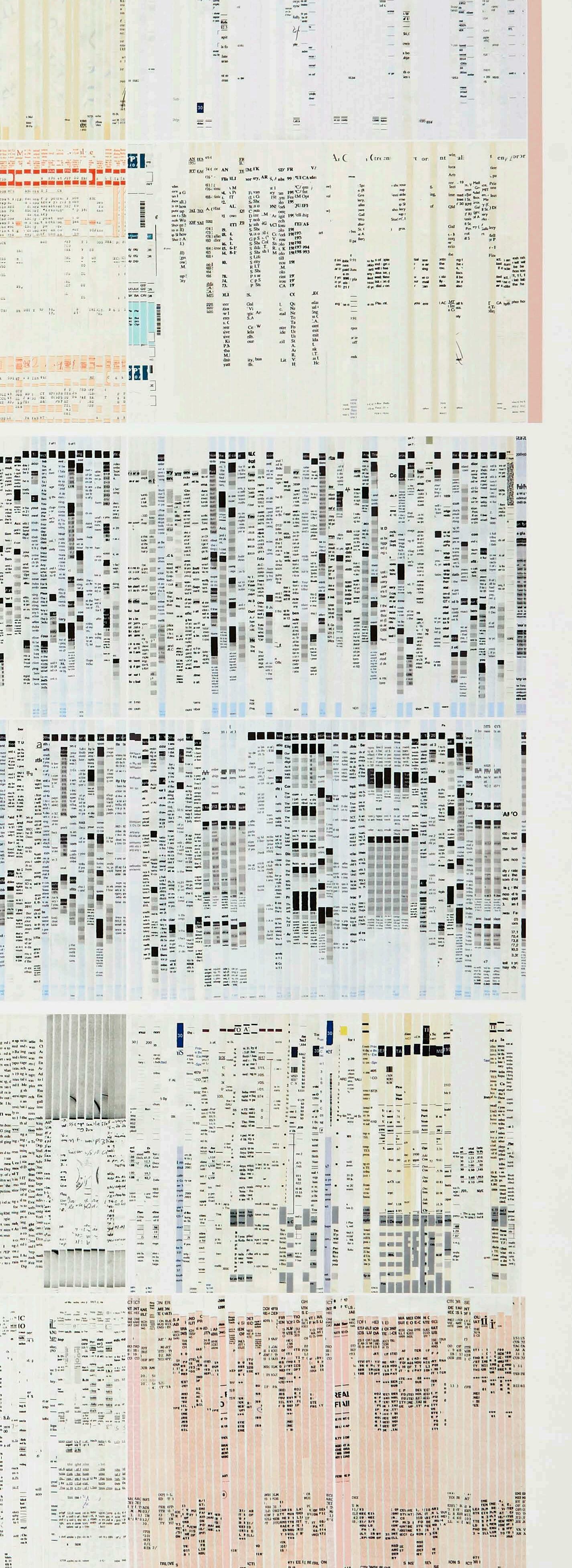
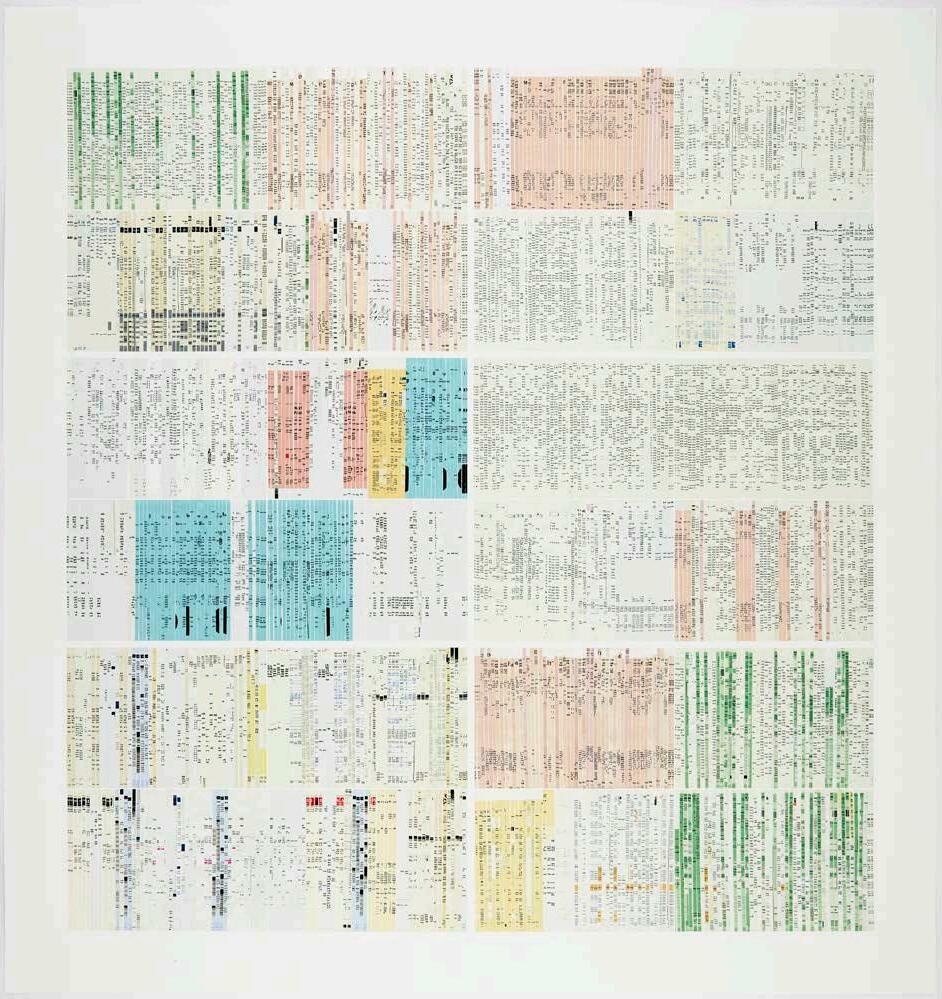
MELBOURNE MODERN 99
Above Hertha Kluge-Pott, Forest, 1987, drypoint and etching, printed in black ink with plate-tone, from one plate, on Arches paper, edition of 12, image: 50.4 x 100.4 cm, 64.6 x 111.4 cm, collection of the artist
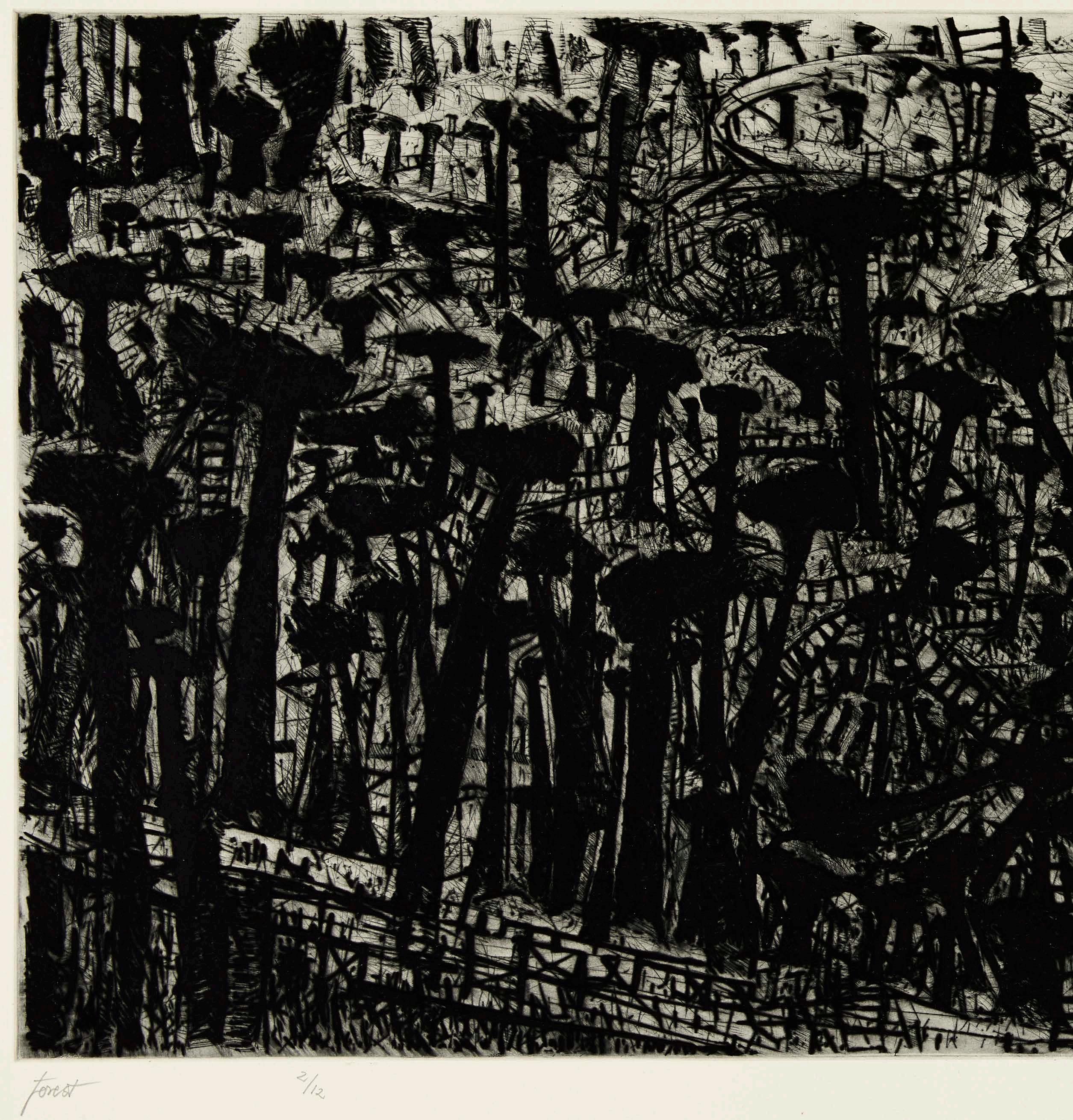
100 MELBOURNE MODERN
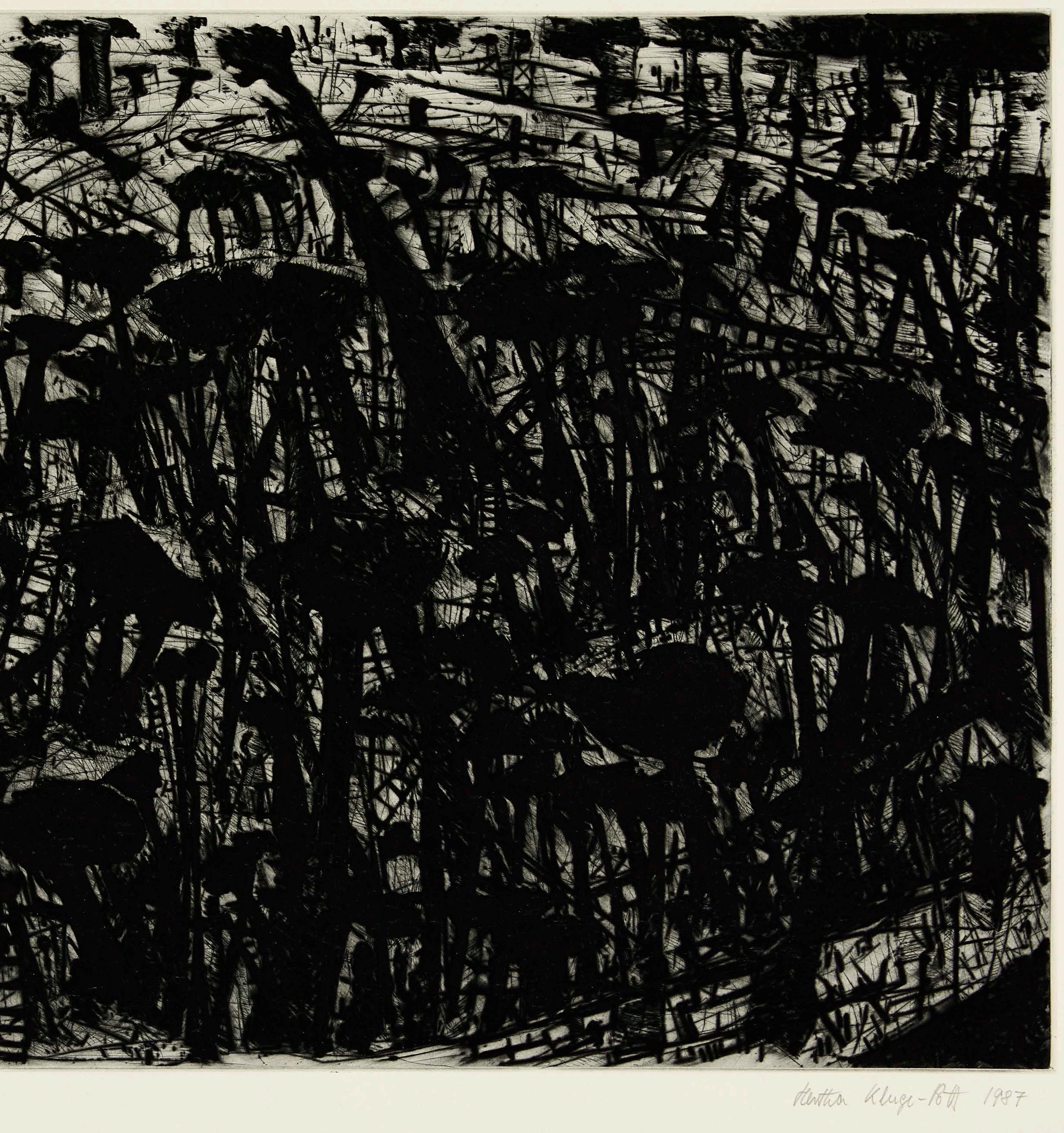
MELBOURNE MODERN 101
7 the
target is man: UDO SELLBACH AT RMIT SARAH SCOTT
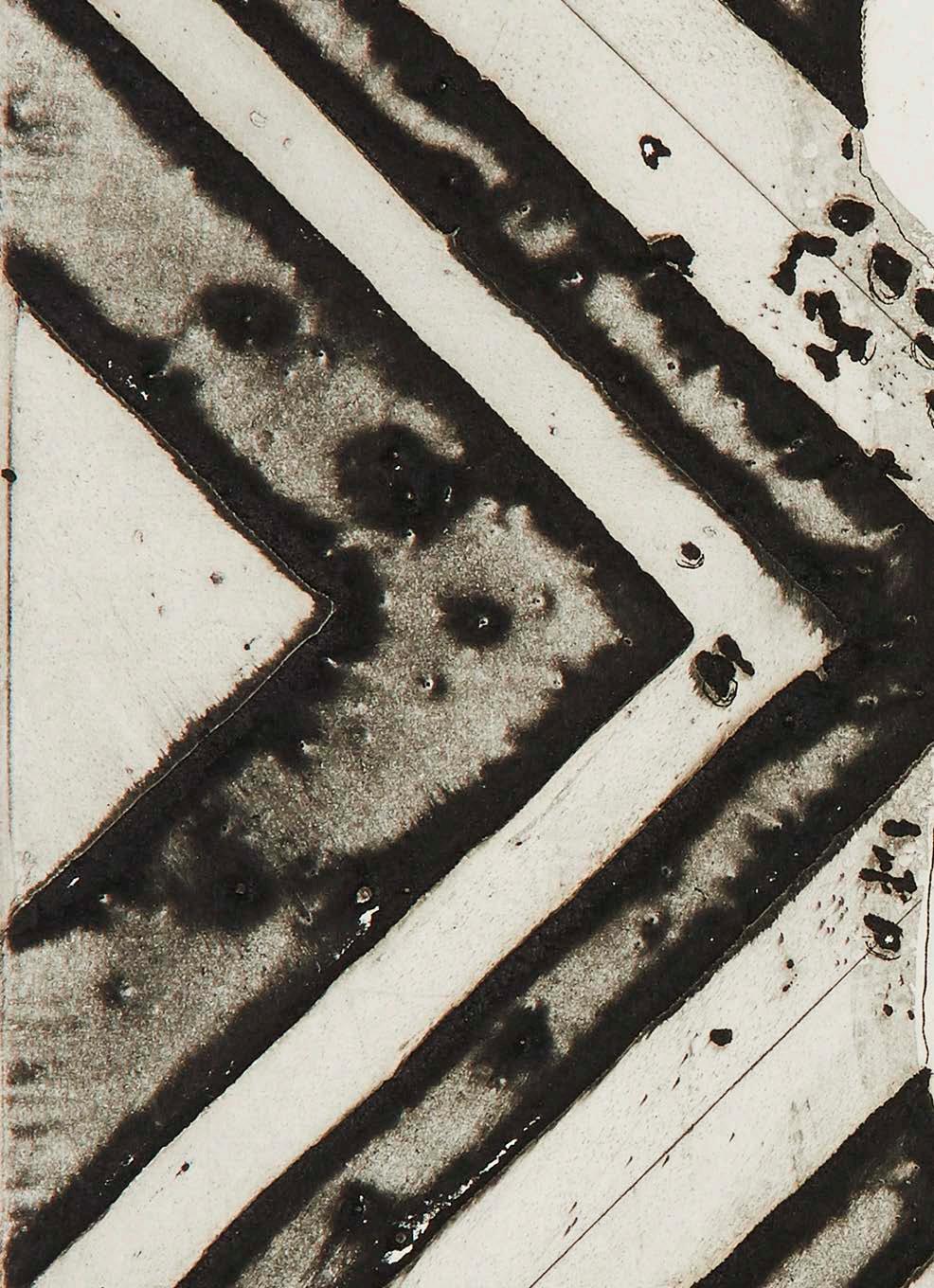
Opposite Udo Sellbach, To Execute (from The Target is Man portfolio), (detail) 1965, aquatint and etching, edition 6/25, image: 25.0 x 19.8 cm, sheet: 46.8 × 34.2 cm, collection family of the artist
The prints of Tate Adams, Grahame King, Hertha Kluge-Pott, George Baldessin, Klaus Zimmer and Udo Sellbach, presented in Melbourne Modern, make clear that art historian Sasha Grishin’s summation of the 1960s as ‘the golden age of printmaking’ in Australia is valid.1
During this period there was an awareness, particularly amongst the arts community, that printmaking was coming into its own. It was no longer considered as simply a reproductive form. Instead, it was viewed as a professional discipline that possessed its own creative language. Supporting this confidence in printmaking was the establishment in Melbourne of the Gallery A Print Workshop (1962–64), the Crossley Gallery (1966–80) and the Crossley Print Workshop (1973–77).2 These spaces were specifically dedicated to the production and exhibition of prints. Also central to this ‘golden age’ was the influx of post-World War II European migrants who brought with them their professional expertise.
One of these migrants was Udo Sellbach (1927–2006), a Cologne trained master printmaker who had arrived from Germany in 1955. He had already set up a print studio at the South Australian School of Art before taking up a position at RMIT during May 1965.3 He joined Tate Adams, who had established a Diploma of Printmaking at RMIT in 1960.4 Although, as Adams has recalled, conditions at the one room studio were limited and it was furnished with print equipment and lithograph stones salvaged from demolition sites, RMIT became an important centre for artists including Edwin Tanner, Leonard French and Fred Williams.5 It was also used by students including the brilliant young artist George Baldessin. Like Sellbach, a concern with humanism is central to Baldessin’s work, with both artists placing humanity ‘in the spotlight’ by utilizing dramatic and theatrical compositions. Both artists also possess a mastery of technique and Baldessin in particular pushed the discipline of printmaking to the limit, as can be seen in his development of the use of aluminum foil in prints. Baldessin was to be a profound influence upon generations of younger printmakers despite his untimely death.
So too was Sellbach. In 1966 Sellbach was instrumental in setting up the postgraduate printmaking course at RMIT and, in the same year, worked with Grahame King and curator Ursula Hoff to establish the Print Council of Australia.6 This was also the year that a series of twelve prints entitled The Target is Man (1965), was exhibited at Leveson Street Gallery in Melbourne in a joint exhibition with
King.7 This series is central to understanding both some of Sellbach’s later paintings and his work for The Broadsheet Four of the prints in the series, To Sacrifice, To Persecute, To Chain and To Execute, were also published in the leftwing literary journal Overland in May 1966, accompanied by an introduction by renowned art historian Bernard Smith.8 Although Sellbach’s work was not specifically Antipodean in subject matter, it appealed to Smith because it was responding to a contemporary situation, was socially involved, and was not purely abstract. I argue that The Target is Man series remains significant for two reasons: first, it was a surprisingly early response to the Vietnam War; second, it demonstrates a sophisticated and unusual melding of current developments in hard-edge abstraction combined with figuration.
In part the series was inspired by Sellbach’s own experiences. He noted, ‘The series originally was prompted by the war in Vietnam and my own memory of the war in Europe. It grew for me into an urgent statement about the inhumanity of Man against Man.’9 His memories of war were harrowing in the extreme. Sellbach was born in Cologne in 1927. In February 1945, the seventeen-year-old artist was called up to the Eastern front during the final days of World War II when the Russians had reached the Oder River. Bernard Smith recounts:
On the 16th of April he was thrown into battle with other inexperienced teenagers to stem the Russian advance. Utterly demoralized after two days they eventually broke in all directions. At one point Sellbach was about to be hung for desertion by two SS men until the approaching Russian tanks allowed him to get away. Later he was caught by the Russians but managed to escape again, swam the Elbe and was picked up by the British.10 But The Target is Man series is also Sellbach’s response to the situation of Australia in Vietnam. On the 29th of April 1965, Prime Minister Robert Menzies announced that Australia would provide further assistance to the war effort, supplementing the almost 200 military personnel already deployed in Vietnam. The Royal Australian Regiment departed on the 27th of May, arriving in South Vietnam on board the HMAS Sydney on the 8th of June.11 Sellbach’s
MELBOURNE MODERN 103
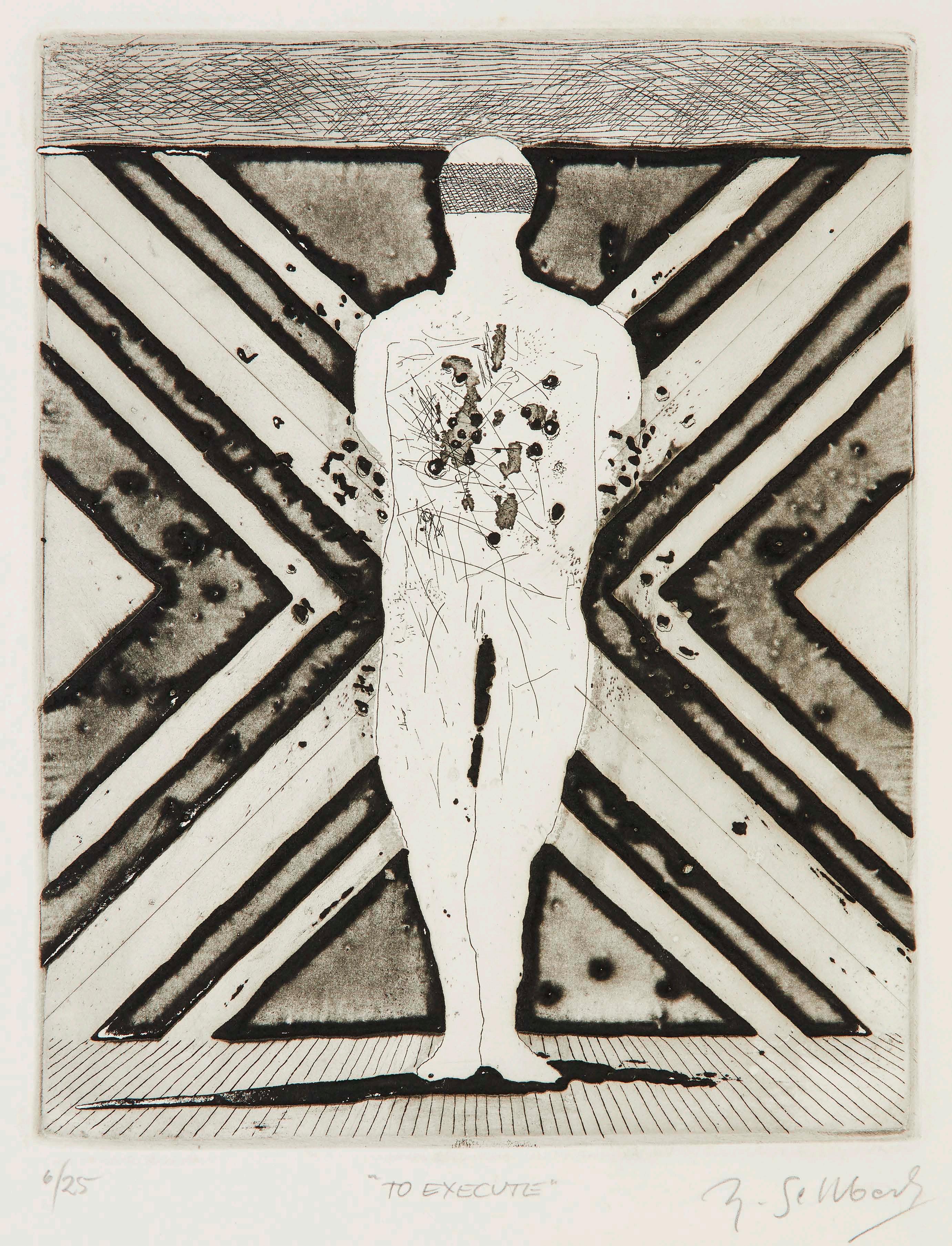
104 MELBOURNE MODERN
response with this print series was immediate and all the more remarkable because resistance in Australia at that time was limited. Indeed in 1966 when Labour leader Arthur Calwell announced that he supported pulling out of Vietnam, he suffered electoral defeat.12 Whilst university campus protests were held across the USA during 1965 and a protest was held on the Pentagon steps in June of that year, in Australia resistance to the war was at first limited, though it eventually culminated in the moratorium marches of 1970 and 71.13
It is important to note that Sellbach’s painting practice ran parallel to his print practice during the mid to late 1960s and the early 70s. This aspect of his work is often overlooked, even though he participated in The Field exhibition in 1968, and was granted second place in the George’s Prize that year, which was judged by American art theorist Clement Greenburg and Australian art critic Alan McCulloch. Sellbach was actively responding to what he saw around him. Australian artist Janet Dawson had returned from Europe and helped establish the avant-garde Gallery A; in 1961 she presented a pioneering show in colour-field painting there and later, in 1968, she, along with Clement Meadmore and Max Hutchison, agreed to exhibit Sellbach’s abstract paintings and prints.14 By this time colour-field artist Sydney Ball had already exhibited his work at the Reed’s Museum of Modern Art, following his time as a student of Sellbach’s in South Australia from 1960 to 63. Another former student experimenting with hardedge abstraction at this time was Alun Leach-Jones. From 1965 James Doolin, a colour-field painter from the West Coast of America, was at Prahran Technical College. American modernism was also promoted in the magazines Art Forum and Art International, and there is no doubt that Sellbach came across elements of the movement during his year in Europe in 1964.
Some of the paintings Sellbach produced have a direct relationship with The Target is Man series as can be seen in Small Sleep Figure I, 1969. Here a semi-abstract limp figure lies in the centre of a circle recalling the targets of his earlier series, a blood red shadow behind the figure. The violent clash between red, black and purple adds to the disturbing nature of the painting. There is a series of paintings Sellbach
developed for the 1968 Gallery A show, of which Black Knight is one example, which are more abstract in character, being mainly concerned with positive and negative shapes, but which can also be read as aerial views of a city. Indeed Sellbach’s friend and RMIT colleague, Margaret Plant, believes this series directly references the aerial bombing of Cologne, which Sellbach experienced and spoke of frequently.15 These paintings set up visual problems and puzzles like a chess game. Later he experimented with strip paintings, which were exhibited in South Yarra in 1970. These feature brilliant coloured shapes and patterns in canary yellow, sky blue, white and red, painted on wood strips about as wide as a ruler and at least a metre long. They are concerned with capturing time: the time that it would take for someone to ‘read’ the image from left or right or from right to left thereby involving the viewer in their intricate detail. I remember Sellbach saying he was influenced by the idea of the filmstrip. He explained ‘The strip drawings are the culmination of my search for a form which can hold fixed in time the transformation of ideas and experience.’16
Udo Sellbach’s daughter, Antonia Sellbach, takes up some of these concerns in her own unique way as can be seen in Communicative Device #5, Table Sculpture, 2013-2019 and Unstable Object #32, Grid Painting. Her work is inspired in part by Wittgenstein’s theories concerning language. Her vividly coloured paintings explore the possible combinations of pieces and parts echoing the elements found within the structure of language. As she explains:
I grew up around the abstract paintings my father made, many of which seemed to hold some sort of puzzle or riddle. They were set up to appear as though they would have an ordered resolution which I would spend hours trying to figure out. My father’s work made a deep impression on me for the reason that it drew the viewer to this very engaged relationship but didn’t offer a clear resolution... making me realise that a question need not have a fixed answer or any answer at all.17
Despite experimenting with hard edge painting, Udo Sellbach never abandoned his belief in the social impact of art. In 1995, from the perspective of old age he declared: I hope that my art will influence people and show them
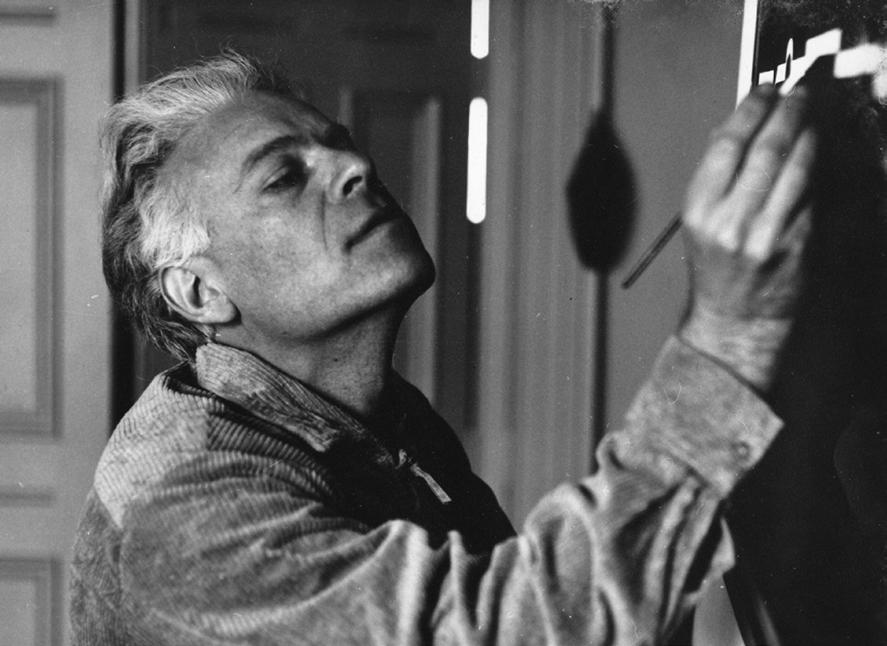
MELBOURNE MODERN 105
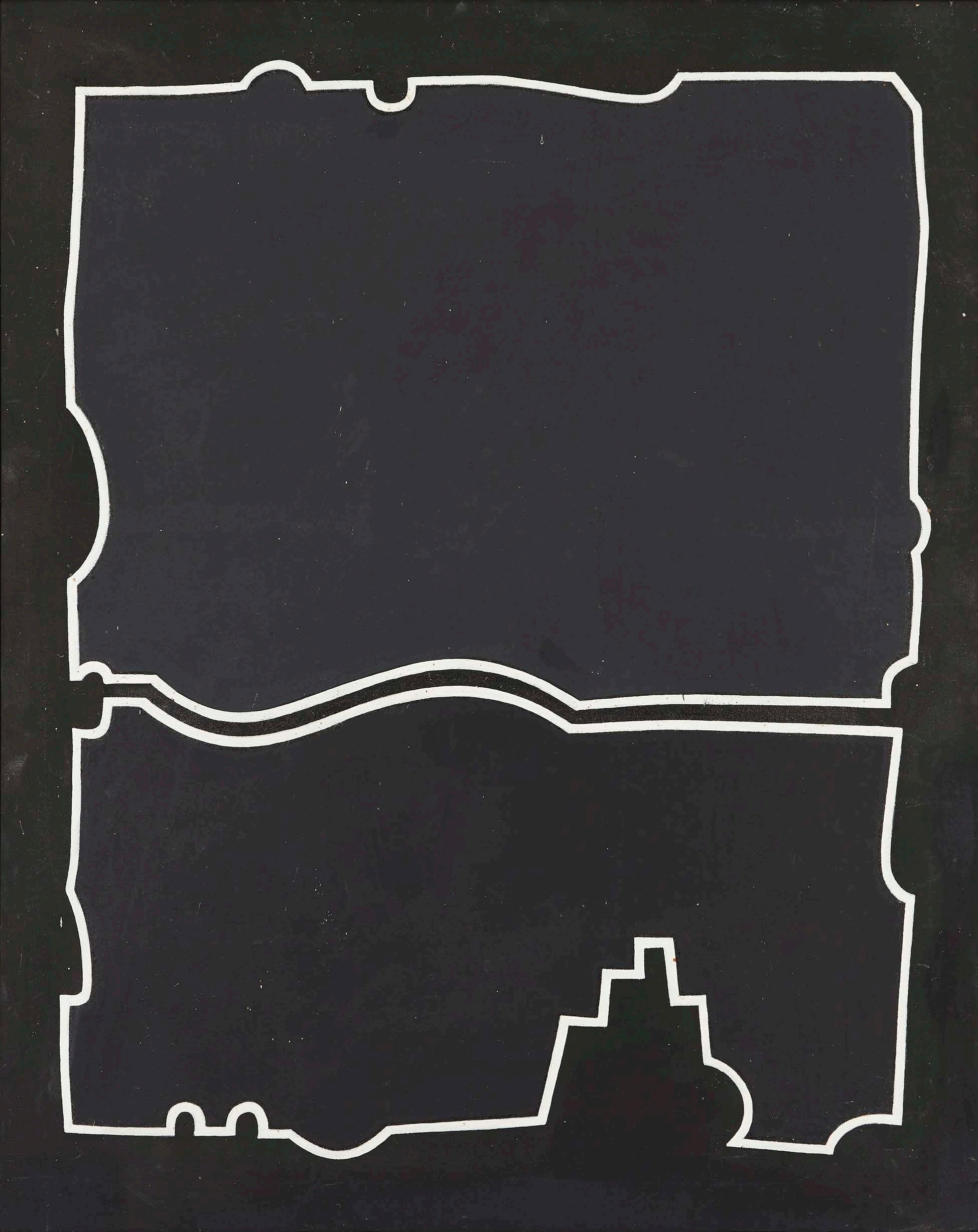
106 MELBOURNE MODERN
Page 104
Udo Sellbach, To Execute (from The Target is Man portfolio), 1965, aquatint and etching, edition 6/25, image: 25.0 x 19.8 cm, sheet: 46.8 × 34.2 cm, collection of the family of the artist
Page 105
Udo Sellbach in his Melbourne studio, c. 1968, photographer unknown, courtesy Sellbach family
Opposite Udo Sellbach, Black Knight, 1968, synthetic polymer paint on canvas, 102.5 x 82.5 cm, collection of the family of the artist
Above
Udo Sellbach, Small Sleep Figure I, 1969, synthetic polymer paint on canvas, 108 x 108 x 4 cm, collection of the family of the artist
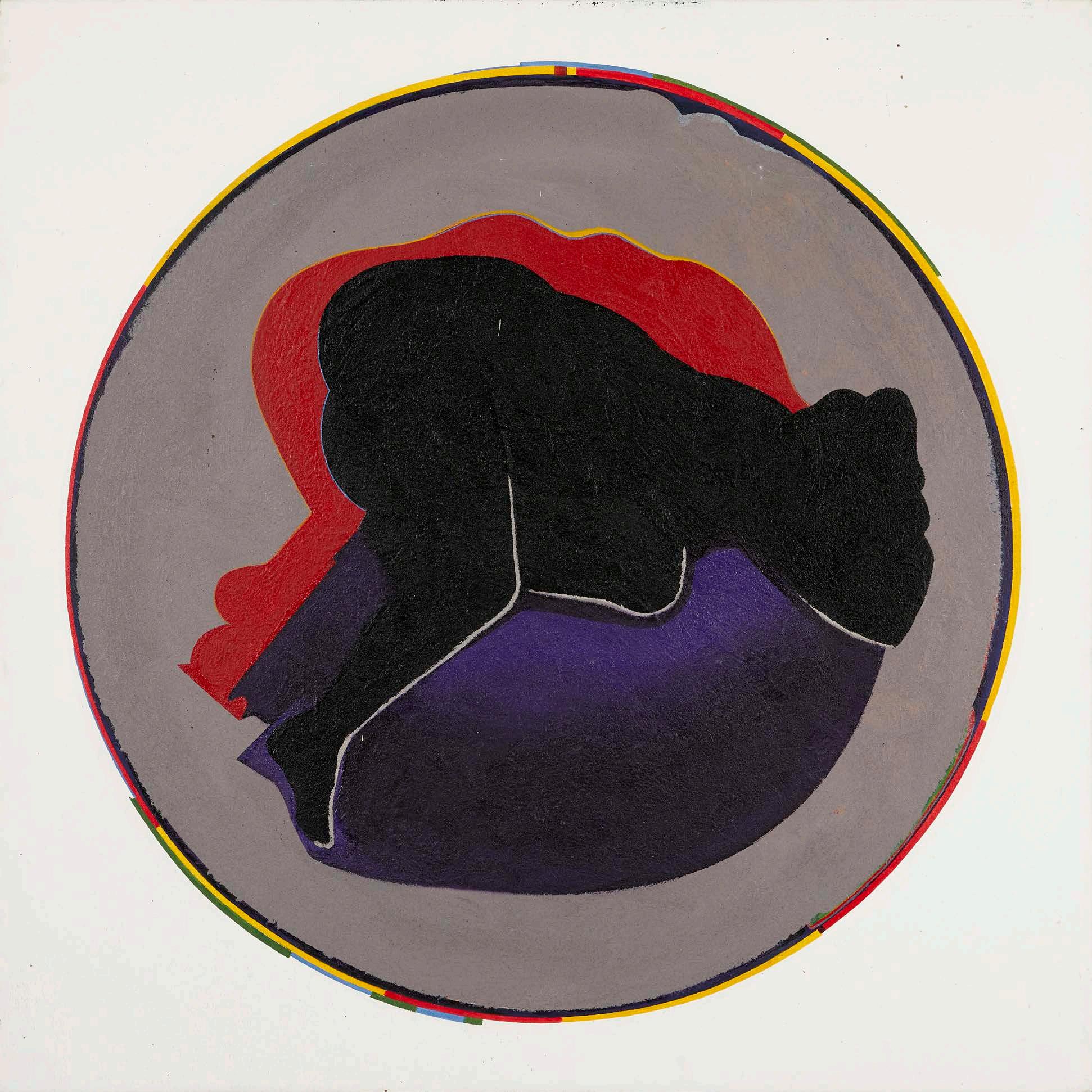
MELBOURNE MODERN 107
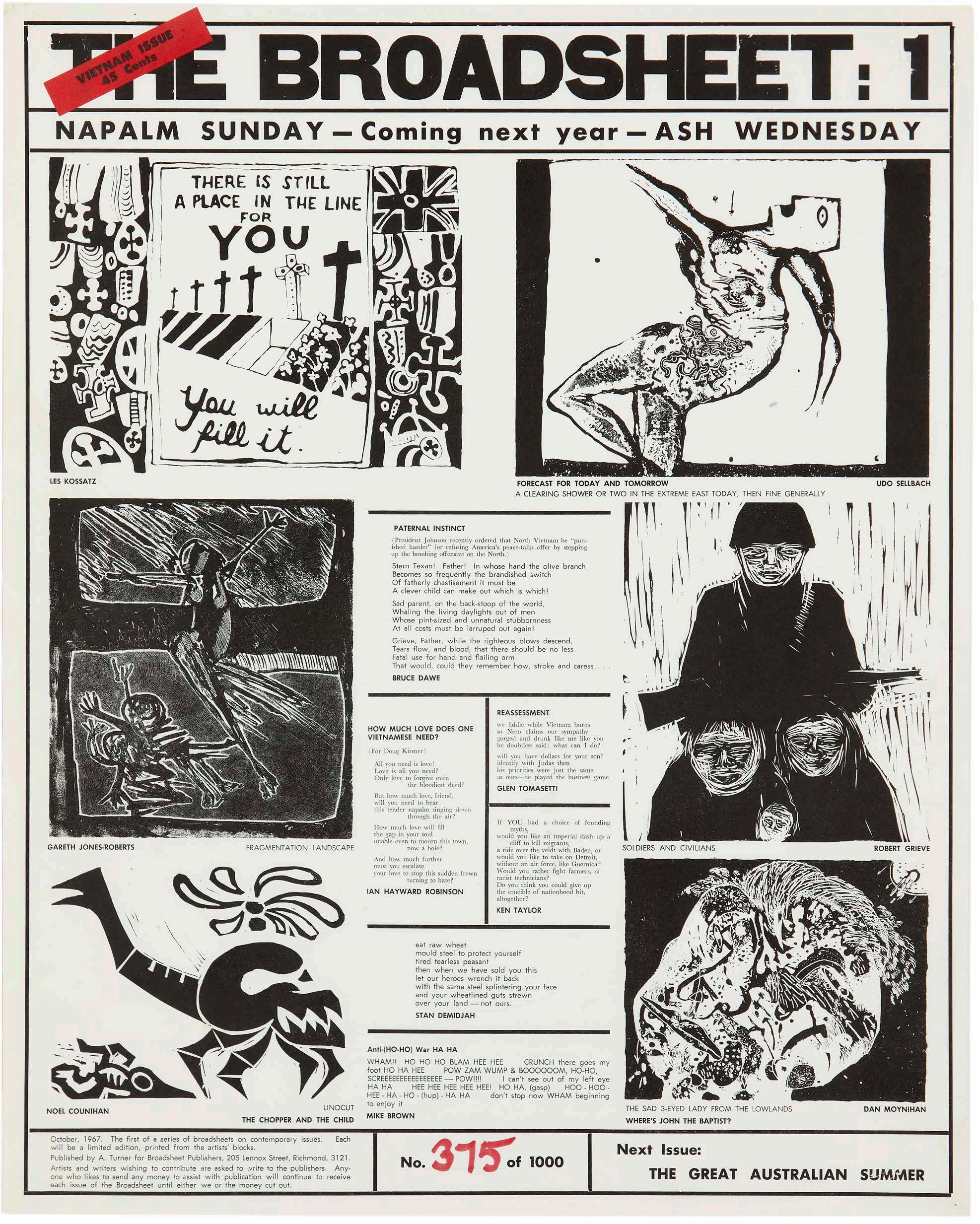
108 MELBOURNE MODERN UDO SELLBACH AT RMIT
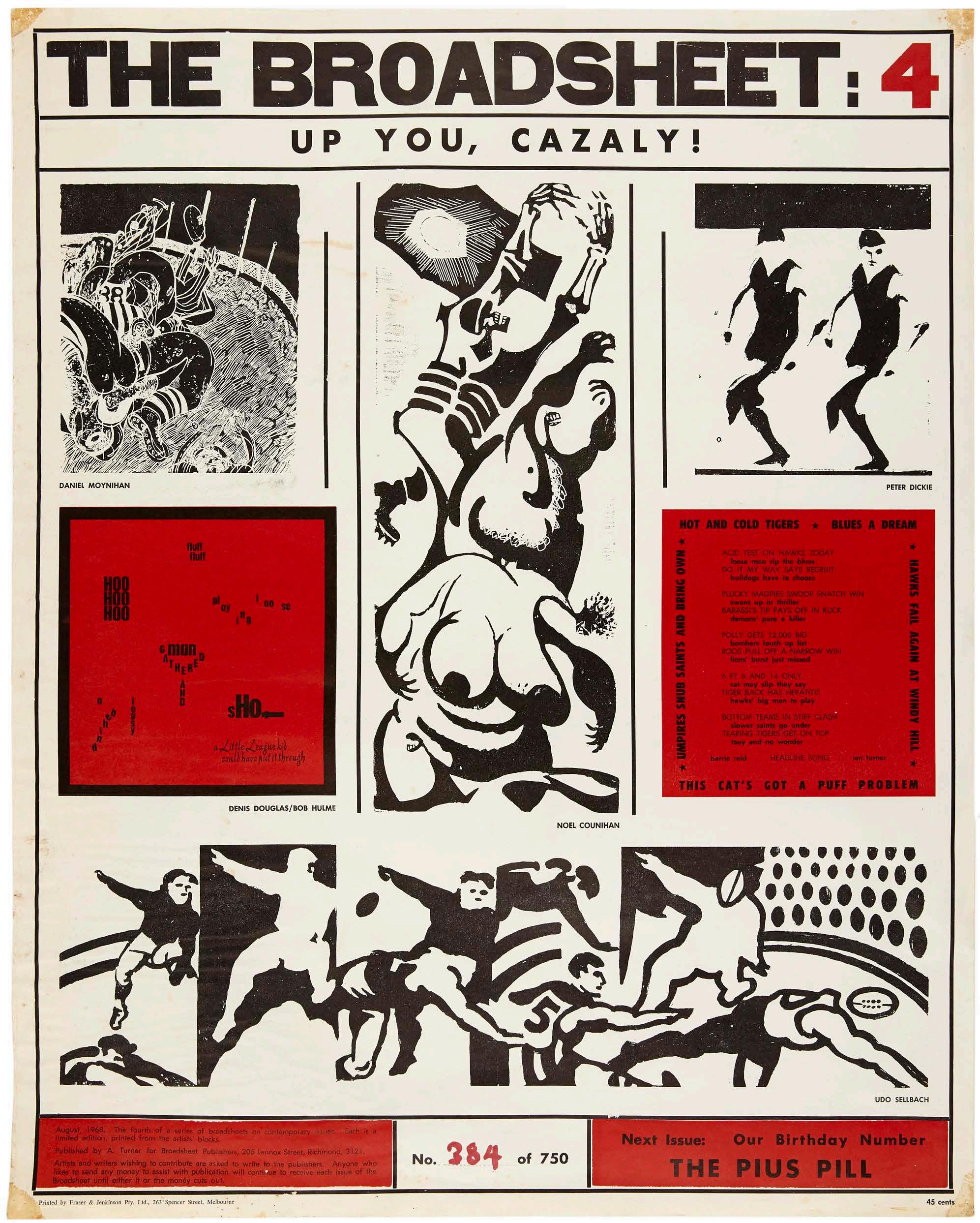
MELBOURNE MODERN 109

110 MELBOURNE MODERN
Page 108
Udo Sellbach with Les Kossatz, Gareth JonesRoberts, Robert Grieve, Noel Counihan and Daniel Moynihan, The Broadsheet I, 1967, letterpress and relief print on paper, 375/1000, 63.3 x 50.4 cm, collection of the family of the artist
Page 109
Udo Sellbach with Daniel Moynihan, Noel Counihan and Peter Dickie, The Broadsheet 4, 1968, letterpress and relief print on paper, 384/750, 63.3 x 50.4 cm, collection of the family of the artist
Opposite
Antonia Sellbach, Unstable Object #32, Grid Painting, 2016, acrylic on canvas, 150 x 150 cm, collection of the artist

Page 112
Antonia Sellbach, Communicative Device #5, Table Sculpture, 2013–2019, Tasmanian oak, pigment, linseed oil, dimensions variable, collection of the artist
MELBOURNE MODERN 111
familiar aspects that may open doors to elements not already in their lives. I believe you can reform people through art. I want people to take from my work an indication of human concerns, human conditions, and the quality of life, in physical and psychological terms. If I can encourage people to look seriously at life and the things around them, then I have done what I set out to do.18 This attitude, which he held throughout life, no doubt stimulated his participation in The Broadsheet – the first issue of which was published in October 1967 as a collaboration between Sellbach, the left-wing historian Ian Turner, and the social-realist artist Noel Counihan.19 Like The Target is Man, it also responded to the situation in Vietnam. Conscription had been introduced and in August 1966 the Battle of Long Tan fought, with eighteen Australians killed, twenty-four wounded and two hundred and forty-five Viet Cong killed.20 In February 1967 the Australian Task Force lost sixteen men in a single week, with a further fifty-five wounded. Printmaking seemed particularly relevant as a way to respond to this situation because of its capacity for mass reproduction. In October 1967 the first issue appeared in an edition of one thousand. It was distributed through art colleges and throughout Melbourne. In the first issue is an image by Sellbach of a falling figure, his innards exposed, echoing some of his earlier imagery in The Target is Man series. The reference
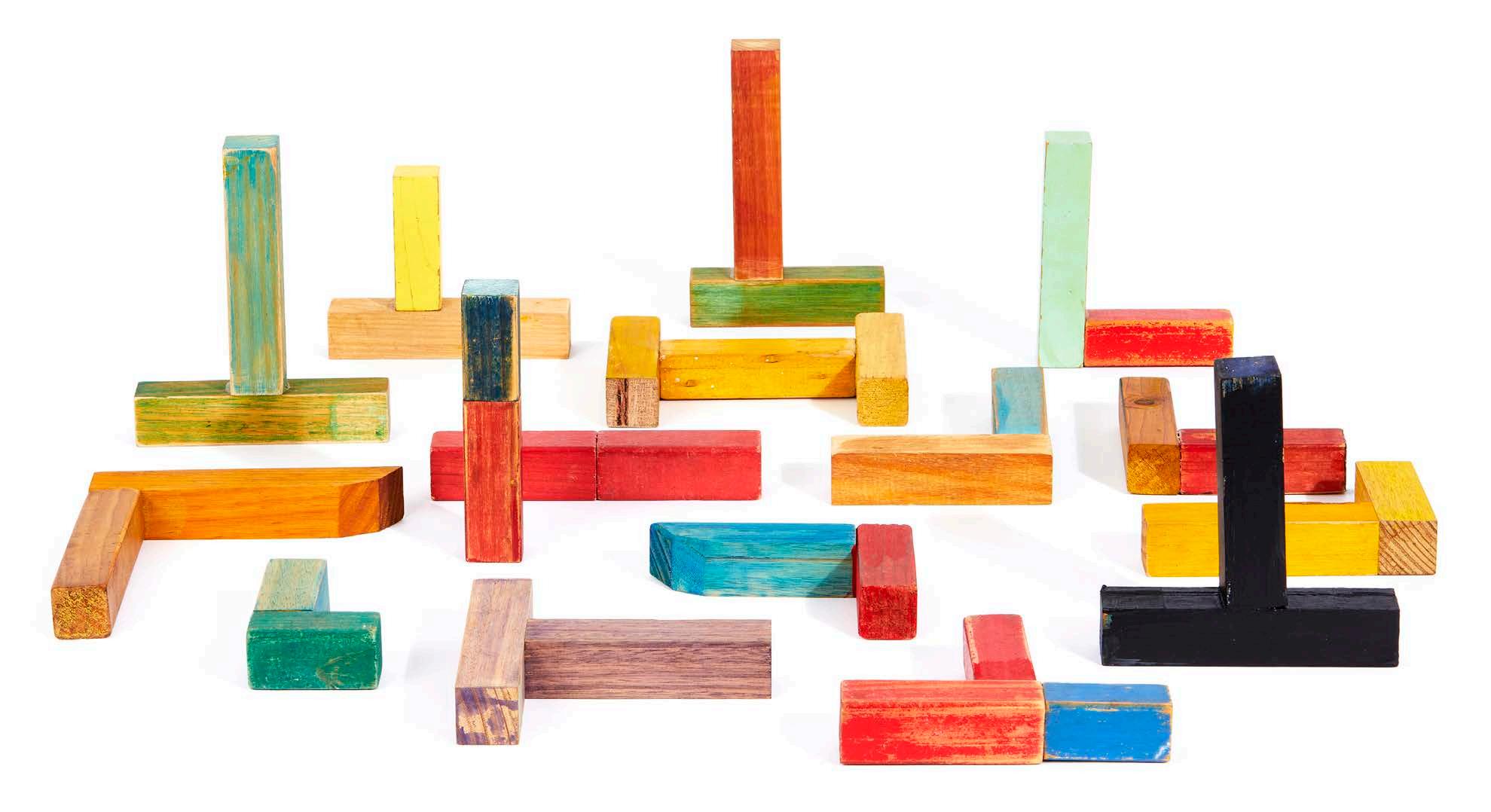
to the weather forecast underneath the falling figure refers to the use of napalm in Vietnam. Equally powerful images by Counihan, Les Kossatz, Robert Grieve and others are juxtaposed against poetry responding to the war.
More light hearted in character is issue four of The Broadsheet, ‘Up You, Cazaly!’, celebrating Australia’s fascination with Australian Rules football. It features a striking and beautifully balanced horizontal black and white design by Sellbach that clearly captures the momentum of the game. Images by Counihan, Daniel Moynihan and Peter Dickie are also featured in this issue.
The Target is Man series and The Broadsheet demonstrate how Sellbach played an important role in the rise of printmaking that occurred in Australia, particularly in Melbourne, during the 1960s. Both these sets of works remain important early responses to the Vietnam conflict as well as sophisticated responses to the artistic environment Sellbach found himself in. During his time as a lecturer at RMIT he remained socially active within his practice whilst at the same time responding to the developments heralded by colour-field painting. Until now, Sellbach’s paintings have been largely overlooked, but alongside his prints they also make a significant contribution to Australian art of the 1960s and 70s.
112 MELBOURNE MODERN
1 Sasha Grishin, ‘The Golden Age of Printmaking in Australia’, Contemporary Australian Printmaking: An Interpretive History, Sydney: Craftsman House, 1994, 48-135.
2 Anne Connors, Seven Printmakers, Hobart: Tasmanian School of Art Gallery, 1978, 1. See also Tate Adams ‘Melbourne printmaking in the 1960s’, conference paper, Canberra, NGA: Second Australian Print Symposium, 1992, transcript published at Australian Prints and Printmaking, URL: http://www. printsandprintmaking.gov.au/references/1300/ (accessed 1 March 2019).
3 Sasha Grishin, Udo Sellbach, And Still I See It, Canberra: Drill Hall Gallery, 1995, 18.
4 Adams, op. cit., 1992.
5 Ibid.
6 See Marguerite Brown ‘Paper Tales; Highlights from the Print Council of Australia Collection’, paper delivered at the Ursula Hoff Institute Annual Reporting Meeting, Melbourne, 26 September 2017, excerpt published online, URL: https://www. printcouncil.org.au/about/ (accessed 1 March 2019).
7 Grahame King and Udo Sellbach, Melbourne: Leveson Street Gallery, 27 March – 7April 1966.
8 Bernard Smith, ‘The Sellbach Etchings’, Overland, vol. 34, no. 5, May 1966, 24-8.
9 Udo Sellbach, ‘Notes for an exhibition,’ 25 April 1972, Canberra: NGA Research Library, Udo Sellbach file.
10 Bernard Smith, ‘An appreciation by Bernard Smith’, Udo Sellbach, Nightwatch: A Print Cycle of Thirty Etchings, limited edition print portfolio, [Brisbane]: Udo Sellbach, 1991, unpaginated.
11 ‘Vietnam War 1962-75’, Australian War Memorial, URL: https:// www.awm.gov.au/articles/event/vietnam (accessed 1 March 2019).
12 Arthur Calwell, ‘Election Speech’, 10 November 1966, Museum of Democracy at Old Parliament House, URL: https:// electionspeeches.moadoph.gov.au/speeches/1966-arthurcalwell (accessed 1 March 2019).
13 ‘Vietnam moratoriums’, National Museum of Australia, URL: https://www.nma.gov.au/defining-moments/resources/vietnammoratoriums (accessed 1 March 2019).
14 Udo Sellbach, Melbourne: Gallery A, 5-22 March 1968. The exhibition afterwards went to Gallery A, Sydney.
15 Margaret Plant, interview with Jane Eckett, 5 October 2017.
16 Udo Sellbach, ‘Artist Statement’, Recent Drawings and Prints by Udo Sellbach, Hobart: Salmanca Place Gallery, 1976.
17 Antonia Sellbach cited in Linda Short, ‘Antonia Sellbach: Open Fields’, Open Fields, Bulleen, Vic.: Heide Museum of Modern Art, 2016, 9-10.
18 Kate Lemmon and Emily Pocock, ‘Capturing moments of human suffering: The art and life of Udo Sellbach, printmaker’, ANU Reporter, Canberra: Australian National University, 2 August 1995.
19 The Broadsheet, Richmond, Vic.: A. Turner for Broadsheet Publishers 1967–71.
20 ‘The Long Tan cross’, Australian War Memorial, URL: https:// www.awm.gov.au/commemoration/long-tan (accessed 1 March 2019).
ENDNOTES
MELBOURNE MODERN 113
8 legacies
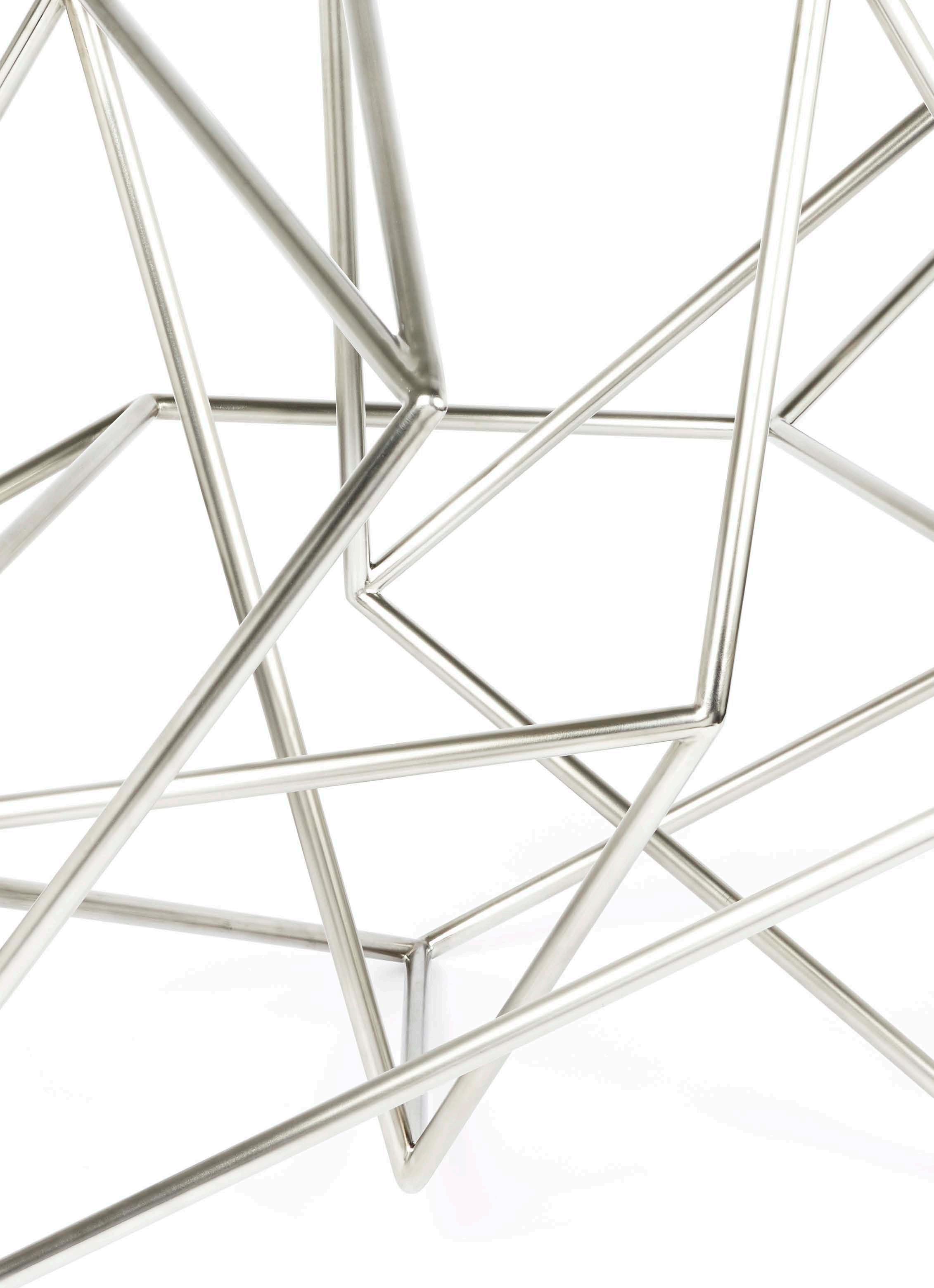 JANE ECKETT
JANE ECKETT
Opposite Robert Owen, Fallen Light, 2012 (detail), stainless steel, 120.0 x 120.0 x 120.0 cm, courtesy of the artist and ARC ONE Gallery, Melbourne
Each of the programmes surveyed in Melbourne Modern benefited from the professionalization instituted by the émigré staff: be that in the reforming and transformation of ‘interior decoration’ into interior design, which can now be taken as either a Degree or a Diploma, or replacing ‘art metalwork’ with an ambitious gold and silversmithing programme conceived of as fine art rather than craft, or simply leading by example, inciting students to implement a professional approach in their own practice.
Of the various programmes surveyed here, architecture and interior design present the greatest challenge in pinpointing the émigrés’ precise legacy in terms of teaching at RMIT. The reason for this lies in the dates when each émigré taught at the Tech: Romberg 1945–49, Fooks c. 1944–54, Sterne 1947–51, and Kral c. 1961. As these dates reveal, émigrés were appointed to the architecture programme well before their European colleagues in the School of Art; their professional qualifications were recognised in Australia from an early date. Consequently they also left earlier in order to pursue professional practice (or, in Sterne’s case, through untimely death). Nevertheless, during – and often after – their brief tenures they called upon their wider émigré networks: Romberg and Fooks completed many projects for émigré clients such as the Futura Furniture Showroom for Romanian modernist furniture maker Schulim Krimper, Sterne was probably responsible for the appointment of fellow Viennese architect Fritz Rosenbaum, and Kral completed design projects for fellow Czech nationals such as oboist Jiri Tancibudek and Centroswiss jewellery store co-owner Slava Jezek. Given the lack of a long lineage of European presence in the School of Architecture it is difficult to establish the exact degree or nature of their influence at RMIT, though the substantial contribution each made to their respective field of practice is indisputable.
The European impact is most evident in the gold and silversmithing programme at RMIT. Under Vodicka and Wennrich the programme evolved from a trade-based art-metalwork course to an ambitious applied art studio course with art jewellery as its focus. Wennrich kept abreast of developments in contemporary jewellery in Europe; he drew on his international networks to attract visiting
German and British jewellers, including David Watkins and Wendy Ramshaw, to give workshops and master-classes, and worked closely with the NGV and Goethe Institut to bring exhibitions of contemporary and historic jewellery to Melbourne.1 He fostered a supportive environment, encouraging students to attend their peers’ exhibitions and to submit to international competitions. And he exhibited alongside them – most notably in 1974 with Norman Creighton, Marian Hosking and Rex Keogh at the ‘3 + 1’ exhibition at George’s in Melbourne, which was a landmark in terms of the contemporary jewellery movement in Australia.2 According to contemporary silversmith Peter Gertler, Wennrich always encouraged students to follow their own direction and instilled the belief ‘that design has a hundred and fifty thousand possibilities’.3
Several of Wennrich’s students became influential at the Melbourne Teachers’ College (later subsumed under Melbourne State College): Ray Stebbins established the jewellery course in 1968, Howard Tozer set up the metal and woodwork courses in the Secondary Art and Crafts annex in Kay House, on Swanston Street (Stebbins later succeeding him as head of metal-craft, 1980–84), Norman Creighton was active in developing a craft curriculum theory in the 1970s, and Rex Keogh taught metal-craft while working with many of the new materials such as Perspex and acrylics that Wennrich likewise employed.. By equipping his students to go on to teaching positions themselves, Wennrich thereby exerted, in Margaret Vine’s view, ‘a continuous influence on contemporary Australian jewellery’.4
Vodicka and Wennrich also recruited other Europeantrained silversmiths to RMIT. The Swedish-trained jeweller Tor, originally from Helsinki, taught sessionally from 1964 to 1970. His work combined the sort of unembellished Scandinavian aesthetic – usually associated with the Danish workshop of Georg Jensen – with ‘free flowing shapes based on organic growth patterns’.5 Schwanck’s influence extended beyond the institution’s walls as he employed graduates from the gold and silversmithing programme, including Marian Hosking and Helen Aitken-Kuhnen, at his St Kilda studio, Tor Design, which supplied many of the leading jewellers in Melbourne.
MELBOURNE MODERN 115
The impact of the post-World War II émigré teachers at RMIT can be felt in most programmes within the Schools of Art, Design and Architecture to the present day.
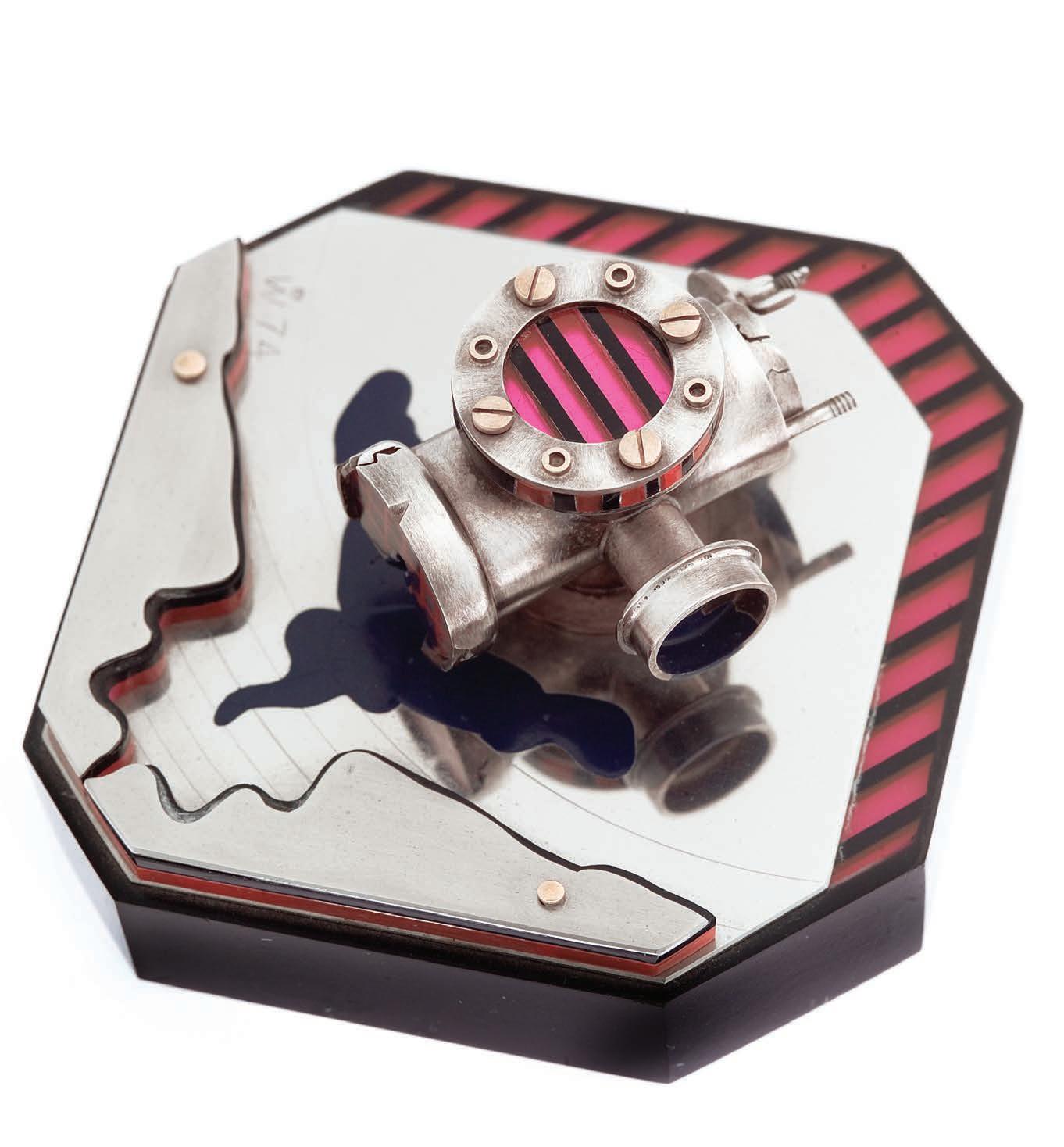
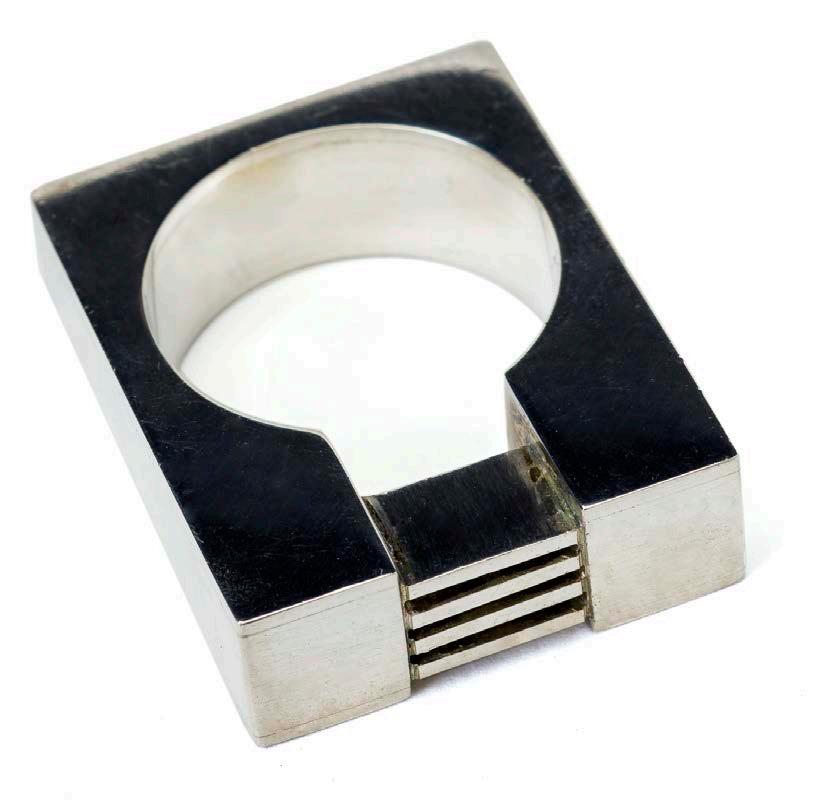
116 MELBOURNE MODERN
Opposite top Wolfram Wennrich, Object, 1974, silver, acrylic, steel, brass, 7.7 x 7.7 x 4.7 cm, RMIT University Art Collection: W.E. McMillan Collection
Opposite bottom
Tor Schwanck, Untitled (ring), n.d, sterling silver, 3.0 x 2.3 x 0.7 cm, RMIT University Art Collection: W.E. McMillan Collection
Top Hendrik Forster, Coffee service, 1984, sterling silver and red gum, tray: 24.6 x 41.0 x 3.3 cm, milk jug: 12.5 x 10.0 cm x 7.9, sugar bowl: 13.3 x 10.0 x 7.9 cm, coffee pot: 26.5 x 18.5 x 10.3 cm, Hamilton Gallery Collection
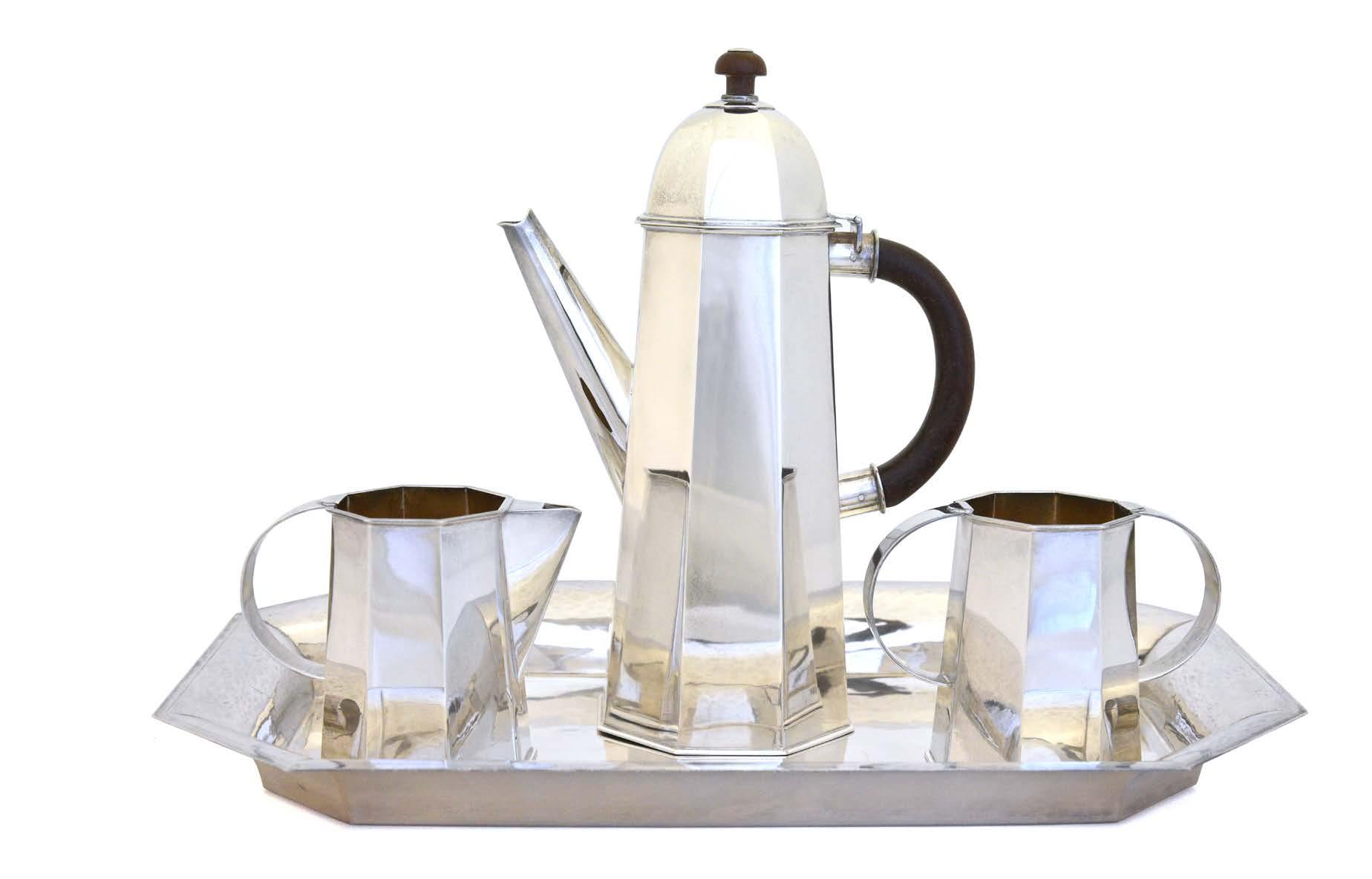
Bottom Ernst Fries, Pair of candleholders, c. 1974–75, sterling silver, 3.9 x 6.2 x 6.2 cm each, private collection

MELBOURNE MODERN 117

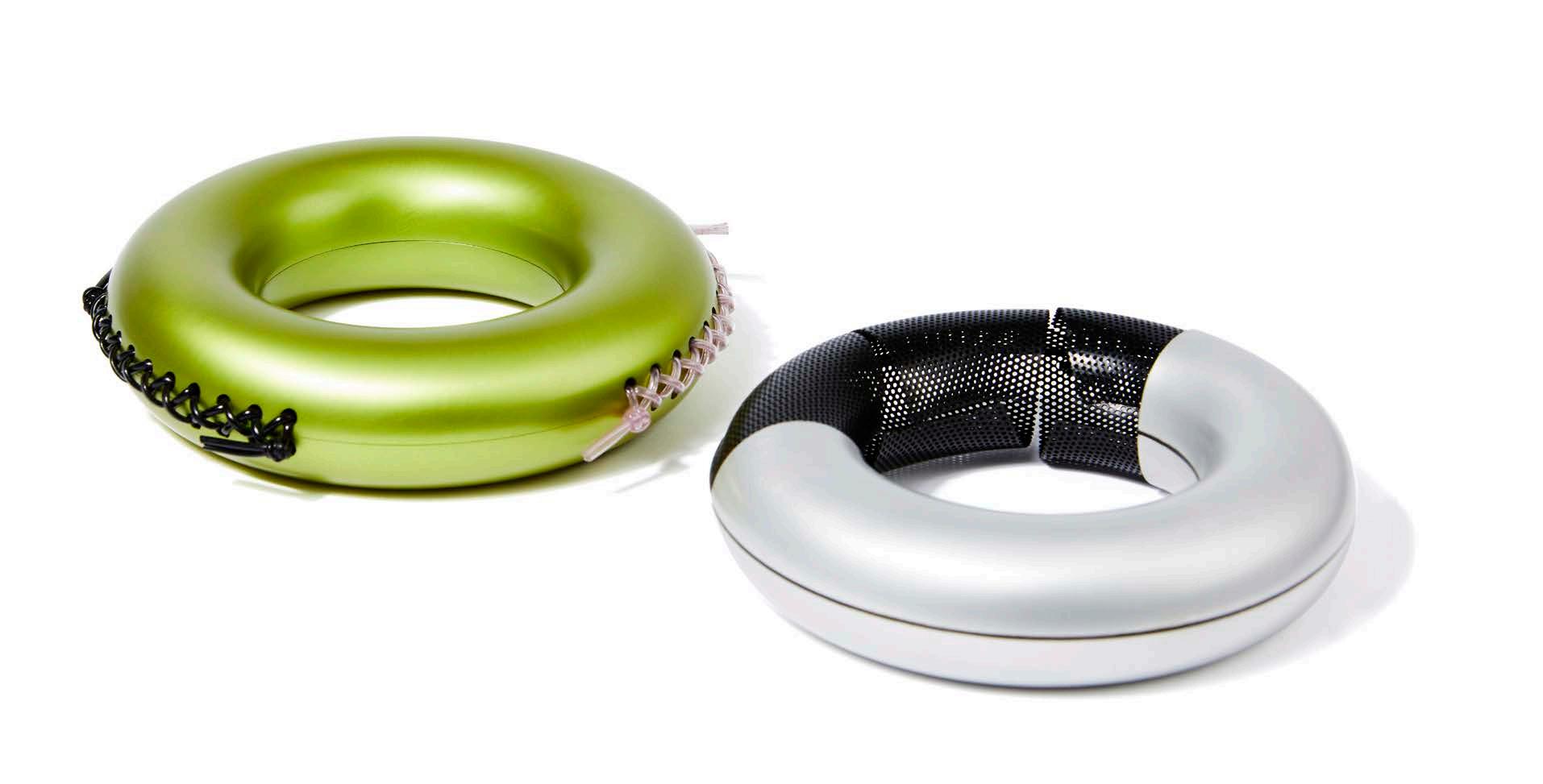
118 MELBOURNE MODERN LEGACIES
Opposite top Su san Cohn, Cohncave bowl designed 1990, in production 1992, powdercoat steel, stainless steel, 7.5 x 48.0 x 48.0 cm, made by Alessi, Crusinallo, Italy, courtesy of the artist and Anna Schwartz Gallery

Opposite bottom Su san Cohn, Doughnut bracelet (Bound series), 1983, anodised aluminium, plastic binding, 3.2 x 13.0 x 13.0 cm, and Doughnut bracelet (Torn Mesh series), 1988, anodised aluminium, edition 7/7, 3.0 x 13.0 x 13.0 cm, courtesy of the artist and Anna Schwartz Gallery
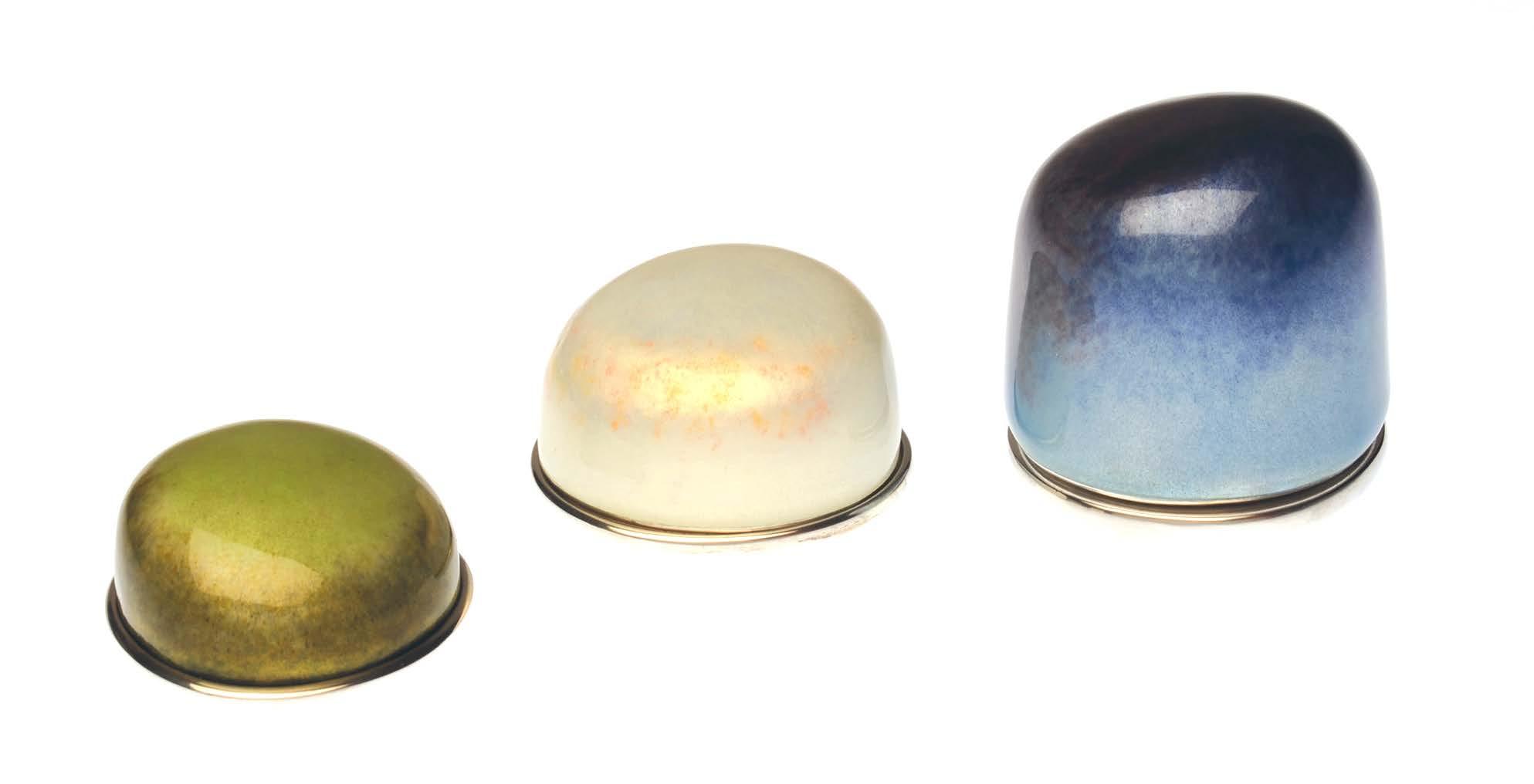
Top Helen Aitken-Kuhnen, Green Box, White Box, Blue Box, 1978, sterling silver, enamel, tsavorite, tourmaline, sapphire, green: 2.0 x 4.8 x 4.8 cm, white: 3.0 x 4.8 x 4.8 cm, blue: 5.0 x 4.8 x 4.8 cm, collection of the artist
Bottom Johannes Kuhnen, Tureen and Ladle, 1984, sterling silver, anodised aluminium and felt, 35.5 x 50.1 x 48.4 cm, National Gallery of Victoria
MELBOURNE MODERN 119
Vodicka also appointed two Czechs: master die-sinker and medallist Emil Hafner, who taught engraving and gemsetting until the early 1990s, and medallist, sculptor and jazz musician George Friml, who designed a number of Hafner Mint medallions and taught sessionally at RMIT until Vodicka retired in 1985.6 Robert Baines attests to Hafner’s significance in terms of transferring technical expertise, although his work was far from modernist.7
A significant number of Germans taught into the programme. Zurich-trained Ernst Fries, from Wurzburg, came to Vodicka’s attention c. 1962 when he enrolled as a night-student to familiarise himself with the English terms for silversmithing, studying under Robert Cunningham. When Fries began working as a freelance silversmith, in 1965, he effectively competed with Vodicka for ‘bread and butter’ church-ware commissions (Vodicka having long worked in this capacity for Albion Plate), distinguishing his work with heavily textured surfaces.8 At Vodicka’s invitation, Fries taught parttime at RMIT from 1968 to 1974 while Vodicka’s former pupil, Christopher J. McWaters, taught full-time during the same period (1969–1981). During these years Fries completed some major commissions including a tabernacle in cloissoné ware for the Monash Religious Centre, 1968, and a mural in vitreous enamel, titled Progress of Medicine, 1970, for the foyer of the Medical School, University of Melbourne (both commissioned by architects Mockridge, Stahl and Mitchell). Peter Gertler recalled that the input of ‘practioners from the trade’, such as Fries, ‘was primarily in a practical sense and gave us insight into how to apply what we experienced on a broader scale’.9 It also provided a model of the gold and silversmith as a working professional, engaged in the public sphere.

Hendrik Forster taught full-time in 1981 and 1983-85. Forster had studied under Franz Rickert and Hermann Jünger at the Munich Academy of Fine Arts and there gained an appreciation of the simple forms of English Georgian silverware, as reflected in the coffee-service he completed while teaching at RMIT in 1984.10 Among his commissions during his RMIT years was Australia’s official wedding gift to Prince Charles and Lady Diana, consisting of a boxed set of 20 octagonal silver plates.11 Forster’s work is invariably
simple and utilitarian and often combines silver with more vernacular media such as red gum. Notable among those who studied under Forster and Baines are Ian Ferguson, who ran the metal workshop at the Meat Market before completing an MFA at the Royal College of Art (RCA) and a doctorate at Oxford, later returning to RMIT to do postdoctoral research on Japanese wood grain texture in metals, and Chris Sherwin, who worked in Germany after his Diploma in 1984 before returning as a part-time lecturer, 1989-1999, and becoming a founding member of the Gold and Silversmiths Guild of Australia.
Johannes Kuhnen, from Essen, Germany, arrived in Melbourne in 1981 along with his Australian-born wife, enamellist Helen. Kuhnen had been apprenticed to the pioneering kinetic jewellery artist Friedrich Becker, 1969–73, before studying formally under Becker and Sigrid Delius at the Fachhochschule für Gestaltung, Düsseldorf, 1973–78. Aitken-Kuhnen had gained her Diploma in gold and silversmithing from RMIT in 1975, under Wennrich, before travelling overseas. She was a guest student at the Fachhochschule für Gestaltung in 1977, completed a Graduate Diploma at Middlesex Polytechnic, London, in 1978, and worked with Herbert Schulze and Kuhnen in Düsseldorf, 1978–81. Vodicka invited Kuhnen to teach sessionally in 1982 and at the same time Forster asked Aitken-Kuhnen to teach enamelling. Kuhnen taught for one year before moving to Canberra, where he was appointed lecturer at ANU. AitkenKuhnen commuted between Melbourne and Canberra, teaching at RMIT until 1989. In Melbourne in 1981–82 the pair rented space in Flinders Lane at Workshop 3000, established in 1980 by then recent graduates Su san Cohn and Marian Hosking with RMIT technician and former toolmaker Harry Rowlands. At Workshop 3000 Kuhnen taught Cohn the technique of anodised aluminium (Rowlands had previously shown Cohn how to work with aluminium but until then she had to send her work out to be coloured). Kuhnen and AitkenKuhnen continued to exhibit regularly in Melbourne at the Meat Market and Gallery Funaki (Aitken-Kuhnen showing pâte de verre as well as enamelled silver jewellery) and extensively overseas in Berlin, Düsseldorf, Munich, London and Kyoto.
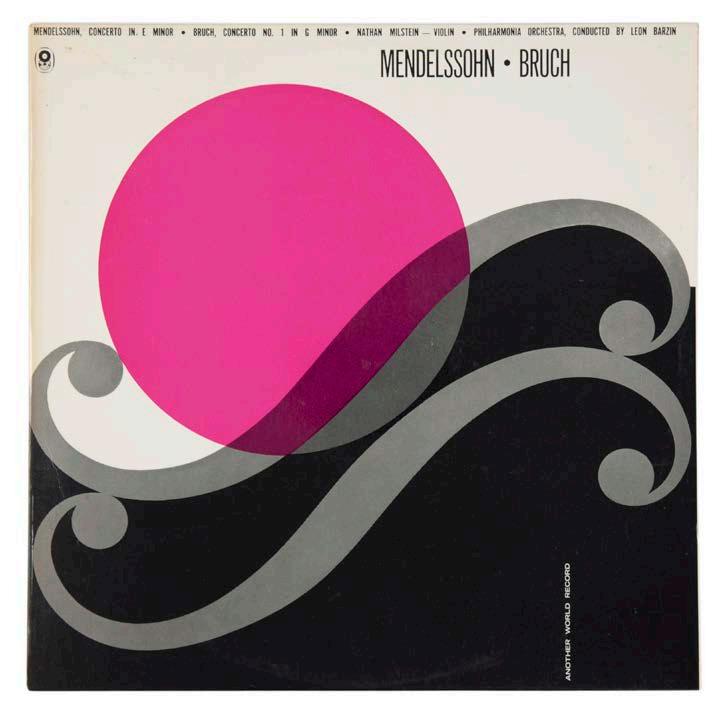
120 MELBOURNE MODERN
Subsequent heads of the gold and silversmithing programme and many of their teaching staff were students of Vodicka’s and Wennrich’s – continuing the legacy of the émigrés. Ray Stebbins succeeded Vodicka in 1984. Stebbins studied at RMIT and gained his Diploma of Art, 1966–68, and Fellowship Diploma (gold and silversmithing), 1970–71, before completing a Masters at the RCA, London, 1978–80. The RCA then only accepted one international application per year but Vodicka encouraged Stebbins to apply and acted as referee.12 Stebbins aligned himself with a group of contemporary British silversmiths, including Stuart Devlin (Vodicka’s exceptional Diplomate of 1957), who advocated the use of texture to give tactile pleasure to such domestic items as beakers and boxes. At RMIT Stebbins developed Australia’s first postgraduate and off-shore gold and silversmithing programmes, curated many exhibitions that toured internationally, and in 1991 was appointed Australia’s first Professor of gold- and silversmithing. Carlier Makigawa studied in Perth before becoming Stebbins’s first Masters candidate at RMIT, lecturing from 1985 to 1999 and succeeding Stebbins in 1998. She resigned shortly afterwards to care for her terminally ill husband (sculptor Akio Makigawa). Robert Baines succeeded Makigawa as programme coordinator in 1999. Baines had also studied under Wennrich in the late 1960s and through him learnt about the ancient technique of granulation, used by Greek and Etruscan goldsmiths, thereby setting Baines on his career-long path of investigating ancient jewellery production. Subsequent studio leaders Mark Edgoose and Kirsten Hayden have in turn studied under Vodicka and Baines respectively while Wayne Guest, who graduated in 1974 under Vodicka, was influential as a part-time lecturer at RMIT from 1999 to 2014. Thus there has been an unbroken lineage of RMIT alumni leading the gold and silversmithing programme since 1984, generating a discernible legacy from the émigré silversmiths who preceded them.
In industrial design Gerard Herbst introduced broad-ranging modernist thinking as opposed to any particular modernist style. He challenged students to conceive of design as an integral force with the ability to shape society for better or worse. Through innovative films, made with the RMIT film
Opposite left Gus van der Heyde, Mendelssohn and Bruch Violin Concertos (World Record Club album cover), c. 1961–62, ink, cardboard, letterpress printing, 37.0 x 37.0 cm, RMIT Design Archives: World Record Club Collection
Opposite right Gus van der Heyde, Tchaikowsky: Piano Concerto No. 1 (World Record Club album cover), c. 1961–62, ink, cardboard, letterpress printing, 37.0 x 37.0 cm, RMIT Design Archives: World Record Club Collection
Left Adrianus Janssens (designer and cutter), Marian Swinton (textile design), Robert Maltus (fashion house), All Wool Poncho, c. 1960s, wool, centre front: 53.5 cm, sleeve length: 31.0 cm, chest: 102.0 cm, RMIT Design Archives: Robert Maltus Collection

and television unit, and exhibitions of staff and student work at the NGV and the Australian Design Centre that aimed to raise public awareness of design, Herbst help lift industrial design from mere applied art to a more holistic conception of design for life. He railed against fashionable product design produced only in a ‘lust for novelty and spurious profits’, and perennially cautioned against excessiveness and wastefulness in design.12 Years later former graduate Phillip Zmood wrote to Herbst, informing him of his activities with General Motors in the US and setting up a design studio in Shanghai, and wrote appreciatively: ‘the years I studied with you were excellent preparation’.13 Zmood, Bruce Hall, Robert Pataki and Geoffrey Putnam were among the many graduates of Herbst’s who went on to make significant contributions to industrial design in Australia.
Post-war émigrés were also employed to teach graphic design, fashion and textiles at RMIT but their legacy is less immediately evident. Dutchman Gus van der Heyde taught graphic design from 1965 until the early 1990s and was responsible for the clean, elegant layout of course prospectuses and posters issuing from the Schools of Art and Architecture; his influence on students has not yet been the subject of research. Scottish textile artist Marion Fletcher taught modern art embroidery and fashion illustration for eighteen years before becoming curator of textiles at the NGV and a pioneering historian of Australian fashion. These latter aspects of her career were, arguably, more influential on subsequent generations than her teaching at RMIT. Jenny de Nijs, from Vienna, taught for twenty-five years but her legacy is likewise more evident in her publications on fashion history and the history of women designers in Australia. Adrianus Janssens, on the other hand, left an indelible impression on Denise Sprynskyj and Peter Boyd when they were third-year students of his in 1992. Sprynskyj recalls Janssens’s passion for tailoring led his students to christen him ‘the Karl Lagerfeld of Melbourne’.14 Janssens was ‘always to be found drafting a jacket or a tailored dress’ in the studios in Building 8, and students ‘learnt by watching him press a tailored jacket or pin and ease a sleeve into the body of a jacket’.15 When Sprynskyj and Boyd established their label S!X in Flinders Lane, shortly after graduation, ‘Adrie’ – as
MELBOURNE MODERN 121
Opposite left Geoffrey Bartlett, FJ Holden, 1982–83, bronze, steel, cast iron, 200.0 x 90.0 x 40.0 cm, courtesy of the artist and Australian Galleries
Opposite right Anthony Pryor, Standing Figure I, 1984, European pine, 190.0 x 46.0 x 32.0 cm, RMIT University Collection
Opposite bottom Augustine Dall’Ava, Tranquility Screen, 1978, mahogany, fruitwood, pencil, pine, steel, stainless steel, brass, stones, shell, jute, linen thread, 183.0 x 335.0 x 31.0 cm, collection of the artist
they called him – ‘would always visit to assist us with the jackets, pants and dresses for our clients’. Janssens also later supervised Sprynskyj’s Masters thesis from 1995 until his death in 2000.
Émigrés played a noticeably lesser role in the teaching of painting at RMIT. Instead European influences came through a complex web of factors including the experiences of many of the teaching staff who had spent extended periods in Britain, Spain and Italy, the presence of younger émigré artists such as George Baldessin among the student body, and the teaching of European art history by Margaret Plant (then recently returned from study in London and Bern) and Czech art historian Miloslav Zika. Also playing a part was the increasing literature on and by the interwar European avant-garde, such as Josef Albers’s Interaction of Colour (Yale, 1963), which Normana Wight read in the State Library of Victoria in 1967 just before returning to RMIT to undertake the Fellowship Diploma. In addition the painting school in the 1960s and ‘70s was not only visually literate in European modernism but also attuned to European music, from medieval to modern; this shared interest connected an otherwise disparate collection of staff and students and continues to the present day, as in the work of Peter Ellis.
The printmaking department, on the other hand, was markedly European. Tate Adams, George Baldessin, Udo Sellbach and Hertha Kluge-Pott each played leading roles either as heads of department (Adams and KlugePott) or senior lecturers. Each of the staff during these years contributed to the much-vaulted Australian print renaissance of the 1960s and helped professionalize the discipline. In 1966 painter-printmakers and co-exhibitors Sellbach and Grahame King, whose work was profoundly shaped during his post-war years in London, together with Ursula Hoff from the NGV, were instrumental in setting up the Print Council of Australia. In the same year Adams set up the Crossley Gallery to showcase his students’ works and soon afterwards, with Baldessin, established the Crossley Print Workshop and then the Lyrebird Press. Ventures such as these created opportunities for employment and for exhibition for graduates of the printmaking course. Fran van Riemsdyk, for instance, worked with Baldessin at the Crossley
Print Workshop, 1974–75, while completing her Fellowship Diploma in printmaking. She has taught sessionally at RMIT in printmaking and painting since 1977. Kluge-Pott also represents a continuation of European influence: having trained initially in Berlin, she then studied under Adams and later returned as a lecturer and studio coordinator, 1980–94. Through these cycles of study-leave-return-to-teach there has been a steady European presence in the printmaking studio since the 1960s.
Similarly, sculpture at RMIT was overtly a European concern with Lithuanians and Germans dominating the teaching over three decades, 1956-87. A strong focus on materials and craftsmanship can be traced in the work of many graduates from this era. This was evident in 2003 at the exhibition Sculpture at RMIT during the Jomantas years 1961–1987; Gus Dall’Ava observed of the work on display: ‘what is obvious is the great understanding of material and how to use it’.16 Both Dall’Ava and Anthony Pryor’s use of hand-carved timber in their early post-RMIT years reflects this concern for material and craftsmanship. Their colleague Geoffrey Bartlett initially rejected this emphasis on materials, instead wanting to explore sculpture’s potential to define spatial relationships. However, upon visiting the Centre Five exhibition at Geelong Gallery in 1974, he was struck by Zikaras’s melancholic table top sculpture, View From My Window, with its surreal juxtaposition of giant hands and small figures on a stage-like platform.17 A memory of this work remained with him and emerged in Bartlett’s FJ Holden, 1982–83, which similarly combines pictorial elements of differing scales and arranges them as if under a proscenium arch. The European legacy, initially suppressed, returned unexpectedly.
With the retirement of Jomantas in 1987 came a significant shift in the programme. Installation – or ‘sculpture in the expanded field’ as Rosalind Krauss put it – was at last permitted and even encouraged under the new guard of Robert Owen, Peter Cripps, Terri Bird, Bianca Hester and Kate Daw. However, this did not mean a complete rejection of the earlier émigré legacy. Cripps recalls appreciatively the Bauhaus-inspired design projects that Inge King set students and acknowledges the design focus and formality of his
122 MELBOURNE MODERN

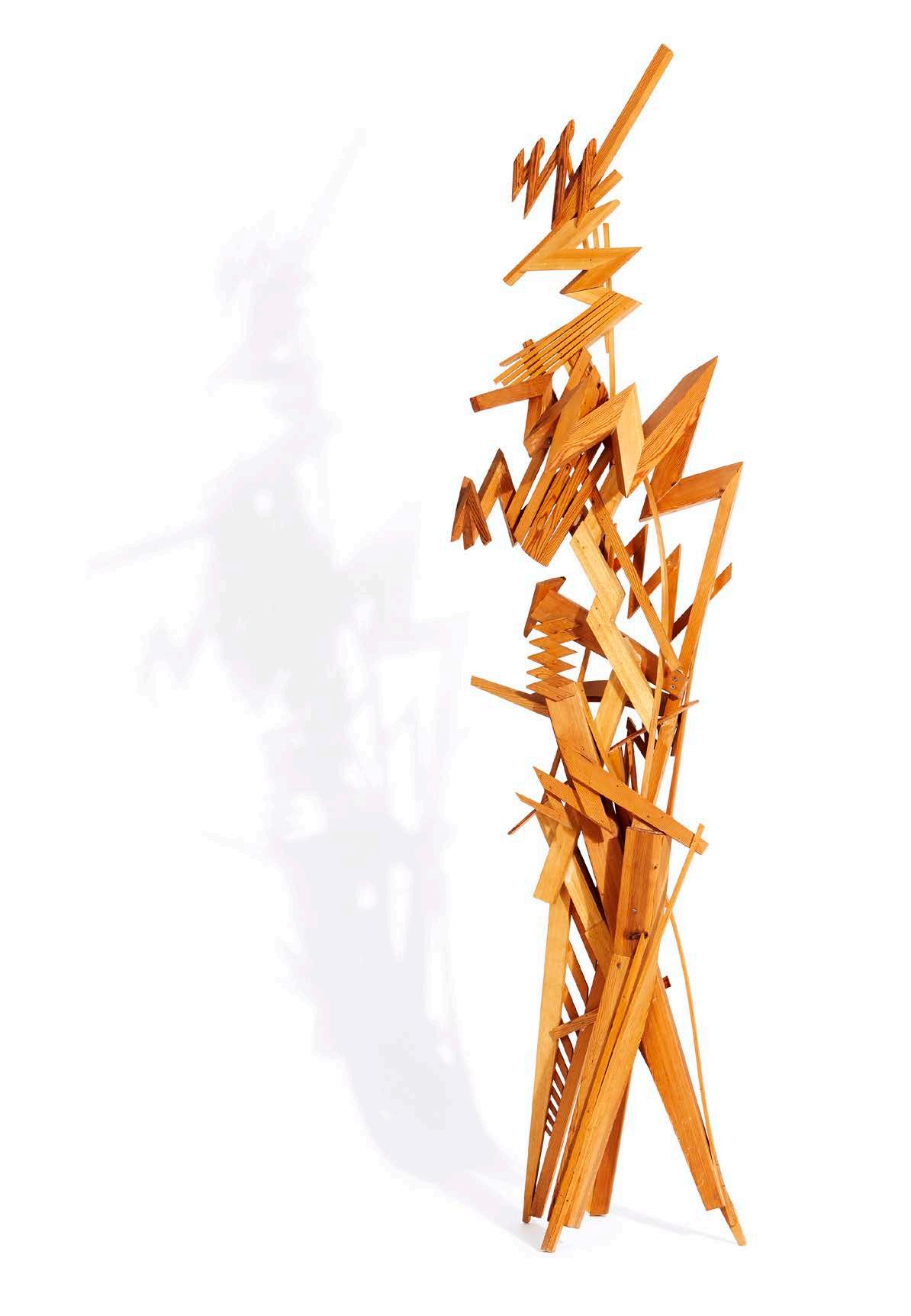
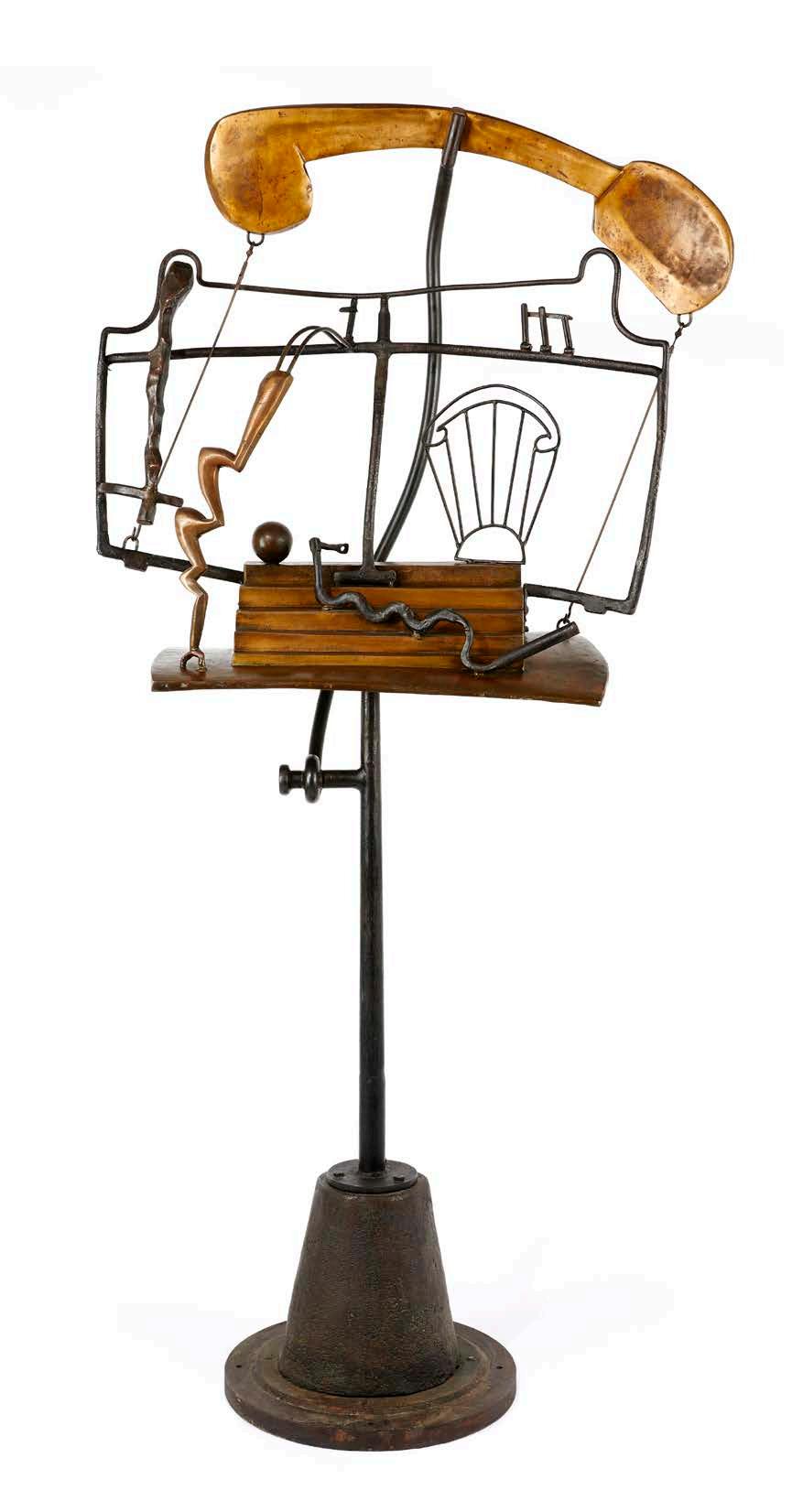
MELBOURNE MODERN 123
Above Robert Owen, Fallen Light, 2012, stainless steel, 120.0 x 120.0 x 120.0 cm, courtesy of the artist and ARC ONE Gallery, Melbourne.

Opposite above Robert Owen, Origami #8A (from the Terminus series), 1993, synthetic polymer paint on canvas, 122.0 x 122.0 cm, courtesy of the artist and ARC ONE Gallery, Melbourne.
Opposite below Jock Clutterbuck, Niagara, 1970, aluminium, 135.5 x 183.8 x 116.2 cm, National Gallery of Victoria.
work was inherited from Jomantas.18 He also perceives that Jomantas, King, Zikaras and their Centre Five colleagues were concerned with contributing to society and felt a responsibility to educate the public about modern sculpture.19 Cripps connects this social utopian aspect of their work to earlier Bauhaus and Constructivist philosophy, which has in turn long engaged him and inspired much of his own work.
Robert Owen studied sculpture under Lyndon Dadswell at the National Art School, Sydney, and so came to RMIT without any direct experience of the émigré sculptors who preceded him. Owen brought a ‘Europeaness’ of a different order, garnered during twelve years living abroad in Greece, on the island of Hydra (alongside expatriate writers George Johnson and Charmian Clift) and in London, where he mixed with a small group of British Constructivists including Victor Pasmore and Anthony Hill for whom he worked as an apprentice. Owen’s practice is research-oriented: whether investigating the use of diffraction grating tape in art or computer graphics modelling, he approaches his work in a spirit of inquiry. During his tenure as head of sculpture at RMIT, from 1988–2001, he developed a significant body of work based on Constructivist collaged grids of origami paper that he enlarged and painted both on canvas and on walls as mural installations. These grids were also pulled into threedimensions, resulting in an on-going series of sculptures. While representing a break with his émigré predecessors, Owen consciously engaged with earlier Russian and British Constructivist art and in so doing brought students in contact with a rich vein of European modernism.
Emily Floyd studied at RMIT, 1997–99, and began by making large-scale installations. In part this reflected the direction set by Owen and Cripps but it also responded to the ideas regarding space and materiality being explored in the sculpture programme with such influential teachers as Bird, whose grasp of continental philosophy – particularly Deleuze – were crucial, Bird’s collaborator in Open Spatial Workshop (OSW) Hester (with whom, coincidentally, Floyd shared Hungarian heritage), Daw and Callum Morton. Danius Kesminas used also occasionally to visit; having graduated from RMIT sculpture in 1989, Kesminas was then developing an exciting practice that crossed installation, performance
124 MELBOURNE MODERN
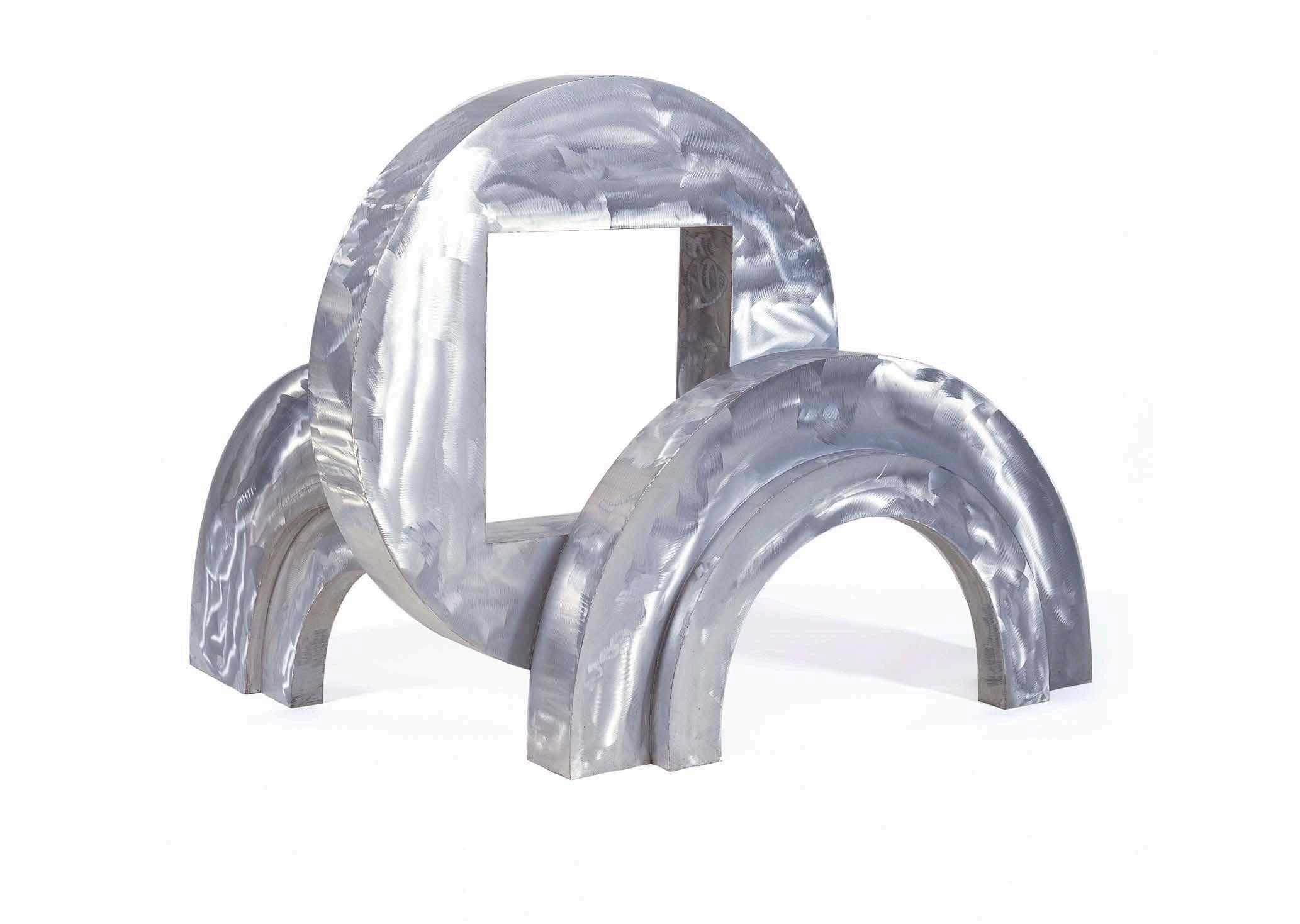
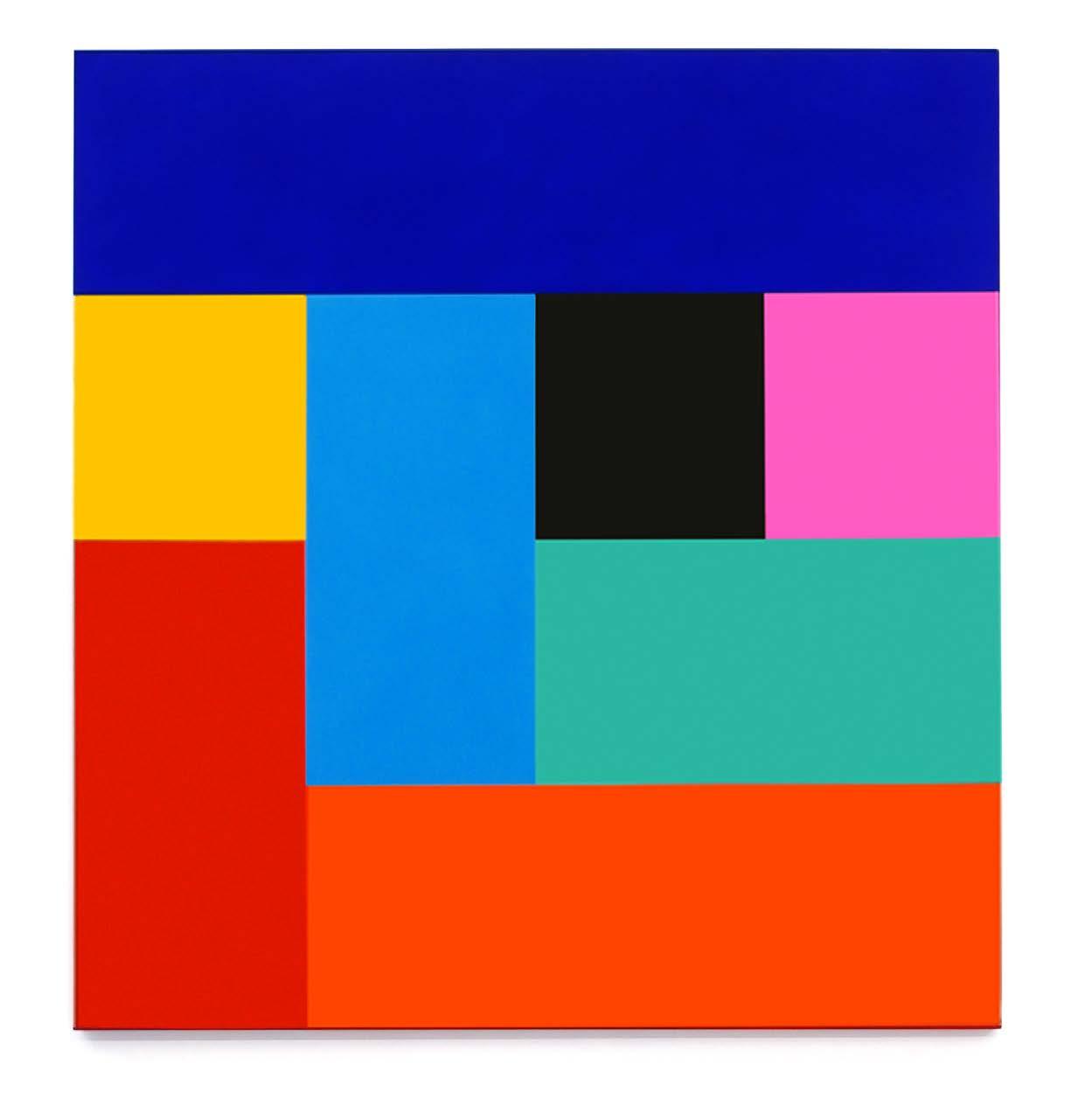
MELBOURNE MODERN 125
and music and interrogated his Lithuanian inheritance. However, Floyd’s interest in the making of three-dimensional objects used within each installation produces an oscillation with the work identifiable as both sculpture and installation. As she put it in 2006: I think of installation now as something now very institutional. But I was trained by people like Peter Cripps and Robert Owen, who would have seen installation as a really radical project… I like the idea of surprise and I have always thought my installations were very sculptural, that they dealt with the object as much they were as a discussion about space.20 Floyd therefore represents something of a full circle: sculpture’s return from the expanded field to the obdurate object. Given this, it is unsurprising to learn that Inge King held Floyd’s work in high regard; Jomantas and Zikaras, had they lived long enough, would likely have concurred.
Sculpture as practiced today by recent RMIT alumni remains resolutely involved with the physical object but set within a conceptual framework that frequently entails notions of play. Sanné Mestrom creates large-scale sculptures for public spaces designed to probe or ‘soften’ the separation between art and life through play. Her Black Paintings, 2018, are neither paintings nor black; rather, they are soft tapestries of raw, unspun, undyed wool, stretched over steel frames to stand upright as if free-standing screens. Responding to Frank Stella’s eponymous works of 1958-60, they seem to refute Stella’s contention that ‘a sculpture is just a painting cut out and stood up somewhere’, while paying homage to Anni Albers’s pioneering Bauhaus weavings and engaging with a long post-war discourse on art and architectural integration. Fleur Summers’s Supreme Red Rods and Rectangles, 2019, similarly engages playfully with Malevich’s Suprematist Composition (with Eight Red Rectangles), of 1915, which the artist later rejected on account of it looking too much like an aerial perspective of buildings rather than an entirely abstract work. Summers renders the red rectangles in three-dimensions and invites viewers to arrange them at their will. On the wall nearby is video footage, shot from above, of hands re-ordering a miniature set of red rods – presenting the work from precisely
Opposite Emily Floyd, Steiner Cave, 2014, two-part epoxy paint on aluminium, dimensions variable, largest unit 173.0 x 300.0 x 60.0 cm, courtesy the artist and Anna Schwartz Gallery.
Left Fleur Summers, Supreme Red Rods and Rectangles, 2019, painted wood, 5 minute digital video loop, dimensions variable, collection of the artist.
the same aerial perspective that Malevich deemed too illusory. The wooden rods also recall Cuisenaire rods, the educational mathematics toys that Summers remembers using as child, and – more specifically – Montessori ‘red rods’, which are used to develop children’s spatial understandings. Similarly Antonia Sellbach employs stained timber building blocks, akin to Steiner toys, in her participatory tabletop sculptures. These emerged through the observation that people are drawn to geometric objects when they are talking – that they can be aides to conversation and communication. Shared concerns with play, with early twentieth century progressive educational philosophies and modernist aesthetics, with audience participation and with communication and social engagement are evident in each artists’ work. Such works interrogate earlier European modernisms, but also stem from a lineage of European émigré influences in the RMIT sculpture programme.
The European émigré legacy at RMIT translated differently across the various disciplines in art and design. Its impact can best be described as diffuse in some areas, such as painting, and more clearly discernible and tangible in others, such as sculpture and gold and silversmithing. Gerard Herbst and Frederick Sterne, however, are still held in high esteem by their respective programmes for their pioneering efforts to professionalise industrial design and interior design respectively. Subsequent waves of migration, coupled with post-war expatriatism and the now standard osmosis of global exchange, complicate this narrative – introducing new generations of émigrés and competing notions of modernism. Melbourne Modern is but an early, exploratory attempt to unravel these myriad narratives. Much further work is needed, both to document and interrogate RMIT’s institutional history and to better understand the contributions made by post-war émigrés to the teaching of art and design in Australia.
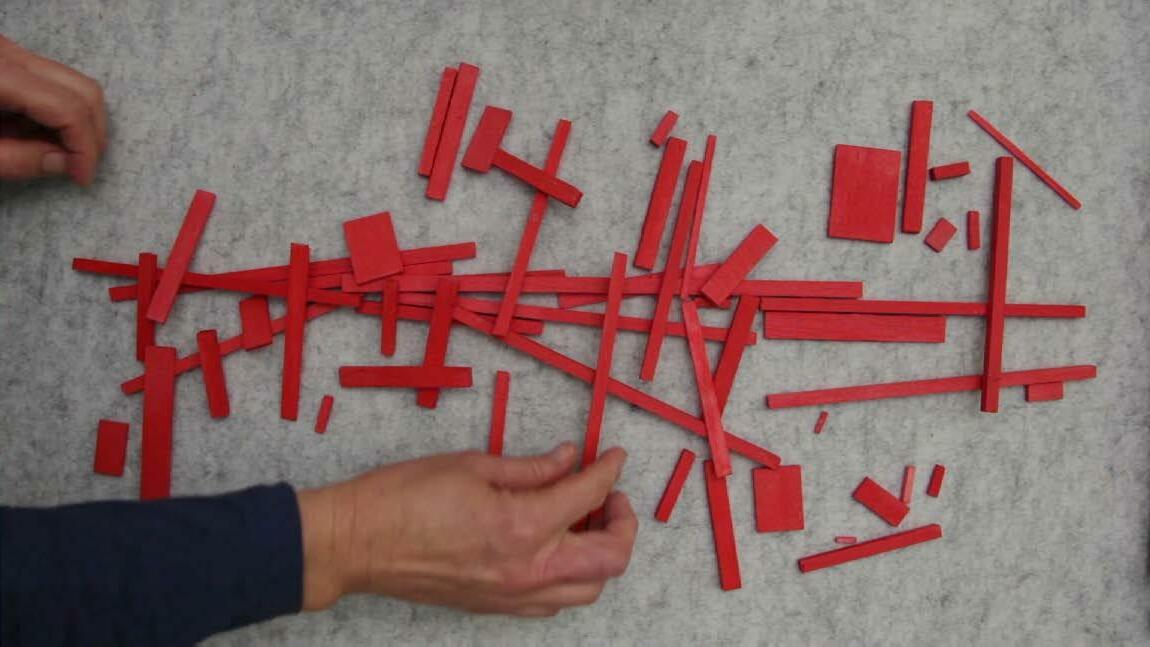
126 MELBOURNE MODERN

Above on right Sanné Mestrom, Black painting V, 2018, unspun, undyed wool tapestry, steel, 235.0 x 141.0 x 51.0 cm, McClelland Sculpture Park+Gallery

128 MELBOURNE MODERN
1 Telephone conversation with Su san Cohn, 30 April 2019; letter from Peter Gertler to Jon Buckingham, RMIT, 15 April 2019.
2 The exhibition also toured to Sydney, where it was shown at the Lord of the Rings Gallery; Patricia Anderson, Contemporary Jewellery in Australia and New Zealand, Sydney: Craftsman House, 1998, 29.
3 Peter Gertler to Jon Buckingham, RMIT, 15 April 2019.
4 Margaret Vine, ‘Jewellers and Jewellery: European trained, made in Australia’, in Roger Butler (ed.), The Europeans. Émigré artists in Australia 1930–1960, Canberra: National Gallery of Australia, 1997, 203.
5 Ann Galbally, ‘It’s now a period of re-thinking’ (includes a review of Tor Schwanck’s exhibition at Strines Gallery), The Age, 25 November 1970, 2.
6 Interview with Ernst Fries, Yarra Glen, 15 July 2018.
7 Peter Gertler to Jon Buckingham, RMIT, 15 April 2019.
8 Judith O’Callaghan, ‘Ragnar Hansen and Hendrik Forster: two recent acquisitions in contemporary Australian silver’, Art Bulletin of Victoria, no. 24, 1983, 69. Forster taught at RMIT in 1981 and from 1983 to 1985.
9 ‘Australian silver for the wedding’, The Herald, Melbourne, 13 July 1981.
10 Ian Armstrong, ‘Emil Hafner – Master Diemaker and Medal Maker’, Queensland Numismatic Society Magazine, November 2012, 9-14; also email communication from Hendrik Forster, 8 April 2019.
11 Conversation with Robert Baines and Kirsten Haydon, RMIT, 26 February 2019.
12 Preface to Exhibition of Contemporary Domestic Silver by Raymond Stebbins, Melbourne: Kozminsky Gallery, 1982, n.p.; also telephone conversation with Ray Stebbins, 7 June 2019..
13 Gerard Herbst, ‘Formgestaltung in Australia’s Sixties: A Homage to Victor Greenhalgh, Principal of RMIT School of Art/Design, 1955-1965’, unpublished typescript, c. 1999, RMIT Design Archives, Herbst collection.
14 Phillip Zmood to Gerard Herbst, 27 September 1998, single page manuscript, RMIT Design Archives, Herbst collection.
15 Denise Sprynskyj, unpublished notes on Adrianus Janssens for RMIT Gallery, April 2019.
16 Ibid.
17 Gus Dall’Ava, Roundtable discussion of the Jomantas years at RMIT, 25 September 2003, unpublished typescript, RMIT Gallery, 20.
18 Teisutis Zikaras, View From My Window, c. 1973, bronze, brass, aluminium and wax, dimensions and present whereabouts unknown; illustrated in Centre 5, Geelong, Vic.: Geelong Art Gallery, September 1973, [14]. Interview with Geoffrey Bartlett, University of Melbourne, 10 April 2019.
19 Interview with Peter Cripps, RMIT, 2 August 2017.
20 Ibid.
21 Emily Floyd quoted in Megan Backhouse, ‘Floyd’s cultural landscapes, as she saw them’, The Age, 17 October 2006, URL: https://www.theage.com.au/entertainment/art-and-design/ floyds-cultural-landscapes-as-she-saw-them-20061017-ge3cof. html (accessed 23 April 2019).
MELBOURNE MODERN 129 ENDNOTES
All measurements are in centimetres, height x width for two-dimensional objects and height x width x depth for three-dimensional objects.
Tate Adams (1922–2018)
Bartley’s Body (illustration to Riders to the Sea by J.M. Synge), 1962
Linocut printed in colour inks Trial proof, 1/7
Image: 56.0 x 42.0 Private collection
Tate Adams (1922–2018) Clown, 1962
Linocut printed in colour inks from five blocks Edition 4/50
Image: 76.2 x 51.0; sheet: 88.4 x 63.8 Purchased, 1964 National Gallery of Victoria
Tate Adams (1922–2018)
Riders to the Sea by J.M. Synge, illustrated by Tate Adams, 1969 Limited edition book published by Dolmen Press, Dublin Edition of 750 State Library Victoria
Helen Aitken-Kuhnen (1952–) Green Box, White Box, Blue Box, 1978 Sterling silver, enamel, tsavorite, tourmaline, sapphire Green: 2.0 x 4.8 x 4.8; white: 3.0 x 4.8 x 4.8; blue: 5.0 x 4.8 x 4.8 Courtesy of the artist
The Argus newspaper
Gerard Herbst (centre) with MTC in dustrial design students David Seaton, Paul Warner and Harold Richardson studying their designs for Melbourne Olympic Games posters, 1950
Three press photographs 9.5 x 7.2 each
Gift of Gerard Herbst, 2007 RMIT Design Archives: Gerard Herbst Collection
Robert Baines (1949–) Brooch and Ring, 1970 Silver, corundum, rhodium plate Brooch: 5.0 x 6.7 x 1.2; ring: 3.8 x 2.6 x 1.3
Acquired through the Puzsar Prize, 1970 RMIT University Art Collection: W.E. McMillan Collection
George Baldessin (1939–78)
Factory Smoke, 1968 Etching, aquatint Artist’s proof 10
Image: 50.4 x 51.0; sheet: 67.0 x 69.0
Estate of George Baldessin courtesy Australian Galleries
George Baldessin (1939–78)
Monument to the Third Architecture, 1971 Aluminium 190.0 x 95.0 x 91.4
Presented by Comalco Ltd, Melbourne, 1980 National Gallery of Victoria
George Baldessin (1939–78) Performance II, 1965 Etching, aquatint Edition of 10 Image: 30.9 x 30.4; sheet: 41.6 x 41.0 Estate of George Baldessin courtesy Australian Galleries
Geoffrey Bartlett (1952–) FJ Holden, 1982–83 Bronze, steel, cast iron 200.0 x 90.0 x 40.0
Courtesy of the artist and Australian Galleries
Geoffrey Bartlett (1952–) Installation documentation (Point Lonsdale and RMIT School of Art rooftop), 1973 Gelatin silver photographs (4) (a) 28.5 x 38.0; (b) 30.3 x 37.9; (c) 27.0 x 36.5; (d) 25 x 36.1
Courtesy of the artist and Australian Galleries
Nicholas Bastin (1968–) Head Hunter Action Figure and Weapon, 2004 Silver, ebony, resin, acrylic, silk, paint 8.5 x 8.5 x 6.5
Acquired through the Diana Morgan RMIT post graduate Gold and Silversmithing Prize RMIT University Art Collection: W.E. McMillan Collection
Richard Beck (1912–85) Olympic Games Melbourne, 22 Nov – 8 Dec 1956, 1956 Colour lithograph, photo-lithograph Image: 95.2 × 60.0; sheet: 106.0 × 65.2 Purchased, 1993 National Gallery of Victoria
Francis Campbell (fl. 1960s) – designer
Donald Roderick (Rod) Clarke (1927– ) – designer
Francis Difford (fl. 1960s) –photographer
Lindsay Edward (1919–2007) – designer
Gerard Herbst (1911–2011) – designer
Gus van der Heyde (1937–) – designer
Art & Design: Royal Melbourne Institute of Technology School of Art (prospec tus), c. 1973-74
Prospectus published by RMIT, stapled at spine 18.4 x 24.9 (closed)
Gift of Peter Vodicka, 2018 RMIT Design Archives: Victor Vodicka Collection
Peter Clarke (1935–)
Elegy, 1975 Acrylic on canvas 75.8 x 75.8
Purchased by the RMIT School of Art, 1979
RMIT University Art Collection
Jock Clutterbuck (1945–)
Niagara, 1970 Aluminium 135.5 x 183.8 x 116.2
Presented as the winner of the Captain Cook Bicentenary Award for Sculpture, 1970
National Gallery of Victoria
Jock Clutterbuck (1945–)
Stone Wave Landscape, 1973 Etching, aquatint with marbling on Torinoko Paper Edition 2/15
Image: 48.5 x 113.0 (irreg.); sheet: 72.5 x 122.0
Donated through the Australian Government’s Cultural Gifts Program by Dr Douglas Kagi, 2012
RMIT University Art Collection
Terry Cockrem (1981–) Teapot, 2002
Silver plated gilding metal, rubber, steel ball bearings 15.5 x 14.0 x 17.0
Acquired through the Don Begbie Award, 2002
RMIT University Art Collection: W.E McMillan Collection
Su san Cohn (1952–)
Cohncave bowl, designed 1990; in production 1992 Powdercoat steel, stainless steel 7.5 x 48.0 x 48.0
Made by Alessi, Crusinallo, Italy Courtesy of the artist and Anna Schwartz Gallery
Su san Cohn (1952-)
Doughnut bracelet (Bound series), 1983 Anodised aluminium, plastic binding 3.2 x 13.0 x 13.0
Courtesy of the artist and Anna Schwartz Gallery
Su san Cohn (1952–)
Doughnut bracelet (Torn Mesh series), 1988
Anodised aluminium Edition 7/7 3.0 x 13.0 x 13.0
Courtesy of the artist and Anna Schwartz Gallery
Simon Cottrell (1975–) Rings (four), 1996
Monel, sterling silver 2.0 x 2.5 x 0.4 each
Acquired through the Puzar Prize, 1996
RMIT University Art Collection: W.E. McMillan Collection
Robert (Bob) Keith Cranage (1941–) Water Jug, 1962
Silver plated gilding metal 24.6 x 13.2 x 13.2
Acquired through the McMillan Prize, 1962
RMIT University Art Collection: W.E. McMillan Collection
130 MELBOURNE MODERN
LIST OF WORKS
Leonard Crawford (1920–96)
A Page from Landino, n.d. (c. 1955–61)
Enamel on card on masonite 76.2 x 63.6
Donated through the Australian Government’s Cultural Gift Program by AK & EL Dalton, 2000
RMIT University Art Collection
Norman Creighton (1943–)
Neckpiece, 1968
Sterling silver 25.0 x 22.4 x l.0
Acquired through the Max Hurwitz Prize, 1968
RMIT University Art Collection: W.E. McMillan Collection
Augustine Dall’Ava (1950–)
Tranquility Screen, 1978
Mahogany, fruitwood, pencil, pine, steel, stainless steel, brass, stones, shell, jute, linen thread 183.0 x 335.0 x 31.0
Courtesy of the artist
John Davis (1936–99)
Drop Out, 1968
Aluminium, paint, rubber 28.2 x 12.5 x 33.5
Courtesy of Martin Davis, Penelope Davis and ARC One Gallery
John Davis (1936–99)
Metal Discs: Fire, Air, Water and Earth, c. 1963–66
Brushed ink over pencil with biro anno tation on paper (a) 30.0 x 21.0 (b) 6.0 x 28.0
Courtesy of Martin Davis, Penelope Davis and ARC One Gallery
John Davis (1936–99)
The Poet, c. 1963–66
Pen, black ink with wash on paper, two sheets (a) 38.0 x 25.0 (b) 31.0 x 21.0
Courtesy of Martin Davis, Penelope Davis and ARC One Gallery
John Davis (1936–99)
Wall relief (study for a jarrah carving), 1966
Pen, black ink with wash on paper 28.0 x 39.0
Courtesy of Martin Davis, Penelope Davis and ARC One Gallery
Jenny de Nijs (1923–2002)
History of Fashion, written and illustrat ed by Jenny de Nijs, c. 1980s
Published by the School of External Studies, Advanced Education Sector, RMIT. 20.5 x 29.5
Gift of Romaine de Nijs, 2006
RMIT Design Archives: Jenny de Nijs Collection
Kevin George Eastwood (fl. 1960s)
Flexible bracelet, 1966
Sterling silver
19.8 length
Purchased and donated by Mr. W.E. McMillan, 1966
RMIT University Art Collection: W.E. McMillan Collection
Mark Edgoose (1960–)
Teapot, 1983
Sterling silver, steel, Pyrex, glass, Bakelite 23.0 x 26.0 x 11.0
Donated by Mark Edgoose, 2008
RMIT University Art Collection: W.E. McMillan Collection
Maggie Edmond (1946–)
Horse and Rider, 1964
Ciment fondu 29.5 x 21.5 x 2.5
Collection of the artist
Nina Ellis (1979–)
Fossil Find Bowl, 2003
Mild steel, silver, gold inlay 11.5 x 32.5 x 29.0
Acquired through the Wolf Wennrich Award, 2002
RMIT University Art Collection: W.E. McMillan Collection
Peter Ellis (1956–)
Duck Hospital, 1978
Oil paint, graphite, nail polish, coloured pencil, enamel paint, collage on Dessin Arches, France paper Image: 100.0 x 67.0; sheet: 180.0 x 75.0
Collection of the artist
Marion Fletcher (1910–2012)
Painting for textile design featuring fruit and vegetable pattern, c. 1950s
Gouache, pencil Image: 13.0 x 11.0; sheet: 25.6 x 16.0
Gift of Angus and James Fletcher, 2006 RMIT Design Archives: Marion Fletcher Collection
Marion Fletcher (1910–2012)
Painting for textile design featuring repeat circular shape pattern, c. 1950s Gouache, pencil Image: 13.0 x 11.0; sheet: 25.6 x 16.0
Gift of Angus and James Fletcher, 2006 RMIT Design Archives: Marion Fletcher Collection
Emily Floyd (1972–)
Steiner Cave, 2014
Two-part epoxy paint on aluminium Dimensions variable, largest unit 173.0 x 300.0 x 60.0 Courtesy the artist and Anna Schwartz Gallery
Ken Foletta (1946–)
TOLA Light (light model and box creat ed as part of a student project at RMIT), 1967
Plastic, cardboard, paint Light: 14.5 x 15.1 x 16.0; box: 18.7 x 22.6 x 22.6
Gift of Ken Foletta, 2017 RMIT Design Archives: Ken Foletta Collection
Ernest Fooks (1906–85)
Analysis Sketch Plans of Proposed Resi dence in Cantala Ave Caulfield, 1951 Diazotypes, photographs, typescript, stapled in covers 51.0 x 22.0
Gift of Noemi Fooks, 2011 RMIT Design Archives: Ernest Fooks Collection
Ernest Fooks (1906–85)
Commercial Photographic Co. Office of Frank Heath, Melbourne, with staff assembled around a plan of the Housing Commission, Victoria, West Heidelberg Estate (Fooks stand ing fourth from left), c. 1940–42 Digital enlargement from gelatin silver photograph
Original image: 19.8 x 25.0 State Library Victoria
Ernest Fooks (1906–85)
Perspective of Futura Furniture [Schulim Krimper showroom], 36 High Street St Kilda, 1955 Diazotype Image: 49.2 x 59.8; sheet: 51.3 x 62.2
Gift of Ken Foletta, 2017 RMIT Design Archives: Ernest Fooks Collection
Ernest Fooks (1906–85)
Perspective of Espresso Bar Corner Bourke and Elizabeth Street, 1955 Pencil, pen and ink on vellum Image: 48.0 x 63.5 sheet: 53.3 x 68.9 Gift of Noemi Fooks, 2011 RMIT Design Archives: Ernest Fooks Collection
Ernest Fooks (1906–85)
Perspective of Commercial Building, 231–233 Bourke Street, Melbourne, 1957 Diazotype Image: 62.5 x 56.0 Gift of Noemi Fooks, 2011 RMIT Design Archives: Ernest Fooks Collection
Ernest Fooks (1906–85)
Perspective for Proposed Block of 6 Flats at 26 Melby Avenue, Caulfield for Multiplex (Vic.) Pty Ltd, 1960 Pencil, pen, ink on paper Image: 46.5 x 67.5; sheet: 50.5 x 71.7 Gift of Noemi Fooks, 2011 RMIT Design Archives: Ernest Fooks Collection
Ernest Fooks (1906–85)
Perspective of Proposed Alterations to 31–35 Flinders Lane for Norbern Investments Pty Ltd, 1961
Diazotype Image: 50 x 35.5; sheet: 53.0 x 38.0 Gift of Noemi Fooks, 2011 RMIT Design Archives: Ernest Fooks Collection
Ernest Fooks (1906–85)
X-Ray the City! The Density Diagram: Basis for Urban Planning, with a fore word by Dr H.C. Coombs, 1946
Published by Ruskin Press, Melbourne
Gift of Noemi Fooks, 2011
RMIT Design Archives: Ernest Fooks Collection
Hendrik Forster (1947–)
Coffee Service, 1984
Sterling silver and red gum
Tray: 24.6 x 41.0 x 3.3; milk jug: 12.5 x 10.0 cm x 7.9, sugar bowl: 13.3 x 10.0 x 7.9 cm, coffee pot: 26.5 x 18.5 x 10.3 cm Commissioned by Hamilton Gallery Trust Fund, Hamilton Gallery Collection
Lyle Fowler (1891–1969)
Melbourne Technical College
Diamond Jubilee exhibition, Arts Building (Building 2), town planning display, 1947
Digital enlargement from black and white negative
Original image: 20.3 x 25.4
Image courtesy Harold Paynting Collection State Library Victoria
Lyle Fowler (1891–1969)
Melbourne Technical College Diamond Jubilee exhibition, Arts Building (Building 2), town planning display board, 1947 Digital enlargement from black and white negative
Original image: 20.3 x 25.4 Image courtesy Harold Paynting Collection State Library Victoria
Ernst Fries (1934–)
Pair of Candleholders, 1972 Sterling silver 3.9 x 6.2 x 6.2 each Private collection
Ernst Fries (1934–)
Pair of Goblets, designed 1968; fabri cated c. 1974-75
Sterling silver 13.0 x 8.0 x 8.0 each Private collection
Mari Funaki (1950–2010)
Neckpiece, 1988
Sterling silver, titanium 22.9 x 14.5 x 3.0
Acquired through the Tool Traders Award, 1988
RMIT University Art Collection: W.E. McMillan Collection
Peter Gertler (1951–)
Untitled (pair of boxes), 1973
Sterling silver, felt
Eye: 4.7 x 4.0 x 4.0; lips: 4.4 x 4.0 x 4.0
Acquired through the Dunklings Prize for Silversmithing, 1973
RMIT University Art Collection: W.E. McMillan Collection
MELBOURNE MODERN 131
LIST OF WORKS
continued
Donald Gore (1952–)
Wishing Well Tracery, 1988
Painted steel 150.0 x 36.0 x 30.0
Donated through the Australian Government’s Cultural Gift Program by AK & EL Dalton, 2000 RMIT University Art Collection
Wayne Guest (1956–)
Brooch, 1976
Sterling silver, 9ct yellow gold, titanium 4.0 x 3.0 x 1.0
Acquired through the Puzar Prize, 1976 RMIT University Art Collection: W.E. McMillan Collection
Bruce Hall (1939–)
Model of Seventeener transistor radio for Healing, A.G Ltd.
Golden Voice range, c. 1960–70 Plastic, metal, leather Model: 9.3 x 15.5 x 4.0; box: 9.5 x 16.0 x 5.0
Gift of Bruce Hall, 2018 RMIT Design Archives
Kirsten Haydon (1973–)
Ice Airfield, 2009
Enamel, copper, silver, paint, glass, photo transfer 25.3 x 16.0 x 1.0
Acquired through the Ronnie Bauer RMIT Postgraduate Gold and Silver smithing Prize
RMIT University Art Collection: W.E. McMillan Collection
Gerard Herbst (1911–2011)
Certification letter from Gerhard Herbst regarding Phillip Zmood, 1964 Signed typescript on Herbst’s personal letterhead 26.2 x 20.5
Gift of Gerard Herbst, 2010 RMIT Design Archives: Phillip Zmood, Gerard Herbst Collection
Gerard Herbst (1911–2011)
Design with Paper presented by the Industrial Design Department, RMIT School of Art and Design, held at National Gallery of Victoria, November 1969 – January 1970 (exhi bition poster), 1969 Offset lithograph 98.6 x 73.2
Gift of Gerard Herbst, 2007
RMIT Design Archives: Gerard Herbst Collection
Gerard Herbst (1911–2011)
Design with Paper (two variant adver tising handbills), 1969
Offset lithograph 37.0 x 17.4 and 27.8 x 17.5
Gift of Gerard Herbst, 2007 RMIT Design Archives: Gerard Herbst Collection
Gerard Herbst (1911–2011)
Design with Paper; Education Section, National Gallery of Victoria (exhibition invitation), 1969
Two square cards with typeface, enclosed in a folded sheet State Library Victoria
Gerard Herbst (1911–2011)
Design with Paper (exhibition catalogue), 1969 Double-sided folding sheet, published by RMIT 50.5 x 21.0
Gift of Gerard Herbst, 2007 RMIT Design Archives: Gerard Herbst Collection
Gerard Herbst (1911–2011)
Design with Paper publicity photo graph of students from RMIT School of Applied Art, Industrial Design, with paper exhibits, 1969 Digital enlargement from gelatin silver photograph Original image: 18.0 x 20.9 Gift of Gerard Herbst, 2007 RMIT Design Archives: Gerard Herbst Collection
Gerard Herbst (1911–2011)
Face to Face (exhibition poster), 1964 Digital print from colour scan Original image: 75.3 x 57.0
Gift of Gerard Herbst, 1996 University of Melbourne Art Collection: Gerard Herbst Poster Collection
Gerard Herbst (1911–2011)
ID Identities 75: An Exhibition of Form Studies and Developments for Design in Industry (exhibition poster), 1975 Offset lithograph 39.9 x 32.0
Gift of Gerard Herbst, 2007 RMIT Design Archives: Gerard Herbst Collection
Gerard Herbst (1911–2011)
ID Identities 75 (press release from RMIT School of Art, Department of Design, for an exhibition at the Aus tralian Design Centre arranged by the Industrial Design Council of Australia in conjunction with RMIT), 1975 Single sheet with typeface 33.0 x 20.0 State Library Victoria
Gerard Herbst (1911–2011)
Leaflet for Industrial Design course at the Royal Melbourne Institute of Technology, c. 1970 Single sheet with typeface, folded 21.6 x 14.0
Gift of Geoffrey Putnam, 2017 RMIT Design Archives: Geoffrey Putnam Collection
Gerard Herbst (1911–2011)
Prestige Fabrics Ltd. designer and MTC graduate Susanne Tandler (later Susanne Copolov), from Vienna, with miniature mannequins draped in Prestige Fabrics Ltd for Exposition in Textile International display in Lille, France, 1951
Gelatin silver photograph Image: 11.2 x 15.7; sheet: 11.9 x 16.4
Gift of Gerard Herbst, 2012 RMIT Design Archives: Prestige Fabrics, Gerard Herbst Collection
Gerard Herbst (1911–2011) - curator Wolfgang Sievers (1913–2007) - pho tographer
Royal Melbourne Institute of Technol ogy’s Face to Face exhibition at the National Gallery of Victoria, organised by Gerard Herbst, 1964
Digital enlargement from gelatin silver photograph
Original: 19.2 x 24.6
Purchased 2000
State Library Victoria: Wolfgang Sievers Collection
Gerard Herbst (1911–2011) - director RMIT Film Unit - production Negatives Positives, 1965 16 mm black and white film transferred to DVD Duration: 20 mins
RMIT Design Archives: Gerard Herbst Collection
Gerard Herbst (1911–2011)
Redeeming the Machine, 1968 Magazine article from the Journal of the Australian Commercial and Industri al Artists’ Association, January 1968, pp. [1–4] 25.5 x 41.0
Gift of Gerard Herbst, 2007 RMIT Design Archives: Gerard Herbst Collection
Hermann Hohaus (1920–90)
Crouching Girl, 1959 Bronze 20.2 x 16.1 x 13.0 Purchased 1959 National Gallery of Victoria
Hermann Hohaus (1920–90) Girl After Bath (later known as Curved woman, version I), c. 1958 Bronze 16.0 x 6.0 x 4.0
Private collection courtesy of Australian Galleries
Hermann Hohaus (1920–90) Seated Woman, n.d. Bronze 120.0 x 55.0 x 80.0
Purchased through the RMIT Art Fund, 2018
RMIT University Art Collection
Marian Hosking (1948–)
Chocolate Bracelet, 1969 Sterling silver 2.0 x 2.0 x 1.0 each unit
Collection of the artist
Robert Jacks (1943–2014)
Totem, 1965 Cast bronze 67.0 x 15.0 x 15.0
Purchased through the RMIT Art Fund, 2016
RMIT University Art Collection
132 MELBOURNE MODERN
Adrianus Janssens (1934–2000)
- designer and cutter
Marian Swinton (1922–90)
- textile design
Robert Maltus (-1968)
- fashion house
All Wool Poncho, c. 1960s
Wool
Centre front: 53.5; sleeve length: 31.0; chest: 102.0 Gift of Irene Schiffer, 2013
RMIT Design Archives: Robert Maltus Collection
George Johnson (1926–)
Structures 9, 1983
Acrylic on canvas 122.0 x 107.0
Purchased through the RMIT Art Fund, 1983 RMIT University Art Collection
Vincas Jomantas (1922–2003) Eggleston Macdonald & Secomb - architects
Wolfgang Sievers (1913–2007) - photographer
Auditorium Walls, Alexander Theatre, Monash University, 1966
Digital enlargement from gelatin silver photograph
Original image 20.0 x 25.0
Purchased 2000
State Library Victoria: Wolfgang Sievers Collection
Vincas Jomantas (1922–2003)
Birds of Death, 1964-65
Laminated, milled, turned and carved wood, scorched and wire brushed, waxed 166.0 x 90.0 x 82.0
Private collection
Vincas Jomantas (1922–2003)
Landing Object II, 1971
Fabricated polyester resin and fibre glass 111.0 x 120.0 x 104.0
Purchased 2010, The Elisabeth Murdoch Sculpture Foundation McClelland Sculpture Park+Gallery
Vincas Jomantas (1922–2003)
– sculptor
Bates, Smart, McCutcheon – architects
Unknown – photographer
Sculptural Screen, Australian Chancery, Washington, 1969
Enlarged digital print from gelatin silver photograph
Original image: 12.5 x 18.0
Purchased, 2007
State Library Victoria: Jomantas Picture Collection
Vincas Jomantas (1922–2003)
Sun’s Messenger, 1997
Watercolour on paper 88.0 x 69.0
Private collection
Norman Rex Keogh (1943–) Plaque, 1964
Copper, enamel 3.0 x 29.4 x 29.4
Purchased and donated by Mr W.E. McMillan, 1964 RMIT University Art Collection: W.E. McMillan Collection
Grahame King (1915–2008)
Aftermath, 1966
Lithograph in colour, printed from three plates Edition 12/20
Image: 65.6 x 43.0; sheet: 74.4 x 49.2
Private collection
Grahame King (1915–2008) Crater, 1963
Lithograph in colour, printed from four plates Edition 8/24
Image: 63.5 x 42.0; sheet: 71.4 x 49.0
Private collection
Inge King (1915–2016)
Black Wall, 1976 Steel painted black 91.0 x 65.0 x 62.0
Estate of Inge King courtesy Australian Galleries
Inge King (1915–2016)
Daruma, Maquette for Garden Sculp ture, 1978
Steel painted black 28.0 x 35.5 x 69.0
Purchased by the RMIT School of Art, 1980
RMIT University Art Collection
Inge King (1915–2016) Echo, 1979
Collage, black and white photograph, sprayed acrylic on paper 38.0 x 40.5
Private collection, Sydney, courtesy Australian Galleries
Hertha Kluge-Pott (1934–) Beatle Dance, 1962
Aquatint, printed in three colours from three plates on Fabriano paper Edition 3/15
Image: 30.6 x 30.6; sheet: 38.4 x 51.5
Courtesy of the artist
Hertha Kluge-Pott (1934–) Forest, 1987
Drypoint, etching, printed in black ink with plate-tone on Arches paper Edition 2/12
Image: 50.4 x 100.4; sheet: 64.6 x 111.4
Courtesy of the artist
Hertha Kluge-Pott (1934–)
Yellow Drought, 1963
Aquatint, printed in three colours from three plates on Fabriano paper Edition 8/29
Image: 30.2 x 30.6; sheet: 38.0 x 50.6
Courtesy of the artist
Les Kossatz (1943–2011) – artist
Mockridge, Stahl & Mitchell – architects Andrew Curtis – photographer
Stained Glass Windows for Monash University’s Religious Centre, 1968; photographed 2008
Digital enlargement from colour photograph
Original image: 11.3 x 16.5 Monash University Archives
George Kral (1928–78) – designer
Wolfgang Sievers (1913–2007) – photographer
ACI Stand, Exhibition Building, 1958
Digital enlargement from gelatin silver photograph
Gift of Shirley Kral, Inge Kral and Adam Kral, 2013
RMIT Design Archives: George Kral Collection
George Kral (1928–78) – designer Wolfgang Sievers (1913–2007) – photographer
Associated Pulp and Paper Mills (APPM) Exhibit, 1958
Digital enlargement from gelatin silver photograph
Gift of Shirley Kral, Inge Kral and Adam Kral, 2013
RMIT Design Archives: George Kral Collection
George Kral (1928–78) – designer
Wolfgang Sievers (1913–2007) – photographer
British Nylon Spinners exhibit, Royal Melbourne Show, 1959
Digital enlargement from gelatin silver photograph
Gift of Shirley Kral, Inge Kral and Adam Kral, 2013
RMIT Design Archives: George Kral Collection
George Kral (for the Gallery A Design Group) (1928-78)
Corporate design proposal for Allan’s World of Music, 1971 Ink, cardboard, letterpress printing, plastic comb binding, clear plastic covers 39.3 x 35.3 (closed)
Gift of Shirley Kral, Inge Kral and Adam Kral, 2013
RMIT Design Archives: George Kral Collection
George
Kral
(for the Gallery A Design Group) (1928–78)
Interior perspective of Tavern Bar One at Melbourne Airport, Tulla marine, 1970 Ink, pencil, acetate 60.8 x 75.9
Gift of Shirley Kral, Inge Kral and Adam Kral, 2013
RMIT Design Archives: George Kral Collection
George Kral (1928–78) – designer
Bernard Joyce – designer
Unknown – photographer
Interior of the Australian Pavilion at the Fourth Tokyo International Trade Fair, 1961
Digital enlargement from gelatin silver photograph
Gift of Shirley Kral, Inge Kral and Adam Kral, 2013
RMIT Design Archives: George Kral Collection
George Kral (1928–78)
Jiri Tancibudek - Oboe, c. 1962
Double sided colour printed brochure 22.5 x 28.5
Gift of Shirley Kral, Inge Kral and Adam Kral, 2013
RMIT Design Archives: George Kral Collection
George Kral (1928–78) – designer
Adroit – manufacturers
Unknown – photographer
La Caprice café, Collins Street, Mel bourne, 1957
Digital enlargement from gelatin silver photograph
Original image: 19.4 x 24.6
Gift of Shirley Kral, Inge Kral and Adam Kral, 2013
RMIT Design Archives: George Kral Collection
George Kral (for the Gallery A Design Group) (1928–78)
New shop for Mr. S. Jesek at Manuka, Canberra, ACT (perspective sketch of Centroswiss homewares), 1962 Ink, pencil, acetate
Image 55.0 x 73.5; sheet: 60.7 x 75.0
Gift of Shirley Kral, Inge Kral and Adam Kral, 2013
RMIT Design Archives: George Kral Collection
George Kral (1928–78) - designer
Inge Kral - compiler
Wolfgang Sievers (1913–2007) - photographer
Scrapbook containing examples of design work and photographs, 1950–70
Spirex Sketch Book with letterpress, offset lithograph and gelatin silver photographs
36.8 x 53.5 closed
Gift of Shirley Kral, Inge Kral and Adam Kral, 2013
RMIT Design Archives: George Kral Collection
Johannes Kuhnen (1952–)
Tureen and Ladle, 1984
Sterling silver, anodised aluminium, felt 35.5 x 50.1 x 48.4
Purchased through the Art Foundation of Victoria with the assistance of BP Australia Limited, Governor, 1984 National Gallery of Victoria
MELBOURNE MODERN 133
LIST OF WORKS
Andrew Last (1962–)
Two Pen Boxes, 1987
Anodised aluminium, wood 30.0 x 3.5 x 2.5 each
Acquired through the Klepner Award
RMIT University Art Collection: W.E McMillan Collection
Max Williams Photography Studio
Robert Baines as a student at work on a silver brooch, 1970
Gelatin silver photograph 24.1 x 18.0
Gift of Peter Vodicka, 2018
RMIT Design Archives: Victor Vodicka Collection
Max Williams Photography Studio Student hammering a flask, 1970 Gelatin silver photograph 24.1 x 18.0
Gift of Peter Vodicka, 2018 RMIT Design Archives: Victor Vodicka Collection
Sanné Mestrom (1979–)
Black painting IV, 2018 Unspun, undyed wool tapestry, steel 235.0 x 141.0 x 51.0
Gift of the artist through the Australian Government’s Cultural Gifts Program 2019 McClelland Sculpture Park+Gallery
Sanné Mestrom (1979–)
Black painting V, 2018 Unspun, undyed wool tapestry, steel 235.0 x 141.0 x 51.0
Gift of the artist through the Australian Government’s Cultural Gifts Program 2019 McClelland Sculpture Park+Gallery
Robert Owen (1937–)
Fallen Light, 2012 Stainless steel 120.0 x 120.0 x 120.0
Courtesy of the artist and ARC ONE Gallery, Melbourne
Robert Owen (1937–) Origami #8A (from the Sunrise Series), 1993
Synthetic polymer paint on canvas 122.0 x 122.0
Courtesy of the artist and ARC ONE Gallery, Melbourne
Robert Pataki (1948–)
Kambrook PB-1 Powerboard, 1979 Plastic 3.3 x 121.0 x 7.5 (irreg.)
Gift of Robert Pataki, 2012 RMIT Design Archives: Robert Pataki Collection
Robert Pataki (1948–)
Photo album of early work including student work at RMIT, c. 1970-72 Digitised album of colour and black and white photographs
Gift of Robert Pataki, 2012 RMIT Design Archives: Robert Pataki Collection
Margaret Plant (1940–)
Paul Klee: Figures and Faces, 1978 Published by Thames and Hudson, London Collection of Margaret Plant
Anthony Pryor (1951–91)
Standing Figure I, 1984 European pine 190.0 x 46.0 x 32.0
Purchased through the RMIT Art Fund, 2014
RMIT University Collection
Geoffrey Putnam (1946–)
Installation photographs of student work at RMIT, c. 1964–68 Digitised album of black and white photographs
Gift of Geoffrey Putnam, 2012 RMIT Design Archives: Geoffrey Putnam Collection
Norma Redpath (1928–2013)
Key Figure I, 1969 Bronze
A/P, planned edition of 2 66.0 x 59.0 x 39.0
Estate of the artist courtesy Charles Nodrum Gallery
Norma Redpath (1928–2013) Sleeping Bird, 1949 Soapstone 11.3 x 15.5 x 12.5
Estate of the artist courtesy Charles Nodrum Gallery
Frederick Romberg (1913–92) Architectural scrapbook, 1938–1953, 1980–1992
Photographic paper, ink, paper 32.5 x 52.0 (closed)
Donated through the Australian Gov ernment’s Cultural Gifts Program in memory of Frederick Romberg and Robin Boyd
RMIT Design Archives: Robin Boyd and Frederick Romberg Collection
Frederick Romberg (1913–92) – architect
Max Dupain (1911–92) – photographer
Exterior of Holy Trinity Lutheran National Memorial Church, Canberra, c. 1961
Gelatin silver photograph 17.8 x 25.5
Donated through the Australian Government’s Cultural Gifts Program in memory of Frederick Romberg and Robin Boyd, 2008
RMIT Design Archives: Frederick Romberg Collection
Frederick Romberg (1913–92)
– architect
Unknown – photographer
Frederick Romberg at his desk in New burn Flats, Melbourne, 1952
Digital enlargement of sepia photo graph
Original image: 8.5 x 13.5
Donated through the Australian Gov ernment’s Cultural Gifts Program in memory of Frederick Romberg and Robin Boyd, 2008
RMIT Design Archives: Robin Boyd and Frederick Romberg Collection
Frederick Romberg (1913–92)
– architect
Wolfgang Sievers (1913–2007) – photographer
Frederick Romberg 1939–1950, c. 1950 Photo album 23.1 x 35.2 x 4
Donated through the Australian Gov ernment’s Cultural Gifts Program in memory of Frederick Romberg and Robin Boyd, 2008
RMIT Design Archives: Robin Boyd and Frederick Romberg Collection
Frederick Romberg (1913–92)
– architect
Victor Vodicka (1921–92)
– baptismal font silversmith Max Dupain (1911–92) - photographer
Interior of Holy Trinity Lutheran Nation al Memorial Church, Canberra showing baptismal font designed by Victor Vodicka, c. 1961
Gelatin silver photograph 21.7 x 16.7
Donated through the Australian Government’s Cultural Gifts Program in memory of Frederick Romberg and Robin Boyd, 2008
Frederick Romberg (1913–92)
Metal tin containing student work including thesis design for the Dolder Grand Hotel, Final year project at ETH-Zurich, 1937
Papers, photographs, diazotypes, metal tin
Various dimensions Donated through the Australian Gov ernment’s Cultural Gifts Program in memory of Frederick Romberg and Robin Boyd, 2008
RMIT Design Archives: Robin Boyd and Frederick Romberg Collection
Frederick Romberg (1913–92)
Plans for Prefabricated Steel House for Mass Production, 1945
Diazo-process print with watercolour 55.3 x 98.0
Donated through the Australian Gov ernment’s Cultural Gifts Program in memory of Frederick Romberg and Robin Boyd, 2008
RMIT Design Archives: Robin Boyd and Frederick Romberg Collection
134 MELBOURNE MODERN
continued
Frederick Romberg (1913–92)
Perspective of Gloucester Apartments, Melbourne, 1946
Gouache on tinted paper Image 48.8 x 74.4; sheet: 49.5 x 76.5
Donated through the Australian Gov ernment’s Cultural Gifts Program in memory of Frederick Romberg and Robin Boyd, 2008
RMIT Design Archives: Robin Boyd and Frederick Romberg Collection
Frederick Romberg (1913–92)
Perspective of Residence at Brighton for D.J. Michell Esq, 1946
Diazo-process print with watercolour Image: 43.5 x 68.5; sheet: 45.7 x 73.0
Donated through the Australian Gov ernment’s Cultural Gifts Program in memory of Frederick Romberg and Robin Boyd, 2012
RMIT Design Archives: Robin Boyd and Frederick Romberg Collection
Frederick Romberg (1913–92)
South Elevation, Stanhill Flats, 1945
Diazo-process print Image 49.5 x 80.5; sheet: 50.5 x 83.3
Donated through the Australian Gov ernment’s Cultural Gifts Program in memory of Frederick Romberg and Robin Boyd, 2008
RMIT Design Archives: Robin Boyd and Frederick Romberg Collection
Gregor Keith Scarlett (fl. 1960s–70s)
Teapot with wooden handle, 1967
Silver plated gilding metal, wood 9.0 x 33.0 x 17.0
Acquired through Dunklings Prize for Silversmithing, 1967
RMIT University Art Collection: W.E. McMillan Collection
Beatrice Schlabowsky (1958– )
Necklace, 1984
Titanium, sterling silver, steel 18.0 x 6.0 x 11.0
Acquired through Laslo Puzar Award, 1984
RMIT University Art Collection: W.E. McMillan Collection
Tor Schwanck (1935–2005)
Untitled (plaque), n.d
Sterling silver, champleve green enamel 9.7 x 6.9 x 0.37
Donated, 1997
RMIT University Art Collection: W.E. McMillan Collection
Tor Schwanck (1935–2005)
Untitled (ring), n.d Sterling silver 3.0 x 2.3 x 0.7
Donated, 1997
RMIT University Art Collection: W.E. McMillan Collection
David Seaton (fl. 1950s) – designer
The Herald newspaper – photograph
Poster design for XVI Olympiad Mel bourne, 1956, 1950
Press photograph 16.6 x 12.0
Gift of Gerard Herbst, 2007
RMIT Design Archives: Gerard Herbst Collection
Antonia Sellbach (1981–)
Communicative Device #5, Table Sculpture, 2013-19
Tasmanian oak, pigment, linseed oil Dimensions variable
Courtesy of the artist
Antonia Sellbach (1981–)
Unstable Object #32, Grid Painting, 2016
Acrylic on canvas 150.0 x 150.0
Courtesy of the artist
Udo Sellbach (1927–2006)
Black Knight, 1967
Synthetic polymer paint on canvas 102.5 x 82.5
Courtesy of the family of the artist
Udo Sellbach (1927–2006)
To Execute (from The Target is Man portfolio), 1965
Etching, aquatint on paper Edition 6/25
Image: 25.0 x 19.8; sheet: 46.8 x 34.2
Courtesy of the family of the artist
Udo Sellbach (1927–2006)
Noel Counihan (1913–86)
Robert Grieve (1924–2006)
Gareth Jones-Roberts (1935–2013) Les Kossatz (1943–2011)
Daniel Moynihan (1948–)
The Broadsheet, I, 1967
Letterpress, relief print Edition 375/1000 63.3 x 50.4
Courtesy of the family of the artist
Udo Sellbach (1927–2006)
Noel Counihan (1913–86) Peter Dickie (fl. 1960s–70s) Daniel Moynihan (1948–)
The Broadsheet, 4, 1968 Letterpress, relief print Edition 384/750 63.3 x 50.4
Courtesy of the family of the artist
Udo Sellbach (1927–2006)
Small Sleep Figure I, 1969 Synthetic polymer paint on canvas 108 x 108 x 4
Courtesy of the family of the artist
Denise Sprynskyj (1960–)
Peter Boyd (1971–)
A Study on Alexander McQueen (draft replica), 1996–2000
Wool, horsehair canvas, polyester shoulder roll, cotton tailor’s tacking 75.0 x 52.0 x 5.0
Courtesy of the artists
Denise Sprynskyj (1960–) Peter Boyd (1971–)
S!X – fashion house
The Pattern Piece - S!X Collection, 2002 Discharge Print, acetate, polyester 100.0 x 100.0
Courtesy of the artists
Frederick Sterne (1900–51)
Christmas card, c. 1938–51 Blueprint on paper 10.0 x 19.0
Gift of Estate of Lorraine Emden-Snook, 2009 RMIT Design Archives: Frederick Sterne Collection
Frederick Sterne (1900–51) Mary Jane Seymour (fl. 1940s) ‘Joanna Plans A Home’, 1946 Australian Home Beautiful, May 1946, pp. 8–11
Gift of Estate of Lorraine Em den-Snook, 2009 RMIT Design Archives: Frederick Sterne Collection
Frederick Sterne (1900–51) Mary Jane Seymour (fl. 1940s) ‘Joanna Plans A Home: Furniture is De signed for Dining Room and Hall’, 1946 Enlarged digital prints of Australian Home Beautiful, July 1946, pp. 27–3 Originals when open: 27.0 x 41.0
Gift of Estate of Lorraine Emden-Snook, 2009 RMIT Design Archives: Frederick Sterne Collection
Frederick Sterne (1900–51) Mary Jane Seymour (fl. 1940s) ‘Joanna Plans A Home: Discussion on Furnishing a Bedroom in Modern Style’, 1946
Enlarged digital prints of Australian Home Beautiful, August 1946, pp. 27–30
Gift of Estate of Lorraine Emden-Snook, 2009 RMIT Design Archives: Frederick Sterne Collection
Frederick Sterne (1900–51)
Interior Design: Melbourne Technical College Correspondence School, Papers 1–3, c. 1948
Printed course notes 26.0 x 20.5 (closed)
Gift of Estate of Lorraine Emden-Snook, 2009 RMIT Design Archives: Frederick Sterne Collection
Frederick Sterne (1900–51)
Interior Design: Melbourne Technical College Correspondence School, Papers 10–12, c. 1948
Printed course notes, 26.0 x 20.5 (closed)
Gift of Estate of Lorraine Emden-Snook, 2009
RMIT Design Archives: Frederick Sterne Collection
Frederick Sterne (1900–51)
Melbourne Technical College Interior Design Students at work, c. 1947–51 Digital enlargement of sheet with six photographs
Gift of Estate of Lorraine Emden-Snook, 2009
RMIT Design Archives: Frederick Sterne Collection
Frederick Sterne (1900–51)
Sutcliffe Pty Ltd – photographer
Untitled (Sterne apartment, study and music room), c. 1946
Sepia-tone photograph 20.0 x 25.5
Gift of Estate of Lorraine Emden-Snook, 2009
RMIT Design Archives: Frederick Sterne Collection
John Stirling (1940–)
Kinetic necklace, 1971
Sterling silver, quartz crystal 49.0 x 6.1 x 2.0
Acquired through the Puzsar Prize, 1971
RMIT University Art Collection: W.E. McMillan Collection
Fleur Summers (1965– )
Supreme Red Rods and Rectangles, 2019
Painted wood, 5 min digital video loop Dimensions variable Courtesy of the artist
Howard Tozer (1929–2009)
Vessel, 1964
Silver plated and gilded gilding metal 8.5 x 11.4 x 11.4
Donated, 1965
RMIT University Art Collection: W.E. McMillan Collection
Unknown - photographer
George Kral (standing) and Clement Meadmore at Gallery A, Melbourne, c. 1959–63
Digital enlargement from black and white photograph
Gift of Shirley Kral, Inge Kral and Adam Kral, 2013
RMIT Design Archives: George Kral Collection
Unknown – photographer
Exhibition of work by RMIT Gold and Silversmithing staff and students at RMIT School of Art, Building 2, 1967
Black and white photograph 19.4 x 25.4
Gift of Peter Vodicka, 2018
RMIT Design Archives: Victor Vodicka Collection
Unknown – designer
RMIT Gold and Silversmithing prospectus, September 1980 Printed brochure 45.8 x 20.6 cm
Gift of Peter Vodicka, 2018
RMIT Design Archives: Victor Vodicka Collection
MELBOURNE MODERN 135
LIST OF WORKS
Unknown – photographer
Jenny de Nijs and RMIT Fashion Design students with model, c. 1970s Black and white photographs (two) 16.2 x 21.8 each
Gift of Romaine de Nijs, 2006 RMIT Design Archives: Jenny de Nijs Collection
Unknown student from RMIT industrial design
A structural principle of slotting to enable progressions at liberty (slotted jug forms), c.1960s–70s Wood, plastic 40.2 x 14.1 x 13.9
Gift of Gerard Herbst, 2013 RMIT Design Archives: Gerard Herbst Collection
Unknown student from RMIT industrial design
Building Block / Baukasten, Principles are made to work for certain tasks. Also allowing combinations (pair of wooden cubic forms), c.1960s–70s Stained pine 7.5 x 7.5 x 7.5 Each
Gift of Gerard Herbst, 2013 RMIT Design Archives: Gerard Herbst Collection
Unknown student from RMIT industrial design
Continuum / Bilderbogen / Victorian Pub (architectural model of a two-storey terrace house), c.1960s–70s Wood in three parts (a) 31.0 x 1.0 x 7.5; (b) 26.0 x 11.0 x 9.0; (c ) 9.0 x 4.7 x 4.5
Gift of Gerard Herbst, 2013 RMIT Design Archives: Gerard Herbst Collection
Unknown student from RMIT industrial design
Paper cut and folded into triangular bridge form, c.1969 Paper 6.0 x 20.0 x 7.0
Gift of Gerard Herbst, 2013 RMIT Design Archives: Gerard Herbst Collection
Gus van der Heyde (1937–)
Faculty of Architecture and Building, RMIT Advanced College (poster), 1977 Offset lithograph 56.5 x 42.0
Gift of Gus van der Heyde, 2019 RMIT Design Archives: Gus van der Heyde collection
Gus van der Heyde (1937–)
Faculty of Art, RMIT Advanced College (poster), 1977 Offset lithograph 56.5 x 42.0
Gift of Gus van der Heyde, 2019 RMIT Design Archives: Gus van der Heyde collection
Gus van der Heyde (1937–)
Mendelssohn and Bruch Violin Concer tos (World Record Club album cover), c. 1961–62 Ink, cardboard, letterpress printing 37.0 x 37.0
Gift of Geoff Digby, 2014 RMIT Design Archives: World Record Club Collection
Gus van der Heyde (1937–)
Tchaikowsky: Piano Concerto No. 1 (World Record Club album cover), c. 1961–62 Ink, cardboard, letterpress printing 37.0 x 37.0
Gift of Geoff Digby, 2014 RMIT Design Archives: World Record Club Collection
Fran van Riemsdyk (1952–) Parts (1-6), 2018
Archival pigment print on Canson Rag Photographique paper 105.0 x 111.0
Purchased, 2018 RMIT University Art Collection
Victor Vodicka (1921–92)
College of Nursing, Australia, silver lamp, c. 1950’s Gelatin silver photographs (2) 19.8 x 25.0 each
Gift of Peter Vodicka, 2018 RMIT Design Archives: Victor Vodicka Collection
Victor Vodicka (1921–92) Fellowship Diploma in Art - Industrial Design - Gold and Silversmithing awarded to Victor Vaclav Vodicka, 1967
Letterpress certificate on paper 26.0 x 20.5
Gift of Peter Vodicka, 2018 RMIT Design Archives: Victor Vodicka Collection
Victor Vodicka (1921–92) History of Gold and Silversmithing (extract), c. 1964 Pen, ink, typescript on paper (two sheets) 33.5 x 20.5 each
Gift of Peter Vodicka, 2018 RMIT Design Archives: Victor Vodicka Collection
Victor Vodicka (1921–92) RMIT commemorative plate, 1971 Copper, enamel 15.4 diameter
Gift of Peter Vodicka, 2018 RMIT Design Archives: Victor Vodicka Collection
A. (Athol) Watson (fl. 1960s) ‘Ideals and Objectives’ (letter to the editor), 1966 Catalyst: Student Newspaper of RMIT, vol. 22, no. 8, 18 July 1966, p. 2
Gift of Gerard Herbst, 2007 RMIT Design Archives: Gerard Herbst Collection
Wolfram Wennrich (1922–91) Object, 1974 Silver, acrylic, steel, brass 7.7 x 7.7 x 4.7
Donated by Wolf Wennrich, 1974 RMIT University Art Collection: W.E. McMillan Collection
Wolfram Wennrich (1922–91) Object, Kinetic, 1974 Silver, stainless steel, 18ct gold 6.3 x 6.5 x 4.7
Gift of Michael Wennrich, 2013 National Gallery of Victoria
Wolfram Wennrich (1922–91) Pendant, c. 1975 Stainless steel, titanium, transparent synthetic polymer resin 7.8 x 6.3 x 0.7
Gift of Michael Wennrich, 1991 National Gallery of Victoria
Margaret West (known as Jasulaitis 1960–82) (1936–2014) Collier, 1975 Sterling silver, titanium, stainless steel 25.7 x 12 x 2.2
Acquired through the Puzar Prize, 1975 RMIT University Art Collection: W.E. McMillan Collection
Margaret West (known as Jasulaitis 1960–82) (1936–2014) Sculpture, 1974 Sterling silver, titanium 8.2 x 8.2 x 3.0 Acquired through the Dunklings Prize for Silversmithing, 1974 RMIT University Art Collection: W.E. McMillan Collection
Normana Wight (1936–) Untitled, 1970 Gouache on paper Image: 7.7 x 7.7 Purchased through the RMIT Art Fund, 2018 RMIT University Art Collection
Normana Wight (1936–) Untitled, 1970 Gouache on paper Image: 7.8 x 5.2 Purchased through the RMIT Art Fund, 2018
RMIT University Art Collection
Miloslav ‘Dismas’ Zika (1909–1984) Veil of Veronica, design for tabernacle door in champleve enamel, 1958 Poster paint on paper 34.0 x 24.0
Collection of Paul Zika
Miloslav ‘Dismas’ Zika (1909–1984) Study For Our Lady Star of the Sea Window, Gardenvale, c. 1960–62 Poster paint on paper 69.4 x 51.0
Collection of the Zika Family
136 MELBOURNE MODERN
continued
Miloslav ‘Dismas’ Zika (1909–1984)
James M. Armstrong (fl. 1960s)
William J. Gleeson (1927–99)
San Damiano Studio
Pamphlet for Resurrection Window, Our Lady Star of the Sea Convent, Gardenvale, 1960 Ink, letterpress, paper 21.8 x 26.5 (open)
Collection of the Zika Family
Paul Zika (1949–)
Untitled, 1969
Acrylic on canvas 81.0 x 81.0
Purchased by RMIT University, c. 1981 RMIT University Art Collection
Paul Zika (1949–)
Untitled, 1970 Acrylic on canvas 163.0 x 181.0 (irreg.)
Collection of the artist
Teisutis Zikaras (1922–91)
Frederic Romberg (1913–92) – architect
Mark Strizic (1928–2012)
– photographer
ETA Fountain, 1961-62
Digital enlargement from gelatin silver photograph
Original photograph private collection; bronze cast of the fountain now collection of McClelland Sculpture Park+Gallery
Teisutis Zikaras (1922–91)
Mother and Child (also known as The Family), c. 1956-59 Cast cement 94.0 x 35.0 x 25.0
Gift of Richard and Florence Crichton under the Commonwealth Cultural Gifts Program, 2008 McClelland Sculpture Park+Gallery
Teisutis Zikaras (1922–91)
The Bride, c. 1960-65; cast 2008 Bronze Edition 1/1 126.0 x 30.0 x 26.0
Commissioned by the Elisabeth Murdoch Sculpture Foundation, 2008 McClelland Sculpture Park+Gallery
Teisutis Zikaras (1922–91)
Untitled (Three Kings), 1960
Pen, brush, black ink on paper Image: 48.0 x 26.5
Purchased 2004, Fornari Bequest McClelland Sculpture Park+Gallery
Teisutis Zikaras (1922–91)
Mark Strizic (1928–2012)
– photographer
GPO Fountain, 1964
Digital enlargement from gelatin silver photograph
Original photograph private col lection; fountain now collection of McClelland Sculpture Park+Gallery
Klaus Zimmer (1928–2007)
Untitled (student examination work), 1966 Oil on canvas 45.0 x 42.3
Private collection
Klaus Zimmer (1928–2007)
To Basho (1644–1694), 1970
Colour embossed etching on paper Edition 2/26 55.5 x 35.0
Private collection
Klaus Zimmer (1928–2007)
Untitled, 1976 Etched glass, lead 78.0 x 68.5
Private collection
CONTRIBUTORS
Jane Eckett teaches art history at the University of Melbourne. As the Ursula Hoff Fellow, 2018, she examined the monotypes of Bauhausler Ludwig HirschfeldMack at the Ian Potter Museum of Art and NGV Prints and Drawings. Her PhD, conferred in 2017 at Melbourne University, examined the Centre 5 group of sculptors. She has previously taught at University College Dublin and holds a Masters by Research from Trinity College Dublin.
Harriet Edquist is Professor of architectural history at RMIT University and Director of RMIT Design Archives. An author and curator, Harriet’s research covers a broad field of twentieth-century Australian art, design and architectural history and she has produced pioneering studies and exhibitions on subjects as various as the Arts and Crafts, émigré architects and designers and automotive design. She was a CI on the recently completed ARC Discovery Project ‘Bauhaus Australia; Transforming Education in Art, Architecture and Design’.
Sheridan Palmer is an art historian, curator and an Honorary Fellow of the Centre of Visual Arts (CoVA) at the VCA and University of Melbourne. Her interests are in Australian and European art from the twentieth century to the present. She has published extensively including Centre of the Periphery: Three European Art Historians in Melbourne (Australian Scholarly Publishing, 2008), Hegel’s Owl: The Life of Bernard Smith (Power Publications, 2016), and co-edited with Rex Butler Antipodean Perspectives: Selected Writings of Bernard Smith (Monash University Press, 2018).
Victoria Perin is completing a PhD at the University of Melbourne. Her research comprises a collective biography of printmaking in Melbourne during the 1950s, 60s and 70s, which reframes the global significance of local print activity. In 2013 she was the Gordon Darling Intern in the Australian Prints and Drawings Department at the NGA. She is a regular art critic for Memo Review
Sarah Scott is a lecturer in art history and art theory at Australian National University, Canberra. Previously she was lecturer in the School of Creative Arts and Humanities at Charles Darwin University, Darwin, and taught at Swinburne, University of Melbourne and Tasmanian School of Art. In 2012 she received the Rydon Fellowship at Kings College, London, to further research postwar overseas exhibitions of Australian art, which was the subject of her PhD. Sarah is originally from Tasmania, where she became good friends with Udo Sellbach and his family.
MELBOURNE MODERN 137
Tate Adams (1922–2018)
William Allen Adams, known as Tate Adams, was born in Holywood, just outside Belfast, Northern Ireland. He worked as a designer for the Belfast textile engineers Carson & Robinson, 1940–42, and during war service, in 1942, taught himself wood engraving. Transferred the following year to Ceylon (present day Sri Lanka), he encountered the work of Japanese woodblock artist Shikō Munakata, which would influence his own direction. After returning to Ireland he exhibited in Dublin at the Royal Hibernian Academy. From 1947 to 1950 he took night classes in wood engraving under Gertrude Hermes at the Central School of Arts, London. The Council for the Encouragement of Music and Art (the forerunner of the British Council) organised a joint show with Gerard Dillon in Belfast in 1949. In October 1951 he arrived in Melbourne and on Gerard Dillon’s recommendation contacted Leonard French, with whom he soon shared a studio. Through French, Adams was invited to join Harold Freedman’s Tuesday night printmaking class. He went on to complete a Diploma of Art in illustration, specialising in book production, in 1956. In 1957–58 he returned to Ireland for twelve months to work with Liam Miller of the Dolmen Press. On returning to Melbourne in 1960 he established the Diploma of Printmaking at RMIT, remaining as head of printmaking until 1982. Concurrently he also established the first professional print gallery in Melbourne, the Crossley Gallery, 1966-80, as well as two professional workshops: Crossley Print Workshop, 1973–77, and Lyre Bird Press (1977–), which he transferred to James Cook University in 1992 after retiring to Townsville in 1989.
Helen Aitken-Kuhnen (1952–)
Born in Melbourne 1952, as Helen Aitken she gained her Diploma in gold and silversmithing from RMIT under Wennrich, 1971–75, before travelling overseas. She was a guest student at the Fachhochschule für Gestaltung in 1977, completed a Graduate Diploma at Middlesex Polytechnic, London, in 1978, in the same year undertook design contract work for IdealStandard in Bonn, West Germany, and from 1978-81 worked with Herbert Schulze and future husband Johannes Kuhnen in Düsseldorf. At the invitation of Hendrik Forster she taught sessionally at RMIT, 1982–89, commuting after 1984 between Melbourne and Canberra. In 1986 she gained an Associate Diploma in Glass from Australian National University, Canberra. She was awarded an Australian Council Fellowship in 1992 and the ACT Creative Arts Fellowship in 1997. Her works have been exhibited nationally and internationally including at the Kunstgewerbemuseum in
Berlin, the NGV and the Art Gallery of Western Australia. She is currently the founder and director of Bilk: Gallery of Contemporary Metal and Glass in Manuka, Canberra.
Robert Baines (1949–)
Robert Baines grew up in Melbourne’s outer reaches of St Helena and Eltham, where he worked for Alistair Knox during school holidays. He undertook the Diploma of Art, gold and silversmithing at RMIT, 1968–70, and there became interested in the ancient granulation technique of composing jewellery. Further experience was gained in the diamond jewellery workshops of Lazlo Puzar, 1969, and Max Hurwitz, 1970-73. He established his own studio in Qantas House, Collins Street, in 1973. In 1979 he was granted a Churchill Fellowship to investigate goldsmithing techniques of Etruscan and Greek jewellers, and archeometallurgy became the field in which he is an internationally recognised expert. In 1980 he returned to a full time lectureship at RMIT, taking over Carlier Makigawa as programme coordinator in 1999. Also in 1999 he undertook research at the Metropolitan Museum of Art in New York under the auspices of a Senior Fulbright Award and an Andrew Mellon Conservation Fellowship. The results were exhibited in 2004 as Entdecker der antiken Goldschmiedetechnik (‘Discoverer of ancient goldsmiths technology’) at the Staatliche Antikensammlungen, München (State Collections of Antiquities, Munich), Germany. He is the recipient of numerous international awards, amongst them the Bayerischer State Prize (2005), Friedrich Becker Prize (2008) and Herbert Hofmann Prize (2013) from Germany; and the Cicely and Colin Rigg Craft Award in 1997 – the richest craft prize in Australia. His work is in major national and international museum collections including the NGA; NGV; Powerhouse Museum, Sydney; Museum of Fine Arts, Houston; Metropolitan Museum of Art, New York; Schmuckmuseum, Pforzheim; Museum für Kunst und Gewerbe, Hamburg; Musée des Arts Décoratifs, Paris; and the V&A, London. He holds a PhD from RMIT, where he was made Professor of Art, Director of Research and Innovation in 2008 and where he is now Emeritus Professor of Gold and Silversmithing. In 2010 Baines was designated a Living Treasure: Master of Australian Craft.
George Baldessin (1939–78)
Born in or near San Biagio di Callalta, near Treviso, Italy. His mother, Carmen Cervi, emigrated to Tasmania with her parents in 1925 but returned periodically in the 1930s to Venice, where she married Luigi Baldessin in 1938. She returned to Tasmania shortly after Baldessin’s birth and he was left with an aunt with whom he lived during the war, while his father was
conscripted into the Italian army. With his father he arrived in Melbourne in 1949, joining the Cervi family in Carlton. At RMIT he undertook a Diploma in Art (painting and sculpture), 1958–61, before travelling to Europe. In London he studied printmaking at the Chelsea School of Art, 1962, then completed an academic year at the Brera Academy, Milan, studying sculpture with Marino Marini and Marini’s assistant Alik Cavaliere, 1962–63. Baldessin returned to RMIT to lecture part-time in painting c. 1963–64, switching to full-time in 1965 but resigning the following year to go to Japan after winning the inaugural Alcorso-Sekers Travelling Scholarship Award for Sculpture. He held his first solo exhibition in 1964 at the Argus Gallery, in which year he also debuted at the Mildura Sculpture Triennial. His studio in the Winfield Building, Collins Street, established in 1968, became a hub of printmaking activity particularly after he and Tate Adams set up the Crossley Print Workshop in the same building in 1973. Having resumed fulltime lecturing in painting at RMIT in 1968, he switched to printmaking in 1970 and – other than a residency in Paris, 1975–77 – continued in this role until his death in 1978. Among the numerous recognitions Baldessin received during his lifetime were a prize for drawing at the Second International Biennale for Drawing in Yugoslavia, 1970, the Comalco Invitation Award for Sculpture in Aluminium in 1971, a retrospective at the Mornington Peninsular Arts Centre in 1974, and, with Imants Tillers, representing Australia at the São Paolo Biennale in 1975.
Geoffrey Bartlett (1952–)
Born in Melbourne, his father’s work took the family to Warrnambool then Shepparton. During his matriculation year he met Sicilian-born sculptor Phillip Cannizzo, who encouraged Bartlett to enrol at Shepparton Technical College. He went on to take the Diploma of Art, sculpture, at RMIT, 1971–73, under Jomantas and Zikaras, in the same cohort that included Gus Dall’Ava, Don Gore and Tony Pryor. In 1973, after graduation, he and Gore established a studio at 108 Gertrude Street, Fitzroy; Dall’Ava and Pryor replacing Gore after a year. The three remained at Gertrude Street until 1980, when they bought a second shared studio at John Street, Brunswick. During the 1970s they made repeated trips to Japan, Europe and USA and exhibited together seven times including twice at the Gertrude Street studio, in 1976 and 1979, and once at RMIT Gallery in 1977, on which occasion Inge King interviewed the trio. Bartlett returned to RMIT in 1976 to undertake a Postgraduate Diploma then lectured at RMIT 1977-80. A Harkness Fellowship sent him to go to New York, where he completed a Masters of Fine Art at Colombia University, 1983–85, after which he lectured at Chisholm Institute
138 MELBOURNE MODERN
BIOGRAPHIES
of Technology, VCA and Monash University. Following a survey show at the NGV in 2007, the McClelland Sculpture Park + Gallery held a major retrospective in 2015. He is represented by Australian Galleries.
Nicholas Bastin (1968–)
Born in Melbourne, Bastin completed a PhD in 2011 at RMIT, where he currently lectures in gold and silversmithing. He has participated in exhibitions nationally and internationally including The Sleepless Hero, Craft Victoria, 2012; Unexpected Pleasures: The Art and Design of Contemporary Jewellery, NGV, 2012 and This Beguiling Shelf, Youkobo Art Space, Tokyo, 2013. His works are inspired from mythological themes found in popular culture. His works are included in both public and private collections including the NGA, NGV and Ville de Cagnes, France.
Richard Beck (1912–85)
Richard Beck was born in Christchurch, Dorset, England, in 1912, and studied at the Slade School of Art in London and the Blocherer Schule in Munich, a vocational school specialising in communication design. Returning to London he established a consultancy as a graphic designer and through the 1930s designed posters, booklets and advertisements for London Transport, Shell-Mex, Orient Line and the London GPO using innovative montage and surrealist techniques characteristic of progressive interwar English design. His work was well received and favourably reviewed. In 1939 Beck was appointed design consultant on the British Pavilion at the New Zealand Centennial Exhibition in Wellington. Instead of returning to England, Beck moved to Australia in 1940. There he joined the 2nd AIF, serving in Australia and overseas until 1945. After the war he established Richard Beck Associates, design consultants for advertising and industry, producing packaging, corporate image design, exhibition design and general advertising work. Among his clients was David Wynn for whom he designed the label for Wynn’s Coonawarra Estate. In 1954 Beck won the limited competition for the official poster of the Melbourne Olympic Games. He also designed Olympic street decorations, contributed work to the Graphic Arts exhibition of the Arts Festival of Olympic Games, 1956, and designed the abstract mural on the west elevation of Hosies Hotel in Flinders Street. Beck was the visiting lecturer in graphic design at RMTC (later RMIT) from 1956 to 1969. Among his students were Alex Stitt and Bruce Weatherhead who went on to found the celebrated Weatherhead and Stitt partnership. In 1969 Beck was appointed Head of Graphic Design at the Prahran Technical College where he remained until 1972. His work is represented in the V&A, London; London Transport Museum, London; Museum of Applied
Arts and Sciences, Sydney; Art Gallery of Western Australia, Perth; and the NGV. In 2015 he was posthumously inducted into the DIA Hall of Fame.
Peter Clarke (1935–)
Born in Deloraine, Tasmania, he studied at Prahran Technical College from 1951–52 and at MTC 1953–54. He lectured at RMIT from 1963 and was Head of the Fine Art Department 1981–90. Early work was inspired by the work of Paul Klee while a trip to London, Madrid and Barcelona, 1961–62, brought first-hand exposure to American abstract expressionism, the arte povera movement, and Spanish matter painting – particularly the work of Antoni Tàpies, whom he met in 1961 and whose influence was decisive. Clarke has exhibited nationally and internationally, most recently in Notes on Spectrality, Sorcery and the Spirit (2018) at the Norval Museum, South Africa and Chaos and Order, 120 years of collecting at RMIT (2018), RMIT Gallery. He is represented in the NGA and most major state gallery collections.
Jock Clutterbuck (1945–)
Born in Edenhope, in Victoria’s West Wimmera, he studied at the Gordon Institute, Geelong, for the teachers’ training certificate, 1963–64, before coming to RMIT, where in 1965–66 he studied sculpture under Jomantas, Parr and Zikaras, and printmaking under Tate Adams. His interest in etching developed at RMIT; he began printing his own editions on a press he made himself and in 2001 produced an artist book with Tate Adams’ Lyrebird Press. Clutterbuck was lecturer in sculpture and painting at RMIT, 1968–73. He left to take up a position as senior lecturer in sculpture at VCA in 1974, heading the department from 1984 until retirement in 2000. His work is represented nationally and internationally in the Museum of Modern Art, New York, the NGA, and most Australian state and university collections. Among his awards are the NGV Society Drawing Prize, 1966, the Australian Print Council Prize in 1969 and 1973 and the State Government Bicentenary award for sculpture in 1970. He currently lives in Melbourne and is represented by Australian Galleries.
Terry Cockrem (1981–)
Cockrem undertook a Bachelor of Fine Art, Gold and Silversmithing, 2000–03 at RMIT, where Wayne Guest and technician Glen Henke were particular influences. He went on NMIT to complete a short course in Stone Setting, 2007, and an apprenticeship in microengineering (jewellery manufacture) in 2008. Cockrem worked as a gold and silversmithing technician at RMIT, 2010-2013, before establishing his own business, Rose & Crown Jewellers, in Northcote, Melbourne, in 2013.
Su san Cohn (1952–)
Sydney-born Su san Cohn’s earliest training was in graphic design, in the studio of Gary Emery. In 1977 she enrolled at RMIT in the Diploma of Art, gold and silversmithing. The contemporary jewellery movement was then gaining momentum and at RMIT, under Wolf Wennrich, the emphasis was on making one-off works of ‘art jewellery’. Wennrich fostered a supportive environment, encouraging students to visit each other’s exhibitions, and drew on his international networks to attract renowned visitors such as British jewellers David Watkins and Wendy Ramshaw. Other influential teachers during Cohn’s three-yeardiploma include Marian Hosking, Darrell Whittaker, Chris McWaters, Robert Baines and toolmaker Harry Rowlands who, as gold and silversmithing technician, assisted Cohn in working with aluminium and nonprecious materials. In 1980 Cohn entered a partnership with Hosking and Rowlands to establish Workshop 3000 in Melbourne’s Flinders Lane. Johannes Kuhnen and Helen AitkenKuhnen rented space at the workshop and through them Cohn learnt the technique of anodising aluminium (previously she had sent finished works off to be coloured). Cohn graduated in 1985 and immediately went on to complete the Graduate Diploma, 1985–87. In 1988 she became the first Australian designer to be commissioned to produce work for Alessi, Milan. She later gained her PhD from Sydney College of Fine Arts. Cohn has exhibited widely, locally and internationally, and is represented in national and state collections in Australia, the UK (V&A, Royal College of Art and National Museum of Scotland) and the Netherlands (Design Museum Den Bosch). She continues to work and mentor subsequent generations of Melbourne jewellers at Workshop 3000 and is represented by Anna Schwartz Gallery.
Simon Cottrell (1975–)
Simon Cottrell holds a Bachelor of Fine Art, Honours, 1997, and Masters of Fine Art by Research, 2010, both from RMIT. Cottrell also worked as an assistant to Robert Baines from 1996-2008. He has been a lecturer at RMIT and Monash University between 2002-2011, and since 2012 has been a Lecturer and Researcher in the Jewellery and Object Workshop, School of Art & Design at ANU, Canberra. Cottrell has also delivered guest lectures and workshops in Australia, New Zealand, USA, Singapore, Netherlands, Czech Repuplic, Spain and the Netherlands. His works and writings have been widely published and exhibited in over 170 exhibitions locally and internationally. Works are held in major public collections including; Die Neue Sammlung, Pinakothek Der Moderne, Munich, Germany; NGV; NGA; Art
Gallery of South Australia; Art Gallery of Western Australia; E’space Solidor, Ville de Cagnes-Sur-Mer, France; Muzeum Českého Ráje, Turnov, Czech Republic; National Contemporary Jewellery Collection, Griffith Regional Art Gallery; and the W.E. McMillan Collection, RMIT.
Robert (Bob) Keith Cranage (1941–)
Ballarat-born Bob Cranage studied gold and silversmithing under Victor Vodicka in 1962. He was among the first cohort of six students permitted to take the third and fourth-year Diploma of Art in just one year after completing their three-year Secondary Arts Crafts Teachers’ Training Certificates. Cranage studied arts and crafts at Bendigo Technical College and Teachers’ College 1959–60, before completing his third and final year of teachers’ training at Melbourne State College, 1961, studying silversmithing at Collingwood Technical School and furniture design at RMIT. His extra fourth year of training was with Vodicka and Wennrich at RMIT. Cranage went on to be a secondary school art teacher, 1963–95. His first posting was to Corryong Secondary College, near Mt Kosciuszko where he learnt to ski – an interest he shared with Vodicka – eventually becoming a champion cross-country skier. At Corryong he took students on an annual day trip to Melbourne, chartering a DC3 plane to Essendon and taking them to K.G. Luke’s medal and trophy makers, the NGV, the Georg Jensen franchise at George’s Department Store, and RMIT where they visited Vodicka’s department and studied the W.E. McMillan Collection. Cranage also secured Murray Goulburn sponsorship for an acquisitive annual student prize at Corryong for the best student’s work of silversmithing, based on the model of the W.E. McMillan prize. Vodicka invited Cranage back to teach at RMIT, c. 1965, but Cranage continued with the Education Department, working at Alexandra High School, Corryong again, 1972–77, and finally West Wodonga Secondary College, 1978–95. Cranage continues to compete in crosscountry skiing and Masters Biathlon in Australia and Finland and practice silversmithing part-time; the enamelled club emblem badge on the wall of the Wangaratta Ski Club is his work, as is the silver chalice at Corryong Anglican Church. In 2006 he was awarded the Medal of the Order of Australia (OAM) for service to the sports of crosscountry skiing and biathlon as a coach and administrator.
Leonard Crawford (1920–96) Crawford was born in West Brunswick, Melbourne in 1920. Membership of the Workers’ Theatre Group led to an awareness of art and music. Early encouragement came from Gino Nibbi, Yosl Bergner and, from Tasmania, Edith Holmes who he met
MELBOURNE MODERN 139
BIOGRAPHIES
in Melbourne and visited several times in Hobart in the 1930s. He exhibited with the CAS in 1940, and held his first solo show at the Rowden White Library, University of Melbourne, in 1948. In that year too he began private tuition with the expatriate artist Mary Cockburn-Mercer, who had studied under André Lhote and introduced him to Cubism. During these years he worked in laboratories and dispensaries for pharmaceutical and cosmetics companies, leaving to teach art in a succession of schools including Brunswick Technical School. A second exhibition was held at Kozminsky Galleries, 1950, while group shows included the Herald Outdoor Art Exhibition of 1953, John and Sunday Reed’s Museum of Modern Art and Design in 1956, and the first Survey 1 at the NGV, 1958. The sale of work to Margaret Carnegie, c. 1962, funded 20 months study overseas in Greece (the islands and Athens), Rome, London and Paris. Music was integral to his work, as he attempted to translate sounds to colour and visual form. This was evident too at RMIT, where he taught, 1964-85; his Tuesday lunchtime concerts, where he played selections from his extensive vinyl collection, were popular with staff and students alike. Crawford’s works are held in collections in the NGA and NGV, while his family endowed a significant collection of his work to RMIT.
Norman Creighton (1943–)
Born in Maffra, Victoria, he gained an Associateship Diploma of Industrial Arts, Gold and Silversmithing, 1968-69, and the Fellowship Diploma of Art, 1973. He exhibited with Wolf Wennrich and fellow students Marian Hosking and Rex Keogh at the 3 + 1 exhibition at George’s in Melbourne in 1974. At this juncture his work was typically small objects and jewellery in silver, titanium and acrylics, often with a central landscape image arranged in a grid. At Melbourne State College he was active in developing a craft curriculum theory in the 1970s, advocating the vital role of craft particularly in primary school education. A distinguished educator, he went on to become Professor and Head of the School of Art, Gippsland Institute (later part of Monash University). Creighton is represented in the collections of the NGV, University of Melbourne, the Crafts Board of the Australia Council Collection at NGA, and in most state and regional galleries in Australia.
Augustine Dall’Ava (1950-)
Born in Grenoble, France, Augustine (Gus) Dall’Ava arrived in Australia with his parents in 1955. He completed a Diploma of Art, sculpture, at RMIT, 1971–73, afterwards sharing a studio with Geoffrey Bartlett and Tony Pryor in Gertrude Street, Fitzroy, until 1980 when the three purchased a studio together in John Street, Brunswick. Tranquility Screen, 1978 was included
in the second and last Gertrude Street Studio exhibition in 1979 and Some Contemporary Australian Sculpture, Newcastle Art Gallery, 1980. Dall’Ava is the recipient of several awards including two Australia Council Visual Arts Board grants, 1975 and 1979. In 1981 he received the Ian Potter Sculpture commission from the NGV and was included that year in the First Australian Sculpture Triennial at La Trobe University. In 1982 he held his first solo exhibition, at Pinacotheca Gallery, Melbourne, and won the Alice Prize, Alice Springs. He returned to RMIT to teach sculpture 1985-89. In 1994 he completed a Masters of Fine Art at Monash. From 1997 to 2000 he worked with Les Kossatz, Sand Helsel and David Bullpitt on the Australian National Korean War Memorial in Canberra. All told he has over 20 solo shows, mostly with Australian Galleries and John Buckley Gallery, Richmond, as well as a retrospective at the McClelland Sculpture Park + Gallery in 2009.
John Davis (1936–99)
Ballarat-born, John Frederick Davis completed the Secondary Teachers Certificate (Arts and Crafts) at Melbourne Teachers’ College, Caulfield Institute of Technology and RMIT, 1955–57. Teaching at a succession of regional high schools followed: Queenscliff, 1958, Numurkah, 1959–60 (where he taught woodwork and his future wife Shirley Heberle taught art), and Mildura, 1961–62. There, in 1961, he assisted Ernst Van Hattum on the first Mildura Sculpture Triennial, in which he also exhibited. The work of Norma Redpath and Julius Kane inspired him at this time. Returning to Melbourne, he taught at Highett High School while studying part-time towards an Associate Diploma of Art, Sculpture, at RMIT, 1963-66. Afterwards he was appointed lecturer in charge of sculpture and 3-D design at Caulfield Institute of Technology, 1967–71. During these years his work he moved on from carving to producing cast works in series. Drop Out, 1968, is a forerunner to the untitled maquette that won him the 1970 Comalco Invitation Award for sculpture in aluminium, which was enlarged for the Hydro Electric Corporation in Hobart and is now installed at the University of Tasmania’s School of Visual and Performing Arts. In 1972 Davis and his young family travelled in North America, Mexico, Europe, Iran, Hong Kong and Bali. On returning to Australia he took up the position of lecturer in sculpture at Prahran College of Advanced Education, rising to head of sculpture 1975–80. From 1981 he was a senior faculty member at the VCA. He continued to travel widely in Europe, America, India and Japan, notably as Commissioner of the Australian exhibition at the Indian Triennale, 1978, and in the same year
representing Australia at the Venice Biennale with Robert Owen and Ken Unsworth. Also in 1978 Davis was the first artist whose work was profiled in the NGV Survey series, an honour repeated posthumously in 2010 with John Davis: Presence.
Kevin George Eastwood (fl. 1960s)
Kevin Eastwood completed the third and fourth year of his Diploma of Art, gold and silversmithing, at RMIT in 1964–65. Vodicka included two of his works in the 1967 exhibition at the School of Art: a silver bracelet and a silver ring.
Mark Edgoose (1960–)
Born in Warragul, Victoria, Mark Edgoose completed a Diploma of Art, gold and silversmithing at RMIT, 1981–84, a Postgraduate Diploma, 1988, Master of Arts, 1997, and PhD in 2015. He has taught at numerous institutions including Monash University, where he coordinated craft metalwork in the early 1990s, and Sydney University, where he was coordinator of the Object Art and Design course. Edgoose is currently Programme Manager at RMIT for the Bachelor of Arts, Fine Art. Career highlights include the 2000 commission from the Historic Houses Trust of NSW to create a centrepiece and candelabra for the dining table of Government House to commemorate the Federation of Australia. Recent exhibitions include The Cicely & Colin Rigg Contemporary Design Award, NGV, 2012, and Unexpected Pleasures: The Art and Design of Contemporary Jewellery, NGV and the Design Museum, London, 2012–13. Edgoose has received numerous awards including the National Craft award and is represented in many collections nationally and internationally.
Maggie Edmond (1946–)
Maggie Edmond was born Margaret Leonie Suchestow in Melbourne in 1946, daughter of Viennese émigré Leopold Suchestow and Linda Suchestow (formerly Challen) a fashion designer. Together they owned a fashion house in Flinders Lane. At the time of their marriage in 1942 the Suchestows were living in Quamby, the Toorak apartments recently completed by Roy Grounds. Later the family moved to Robin Boyd’s Bridgford House in Black Rock, environments which affected Edmond’s early awareness of architecture. At St Leonard’s College, East Brighton, Edmond was equally able in sport (hockey), art and physics but decided on architecture as a career while still at school. Before starting the course at the University of Melbourne, she undertook a summer school with sculptor Vincas Jomantas at RMIT and throughout her student years was involved in art and theatre, designing costumes, programs and other objects. Edmond graduated from Melbourne University with many
140 MELBOURNE MODERN
continued
awards for excellence in 1969 and began her architectural practice in partnership with her first husband, landscape architect Robin Edmond. In 1975 Edmond formed the partnership Edmond and Corrigan with second husband Peter Corrigan. As principal of one of the most influential architectural practices of the time, Edmond has had a profound impact on Victorian and Australian architectural culture. In view of this and her significant contributions to education and the broader community Edmond was awarded a Life Fellowship by the Royal Australian Institute of Architects in 2001 and an honorary Doctor of Architecture by the University of Melbourne in 2015.
Nina Ellis (1979–)
The granddaughter of Latvian émigrés, Nina Ellis is a first generation Australian; her mother was born in a DP camp Germany in 1945 shortly before the family came to Melbourne. Ellis gained a Diploma of Product Design, jewellery, from NMIT, 1999-2000, before undertaking the Bachelor of Fine Art, gold and silversmithing, RMIT, 2001-03, winning the Koodak Award for top student in her first year and again in her third year along with the Wolf Wennrich Award for Excellence and a Siemens Scholarship, 2003. In 2005 she was awarded a Craft Victoria Mentorship, Emerging Artist Initiative. Her series of Fossil Find Bowls, developed in her final year at RMIT, were exhibited at Talente in Munich in 2006. A founding member of Pieces of Eight Studio, her work can be found at Studio Ingot, Fitzroy, Craft Victoria and interstate.
Peter Ellis (1956–)
Born in Sydney, Peter Ellis studied at RMIT completing a Bachelor of Fine Art, painting, 1975–76, ’78, and a Masters of Art, 1992–96. He has lectured at RMIT since 1983 and is currently Professor of Fine Art and Painting Studio Coordinator. Ellis’s work centres on his interest in Dada and Surrealism. He been included in over 165 group exhibitions including Prints and Australia: pre-settlement to the present day, NGA, 1989; Other Worlds, Queensland Art Gallery, 2002; Mixed Tape: 1980s Appropriation, Subculture, Critical Style, NGV, 2013; Lurid Beauty, NGV, 2015; All the better to see you with: Fairy tales transformed, Ian Potter Museum, 2018; and My Monster: The human animal hybrid, RMIT Gallery, 2018. His work is represented in the collections of the NGA, NGV, AGNSW and regional galleries across Victoria.
Marion Fletcher (1910–2012)
Born in Scotland, Marion Fletcher was educated at Dalkeith High School and St George’s School for Girls, Edinburgh and completed a diploma of design at Edinburgh College of Art in 1932 as well as teacher training specialising in art. She also undertook a weaving course in
Stockholm. From 1935 to 1942 Fletcher taught design at the Edinburgh College of Art before being seconded to the Air Ministry and Ministry of Works during WWII. She migrated to Australia in 1947 where she found employment with textile designer Vida Turner before taking up a position in MTC Department of Applied Art in 1950. For the following 18 years Fletcher taught embroidery and fashion illustration at RMIT, advancing to the position of Senior Lecturer by 1963. During this time, she continued in her own practice, exhibiting textile designs and embroidery and winning the prestigious Grafton Award for textile design in 1953. In 1962 Fletcher was appointed Honorary Curator of Costume at the NGV and in 1968 resigned from RMIT to take up the position of Assistant Curator of Decorative Arts (Textiles) at the Gallery. Here she laid the foundations for its significant collection of international and Australian fashion and textiles. When she resigned a few years later she set about writing her ground breaking Costume in Australia 1788–1901. Published in 1984 it remains one of her greatest contributions to the field of Australian fashion history.
Emily Floyd (1972–)
Born in Melbourne into a family of toymakers with Hungarian and Anglo-Celtic heritage, Floyd learnt to work in wood and use machinery from an early age. Her first degree was in sociology and psychology, after which she studied graphic design and metalwork. In 1999 she gained her Bachelor of Fine Art, Sculpture, from RMIT. Influential lecturers, students and instructors at this time include Terri Bird, Peter Cripps, Lyndal Jones, John Meade, Kate Daw, Bianca Hester, Spiros Panigirakis and Callum Morton; Floyd also recalls influential artists talks from Danius Kesminas and Burchill / McCamley. Since then Floyd has been the recipient of numerous awards including multiple Australia Council New Work Grants; the 2012 Ian Potter Sculpture Commission, Monash University Museum of Art; an Australia Council for the Arts Fellowship, 201314; a Sydney Myer Creative Fellowship, 2015-16; the inaugural AGNSW Contemporary Benefactors and Atelier Commission, 2017; and a residency at ISCP Studio, New York, 2018. She has had numerous solo exhibitions including Here Small Gestures Make Complex Structures, Museum of Contemporary Art, Sydney, 2018; Far Rainbow, Heide Museum of Modern Art, Melbourne, 2014; The Dawn, NGV, 2014; and The Artist Room: Emily Floyd, Museum of Contemporary Art, Sydney, 2018. Floyd’s work has also been included in group shows such as Melbourne Now, NGV, 2013; All the World’s Futures, 56th Venice Biennale, 2015; A Working Model of the World, Parsons School of Design, New York, 2017; and The Shape of
Things to Come, Buxton Contemporary, Melbourne, 2018. She is currently Senior Lecturer in Fine Art at Monash University. Floyd is represented by Anna Schwartz Gallery, Melbourne.
Ken Foletta (1946–)
Ken Foletta was born in Ararat and was educated at Kew State School, East Kew Central School and Scotch College in Melbourne. He studied Industrial Design at Prahran Technical College in 1965, transferred to RMIT in 1966 and graduated in 1967. From 1968 to 1986 Foletta was employed at GMH as a designer, occupying the positions of senior designer in 1973, assistant chief designer in 1977, chief designer interiors in 1978 and chief designer exteriors in 1984. His designs included the Holden HQ GTS sports steering wheel, the HJ GTS and DeVille instrument clusters and all interior and exterior colour from the Holden Camira to the Commodore VL. After leaving GMH in 1986 Foletta established Kaf Creative using his illustration skills in the health-promotion and automotive presentation fields.
Ernest Fooks (1906–1985)
Born Ernst Fuchs in Pressburg (now Bratislava), in the former Czechoslovakia, his family moved to Vienna in 1908. He studied architecture at Technical University Vienna (TUWien) beginning the three-year degree in architecture in 1924. After a two-year interlude during which he studied psychology, Fooks completed his architecture degree in 1929. He obtained a doctorate in technical sciences in 1932 with a thesis titled Stadt in Streifen (‘Linear City’) completed under the supervision of prominent Viennese architect Siegfried Theiss. He went into private practice that year, entered competitions, published articles (he was Austrian correspondent for Ullstein-Verlag, Berlin) and exhibited his paintings. Fooks practised until 1938 when he was forced to flee as the Nazi government made it increasingly difficult for Jews to remain in the country and, with his Latvian-born wife Noemi, migrated to Australia via Canada in May 1939. In Melbourne he found a position with Frank Heath at the Housing Commission of Victoria, which he retained throughout the war. He was appointed first lecturer in town planning at MTC, c. 1944, remaining there until 1954 (although his part-time employment meant he was not listed in the prospectuses). In 1948 he established a large and prosperous private practice, mainly – but not entirely – domestic in nature; ‘own your own’ flats being a speciality. He served as president of the Jewish Society of Arts in the 1960s and designed the national Jewish Memorial Centre in Canberra (1971). Fooks held four exhibitions of his paintings and drawings, from the 1940s to the 1980s, documenting urban dwellings he and
Noemi encountered on their extensive travels.
Hendrik Forster (1947–)
Born in Munich, Forster studied at the Gewerbeschule, Neugablonz, 1970, and the Academy of Fine Art in Munich under Franz Rickert and Hermann Jünger, 1971–73. In 1973 he gained his Diploma of Fine Art in silversmithing and completed his Journeymanship –or apprenticeship – with the Guild of Gold and Silversmiths in Munich. He emigrated to Australia in 1974. He exhibited works in silver in Melbourne at the Craft Centre (1974), at Makers Mark Gallery (1979–1998) among other galleries interstate and overseas. In 1981, 1983-85, he was full-time lecturer in gold and silversmithing at RMIT. He has also been visiting lecturer at a number of Australian and New Zealand art schools including Nelson Polytech, 1984, and Curtin University, Perth, 1990. Forster has had many significant commissions including tableware for The Lodge, Canberra, and Australia’s Royal Wedding Gift (both 1981); table silver and a bronze sundial for New Parliament House, Canberra, 1987–88; and church silver for St Stephen’s Cathedral, Brisbane, 1989, and St Patrick’s Cathedral, Parramatta, 2002. Based in East Gippsland since 1979 he now lives in Calulu near Bairnsdale. His latest exhibitions consisted of sculpture at Anita Traverso Gallery, Melbourne in 2007 and 2010 and at Gippsland Art Gallery, Sale, in 2012. He designed the Helpmann Award trophy for Live Performance Australia in 1999 and has produced them for the last 20 years.
Ernst Fries (1934–)
Born in Wurzburg, Germany, as a child he experienced the bombing of Wurzburg during the war. In 1953 he moved to Switzerland where he studied gold and silversmithing over three semesters at the Kunstgewerbe Schule in Zurich, 1955–56. He also studied printmaking and art history (where he was most interested in Dada and the Bauhaus) in Karlsruhe, Germany, c. 1955-58, while studying engineering. With his Swiss wife he arrived in Australia in 1959. After a period in Bonegilla Migrant Centre he enrolled c. 1962 at RMIT in night classes in gold and silversmithing, under Robert Cunningham, to learn English silversmithing terminology. Working freelance from 1965, he executed commissions in silver and vitreous enamel for church hollowware and jewellery. Fries taught gold and silversmithing at RMIT part time, 1968–74. Afterwards he worked full time at sculpture from his studio in Surrey Hills, serving as President of the Association of Sculptors of Victoria, 1978, 1982–84, 1990–92, and advocating for a per cent for art scheme for public buildings. In 1984–85 he had a 12-month residency and exhibition in
MELBOURNE MODERN 141
BIOGRAPHIES
his hometown, Wurzburg. In 1989 he built the studio-gallery, Art at Linden Gate, outside Yarra Glen, where he continues to live and work. As President of the Australian National Committee of the International Association of Art (UNESCO), 1983–88, 1992–97, he was Australia’s delegate at world congresses in Germany, Ira q, Spain, Japan and Mexico. Fries organised the 1996 International Sculpture Event at Toolangi, resulting in a permanent sculpture trail of site-specific sculpture created by local and international artists, and in 2000 curated an exhibition of Tiwi art that toured Germany. He completed a Masters of Fine Art at Monash, 2010, researching Dalle de Verre glass. His mature work typically incorporates Dalle de Verre set in concrete and polyurethane, or granite with stainless steel.
Mari Funaki (1950-2010)
Born in Matsue, Japan, Mari Funaki moved to Melbourne in 1979. She studied painting at RMIT then gold and silversmithing, 1988–92, graduating with honours. Marian Hosking, Carlier Makigawa and Robert Baines were all influential teachers and mentors. In 1995 she launched Gallery Funkai, which remains to this day one of Australia’s leading spaces dedicated to contemporary jewellery and design. Funaki’s practice drew from both her Japanese and Australian backgrounds to create some of the finest example of contemporary jewellery design. In 2007 she was awarded an Australian Council Emeritus Award for her work as not only an artist but for her success in promoting Australian and international contemporary jewellery. Funaki died in Melbourne, 2010.
Peter Gertler (1951–)
Born in Richmond, Melbourne, Gertler began enamelling at the age of 15, making multiple sets of cufflinks and key rings that he sold to a local company as presentation gifts. Under Wolf Wennrich and Ernst Fries he studied gold and silversmithing at RMIT 1971–75, gaining his Associateship Diploma of Art in 1974 and the Fellowship Diploma in 1975. By 1980 he had established his own workshop, where his ‘bread and butter’ work consisted of Australiana designs incorporating gum leaves made into brooches, earrings, bracelets and spoon handles, which were often featured in Australian Vogue or exhibited at Beaver Galleries, Canberra. Known in particular for his small silver boxes, his work typically contrasts gold and silver sometimes with enamel or blue glass. He is represented in the collections of the NGA, MAAS Powerhouse and Parliament House, Canberra.
Don Gore (1952–)
Sydney-born Don Gore studied sculpture under Jomantas and Zikaras
at RMIT, gaining his Associate Diploma of Fine Art, sculpture, in 1973. He first exhibited in the Mildura Sculpture Triennial in 1975, showing a work in wood and welded steel, and continued participating in the triennials until they ended in 1988. He also held two solo exhibitions at the Mildura Art Centre: in 1978 and 1982, the latter on the occasion of a three-month artist residency. Throughout the 1970s and early 80s Gore balanced studio work with sessional lecturing. He taught at Melbourne State College, 1974, and RMIT, 1975–76. In 1978 he completed a Fellowship Diploma at the VCA, where he taught in 1979, before returning to RMIT, 1980-83. Gore then taught sculpture fulltime at RMIT from 1983 until retirement in 2015, serving periodically as studio coordinator. Since 1996 he has had seven solo shows with the Stephen McLaughlan Gallery, Melbourne. His work is in the collections of the NGV and RMIT among others.
Wayne Guest (1956–)
Born in Melbourne, Wayne Guest studied for the Diploma of Art, gold and silversmithing, at RMIT, 1974–77, winning prizes in his second and third years. Setting up his own studio in 1978, he worked on the interior decoration of the Victorian Arts Centre, 1980-85, before concentrating on producing jewellery and tableware from his St Kilda studio. He lectured part-time in jewellery at Monash University’s Frankston campus in the 1990s before returning to RMIT as a part-time lecturer in silversmithing, 1999–2014. Through his teaching he has had a strong impact on contemporary silversmithing in Melbourne. Guest has held numerous exhibitions at Makers Mark Gallery, Melbourne, and more recently at Studio Ingot, Fitzroy. He is represented in the collections of the NGA, Art Gallery of Western Australia, and regional Victorian galleries.
Bruce Hall (1939–)
Bruce Hall studied Industrial Design at RMIT from 1957 to 1960, his final year coinciding with the appointment of Gerard Herbst as Principal Lecturer in the programme. From 1960 Hall was employed as an industrial designer at Healings Pty Ltd where he worked on the design of televisions, transistors and audio cabinets. In 1967 he was promoted to Senior Industrial Designer and was responsible for the appearance and concept strategy for the company’s products, continuing in this role until 1972, when the company was bought by EMI. The Healing’s factory continued to operate independently for several years, and eventually closed in 1975. Hall left EMI in 1974 and the following year began to teach furniture construction and design at the Melbourne College of Decoration where he stayed until 1981.
After a brief time teaching graphic communication, design education and
plastics technology at the Hawthorn Institute of Education from 1981 to 1983 he returned to the Melbourne College of Decoration in 1984 and when its TAFE design course was taken over by RMIT, Hall continued teaching there until he retired in 2002.
Kirsten Haydon (1973–)
New Zealand-born Kirsten Haydon completed a Certificate of Contemporary Jewellery Design and Construction at Manukau Institute of Technology, Auckland, in 1994. Arriving in Melbourne in 1996, she gained a Bachelor of Arts, silversmithing, 1999, before going onto a complete Master of Arts by Research at RMIT in 2002. In 2004 she became the first jeweller to take part in the Artists to Antarctica programme. Haydon completed a PhD in gold and silversmithing at RMIT in 2009. Working mainly in enamelled jewellery and objects, her recent solo exhibitions include Icescape, Jewelers’ Werk Galerie, Washington, 2012; Ice Mosaic, Objectspace, Auckland, 2012; and Ice filter, Te Uru, Waitakere Contemporary Gallery, Auckland, New Zealand. She is increasingly curated into internationally significant group exhibitions including Melbourne Now, NGV, 2013; Magnificent Views?, Schmuckmuseum, Pforzheim, Germany; Multiple Exposures, Museum of Art and Design, New York; PRIVATE CONFESSIONS, Touring exhibition, Museum Villa Stuck, Germany; and CODA Museum, Netherlands. Among numerous awards, she has received the Thomas Gold Award, a Creative New Zealand grant to travel to Munich in 2008, an Australia Council New Work grant, and the Lynne Kosky Jewellery Award in the 2017 Craft Awards. In 2018 she completed a major collaborative international work that was part of the WW100 Co-Commissioning Funding, Creative New Zealand. Exhibited at the Royal West of England Academy, Canterbury Museum and the Shrine of Remembrance, Melbourne, she worked with Elizabeth Turrell and Neal Haslem to create almost 500 handcrafted brooches in enamelled steel, which comes together to form a commemorative wreath over two meters in diameter. Haydon’s work is in international public collections including the NGV; Musée des Arts Décoratifs, Paris; Antarctica New Zealand, Christchurch; Te Papa Tongarewa and The Dowse Wellington. Haydon has been teaching at RMIT since 2003. She became an Early Career Academic Fellow in 2011 and is currently studio leader, gold and silversmithing at RMIT, and represented by Gallery Funaki.
Gerard Herbst (1911–2011)
Born Paul Gerhard Herbst in 1911, in Blasewitz, Dresden, to an unmarried couple Anna Herbst, a medical student, and Gustav Thiele, a textile machinery
142 MELBOURNE MODERN
continued
designer and engineer, he was raised by foster parents Franz and Emmi Lode in the textile-processing town of Cottbus, south-east of Berlin. He is thought to have attended Preußische Höhere Fachschule für Textilindustrie (Prussian Secondary School for the Textile Industry) in Cottbus after which he spent some years in the early 1930s working on window displays in towns across Germany including Stettin and Berlin. By the mid-1930s Herbst was in Munich employed as a ‘window dresser’ (as he described himself on his immigration papers) by Musikhaus Odeon, a multi-storey music store on Sonnenstrasse owned by the Jewish Jacob family. When the store was targeted on Kristallnacht, in November 1938, Herbst assisted the Jacobs with whom he was on friendly terms and, having thus attracted the notice of the Nazis, was forced to leave the country. He headed for Australia, sponsored by the Jacob’s son Kurt who had already established a branch of the family music business in Sydney. The families were to remain in contact throughout Herbst’s life and, in 1995, Herbst was honoured by Yad Vashem as one of the Righteous Among the Nations for his help in saving the lives of the Jacob family. On arrival in Melbourne, Herbst was appointed display manager and assistant to the advertising manager at Prestige, in Brunswick, a position apparently organised by Jacob. In 1942 he enlisted in the AIF and saw out the war in the 2nd Employment Company. After demobilization, in 1945, he rejoined Prestige as art director for Prestige Fabrics, under the progressive George Foletta. Herbst led a studio of young designers, created a design studio with an ethos of experimentation and collaboration and devised novel publicity including innovative film and photography. In 1948 he was brought into MTC to teach evening classes in two-dimensional design and he was probably a sessional teacher at the College for the following decade. After Edward Heffernan, lecturer in Industrial Design, left MTC in 1959 Herbst replaced him, having departed from Prestige in 1955. Herbst taught design to the senior students and his approach was influenced by his wide reading in sociology, urbanism and design and developing trends in contemporary design pedagogy. He retired from RMIT in 1976. Over the years Herbst had formed a large and important collection of almost 3000 posters, representing a selection of international design over five decades from the 1950s to the 1990s, which he donated to the University of Melbourne. Herbst was awarded the RMIT Centenary Medallion in 1987 and is an inductee into the DIA Hall of Fame.
Gus van der Heyde
his father had a senior position as finance administrator in an Indonesian sugar refinery. After the Japanese invaded Indonesia in 1942 he and his mother were interned in concentration camps, where they remained until 1945. His father enlisted in the Royal Netherlands East Indies Army in Indonesia, was captured by the Japanese and dispatched to detention camps in Sumatra and Borneo. The family was reunited in 1945 and, after a year in Singapore, returned to the Netherlands. Van der Heyde graduated with a diploma of Advertising Art/ Illustration from the Academy of Arts Arnhem. After working in the printing industry in the Netherlands, England and Switzerland, he migrated to Australia in 1960 under the Netherlands Australia Migration Agreement. He soon found work at the World Record Club (WRC) in Melbourne designing 12-inch record covers. After leaving WRC in 1963 he and his wife Roberta established their own freelance and photography business with local and international clients including the AntiCancer Council, RMIT University, Mobil Oil, St Vincent’s Hospital, Sigma Pharmaceuticals, Victoria Institute of Colleges, Kraft Australia, Kodak (Australasia) and the Council of Adult Education. In 1981, the ‘International Year of Disabled’ van der Heyde won the International United Nation’s stamp competition. In 1965 van der Heyde joined the staff of the Department of Art at RMIT where he taught graphic design, transferring to the Department of Photography in 1977 and teaching until the early 1990s. After retiring from teaching he and Roberta established Infinite Resources Consultancy (Aust.) Pty. Ltd. in 1996, marketing Australian tertiary education in Asia, Canada, USA and Europe with RMIT a major client. In the early 1970s van der Heyde had established the photography program at the CAE; photography was one of his majors at Arnhem and he was an exhibiting photographer for many years. Since 2005 van der Heyde has been a volunteer tour guide at McClelland Sculpture Park + Gallery and Mornington Peninsula Regional Gallery and continues his commercial graphic design consultancy.
Hermann Hohaus (1920–1990)
wife and two young children. Under the labour migration scheme he worked in a stonemason’s yard and a terracotta factory; later he worked as a modeller in the design department of an American car factory, until gaining part-time teaching at RMIT in 1961. In 1964 he was made a full-time lecturer in sculpture, remaining in this role until retirement in 1972. Commissions include a large bronze Prometheus, 1961, for the entrance of Hamilton Gallery, Vic., and religious subjects for the Church of Mary Immaculate, Ivanhoe (c. 1961), and St Dunstan’s, East Camberwell (1963–67). Other works are in the collections of state and regional galleries in Germany (Minden, Westphalia, Baden Baden) and Australia. A posthumous retrospective was held at St Francis Church, Lonsdale Street, Melbourne, in 1991.
Marian Hosking (1948– )
Born in Melbourne, Marian Hosking received a Diploma of Art, Industrial Arts, gold and silversmithing, from RMIT, 1969-71, during which time she worked for Tor Schwanck at Tor Design, 1970-71. From 1971-73 she attended the Fachhochschule fur Gestaltung, Pforzheim, Germany. From 1981-84, with Cohn, she was a founding member and director of Workshop 3000, Melbourne. She received her Master of Arts in 1996 from RMIT and her PhD from Monash University in 2009. Hosking has been a lecturer in Gold and Silversmithing and head of jewellery at Charles Sturt University, Wagga Wagga, NSW, 1973–75; RMIT, 1987–97; and Lecturer and Studio Coordinator, Metals/Jewellery, Faculty of Art and Design, Monash University, 1997–2014. Hosking has been creating work for over 40 years that combines references to natural forms with highly refined technical expertise. Hosking has exhibited widely in solo and group exhibitions in Australia, Asia and Europe while her work is held in major public collections. In 2007 she was named ‘Living Treasure: Master of Australian Craft’ and in 2012 she won the prestigious Cicely & Colin Rigg Contemporary Design Award.
Robert Jacks (1943–2014)
Montreal Museum of Fine Arts. In 1969 he moved to New York, where he mixed with the minimalist and conceptualist avant-garde. Sol LeWitt chose Jacks for the first in a series of artist-selected exhibitions in the foyer of the New York Cultural Centre, 1971. A series of works from the early 1970s employ cut felt and paper, drooping downwards away from the wall, while grid paintings, drawings and screenprints became his hallmark throughout that decade. A move to Texas, 1975–78, prompted a shift in his work away from the grid. Jacks returned to Australia in 1978 to take up a residency at the University of Melbourne. He taught at Sydney College of the Arts, 1980–83, and Prahran College, 1983–88, before buying a property at Harcourt, near Castlemaine, where he built two studios: one to work in and one to house his record collection. In 2006 he was named an Officer of the Order of Australia (AO). The Ian Potter Museum of Art at Melbourne University mounted a retrospective of his works on paper in 1990 and the NGV hosted a major retrospective of his work in 2014, which opened shortly after his death.
Adrianus Janssens (1935–2000)
(1937–)
Gustaaf Paul van der Heyde was born in Amsterdam but soon after his birth his parents moved to Indonesia where
Born in the German-speaking region of Silesia, which became part of Poland in 1945, he began carving wood around the age of ten, receiving early encouragement from the village priest. From 1938–40 he studied woodcarving at the School of Applied Art in Bad Warmbrunn (present day Polish Cieplice Śląskie-Zdrój), under Cirillo dell’Antonio, before compulsory military service. After the war he studied at the Munich Academy under Joseph Wackerle, 1946–52, and there executed some large commissions. He arrived in Melbourne in January 1954 on the Fairsea along with his
Born in Melbourne Robert Jacks had a brief career as a boxer before studying sculpture at Prahran Technical College, 1958-60, and painting, at RMIT 196162, where Tate Adams encouraged him to focus on printmaking and painting. His first solo exhibition, at Gallery A in 1966, of biomorphic abstract canvases, sold out, with the largest work being bought by the NGV, and two years later he was selected for the new NGV’s opening exhibition The Field. By then he had already left Melbourne for Toronto, 1967, where he taught at Rochedale College and had his first show of minimalist works at the Pollock Gallery in 1969, as well as group shows at the Art Gallery of Ontario and
When he was thirteen Adrianus Janssens began a four-year tailoring course at Vak School Voor Kleermakers in The Hague, Holland. On completion he worked for the prominent couturier Hillbrink and returned to Kleermakers to complete a two-year night course in cutting and patternmaking. Janssens left Holland for Australia in 1957 under the Netherlands Australia Migration Agreement. Soon after arrival he answered an advertisement to join Robert Maltus, the hand-weaving studio of English-born Marion Swinton and her first husband Robert Swinton. While the Robert Maltus weavers produced highly innovative fabrics, Janssens was the designer and cutter; they produced exclusive award-winning garments for a niche market and by 1960 Janssens was a partner in the firm. When the business closed in 1968 Marion Swinton accepted a teaching position at Emily McPherson College (now RMIT University) while Janssens established a private practice. In 1974 both Swinton and Janssens joined the teaching staff of what was then RMIT Department of Design, Swinton in textile technology and Janssens in fashion design. He was the first European to teach fashion at RMIT since Milan-born Pierre Fornari in the mid-1930s. His expertise in tailoring and cutting had a profound impact on the generations of students who attended his classes over the next 25 years. Fluctuating between lecturer and senior lecturer positions as the Department of Design morphed into the Department of Fashion and Textile Design in 1989, Janssens retired in 1999. He and Marion Swinton, who died in 1990, had married in 1977.
MELBOURNE MODERN 143
BIOGRAPHIES
George Johnson (1926–)
Born in Nelson, New Zealand, Johnson studied painting privately at Wellington Technical College from 1943 to 1947. While in Wellington he shared a flat near the university with his brother, the poet Louis Johnson, and mixed with the local literary and artistic avant-garde. Friends during these years included Gordon Walters and the Dutch émigré artist Theo Schoon (1915–85), from whom he learnt about Primitivism as well as the Bauhaus, de Stijl, Constructivism and Suprematism. Both Johnson and Walters were impressed by Schoon’s study of pre-historic rock paintings and Maori art; and for Johnson, who studied under Schoon, this led to a life-long engagement with the art of other world cultures. In 1951 Johnson moved to Melbourne, and soon became acquainted with vanguard abstractionists such as Leonard Crawford, Roger Kemp and especially Leonard French, with whom he shared a studio in Parkville. His work in the early fifties retained vestiges of imagery such as birds and insects, transformed into totemic icons but he increasingly focused on the communicative potential of line. From c. 1954 until 1963 Johnson taught art at Footscray Technical School, where his experimental teaching methods attracted visits from other technical schoolteachers from across Victoria. He completed a certificate in art at RMIT, 1955-56, and held his first Australian solo exhibition of abstract paintings in 1956 at the Tasmanian Government Tourist Bureau Gallery, Melbourne. Further solo shows followed throughout the 1960s at the Argus Gallery (1962, 1965) and Pinacotheca (1968) and, in Sydney, with Terry Clune (1962) and Barry Stern Galleries (1966, 1967). Works during these years were usually painted in earthy brown colours, often on hessian, and featured a crenelated, cog-like pattern. He was included in the 1963 Helena Rubinstein exhibition and the 1968 São Paulo Biennial. He obtained his Trained Technical Teachers certificate at Melbourne Teachers’ College, 1964–65, and a Diploma of Art (painting) from RMIT in 1968. Throughout the 1960s he taught at Moorabbin Technical School, 1964–66, Caulfield Institute of Technology, 1966–68, and again at Footscray, as Acting Head of the Art Department, 1969–70. In 1970 he reduced his teaching load to part-time, 1970–75, at both RMIT and Box Hill Technical School. In 1971 he travelled to Europe and North and South America – particularly to Peru, resulting in a significant series based on the stone buildings at Machu Picchu. He returned to part-time teaching at State College of Victoria, 1976–77, leading the RMIT art students’ European study tour in 1979, and resumed part-time teaching at RMIT from 1980 to 1987. Johnson also served as exhibitions officer for RMIT
Gallery and the Faculty of Art Gallery, 1982–87, working closely with Jenny Zimmer on exhibitions concerning animism, Papunya Tula dot painting, and abstract art in Australia. From the 1980s until recently he produced a series of abstract paintings deploying different arrangements of coloured rectangles, triangles and circles, which he used as architectonic forms ‘to express ideas about human existence’.
Vincas Jomantas (1922–2001) Born in Kaunas, Lithuania, his father, Vilius Jomantas (1891–1960), was a painter-lithographer who was heavily involved in the interwar Lithuanian nationalist revival. Vincas Jomantas trained in his father’s studio and with him moved to Vilnius, where he studied painting informally at the Vilnius Academy, 1942–44, while working as a scene painter for theatre. In the summer of 1944 he fled west from the advancing Red Army, arriving in Munich as a member of a forced labour road gang. After the war he studied sculpture at the Munich Academy, 1945–48, under Anton Hiller and alongside Julius Kohn who, as Julius Kane, would later invite Jomantas to join the seminal Centre 5 group in Melbourne in 1961. Jomantas arrived in Australia in October 1948 and spent the next seven years in a variety of labouring jobs in regional Western Australia and Victoria as well as Melbourne. In 1956 he began exhibiting with the CAS, Vic., where he met with Zikaras, whom he knew from his youth in Kaunas, as well as Kane, Last and Parr. He was included in Survey 1, 1958, at the NGV, and the following year in Six Sculptors – the first exhibition of contemporary sculpture at the NGV. He began at RMIT in May 1961 as a temporary instructor in art, teaching drawing and design to firstyear students; the position was soon made permanent and by 1967 he had transferred to teaching sculpture. He was head of sculpture from 1973 until retirement in 1987. RMIT Gallery held a retrospective of his work in 1982 and in 2003 mounted the exhibition Sculpture at RMIT During the Jomantas Years, 1961–1987. The McClelland Sculpture Park + Gallery also held a posthumous retrospective in 2003. His works are in the collections of the NGA and all major state and regional galleries.
Rex Keogh (1943–)
Born in Sale, in Victoria’s Gippsland, Rex Keogh trained as an art teacher at Melbourne State College and Caulfield Institute of Technology, 1960-63, before undertaking the Associateship Diploma of Art, gold and silversmithing, at RMIT under Wolf Wennrich, 196364. From 1965 to 1971 he worked as a secondary school art teacher, while also studying painting and printmaking at Bendigo Institute of Technology, 1967-69. Keogh was a lecturer at Melbourne State College 1971-79,
teaching sculpture and drawing in the latter three years. He returned to RMIT to undertake the Fellowship Diploma, gold and silversmithing, 1973–74, and while there exhibited with Wennrich and fellow graduates Creighton and Hosking at the landmark 3 + 1 exhibition at George’s Melbourne. Further study ensued at Latrobe and Monash Universities, 1974-76 and 1980 respectively. In 1976 he travelled to Britain, Holland, Germany and Italy on a Winston Churchill Fellowship. He practised as a sculptor exhibiting throughout Australia with solo exhibitions at Stuart Gerstmann and the Gryphon Galleries. Further grants for travel and work in Japan and Western Australia followed in 1978 and 1979. Keogh’s small works employed many non-precious metals including stainless steel, chromed steel and titanium combining with acrylics and poly resin. His work is included in the collections of the NGA, NGV, and the Australia Council Crafts Board Collection and private collections throughout Australia.
Grahame King (1915–2008)
Born in Melbourne, in 1934 he began studying commercial art by night at the WMC. By day he worked for ticket-writers and commercial printers, leading him to become, by the 1930s, a pioneer in the then new technique of chromo-photolithography. Night classes at the National Gallery School followed, 1939–42, and, while as stationed in Melbourne with the army, Saturday afternoon classes with George Bell, 1942–46. In 1947 he sailed for England, travelling extensively in Europe while based at the Abbey Art Centre outside London. At the Abbey he met the English taschiste painter, Alan Davie, with whom he began making abstract monotypes, and the Berlin-born sculptor Inge Neufeld, whom he married in 1950. Returning to Melbourne in 1951 the Kings held numerous joint exhibitions in the 1950s and early ‘60s. In 1961 Victor Greenhalgh invited King to join the nonstudent Friday afternoon printmaking group at RMIT. King was one of the few who knew how to operate the offset proofing press and he commenced there an important series of lithographs. These were exhibited with the RMIT group as Studio One, opening at multiple venues across Australia in 1963 before touring to Japan. In 1965 King was a founding member of the Print Council of Australia; he was to be a tireless worker for the PCA for many decades, exhibiting with them nationally and internationally. He held a joint exhibition with Udo Sellbach at the Leveson Street Gallery, 1966, in which year he was also appointed lecturer in painting, drawing and lithography at RMIT – a position he retained until retirement in 1988. King was also involved with establishing the Australian Print Workshop in 1981. In
144 MELBOURNE MODERN
continued
Inge King (1915–2016)
As Ingeborg Neufeld she was born in Berlin and studied sculpture with the Dresden-trained woodcarver Hermann Nonnenmacher, 1936–37, and at the Berlin Academy, 1937–38. Fleeing to England in 1939, she spent one term at the Royal Academy Schools, London, 1940, before being evacuated to Nottingham. A bursary enabled her to go to the Glasgow School of Art where, under the benign tutelage of Estonian émigré Benno Schotz, she gained her Diploma and Post-Diploma in sculpture, 1941-43. She returned to London and lived at the Abbey Art Centre, 1947–50, from where she made extended visits to Paris and New York where she met Rothko and Newman, as well as Walter Gropius at the Harvard School of Design. After marrying Grahame King she arrived Melbourne in February 1951. At the MTC she furthered her silversmithing knowledge in Lawrence Ferguson’s classes, enabling her to supplement the family’s income for the next decade through the sale of unique handmade jewellery – a rarity at the time. In 1953 and ‘55, with Clifford Last and Norma Redpath (who had both studied at MTC) and the Hungarian sculptor Julius Kane, she exhibited as The Group of Four; the group later expanded to include Lenton Parr, Vincas Jomantas and Teisutis Zikaras and became Centre 5 after their fivepoint list of aims. King taught sculpture at the Melbourne Kindergarten Teachers’ College, 1961–75, during which time she was an external examiner and occasional guest lecturer for the sculpture programme at RMIT. She also gave studio demonstrations for RMIT architecture students. In 1976 Jomantas invited her to join the department as a sessional lecturer one day per week. She remained until his retirement in 1987. Among her many public works are Forward Surge, 1974–81, on the Arts Centre lawn, Melbourne. King was made a member of the Order of Australia in 1984 and awarded the Australia Council’s Visual Arts Emeritus Award in 2009.
Hertha Kluge-Pott (1934–)
Born Hertha Kluge, in Berlin, she studied a general art course at the Braunschweig School of Applied Art, 1954, followed by a three-year Diploma of Art and Diploma of Teaching in Fine Art from the Berlin Academy of Art, 1955–58. At the Academy she majored in painting and printmaking under Hermann Teuber, inspired by the pre-war German Expressionists such as Max Beckmann and Käthe Kollwitz. Günter Grass was among her cohort of students. Upon graduating in 1958 she followed her fiancé, Hans Pott, to Melbourne. Their daughter was born in 1959 and Kluge-Pott, as she now was known, worked by day at a
bookbinders. In late 1959 she was accepted at the RMTC as a night student in painting and printmaking; credit towards her prior studies meant she completed the Diploma part-time in three years, 1960–63. Tate Adams admired her prints and invited her to join the Friday afternoon class, where, although still a student, she worked alongside Fred Williams, George Baldessin, Grahame King and others, exhibiting with them as Studio One in the nationwide touring show Prints ’63. In 1966, with King and Sellbach, she was a foundation member of the Print Council of Australia. From 1960 to 1968 Kluge-Pott taught art at Shelford Girls Grammar, in Caulfield, becoming head of the art department. In 1968 she established the print workshop at Melbourne State College, remaining there as lecturer until 1978 when, on Tate Adams’ recommendation, she returned to RMIT as lecturer, rising to senior lecturer and, after Adams retired, head of printmaking 1982–94. She also lectured at VCA in 1995. Kluge-Pott has exhibited widely nationally and internationally and continues to work from her studio in Hawthorn. Her work is represented in all major public galleries in Australia including the NGA, which holds a complete set of her prints.
Les Kossatz (1943–2011)
Leslie George Kossatz grew up in St Andrews, on the outskirts of Melbourne. His art teacher at Melbourne Boys’ High was future NGA Director James Mollison, who became a good friend, while through the local librarian he met Barrett Reid, who introduced him to his future patrons John and Sunday Reed. Kossatz studied 1961-62 for the art and crafts teachers’ certificate at Caulfield Institute of Technology. In 1963 he moved to Melbourne Teachers’ College for his final year of teacher training, which included one day a week of painting and drawing at RMIT. He continued at RMIT for a further twelve months, in 1964, upgrading the certificate to a Diploma of Fine Art, majoring in painting and taking electives in printmaking with Tate Adams and stained glass (then newly introduced in 1961) with Bill Gleeson. In 1965-66, while teaching art at Ringwood High, his paintings, prints and experimental kiln-laminated glass appeared in group shows at Gallery A (Sydney and Melbourne), the Reeds’ Museum of Modern Art and Design, and the Rudy Komon Gallery, Sydney. Through Komon came a major commission in 1966 from architect John Mockridge: twenty windows for Monash University’s Interdenominational Religious Centre, completed in 1968.
His first solo show in 1967 at Sweeney Reed’s Strines Gallery was a critical success. Also in 1967 he taught at Hurstbridge High but resigned in 1969, instead accepting Lindsay Edward’s invitation to join the sessional staff
at RMIT. In 1970 he exhibited his first sculpture at Mildura and won the Captain Cook Bicentennial Award for a large grass painting (now collection of the NGV). The first of the sheep sculptures, for which he would become renowned, was made 1972–73. Kossatz was appointed a fulltime lecturer in painting at RMIT in September 1972. In 1974 an Arts Council grant enabled him to travel to Britain and Europe, including a period studying glass at the Edinburgh College of Art. In 1975 he returned to teaching at RMIT, leading the stained glass studio after Gleeson left in 1981. Over these years he held numerous solo shows: at Sweeney Reed Gallery, Crossley Gallery, and Rudy Komon’s among others. In 1977 Kossatz, George Baldessin and John Robinson founded the Druckma Press. Also with Baldessin, Kossatz was commissioned to design and fabricate doors for the new High Court in Canberra, 1977-78. Other public commissions included the painting of a Melbourne ‘art tram’, 1978, the Hamilton Wool Tapestry, 1984, and a demanding string of commissions for cast bronze sheep sculptures throughout the 1980s. Kossatz took leave from RMIT in 1989 and resigned at the beginning of 1990. Post RMIT he taught sessionally at Monash University and continued to exhibit nationally and internationally. He is represented in the NGA and all major state gallery collections.
George Kral (1928–1978)
Born Jiri Kral in September 1928 in Prague, Czechoslovakia, the only child of Vaclav Kral, a public servant, and Anna Kralova. Almost nothing is known about Kral’s early life and education but he possibly worked as an advertising draftsman after the war. Following the Communist takeover in 1948, Kral left Prague and moved to Paris where he probably met his first wife Frenchborn Frantiska Ungermannova. They both left Paris in 1949 and arrived in Melbourne in November 1950. Little is known about the next few years of Kral’s life although there was time spent in Bonegilla migrant camp followed by work in industry. By the mid-1950s however he was practising as a designer, in partnership with Bernard Joyce, at Gallery A Design Group and in solo practice. He produced some of his best work for Czech clients. Prominent commissions include the corporate identity for Allans Music Store and the spectacular interiors of the concession areas at Tullamarine airport: Top Air Restaurant, cocktail bar, lounge and bottle shop. Kral taught interior design at RMIT in the early 1960s. In 2013 he was posthumously inducted into the DIA Hall of Fame.
Johannes Kuhnen (1952–)
Born in Essen, Germany, he was apprenticed to Friedrich Becker in Düsseldorf, 1969–73, and studied
formally under Becker and Sigrid Delius at the Fachhochschule für Gestaltung, Düsseldorf, 1973–78. At the Fachhochschule he met Australian-born enameller Helen Aitken; they married in 1980 and the following year moved to Melbourne, where they were both appointed part-time lecturers at RMIT in 1982. While in Melbourne he taught Su san Cohn the technique of anodised aluminium (Cohn graduated from RMIT in 1980). In 1984 he accepted a full-time position as gold and silver-smithing lecturer at ANU, where he now Emeritus Fellow in gold and silversmithing. He has exhibited widely in Australia and internationally, with his work found in the collections of the NGA; NGV; the Powerhouse Museum of Applied Arts and Sciences, Sydney; Museum fur Kunst und Gewerbe, Hamburg; Museum Boymans-vanBeunigen, Rotterdam; Staatliche Museen Preussischer Kulturbesitz, Kunstgewerbemuseum, Berlin; the V&A, London; and the National Museum of Scotland, Edinburgh.
Andrew Last (1963–)
Born in Melbourne, Andrew Last studied engineering at Monash University before switching to gold and silversmithing at RMIT, 1985–87. In 1988 he underwent a traineeship with Su san Cohn at Workshop 3000. He was visiting lecturer at Charles Sturt University, Wagga Wagga, in 1991. Last completed his Masters at RMIT in 1994. Since 2001 he has worked at Otago Polytechnic and Dundein School of Art where he is currently Studio Coordinator for Jewellery and Metalsmithing. His practice encompasses ‘diamond rings, houses, musical instruments, bicycles, boats, silverware and sculpture’.
Sanné Mestrom (1979– )
Sanné Mestrom was born in the Netherlands in 1979, emigrating to New Zealand in 1983 and Australia in 1998. She spent 20 years living in Melbourne and regional Victoria and recently relocated to the Blue Mountains, NSW, in 2019. Mestrom is a Senior Lecturer, Visual Arts (Sculpture) at Sydney College of the Arts, University of Sydney. Mestrom has a PhD in Fine Art from RMIT, 2008, and a Graduate Certificate in Public Art, also from RMIT, 2011. She was a studio artist at Gertrude Contemporary in 2010–11 and has held residencies in Mexico City, 2010, and Seoul, Korea, 2001. Selected recent major exhibitions include Black Paintings, McClelland Sculpture Park + Gallery, 2018; TarraWarra Biennial: From Will to Form, TarraWarra Museum of Art, 2018; Corrections, Sullivan + Strumpf, Sydney, 2017; The Bathers, Art Basel Hong Kong, 2017; Sphinx in Repose, Carriageworks; 2017; Melbourne Public Art Biennial Lab, 2016; Weeping Women, Monash University Museum of Art, 2014 (Ian Potter Major Sculpture
MELBOURNE MODERN 145
1991 he was awarded AM for services to art education.
BIOGRAPHIES
Commission for New Public Art); Never Never Land, Roslyn Oxley9, Sydney, 2014; Future Primitive, Heide Museum of Modern Art, 2014; and NEW13, ACCA, 2013. Mestrom was winner of the Woollarah Small Sculpture Prize, 2017; Art & Australia Emerging Artist Award, 2014; the John Fries Memorial Prize, 2011; and the Siemens Post Graduate Fine Art Scholarship Award, 2006. She has received funding from the Chartwell Trust, New Zealand; Creative Victoria (2007, 2009, 2012, 2014) and the Australia Council (2014 and 2017). Her work is held in various Australian and international collections.
Jenny de Nijs (1923–2002)
Jenny de Nijs was born Eugenie Schulhof in interwar Vienna. Her father, Leo, was an accountant and her mother Caroline had studied art and design with Oscar Kokoschka, Rudolf von Larisch and Eduard Josef Wimmer. Her uncle was the architect Leopold Kleiner, assistant to Josef Hoffmann. Eugenie had a secure and cultured middle-class upbringing; she attended Franz Cizek’s art classes for children at the School of Applied Art from the age of four to fourteen and in 1938 attended the Art School Kallus. Forced to leave Vienna, Eugenie and her parents sailed for Australia in August 1939. In Melbourne Eugenie soon found work in the Myer advertising and display department, remaining for fifteen years. The family was naturalised in 1946 and in 1951 Jenny (as she now was) married Dutchman Max Pierre de Nijs. From 1961 to 1979 de Nijs taught graphic illustration, photography and design in the Departments of Art, Photography and Design at RMIT; initially part-time, then from 1969 as full-time senior lecturer. She taught students from all disciplines as they were required to take both common course subjects as well as design specific ones. Later de Nijs taught in the Context Curriculum unit, established to ensure that every student at RMIT undertook studies outside their discipline, to encourage breadth of education, a ‘cultivated mind’ to accompany their ‘skilled hand’. Like Vodicka and Herbst, de Nijs sought to record the results of her teaching research in a series of publications including The History of Graphic Art: Selected Lectures (RMIT, 1973), The History of Design: Art Through Education (RMIT, 1980), History of Fashion (RMIT, c.1980s), and Women as Designers in Australia (RMIT, 1986). She also worked with the Communications Unit at RMIT to record the annual student fashion design parades in the 1980s and scripted an RMIT educational video, c. 1983, on the Wiener Werkstätte.
Robert Owen (1937–)
Born in Sydney and raised in Wagga Wagga, NSW, Robert Owen sketched and painted from a young age, copying Albert Namatjira watercolours from
a book and attending weekly sessions at the Wagga Art Society. Moving to Sydney he worked as a window dresser by day and studied by night at the National Art School, under Lyndon Dadswell, 1958–62. Dadswell set him Bauhaus-inspired exercises in colour theory and making objects with paper, which prompted his first two art book purchases: a monograph on Naum Gabo and the other Lászlo Moholy-Nagy’s Vision in Motion, which both became important to him. In 1963 Owen travelled to England and Europe. He lived on the Greek island of Hydra, 1963–66, amid an extraordinary community of expatriates including writers George Johnson and Charmian Clift. The chance discovery on the island of a piece of foil burnt in a brazier sparked curiosity about its optical properties and led to sustained research into diffraction grating, which was then in its infancy. In London, 1966-75, he collaborated with English and Swiss research laboratories and made grid-paintings incorporating mirror-backed diffraction grating acetate that he exhibited with the Marlborough Gallery. During these years he mixed with a small group of British Constructivists including Anthony Hill, for whom he worked as a studio assistant, and with Leonard Hessing shared a house that hosted a succession of visiting Australian artists. Back in Australia he exhibited Relief Constructions at Tolarno Gallery, installations at Coventry Gallery and Roslyn Oxley9, 1975-85, and with, together John Davis and Ken Unsworth, represented Australia at the Venice Biennale of 1978. A series of studio residencies followed in London, Melbourne and Strasbourg, where Theo van Doesburg’s 1920s De Stijl murals for the Café L’Aubette inspired a sustained series of wall paintings based on collaged origami papers in different permutations of abstract geometric forms. In 1988 Owen moved to Melbourne, where he was appointed Associate Professor and head of the sculpture studio at RMIT, a position he retained until 2001. The Australia Council Visual Arts/Crafts Board granted Owen an Emeritus Award in 2003 for lifetime services to the arts. He continues to live and work in Melbourne and is represented by ARC ONE Gallery.
Robert Pataki (1948–)
Robert Pataki was born in Hungary and migrated with his family to Melbourne in 1957. He graduated from Industrial Design in 1972 and commenced work at John Holland Constructions. In 1978 he established Robert Pataki Design, where he drew together staff with expertise in industrial design, technology and graphic design. In 1979 together with the firm’s designers Gerry Mussett and Philip Slattery, Pataki designed the PB-1 powerboard for Kambrook; the concept was invented
by Kambrook in 1972 but it was the 1979 design that established the configuration that would be adopted worldwide. Pataki is perhaps best known for his work with Slattery on the design of the 1984 Safe n’ Sound baby capsule for manufacturers Rainsfords (now Britax Rainsfords). It won an Australian Design Award and Design Council Selection in 1985 and the Prince Philip Prize for Australian Design in 1986. Over the decades Pataki’s firms Neo Technics (19871996) the largest industrial design consultancy in Australia, Neo Products (1989-1996) and Neo Design Synergy (1996-1998) have designed appliances, professional and technical equipment, home wares, packaging and graphic design for major industrial companies including Motorola, Philips, Black and Decker, Vulcan, Varian, Honeywell, GE, Kambrook, and Fischer & Paykel. Pataki was inducted into the Design Institute of Australia Hall of Fame in 2007.
Margaret Plant (1940–)
Born in Melbourne, Margaret Plant studied art history at the University of Melbourne, tutoring in the Department of Fine Arts from 1962. Viennese émigré Franz Phillip supervised her Masters thesis, The realm of the curtain: Paul Klee and theatre, 1969, research for which was conducted in London and at the Paul-Klee-Stiftung in Bern, Switzerland. During these years she also took private drawing lessons with Rod Clarke, who broadened her knowledge of art history. Her first book, Impressionists and Post Impressionists (Oxford University Press) was published in 1966. In 1968 she was appointed senior lecturer, art history, at RMIT – the first art historian appointed to teach the subject in any Australian art school. As Margaret Garlick she lectured at RMIT 1968-74, teaching modern and contemporary art (1890 to present) to the first year students. She was known for her use of music in her lectures to evoke a particular era. She returned to the University of Melbourne in 1974 to undertake a PhD and was afterwards appointed to Monash University, where she was Professor of Visual Arts, 1982-96, and Emeritus Professor since 1996.
Anthony Pryor (1951–91)
Born in Melbourne, Tony Pryor studied engineering at Preston Technical College before changing to sculpture at RMIT, 1971–73. There he studied alongside Geoffrey Bartlett, Augustine Dall’Ava and Don Gore. A year or two after graduation he moved into the shared Gertrude Street studio with Bartlett and Dall’Ava, where, reputedly at Inge King’s suggestion, the trio held two successful exhibitions. Also with Bartlett and Dall’Ava he made several trip to Japan in the 1970s. His work of this period reflects his interest in Japanese techniques of wood construction and incorporates stones
146 MELBOURNE MODERN
continued
and found objects. In 1984, Pryor attended an artist in residence program at the home of Australian painter Arthur Boyd in Italy. During his relatively brief career, cut short by cancer, Pryor executed numerous major public works including The Legend, Melbourne Cricket Ground, 1991, and The Performers, St. Kilda Road, 1989–91. He is represented in the collections of the NGA and all major state and regional galleries.
Geoffrey Putnam (1946–)
Born in post-war London, Geoffrey Putnam arrived in Melbourne with his family in 1953, age seven. At RMIT he completed the Diploma of Art, industrial design, under Gerard Herbst, 1964-68. Towards the end of his final year he was offered and accepted a corporate retail design position in Sydney, prior to his relocation to London in 1970. Back in London, Putnam worked initially as a product designer but he became increasingly interested in exhibition design on a large scale. Numerous British and mainland Europe projects followed, including automotive, engineering and airshow exhibits and the successful partnership design for a major British trade exhibit at the 3rd International Trade Fair in Tehran. Returning permanently to Australia in 1993, Putnam concentrated on exhibition design until he moved across to product, interior and exhibition design education at universities and design colleges in Australia, New Zealand and China.
Norma Redpath (1928–2013)
Norma Redpath was born in Melbourne, the daughter of a tile designer, Harry Curtis Redpath, whose parents in turn carved furniture, made jewellery and practiced pokerwork and china painting as pastime pursuits. Aged fifteen she began studying commercial art at Swinburne Technical College, but tuberculosis soon interrupted her studies for two years. In 1948 exhibitions of sculpture by Clifford Last and Danila Vassilieff and a visit to Ola Cohn’s studio confirmed her interest in sculpture. She enrolled at MTC in 1949 but did not follow the set Diploma course, instead taking sculpture, jewellery and art history at her own pace over the next three years and continuing to use the studio into 1953. In that year she joined with Hungarian Julius Kane, Berliner Inge King and Englishman Clifford Last to form The Group of Four, showing with them again in 1955. In 1959 the group expanded to include Vincas Jomantas and Teisutis Zikaras, with whom they showed at the NGV as Six Sculptors. Two years later Lenton Parr joined the group, which became Centre 5. While Redpath’s studies at RMIT predated the arrival of the émigré sculptor teachers, her association with RMIT and the predominantly European Centre 5 group would prove significant
- influencing younger sculptors such as John Davis. In addition her cultural immersion in Italy, which she first visited in 1956 and which she would make her home (effectively commuting between Milan and Melbourne for four decades), aligned her with European modernist sculpture. Among her best known commissions are the Baillieu Library mural, University of Melbourne, 1959–60; the Treasury Fountain, Canberra, 1965–69, and Paesaggio Cariatide, 1980–85, for the State Bank Centre, Melbourne, now at the McClelland Sculpture Park+Gallery.
Fran van Riemsdyk (1952–)
Born in Melbourne, of DutchIndonesian background, van Riemsdyk studied printmaking at RMIT, 197174, and completed the Fellowship Diploma in 1975. Through RMIT she met George Baldessin and worked at the Crossley Print Workshop in the Winfield Building, 1974-75, editioning prints of Baldessin’s and Roger Kemp’s among others. She began teaching printmaking and painting sessionally at RMIT in 1977, while the Print Council of Australia commissioned her etching Shirt, 1978. At the Powell Street Gallery, 1986, she exhibited watercolours and prints of abstracted landscape elements. During the late 1980s she experimented with digital imaging; the results of this research informed her Masters at RMIT, 1995-96, and works were shown in group shows at RMIT Gallery and ACCA. She continued to teach at RMIT until 2013. Her work is held in collections of the NGA, NGV, QAGOMA, Artbank, and the universities of Melbourne, Adelaide and Vilnius, Lithuania.
Frederick Romberg (1913–1992)
Frederick Romberg was born in Tsingtao, China, son of Kurt Romberg, a judge in the colonial office, and his wife Else. The family returned to Berlin in 1913; Kurt Romberg enlisted in the German army and was killed at Ypres in 1915. His son was educated in Berlin and Harburg. After secondary school he studied law in various German universities until in Munich his activist politics caught the attention of the SA and he had to flee to Switzerland in 1933. After completing his architecture degree at ETH-Zurich and being awarded a travelling scholarship, Romberg sailed to Australia in 1938. On arrival in Melbourne he found work with Stephenson & Turner before joining Mary Turner Shaw in a brief partnership, which produced important works such as Newburn flats. In 1944, back in Melbourne after an interregnum with the Allied Works Council in the Northern Territory, Romberg established a solo practice completing Stanhill and Hilstan flats, his most important works to date, in 1950-51. During the 1940s Romberg was a part-time teacher at MTC, teaching history of architecture, and in
the early 1950s taught at the University of Melbourne. In 1953 he joined forces with Roy Grounds and Robin Boyd to form Grounds, Romberg and Boyd, one of the most celebrated architectural practices in post-war Australia. In 1965 Romberg was appointed foundation professor of Architecture at the University of Newcastle, NSW, a position he held until 1975 when he returned to Melbourne.
Gregor Keith Scarlett (fl. 1960s)
Gregor Scarlett completed an Associateship Diploma of Fine Art, gold and silversmithing, at RMIT, 1967–69, under Vodicka. Wennrich, Schwanck and Fries were probably among his other teachers. Nine of his works, including the Teapot with wooden handle as well as jewellery and a decanter, were included in the 1967 exhibition that Vodicka organised at RMIT. However, soon after graduating Scarlett established a carpet laying business and ceased exhibiting as a silversmith.
Beatrice Schlabowsky (1958–)
Born in Germany, Schlabowsky arrived in Australia in 1960. She undertook a Bachelor of Education (Design) at Adelaide College of Arts and Education, 1975-79, before taking the Bachelor of Fine Arts, gold and silversmithing, at RMIT, 1983-86. In 1989 she returned as a part-time lecturer at RMIT, where she also completed a Masters of Fine Art. Afterwards she lectured part-time at Monash Unviersity in the early 1990s and at La Salle School of Art, Singapore. Her work has been exhibited widely including Australia Gold: Contemporary Australian Metalwork, which toured Kuala Lumpur, Manila, Tokyo, Singapore, Jakarta, Seoul and Melbourne, 1993-94, Australian Silver at the V&A, London, 2000, and the Australia Council’s Beyond Metal: Contemporary Australian Jewellery and Holloware, which toured Singapore, Kuala Lumpur, Mumbai, New Delhi, Chennai and Bangladore, 2006-07. In 2010 she was the recipient of the Australian Decorative and Fine Art Award for the work Pool, which was purchased by the NGA. Her works are housed in the collections of the Powerhouse Museum of Applied Arts and Sciences, Sydney; the Queensland Art Gallery; Hamilton Gallery, and Parliament House, Canberra, among others.
Tor Schwanck (1935–2006)
Born in Helsinki, Finland, to a family involved in metalwork for five centuries, he was evacuated at the outbreak of war, aged four, to a foster family in Sweden. Schwanck studied art and design in Sweden under Gregor Paulsson and with Erik Fleming and Sigurd Persson, jewellers of the Royal House of Sweden. In Malmo he undertook five years of apprenticeship
at the Atelier Elon Ahrenhill, jeweller, and in 1958–60 taught at the University of Lund. Arriving in Melbourne in 1961, he established a wholesale jewellery studio, Tor Design, initially at St Kilda Junction and, from 1973, on High Street, Armadale. He also worked at RMIT as a part-time lecturer in jewellery, 1964-70. Schwanck employed up to six RMIT jewellery graduates, including Marian Hosking and Helen Aitken-Kuhnen, at any one time at Tor Design. The studio supplied Ceciles in the Capitol Arcade and The French Jewel Box in the Block Arcade, and did the re-sizes and repairs of all the George Jensen jewellery and silverware from Georges. Assistants were allowed to experiment with their own designs each Friday. In 1975 Schwanck and his wife Kate were held up at gunpoint in the gallery in Armadale; the event precipitated the closure of the gallery and the effective end of his career.
David Seaton (fl. 1950s)
Seaton studied industrial design at RMIT under Gerard Herbst and was one of a group of students whose poster designs for the Melbourne Olympics were exhibited in March 1950. Three years later Seaton’s design was featured in The Herald under the headline ‘Years too soon’ and accompanied by a short article in which Herbst was quoted, lamenting that Seaton had since left to work in London and stressing that Australia could ill afford to continually lose capable trained designers such as him. Nothing further is known of his career.
Antonia Sellbach (1981–)
Daughter of Udo Sellbach; Diploma of Fine Art 2001-02; BA Fine Art, Hons, 2003-08, MA (research) Fine Art, RMIT, 2008-11, PhD University of Tasmania, 2013-2019. Sellbach is a practicing artist, currently completing a PhD that explores the connections between thought, process and abstraction. Her work is held in collections both within Australia and overseas. Sellbach has worked as a casual lecturer and tutor at Melbourne Polytechnic and RMIT University, developing units for Melbourne Polytechnic’s music students that explored the ways in which art theory and the processes of avantgarde visual art making can provide a rich pedagogy for musical composition. Sellbach was a founding member of LISTEN, a feminist collective that seeks to create visibility for musicians existing within the margins of Australian culture.
Udo Sellbach (1927–2006)
Born Cologne, Germany; studied under Professor Alfred Will at the Kölner Werkschulen, 1947–53, where he was ‘Meister Schuler’ in 1952; organised the Kölner Presse, where he editioned artists’ lithographs (including the work of Matisse and Leger); arrived in Australia with wife Karin Schepers in 1955; lecturer in printmaking at South
MELBOURNE MODERN 147
BIOGRAPHIES
Australian School of Art, Adelaide, 1960–63; lecturer in printmaking at RMIT 1965–71; founding member of the Print Council of Australia 1965; Head of the School of Art at Tasmania College of Advanced Education, Hobart 1971–77; Foundation member of the Australia Council’s Visual Arts and Crafts Board in 1973 and of the Tasmanian Arts Advisory Board; Head of Canberra School of Art from 1977 to 1985; lecturer Queensland College of Art 1983–92; returned to Hobart 1993. Received an Order of Australia medal in 1993 for his contribution to art education within Australia. Despite devoting significant energy towards art education, Udo Sellbach continued to practice his own art. Humanist themes were prominent in his figurative work, referencing his experience of war as a teenager in Germany. He explored colour and abstraction as a printmaker and painter, being represented in 1968 at The Field exhibition, NGV. He continued to create work – mainly small-scale drawings – in his later years.
Denise Sprynskyj (1960–) and Peter Boyd (1971–)
S!X is a Melbourne based fashion studio founded by Denise Sprynskyj and Peter Boyd who completed their undergraduate degrees in Fashion at RMIT in 1992 studying under Adrianus Janssens. They also completed their PhDs at RMIT together as S!X in 2016. The studio name came from its first premises in room six in Flinders Lane. Janssens, who taught tailoring, was a mentor to the young practice although their approaches to tailoring expressed a generational shift. S!X is interested in the deconstruction and excavation of found garments and the incorporation of surface embellishment in women’s and men’s wear. S!X shows regularly on the catwalk and in exhibitions at the Melbourne Fashion Festival, Melbourne Fashion Week and have shown in Tokyo, Paris, Athens, Boras and Oaxaca. It has garments in the permanent collection of the NGV, NGA and the Powerhouse Museum, Sydney. S!X has won a Victorian Premier’s Design Award, the Emerging Design Award at The Melbourne Fashion Festival and the Hobart Art Prize. Sprynskyj and Boyd are interested in practice-based research and teach in the Honours programme in the School of Fashion and Textiles. Sprynskyj is the Programme Manager for years 1–3 and teaches into the Master’s programme. Boyd is a Senior Lecturer and teaches collections, installations and exhibitions. Both Sprynskyj and Boyd teach tailoring together in the 2nd year studio, carrying on the strong focus on tailoring introduced by Janssens.
John Stirling (1940–)
Born in Ormond, Victoria, John Stirling gained his Secondary Teachers Certificate (Arts and Crafts) from Melbourne Teachers’ College in 1961.
After postings to rural schools in Charlton and Horsham he returned to Melbourne as Education Officer at the NGV in 1967. That year the exhibition Two Decades of American Painting at the NGV was a defining moment. Also in 1967 Stirling commenced at RMIT an Associateship Diploma of Industrial Design under Gerard Herbst, who had a profound influence on Stirling. In 1968 he switched to gold and silversmithing, where he found Vodicka and Wennrich ‘wonderful teachers’. Other influences at the time include Georg Jensen’s design and the op art of Bridget Riley and Victor Vasarely. He gained his Associateship Diploma of Art, gold and silversmithing, in 1971. Stirling had a long connection with Princes Hill Secondary College, Carlton, teaching there 1968-95, with the last fifteen years as assistant principal and two years as acting principal. He was also International Teaching Fellow, Turtle Creek Senior High School, Pittsburgh, Pennsylvania, in 1982, and gained a Graduate Diploma of Educational Administration from Hawthorn Institute, 1985. In addition he served on the councils of City of South Melbourne, National Trust of Australia (Vic.), and Victorian National Parks Association.
Frederick Sterne (1900–1951) Born Friedrich (Fritz) Sternschein in Linz, Austria, the second of three sons of Czech-born Albert and Ida Sternschein (Winternitz). After secondary school he claimed to have attended the Kunstgewerbeschule in Vienna; no record of his attendance has survived, suggesting he may have been an informal student. Further studies in the technical college in Giessen and the Czech Technical University in Prague were probably in architecture. In 1930 he enrolled at TUWien taking two courses in economics and administrative law. One of his interior design projects was also published that year, so he clearly had established a practice. In 1938 Sternschein and his Czech-born wife Maria, ‘well known in Europe as a teacher of rhythmic dancing and an expert on sports and gymnastics’, migrated to Australia, via England, arriving in Melbourne in September 1938. His immigration papers give his occupation as ‘carpenter and architect’. Frederick’s brothers Leo and Kurt joined them in Melbourne shortly afterwards. On arrival Frederick abbreviated his name to Sterne and entered the architecture office of Leighton Irwin, remaining there for the duration of the war. In 1946 he collaborated with journalist Mary Jane Seymour of the Australian Home Beautiful on a series of important articles on modern interior design and a year later began lecturing part-time at the Melbourne Technical College in architecture, interior design, furniture design and building construction. In 1948 he was employed full-time at the MTC and set about upgrading the
three-year Interior Decoration course to Australia’s first four-year Interior Design Diploma. Sterne also wrote the Correspondence Course in Interior Design for the College’s external students. He died on 28 August 1951; his obituary appeared in that year’s issue of the MTC magazine Jargon.
Fleur Summers (1965–)
Fleur Summers holds a Bachelor of Science from the University of Queensland (1983-86), an Associate Diploma of Visual Art from Prahran TAFE and Swinburne University of Technology (1993-94) and, from RMIT, a Bachelors of Fine Art, Honours (199698, 2001-02), and a Masters of Fine Art by research (2003-08); she will also soon complete her PhD at RMIT (201219). Summers has a long association with RMIT having first worked in student administration in the late 1980s before commencing studying sculpture in the School of Art in the mid 1990s. She began teaching in the sculpture studios in 2001 and has developed and taught a range of conceptual and technical courses as well as teaching into art history and theory. Summers is a practicing artist and has been a studio artist at Gertrude Contemporary and a member of the Programming Committee at West Space. She has exhibited in Australia and overseas and is currently completing a public sculpture commission in Brunswick as part of the Jewell Station redevelopment. Summers is interested in play and participation in sculpture and how theories of embodiment and cognition can be used to understand the sculptural encounter.
Howard Tozer (1929-2009)
Born in Hopetoun, in Victoria’s Mallee district, William Howard Tozer taught at the Melbourne Stage College (later called the Melbourne College of Advanced Education) for many years. He gained his Associateship Diploma, gold and silversmithing, at RMIT, part-time over 1963-69. Tozer was third President of the Victorian Crafts Council in 1972. He is known for his small enamelled lidded containers and produced an introductory video on enamelling techniques in 1977. His work is in the collection of the NGV.
Victor Vodicka (1921-1992)
Vaclav Victor Vodicka was born in Modrany, a suburb of Prague, the son of Josef and Frantiska Vodicka. He worked as a goldsmith in Modřany from 1936 to 1941, in which year he graduated from Prague Technical College of Applied Arts and Crafts, specialising in gold and silver design and manufacture. In 1943 he completed a course at Turnov’s famous jewellery school. At the time of the Communist coup in Czechoslovakia, in 1948, he was the national manager of the Robert Scholtz jewellery company near Jablonec in the country’s north.
148 MELBOURNE MODERN
continued
Vodicka fled to Berlin in late 1949 and migrated to Australia as a displaced person under the International Refugee Organisation program, arriving in April 1950. After a fleeting stay at Bonegilla migrant camp he came to Melbourne and worked as a silversmith with firms such as Stokes, Phoenix and Albion. In 1955 Victor Greenhalgh, the new head of Art and Applied Art at RMTC, appointed Vodicka to the position of lecturer in gold and silversmithing, replacing English jeweller Alfred Simm who had returned home. Vodicka inherited Simm’s tiny but established course and from there built the most successful and influential gold and silversmithing program in post-war Australia. While Vodicka had trained as a goldsmith and a jeweller and taught both in his early years at the College, he was instrumental in the appointment of expert German jeweller Wolf Wennrich to oversee the development of the jewellery component which soon became the most popular part of the gold and silversmithing program. Throughout the 1960s Vodicka expanded the course, greatly increasing the number of students, and introducing more specialised subjects: design in 1963 and history of gold and silversmithing in 1964. In 1969 a subject ‘research in methods of production’ was introduced in third year. At the same time he undertook additional training, obtaining a Tertiary Technical Teachers Certificate in 1963 and a Fellowship of RMIT in 1966. Always interested in the pedagogical implications of his work, in 1972 Vodicka published a report into craft industries in Australia and in 1973 was admitted as a member of the Australian College of Education. He retired from RMIT in 1983 and in 1987 was awarded an AM for services to the craft of gold and silversmithing. He died in Melbourne in 1992.
Wolfram Wennrich (1922–1991)
Wolfram Wennrich was born in 1922 in Schwenten, now part of Poland. According to family history he served on the Russian front as a teenager, the experience of which he reprised in a metal enamel and resin wall panel WWII - memories, panel, 1975 in the NGV collection. After the war he studied at the Academy of Arts in Hamburg, gaining his Lehrbrief (apprenticeship certificate, equivalent to a diploma) in 1952. He subsequently worked for prominent Hamburg jewellers Erwinn Winkler, J. Friedrich Goldemann, Cartier and Ferdinand R. Wilm. In 1953, sponsored by Melbourne jeweller Max Hurwitz, also Hamburg-trained, Wennrich migrated with his wife Aneliese and son Michael to Australia under the Australian German Migration Agreement. According to Hurwitz, Wennrich – unlike most trade jewellers who tended to specialize in mount making, setting or finishing – ‘could do anything’ and was particularly skilled at enamelling.
In 1960 Victor Vodicka, lecturer in charge of gold and silversmithing at RMIT, persuaded Victor Greenhalgh, Head of the Art Division, to employ Wennrich as a part-time teacher in the evening jewellery classes, a role which became full time in 1963. Wennrich was a skilled and inspirational teacher and in a few years jewellery was the most popular component of the gold and silversmithing program and his influence marked a generation of jewellery graduates. Wennrich’s training in Hamburg had been traditional but his encounters as a teacher with the contemporary jewellery movements of Scandinavia and Germany inspired new approaches in his own work and he became a prominent exponent of contemporary jewellery in the 1960s and 1970s. He retired from RMIT in 1980 and due to ill health discontinued his work in the late 1980s.
Margaret West Jasulaitis (1936–2014)
Born in Melbourne as Margaret Dods she first studied sculpture, printmaking and ceramics at MTC, 1954-55. After marriage and family she returned to RMIT as Margaret Jasulaitis to undertake the Associateship Diploma of Art, gold and silversmithing, 1975-76, and Fellowship Diploma, 1976. Wolf Wennrich was a particular mentor. Early work was often in riveted stainless steel and titanium, and was exhibited at Tendenzen 77 in Pforzheim, Germany. She taught at Melbourne State College, 1977-78, and was a visiting lecturer at RMIT in 1982 and 1984. As Margaret West, from 1982, she began using stone, suspended on steel cable and stone would occupy her for many years. By then she had moved to Sydney to teach in the Jewellery and Object Studio at Sydney College of Fine Art (now University of Sydney), where, from 1979-99, she mentored and inspired many. In 2000 she retired to Blackheath in the Blue Mountains and thenceforth her object making, poetry and photography were often combined in artists’ books or exhibited as interdisciplinary installations. West received many awards including a residency at Cité Internationale des Arts, Paris, 2000; an Australia Council for the Arts Fellowship, 2000-2001; New Work Grant, Australia Council for the Arts, 2006-7, and Master of Australian Craft, Craft Council of Australia, 2007. She is represented in the collections of the Cooper Hewitt Smithsonian Design Museum, New York; the Museum of Fine Arts, Houston; Philadelphia Museum of Art; the NGA and all major state galleries.
Normana Wight (1936–)
Melbourne-born, Normana Wight took the Diploma of Fine Art, painting, at RMTC 1954–57, taking printmaking as an elective. In 1958 she gained industry experience in a textile-printing factory where she learnt the technique of screenprinting. She taught art at
St Margaret’s, Berwick, 1959–61, leaving for London in 1962, where she took part-time drawing classes at the Central School of Arts and Crafts and absorbed Pop art through exhibitions at the RCA and elsewhere. Travels followed: through France, Spain and Greece, ending in nine months study at the University of Florence, steeped in Romanesque and Renaissance art. Returning in late 1963, she taught block-printing in Sydney and at the progressive Frensham School in Mittagong, NSW. She began making Expressionist linocuts, 1964–65. In 1966 her first solo exhibition, at Carmyle Gallery, Melbourne, consisted of linocuts and silkscreen prints. The following year she first encountered Josef Albers’ Interaction of Colour (Yale, 1963) one afternoon at the SLV, sparking a series of Bauhaus-inspired colour experiments. Contemporary Scandinavian design (particularly Marimekko) also inspired her at this time. She returned to RMIT in 1968 to take the Fellowship Diploma, studying screenprinting with Senbergs. In this year too one of her large abstract silkscreen-printed canvases was selected for the new NGV’s opening exhibition The Field; Wight was just one of three women included in this seminal show. At Preston Institute of Technology, 1967-81, she taught painting, printmaking and art history, exhibiting with Pinacotheca, Crossley and Powell Street Galleries and touring Print Council of Australia exhibitions. Further shows were held at Central Street Gallery, Sydney; Curwen Gallery, London; and Grahame Galleries + Editions, Brisbane. Wight was printmaking lecturer at University of Southern Queensland, Toowoomba, 1981-98, and now lives and works in Brisbane.
Miloslav ‘Dismas’ Zika (1909–1984) Born in Prague, Miloslav Zika studied science and then humanities at Charles University, Prague, 1927–1936, including art history with Professor Vojtěch Birnbaum (a student of Max Dvorak’s of the Viennese school) and history of Christian art, iconography and archaeology with Professor Father Cibulka, graduating with Honours and then PhD course work in Educational Psychology and Fine Art. His doctoral thesis was titled ‘Fichte’s Educational Principles in the Light of Modern Educational Psychology’. As assistant psychologist at the Institute for Educational Research in Prague, 1936–40, and Director of the Department for Remedial Education at the same Institute, 1940-42, his publications included research on the psychology of artistic abilities and the remedialeducational value of art. Under Nazi occupation – having married his Jewish fiancée, Heda Schaeffer in 1941 – he was sentenced to forced labour in Prague and then to camps in Germany, 1943-45. After the war he was a Senior
Officer and journalist in the Czech Education Ministry until the 1948 Communist coup when he, his wife and their sons Jan (John) and Karel (later Professor Charles Zika) escaped into Austria as refugees. They arrived in Melbourne in May 1949 and were sent to Bonegilla; their third son, Paul Zika, was born shortly after. In Melbourne Zika worked in the Daniel Harvey Foundry in Box Hill, before becoming a painter craftsman in the stained glass department at Brooks Robinson Ltd, 1951–55. He subsequently worked in stained glass and leadlight, mosaic, metalwork, woodwork and architectural design, often signing his work ‘Dismas’ after the penitent thief crucified with Christ. In the late 1950s, with two colleagues from Brooks Robinson, William J. Gleeson and James M. Armstrong, he established San Damiano, a group producing ecclesiastical art ‘theologically correct’ and consistent with Christian iconography. The Franciscan Friars in Box Hill provided their studio space. In 1966 Zika was invited (almost certainly through Gleeson, who ran the glass studio) to teach RMIT third year Diploma students history of architecture, fine art and industrial art. He was appointed head of the art department at Christ College, Chadstone, in 1969, after which his RMIT lectures continued sporadically.
Paul Zika (1949–)
The son of Miloslav and Heda Zika, Paul Zika was born at Albury, NSW, just two months after his family’s arrival at the Bonegilla migrant camp as refugees from Czechoslovakia. During his teens he occasionally assisted his father with preparing cartoons for stained glass. Early thoughts of studying architecture changed in 1967 when he saw Two Decades of American Painting at the NGV. Starting the next year at RMIT he studied painting under Rod Clarke, Peter Clarke, Grahame King, James Meldrum, Jan Senbergs and Andrew Sibley, taking the Associate Diploma, 1968-70, and Fellowship Diploma, 1971. He also obtained his Trained Technical Teacher’s Certificate from the State College of Victoria, Hawthorn, 1972. His work during these early years consisted of large flat-coloured shaped canvases and screenprints of three-dimensional geometric forms rendered in two dimensions. These were shown at his first solo exhibition at Chapman Powell Street Gallery in 1973. In London in 1973-74 he studied at St Martin’s School of Art, obtained a Certificate of Advanced Studies, and travelled extensively in Europe. On returning to Melbourne he taught painting sessionally at RMIT, 1975-79, and at Footscray Technical School. He moved to Hobart in 1979 to take up a lectureship at the Tasmanian School of Art (now part of University of Tasmania), and soon began curating exhibitions for the school. The
MELBOURNE MODERN 149
BIOGRAPHIES
catalogue to his first curated exhibition carried an essay written by his father. In 1990 Zika was appointed head of the painting studio. Overseas travel and residencies in Italy, the Czech Republic and Spain during the 1990s, and since 2003 to Italy again as well as North and South America, have produced sustained series of paintings. Zika is now adjunct senior lecturer at the University of Tasmania.
Teisutis Zikaras (1922–91)
Born in Panevėžys, Lithuania, Teisutis Juozas Zikaras was the son of sculptor Juozas Zikaras, who executed many of Lithuania’s national independence monuments in the interwar years. In 1928 the family moved to the then new capital of Kaunas, where Juozas headed the sculpture studio at the Kaunas Art School. Teisutis studied first with his father and then at the Kaunas Art School, 1939–43, during successive Soviet and Nazi occupations. In 1944 he fled west from the returning Red Army and arrived at Freiburg, Germany, where he taught drawing and sculpture at the newly established school of Lithuanian exiles: the Freiburg École des Arts et Métiers, 1946–49. During these years his work was included in exhibitions of Lithuanian artists in Freiburg, Hanau, New York and Chicago. Zikaras arrived in Australia in 1949 as a DP. After a brief period at Bonegilla migrant reception centre and a succession of factory jobs in Melbourne, he resumed practicing as a sculptor in 1952 when engaged to work with a small team supervised by Stanley Hammond to carve in granite George Allen’s design for the Second World War Memorial at Melbourne’s Shrine of Remembrance; Zikaras did most of the fine finishing work. Allen recruited ‘Joe’ (as he was known) to RMTC in 1956. Zikaras taught ‘general art’, 1956–66, and was lecturer in sculpture, 1966–78. Active in the Victorian Sculptors’ Society in the 1950s, he was a founding member of Centre 5 in 1961 and with them showed at the NGV, AGNSW and elsewhere. In 1975 a return visit to Lithuania, where his sister maintained the family home as a museum to their father’s memory, seems to have triggered a decline. His only work after that year was a series of expressionist drawings, and he retired from teaching shortly afterwards.
Klaus Rudolf Zimmer (1928–2007)
After completing a diploma in graphic design at the Master School of Arts and Crafts, Berlin, and successfully auditioning for the Berlin Opera, Klaus Zimmer travelled to Australia in 1952. He participated in the Adelaide art scene and had at least one trip back to Berlin before working as a graphic designer for the Snowy Mountains Authority. Further graphic design work followed in Germany before extensive travels in the Pacific, work in Papua New Guinea, and a further period in
Europe. Zimmer returned to Australia in 1961, moving to Melbourne where he was appointed an art teacher at Brunswick Technical School. His German qualifications and experience insufficient to satisfy the Victorian Education Department of the day, he was required to obtain diplomas in art and education. Consequently he enrolled at RMIT where he obtained diplomas in both Painting, 1963-66, and Printmaking, 1966-70, while undertaking electives in sculpture, ceramics, jewellery and glass – the latter with Bill Gleeson. It was this minor study in very experimental stained glass methods that would lead to his major contribution with commissions for cycles of windows in buildings like St Michael’s Church in Collins Street; St Patrick’s Cathedral, Parramatta; new Parliament House, Canberra; the Royal Melbourne Hospital and several chapels in Germany and Austria. He is also known for his so-called ‘Autonomous Panels’, with their kiln-fired glass and innovative and sculptural lead embroidery, which is reminiscent of his earlier textured prints. These are held in numerous collections throughout the world. In the 1970s he established courses in glass education at Chisholm Institute of Technology in Caulfield and from that base helped organise tours to Australia of leading German architectural glass artists such as Ludwig Schaffrath and Professor Johannes Schreiter and was centrally involved in Australia’s burgeoning ‘New Glass Movement’. In the early 1980s he organised, with support from Dame Joan Sutherland and the Australian Opera, and his colleagues’ assistance, the first exhibition of works by Australian and New Zealand glass artists to travel to major Museums in Europe: Darmstadt in Germany; Romont in Switzerland, and Chartres in France. In 1990 he was appointed a Fellow of the British Society of Master Glass Painters.
Phillip Zmood (1943–)
Phillip Zmood began his Industrial Design studies at RMIT in 1960 – the year Gerard Herbst was appointed Principal Lecturer of the program. During his student years he received a number of design awards including first place in the British Carriage and Automobile Manufacturers Automobile Body Design Competition. Zmood began work as a staff designer at General Motors Holden, Fishermans Bend in 1965. As Assistant Chief Designer for GMH Australia from 1966 to 1968, Zmood was a key contributor to the contemporary HQ range of vehicles. From 1969 to 1981 he was chief designer at GMH’s Torana design studio. Here he led the team responsible for designing the LJ LH and LX Toranas. Following a stint as chief designer at GM’s Opel studios in Germany he returned to Melbourne in 1983 when he was appointed the first Australian director of design at GMH,
a position he held until 1998. From 1995 to 1998 Zmood was GM & Holden Global Rear Wheel Drive General Manager, resident at the GM Technical Centre in Warren Michigan, USA, and from 1998 to 2000 was the first design director responsible setting up the GM China design team. During this period Holden Design Australia became one of the most cost effective automotive design units in the world. Retiring from GMH, in 2002 Zmood established Euro Design Associates, an industrial design and design management consultancy. Zmood was inducted into the DIA Hall of Fame in 1997.
150 MELBOURNE MODERN
continued
CURATOR’S ACKNOWLEDGEMENTS
We sincerely thank the Gordon Darling Foundation, who generously enabled the realization of this publication. With their support we could invite Sheridan Palmer, Victoria Perin and Sarah Scott to expand upon papers they presented at the Art Association of Australia and New Zealand conference at RMIT in December 2018. Their insights, and the comments of our anonymous peer reviewers, are appreciated.
We are deeply grateful to all those who generously loaned work to the exhibition and extend thanks to directors and staff of the Hamilton Gallery, National Gallery of Victoria, McClelland Sculpture Park+Gallery, Monash University Archives, State Library Victoria and University of Melbourne. We also thank the artists, estates and private collectors who loaned work, as well as staff at Anna Schwartz Gallery, ARC ONE Gallery, Australian Galleries and Charles Nodrum Gallery who facilitated loans.
Current and former RMIT staff and alumni responded warmly, sharing memories of their student days. Our thanks to Helen Aitken-Kuhnen, Robert Baines, Geoffrey Bartlett, Su san Cohn, Bob Cranage, Peter Cripps, Gus Dall’Ava, Maggie Edmond, Nina Ellis, Peter Ellis, Hendrik Forster, Emily Floyd, Ernst Fries, Peter Gertler, Don Gore, Gus van der Heyde, Marian Hosking, Rex Keogh, Hertha Kluge-Pott, Robert Owen, Robert Pataki, Margaret Plant, Geoffrey Putnam, Ken Scarlett, Fran van Riemsdyk, Antonia Sellbach, Denise Sprynskyj, Raymond Stebbins, John Stirling, Fleur Summers, Ian Wong, Paul Zika, Jenny Zimmer and Phillip Zmood.
RMIT Collections Curator Jon Buckingham has been integral to the realization of this exhibition, acting as project manager, exhibition designer, loans registrar, catalogue proofreader and sounding board all in one. We are deeply grateful for his commitment and calm ability to get things done under considerable time pressure. Gallery Curator Helen Rayment has likewise supported our every curatorial decision. We also thank Evelyn Tsitas, Engagement Manager, Nick Devlin and his talented installation team, and gallery staff.
At the RMIT Design Archives Rickie-Lee Robbie has worked around the clock to accession over a hundred items requested for the exhibition. We appreciate her professionalism and helpfulness, along with that of colleagues Ann Carew and Simone Rule. We also thank the donors and their descendants from whose archives we have drawn: Romaine de Nijs, Geoff Digby, Lorraine Emden-Snook, Angus and James Fletcher, Ken Foletta, Noemi Fooks, Bruce Hall, Gerard Herbst, Gus van der Heyde, the Kral family, Diane Masters, Robert Pataki, Geoffrey Putnam, Peter Vodicka and Phillip Zmood.
The W.E. McMillan Collection has been a rich source to draw upon. We thank Kirsten Haydon and Robert Baines for sharing their collective knowledge of the collection, and the named individuals and businesses who have sponsored acquisitive gold and silversmithing prizes over the past six decades. Similarly we thank A.K. and E.L. Dalton, Mark Edgoose, and Douglas Kagi who each donated works to the RMIT University Art Collection that are included in the exhibition.
Melbourne Modern was a pilot study this year for students of the RMIT Futuristic Museums Studio. Thanks to Yun Tae Nam, Mira Thurner and all of the students for their forward-thinking proposals, some of which we hope to see realized during the exhibition.
The catalogue was designed by Stephen Banham of Letterbox who interpreted the theme of the exhibition with his customary skill.
Jane Eckett Harriet Edquist
PICTURE CREDITS
Permission to publish the images herein has been sought at the time of publication and every effort has been made to trace the original source of copyright material. The publishers would like to hear from any copyright holder to rectify any errors or omissions.
Tate Adams estate: 89, 91; The Age, Nine Entertainment Co Pty Ltd: 37; Helen Aitken-Kuhnen, courtesy Gallery Bilk: 119; The Argus, Melbourne, courtesy State Library Victoria: 46; The Australian, News Corp Australia: 80; Australian Women’s Weekly, Bauer Media Pty Ltd: 16, 32; Robert Baines: 40; George Baldessin estate, courtesy Australian Galleries: 95, 152; Geoffrey Bartlett, courtesy Australian Galleries: 123; Richard Beck estate: 47; Stephanie Bradford: 40, 63–64, 72–73, 75–78, 83, 86, 91–93, 95, 98-102, 104, 106-12, 114, 117–118, 123-24, back cover; Stephanie Bradford, courtesy RMIT Design Archives: 4, 8, 10–14, 16–20, 22–30, 33–35, 42, 44, 46, 49–52, 54–57, 120–121; Stephanie Bradford, courtesy RMIT University Art Collection: front cover, 77, 98–99, 123; Jon Buckingham, courtesy RMIT University Art Collection: 61, 66; Peter Clarke: 58, 63; Jock Clutterbuck: 94–95, 125; Su san Cohn, courtesy Anna Schwartz Gallery: 118; Commercial Photographic Company, courtesy State Library Victoria: 14; Robert ‘Bob’ Cranage: 41; Leonard Crawford estate: 61; Norman Creighton: 36; Simon Cuthbert, courtesy Paul Zika: 67; John Davis estate courtesy Martin Davis, Penelope Davis and ARC One Gallery: 81, 83; Kevin George Eastwood: 36; Maggie Edmond: 76; Emily Floyd courtesy Anna Schwartz Gallery: 127; Ken Foletta: 57; Ernest Fooks estate, courtesy Noemi Fooks: 8, 14, 26–27; Hendrik Forster: 117; Lyle Fowler, Harold Paynting Collection, courtesy State Library Victoria: 15, 45; Ernst Fries: 117; Peter Gertler: 36; Wayne Guest: 38; Bruce Hall: 56; Gavin Hansford, courtesy Charles Nodrum Gallery: 82; Gerard Herbst estate, courtesy RMIT Design Archives: 44, 48–51; Hamilton Gallery: 117; Hamilton Spectator, Spectator-Observer Publishing Group: 76; Hermann Hohaus estate, courtesy Australian Galleries: 77–78; Marian Hosking: 40; Ian Potter Museum of Art, University of Melbourne: 48; Immigration Photographic Archive, National Archives of Australia, Canberra: 71; Adrianus Janssens estate: 121; George Johnson: 60–61; Vincas Jomantas estate, courtesy Laima Jomantas: 72–73, 75, back cover; Inge and Grahame King estates, courtesy Australian Galleries: 78, 92; Hertha Kluge-Pott, courtesy Australian Galleries: 86, 93, 100–01; Bronek Kozka, courtesy W.E. McMillan Collection: 116; George Kral estate, courtesy Shirley Kral, Inge Kral and Adam Kral: 20, 27–29; Johannes Kuhnen: 119; Christian Markel, courtesy Martin Davis and Penelope Davis: 83; McClelland Sculpture Park+Gallery: 70, 128; Sanné Mestrom, courtesy Sullivan+Strumpf: 128; National Gallery of Victoria: 47, 89, 119, 125, 152; Robert Owen, courtesy ARC One Gallery: 114, 124–125; Robert Pataki: 56; Viki Petherbridge, courtesy Gus Dall’Ava: 123; Anthony Pryor estate: 123; Geoffrey Putnam: 57; Norma Redpath estate, courtesy Charles Nodrum Gallery: 82; Frederick Romberg estate, courtesy Diane Masters: 10–13, 22–25; Margund Sallowsky, courtesy RMIT University Art Collection: 36, 38–41, 58, 60, 63, 78, 94–95, 116; Tor Schwanck estate, courtesy Nicholas Schwanck: 116; Antonia Sellbach: 110–12; Udo Sellbach estate, courtesy Sellbach family: 104-09; Wolfgang Sievers estate, licensed by the State Library Victoria: endpapers, 12–13, 27, 48; State Library Victoria: 50; Frederick Sterne estate: 16-19; John Stirling: 41; Mark Strizic estate, courtesy Laima Jomantas: 71; Mark Strizic estate, courtesy Marcus Zikaras: 68, 79; Fleur Summers: 126; The Sun, News Corp Australia: 80; Sutcliffe Pty Ltd: 18-19; Lionel Suttie estate, courtesy Ian Wong: 50; Howard Tozer: 36; Gus van der Heyde: 4, 120; Fran van Riemsdyk: 98–99; Victor Vodicka estate, courtesy Peter Vodicka: 33–35; Wolfram Wennrich estate: 116; Margaret West Jasulaitis estate: 40–41; Normana Wight: front cover; Max Williams Photography Studio: 30; Paul Zika: 66-67; Teisutis Zikaras estate, courtesy Marcus Zikaras: 68, 70, 79; Klaus Zimmer estate, courtesy Jenny Zimmer: 64, 92; Phillip Zmood: 54–55.
MELBOURNE MODERN 151
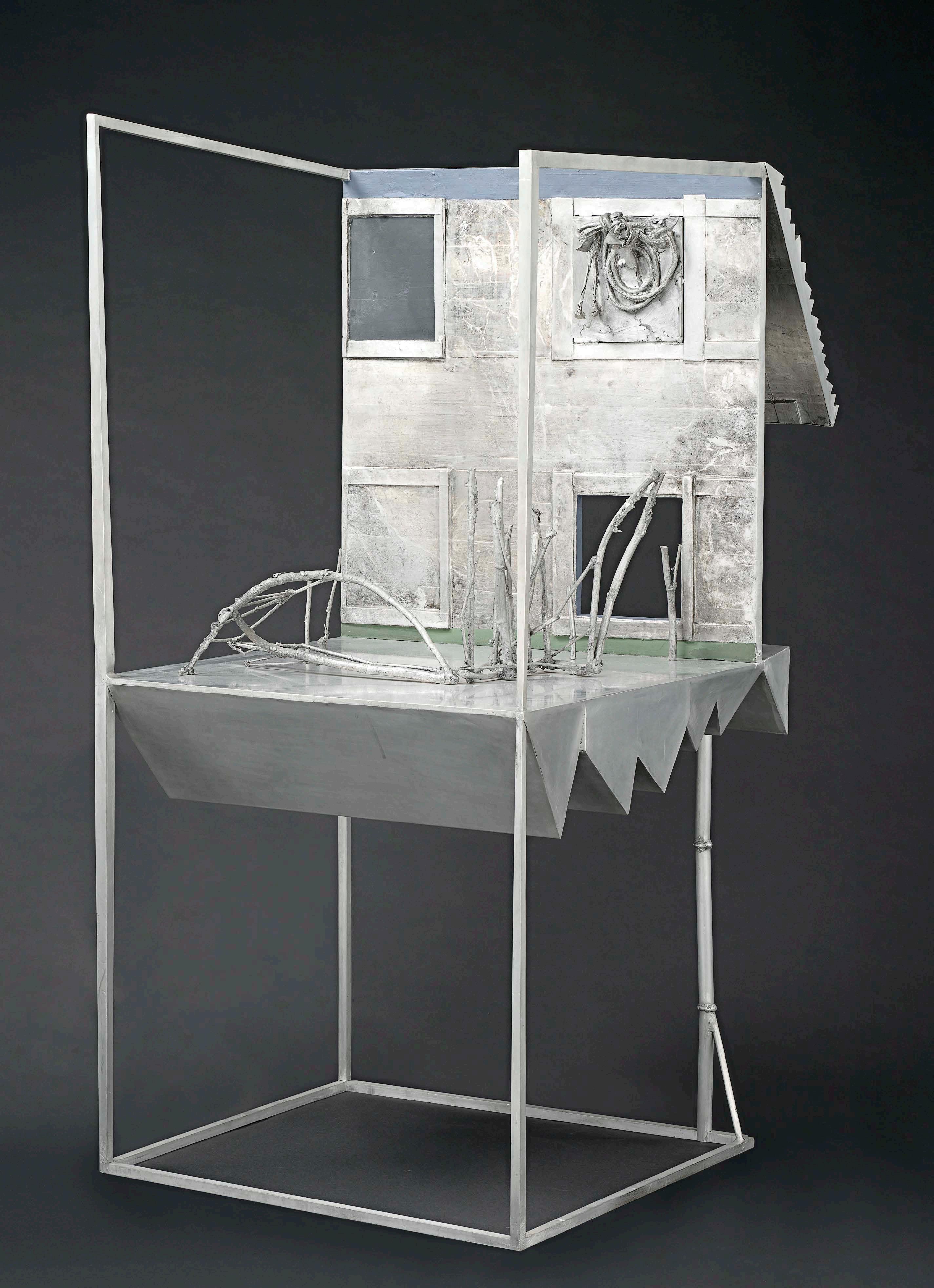





















































































































































 JANE ECKETT
JANE ECKETT





















